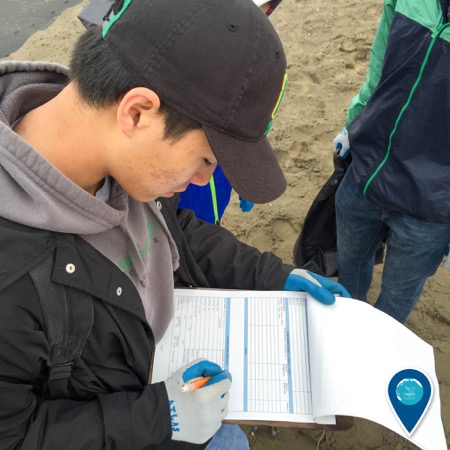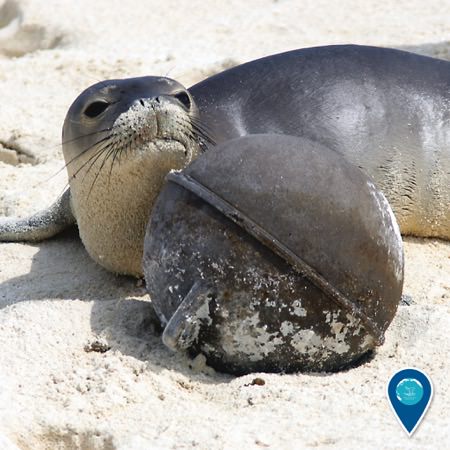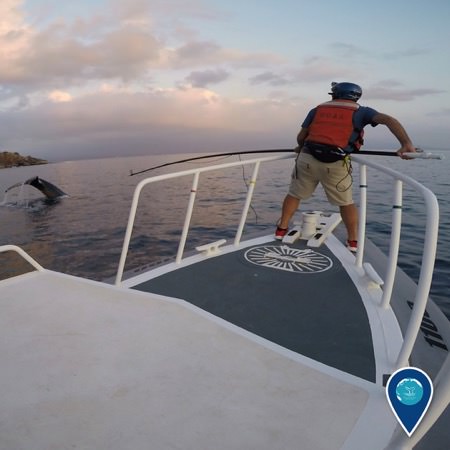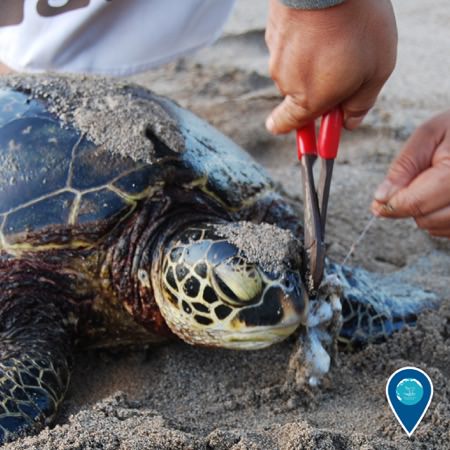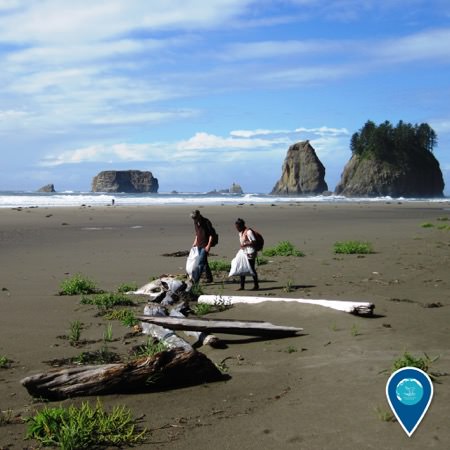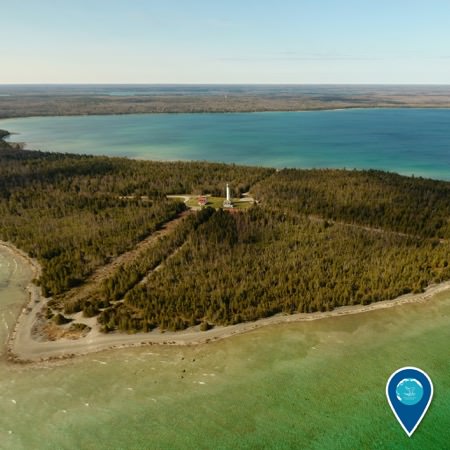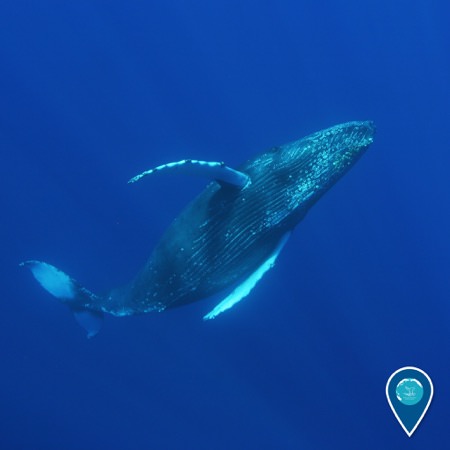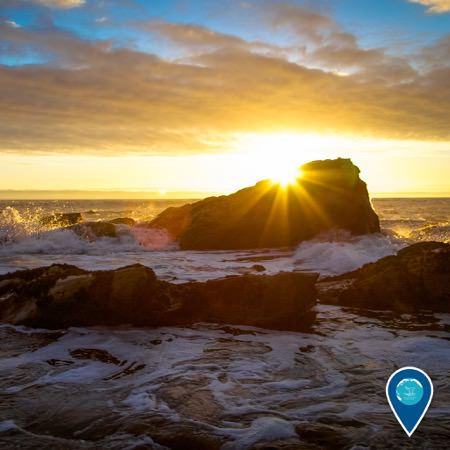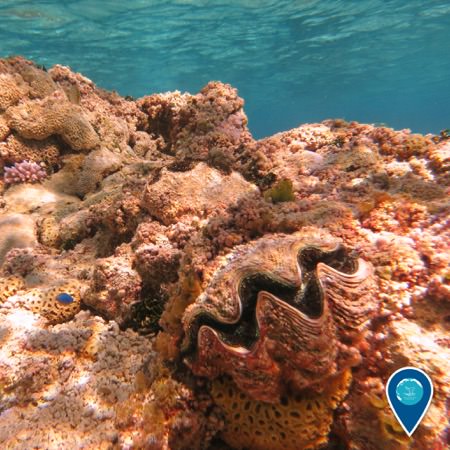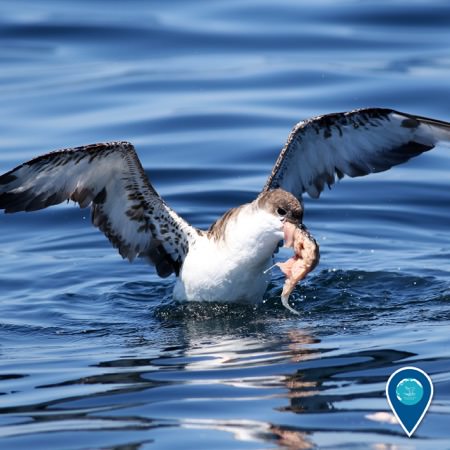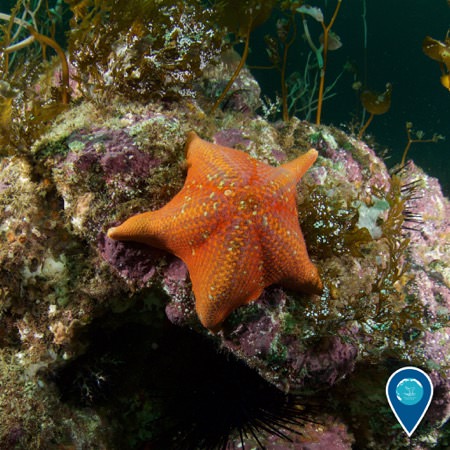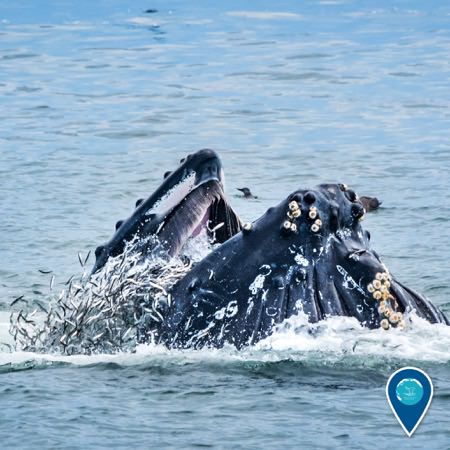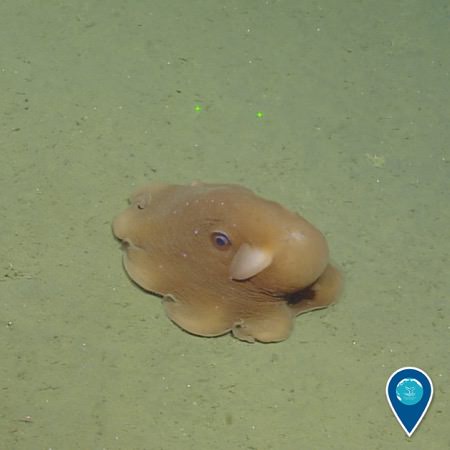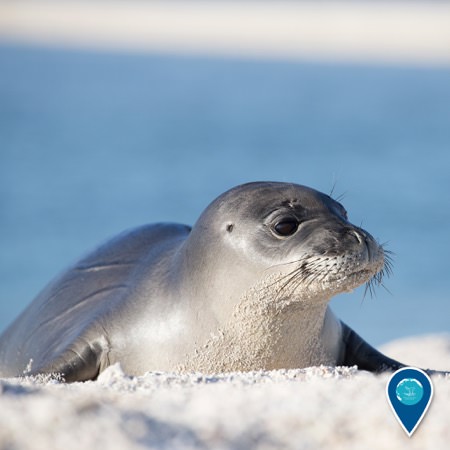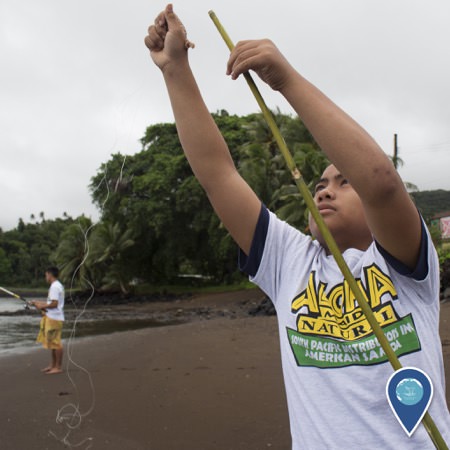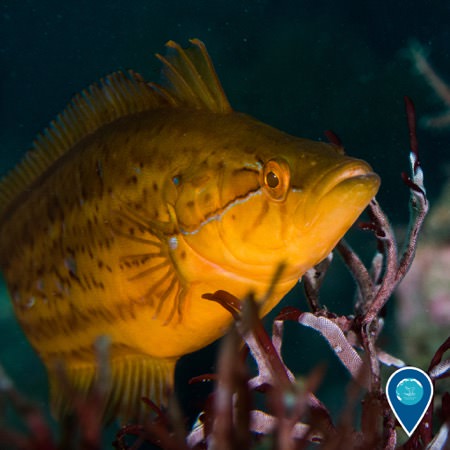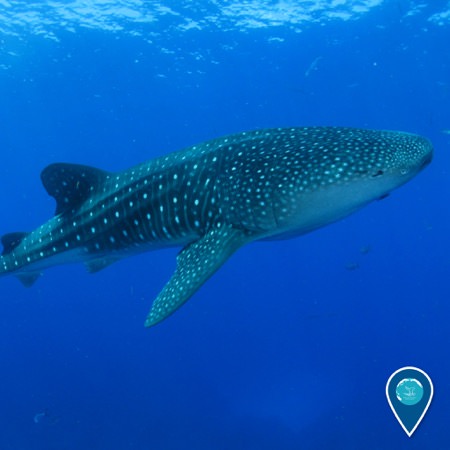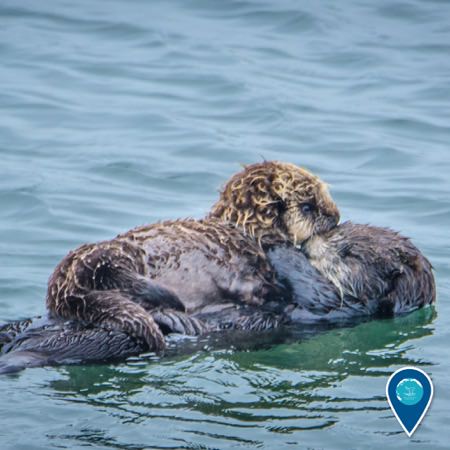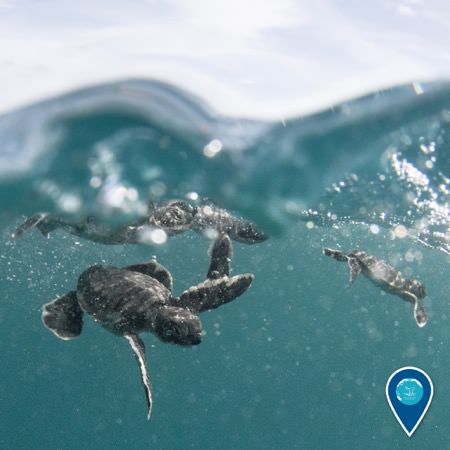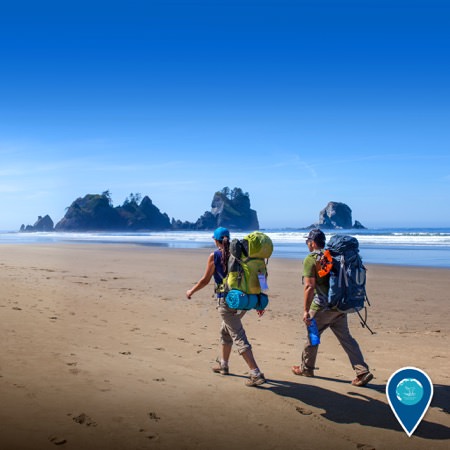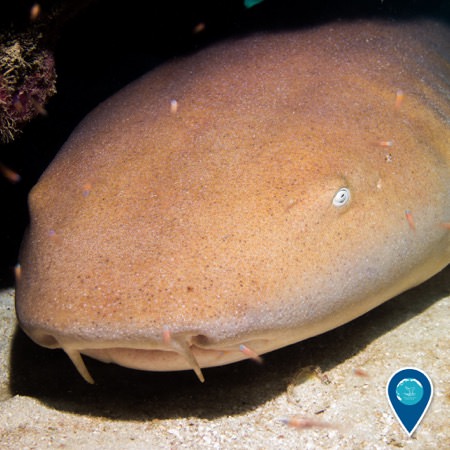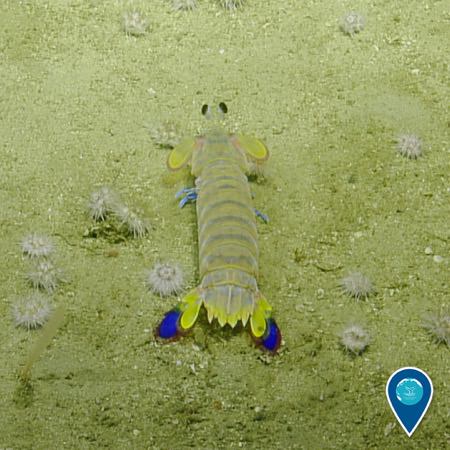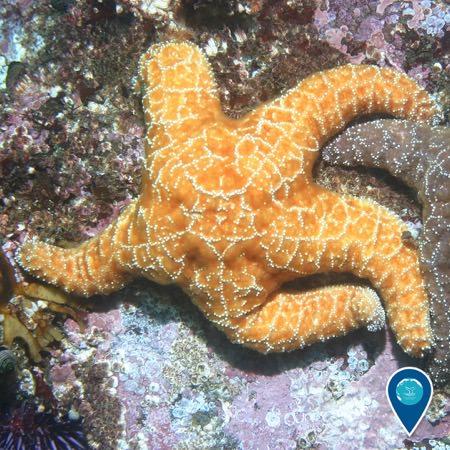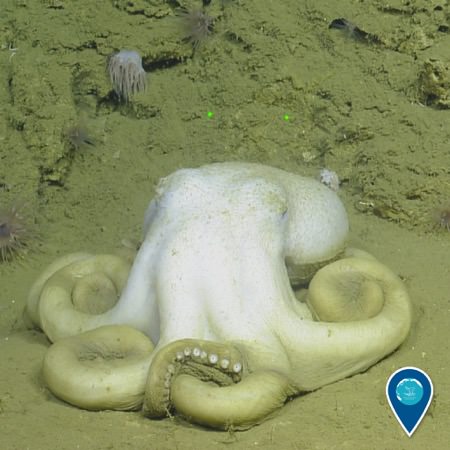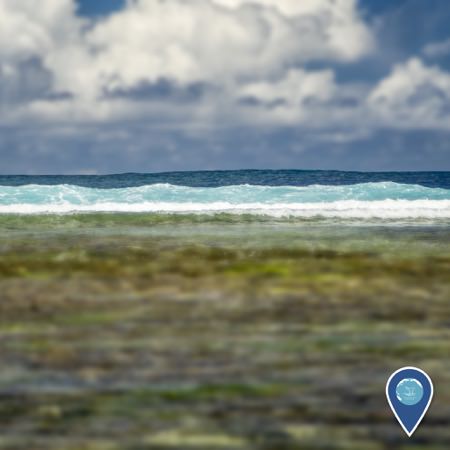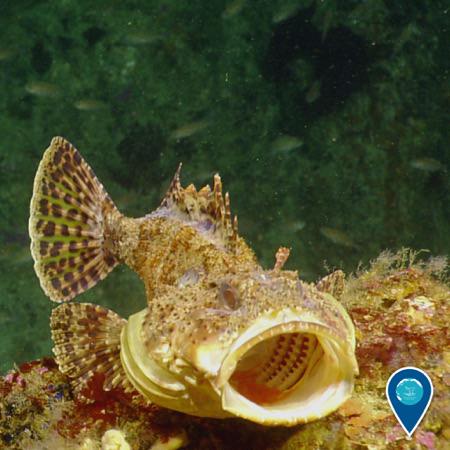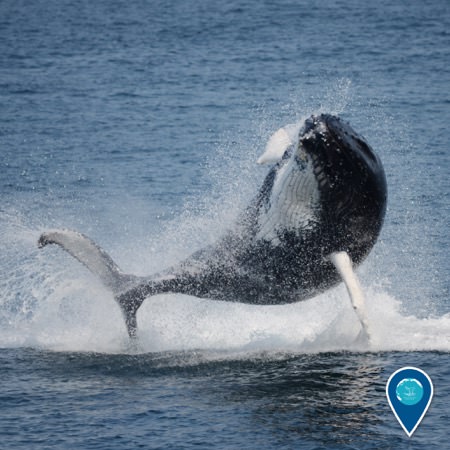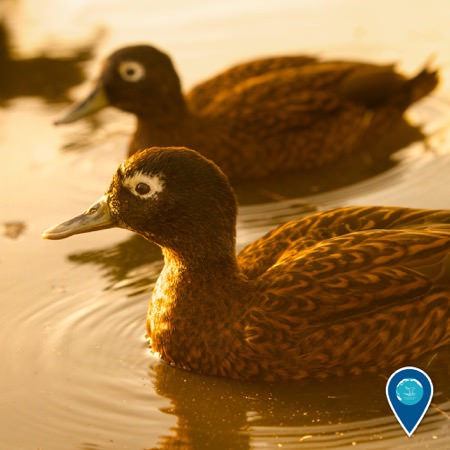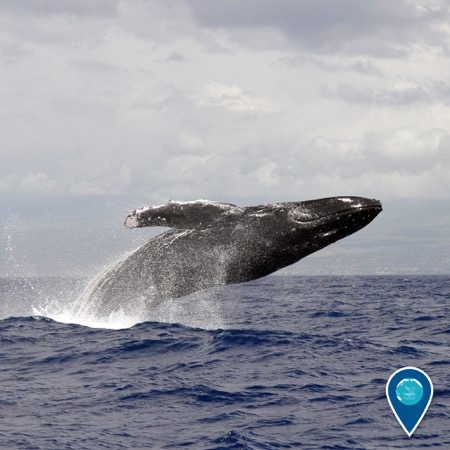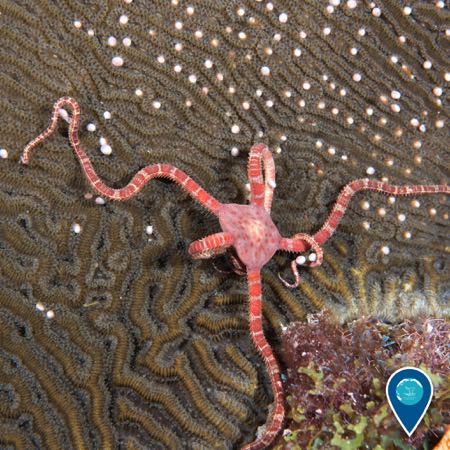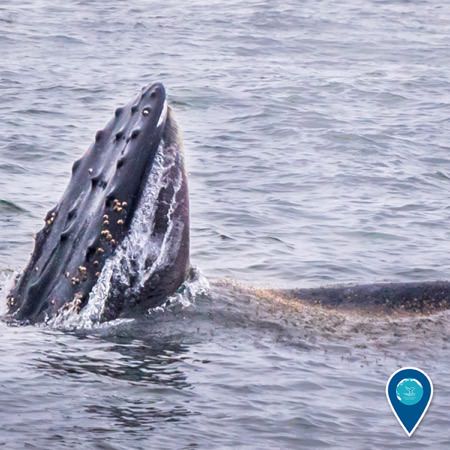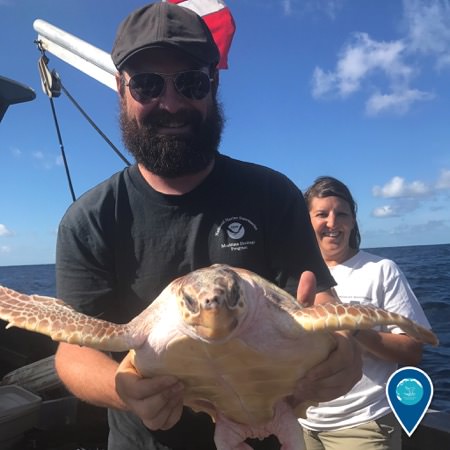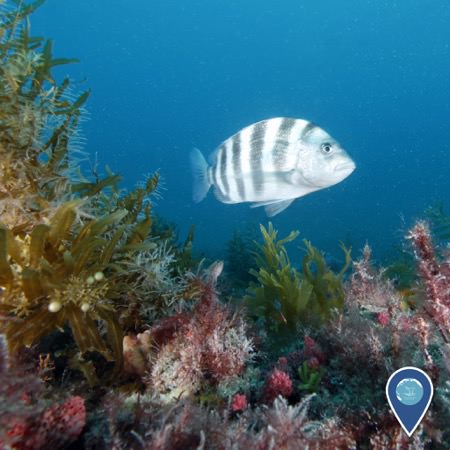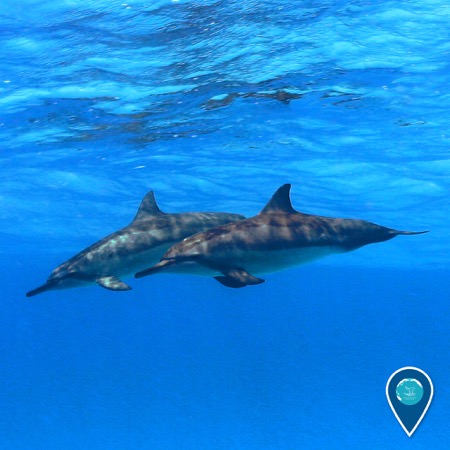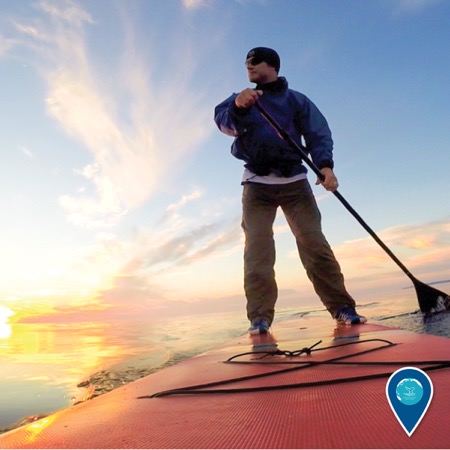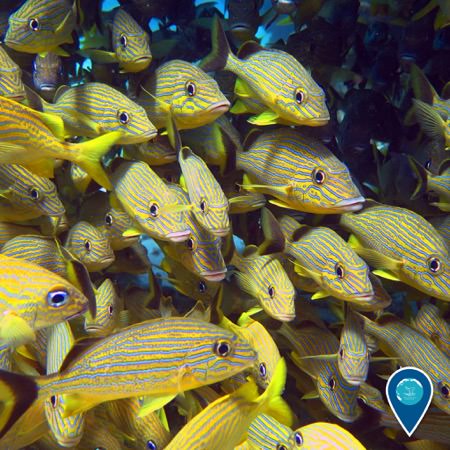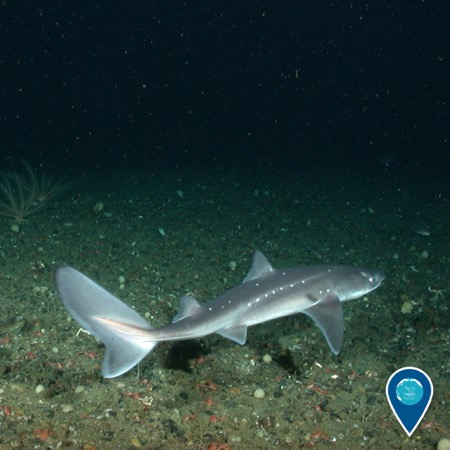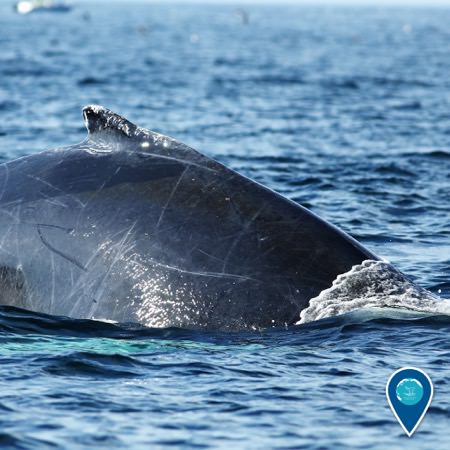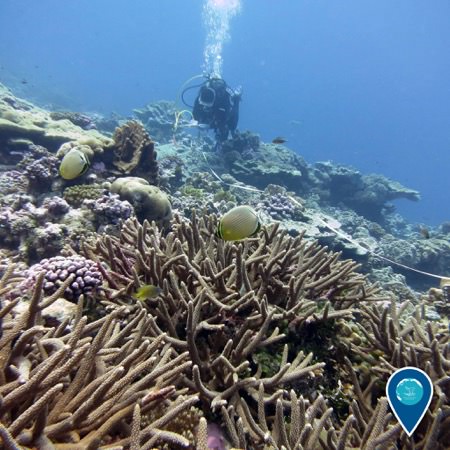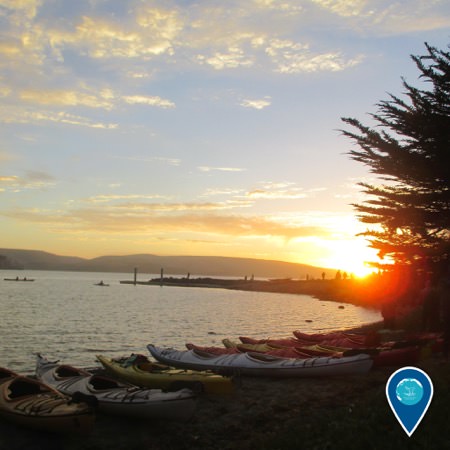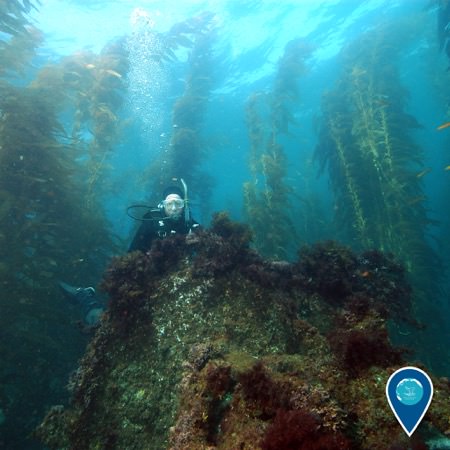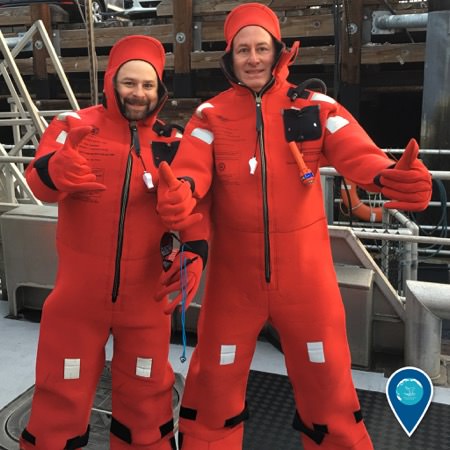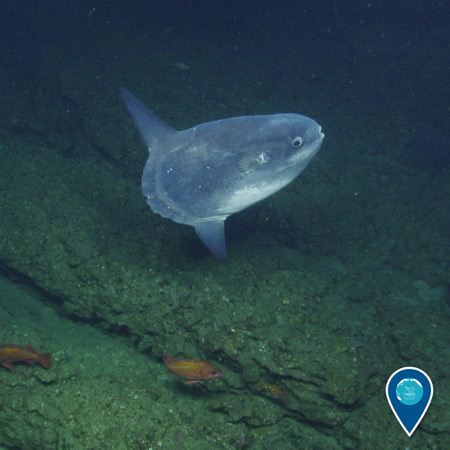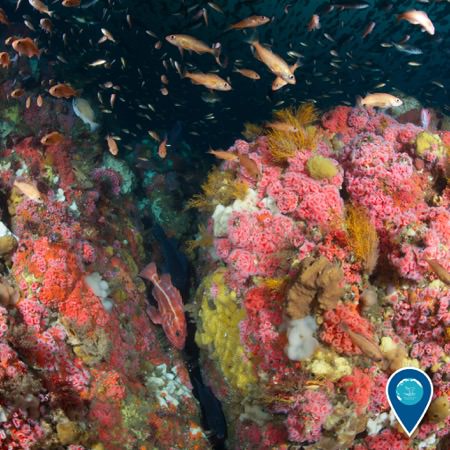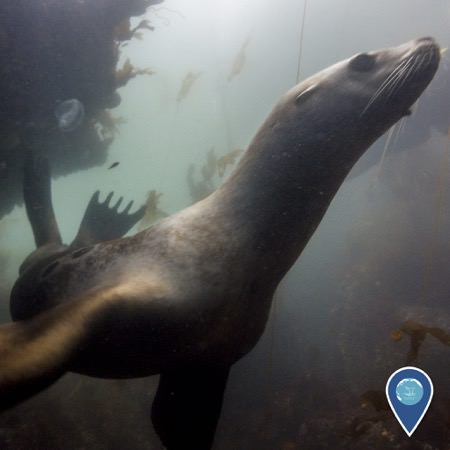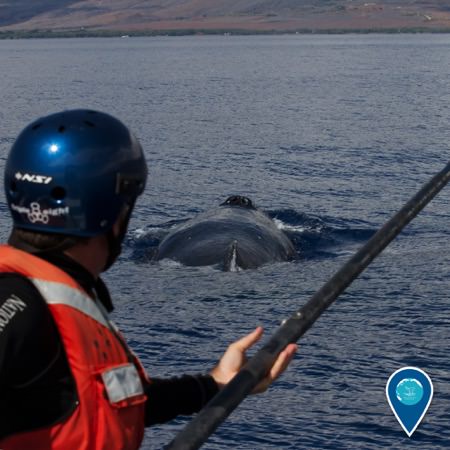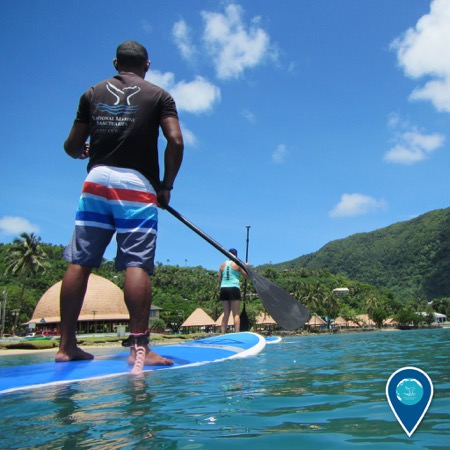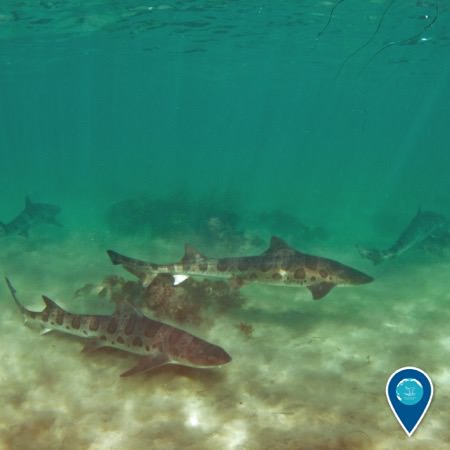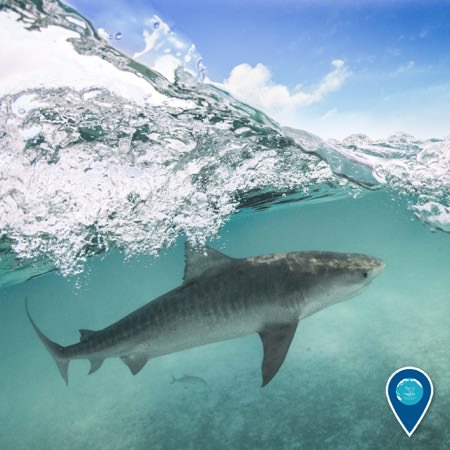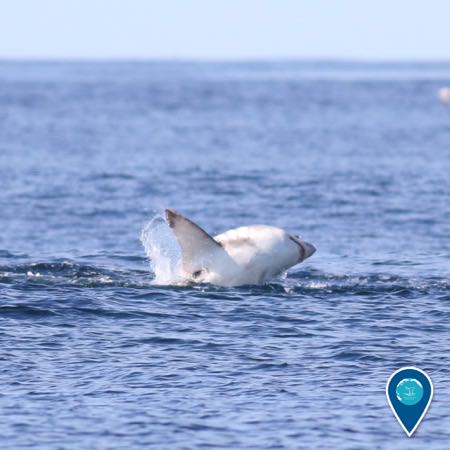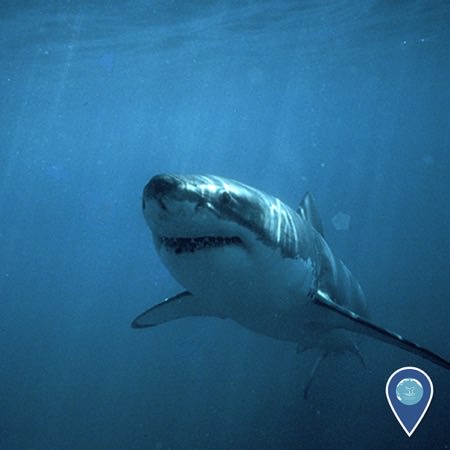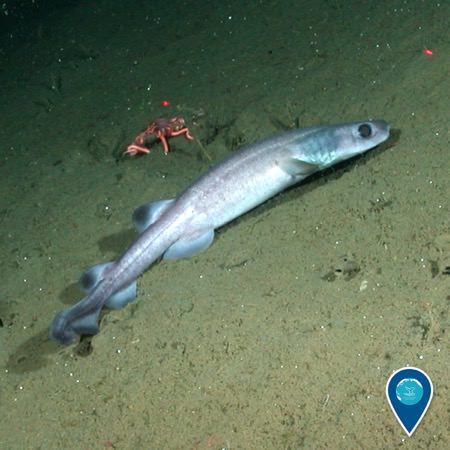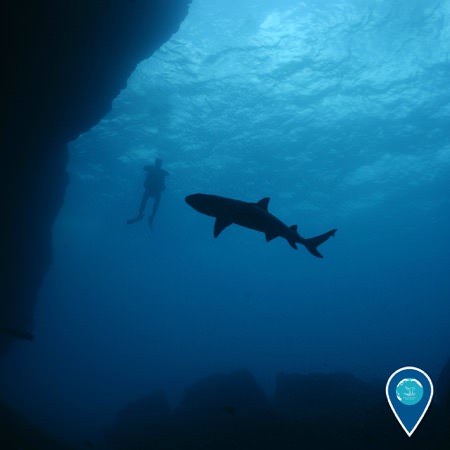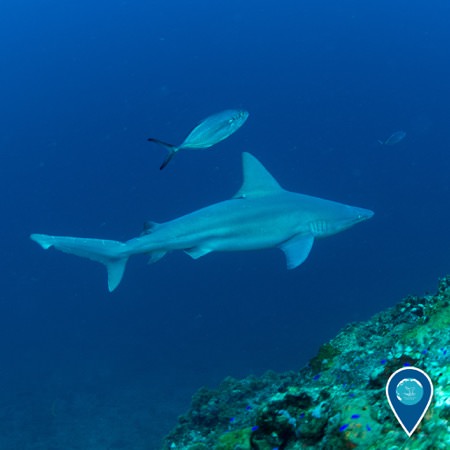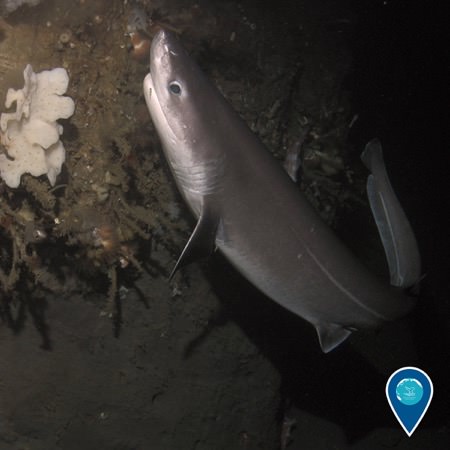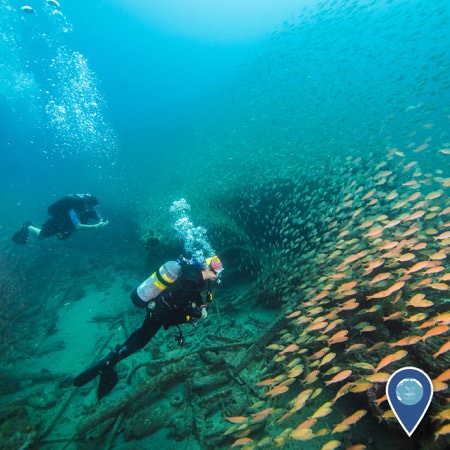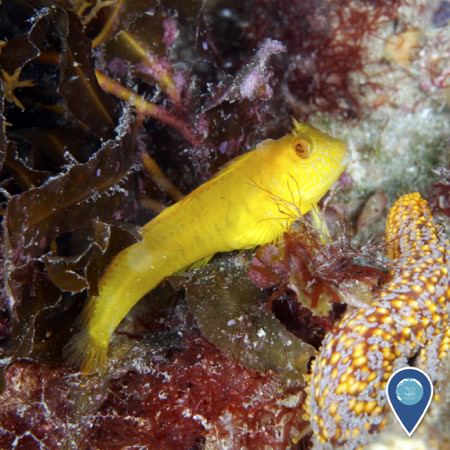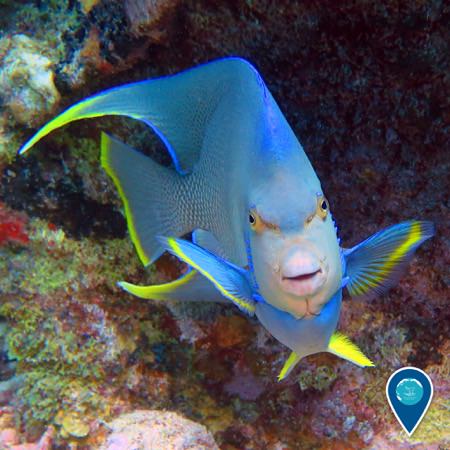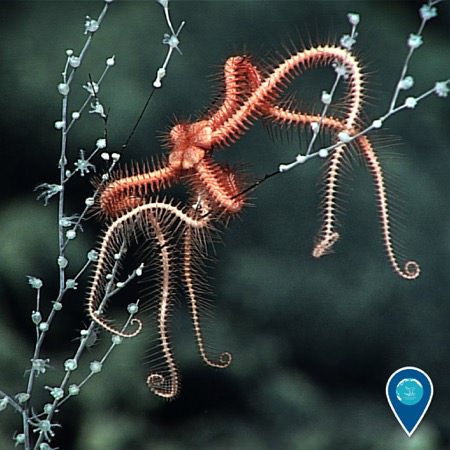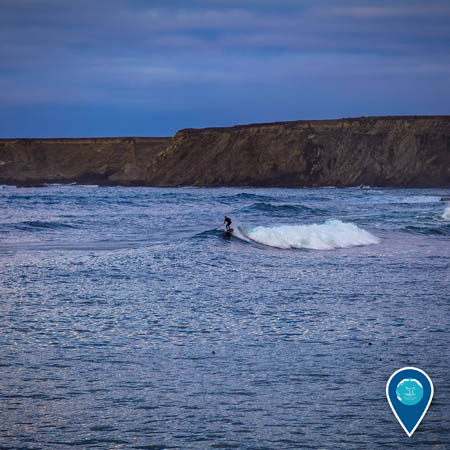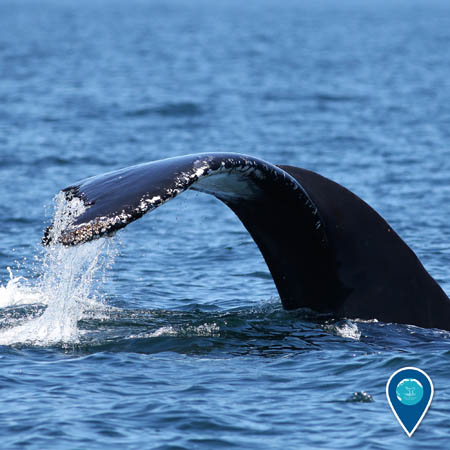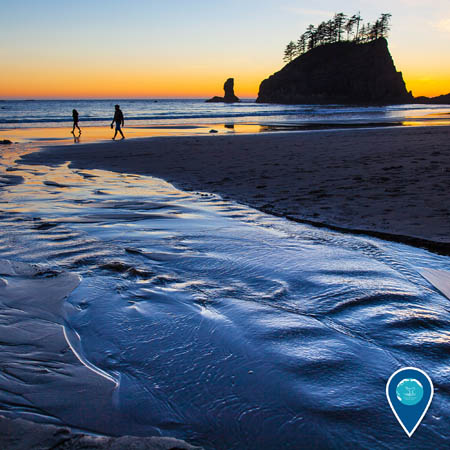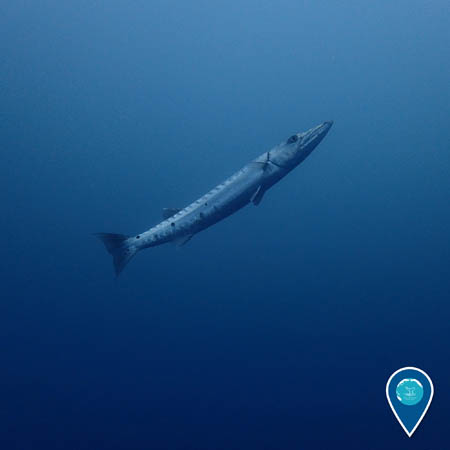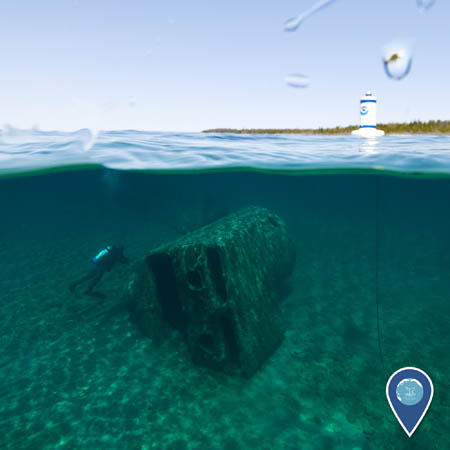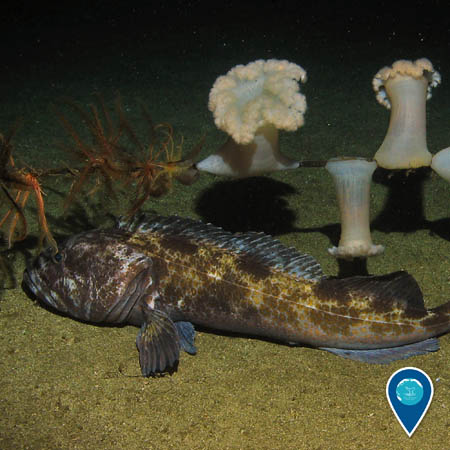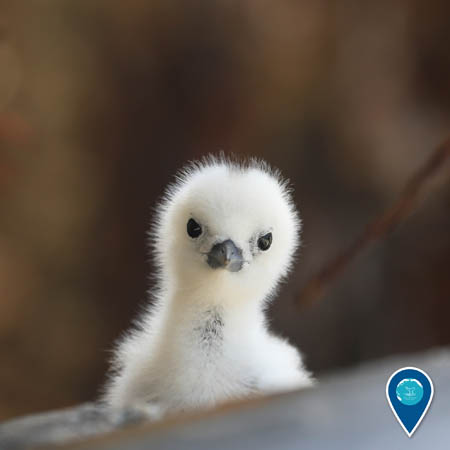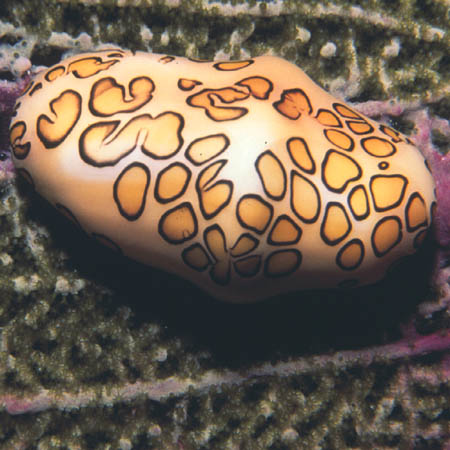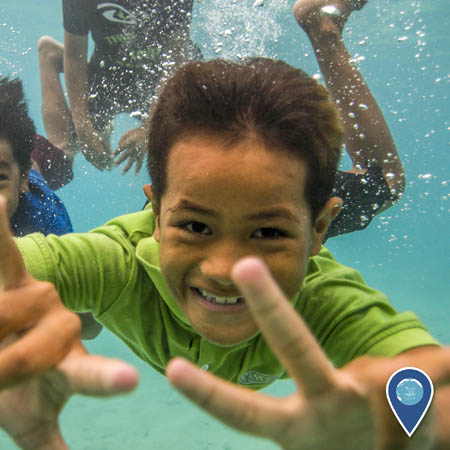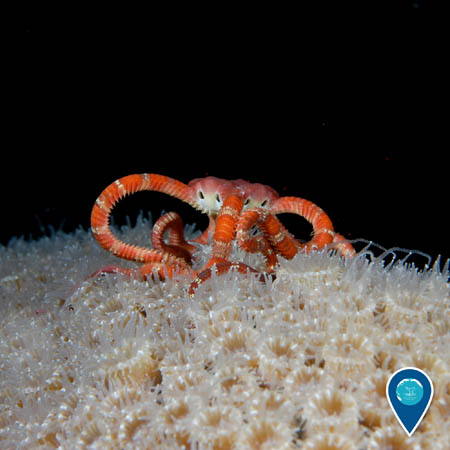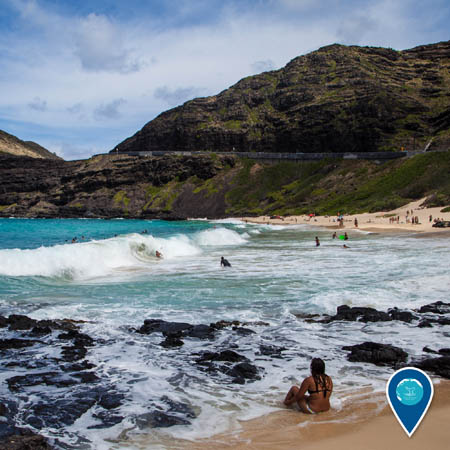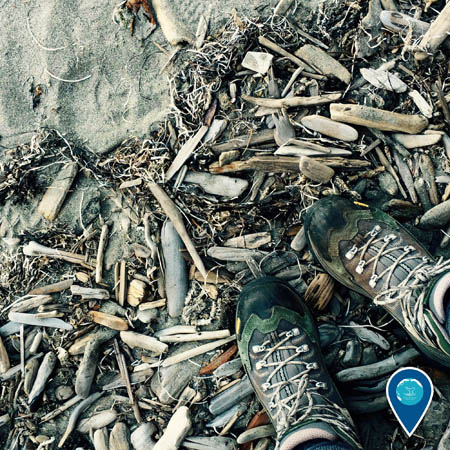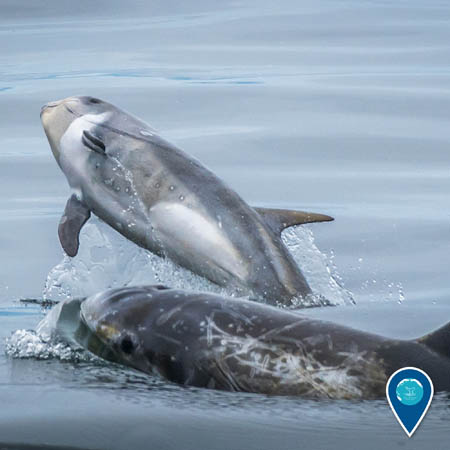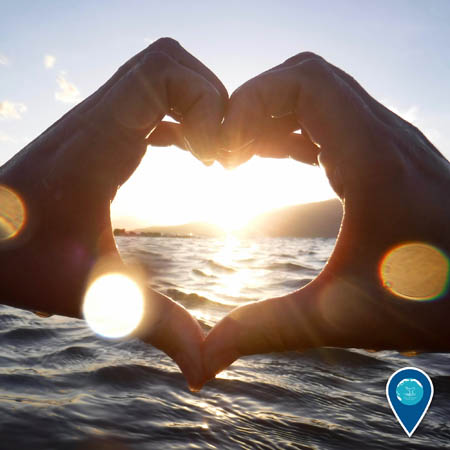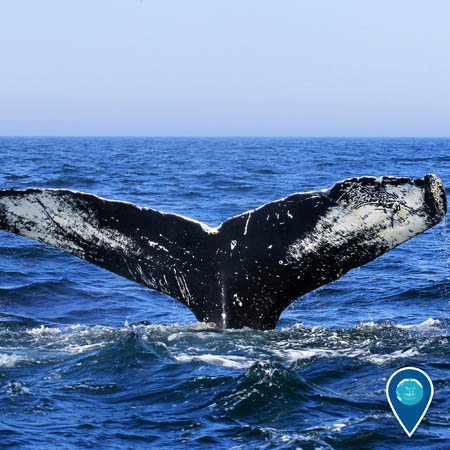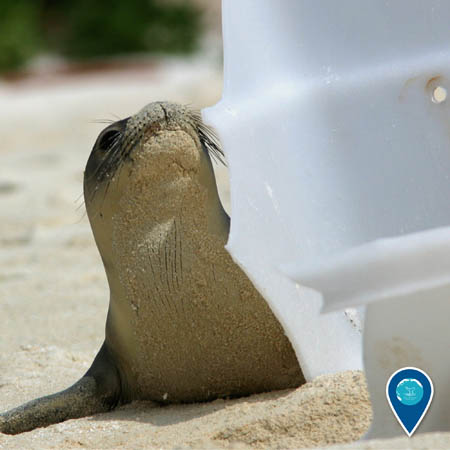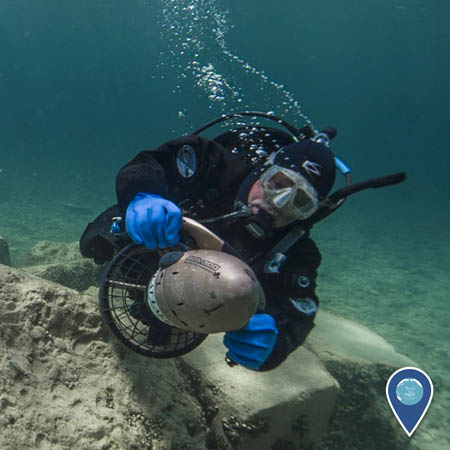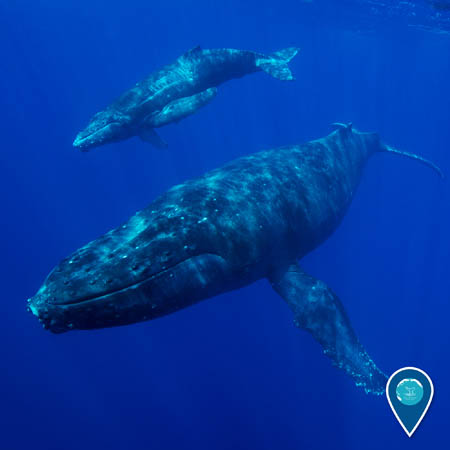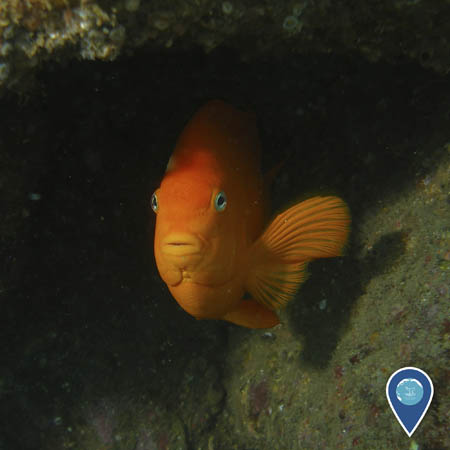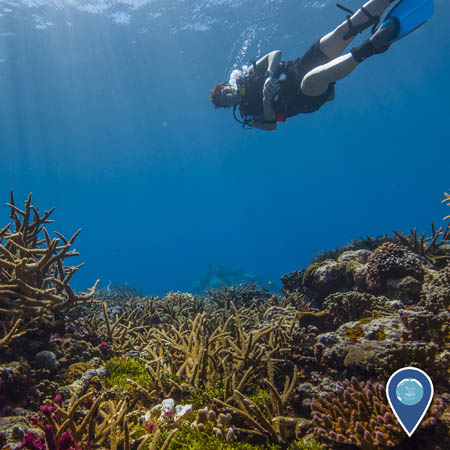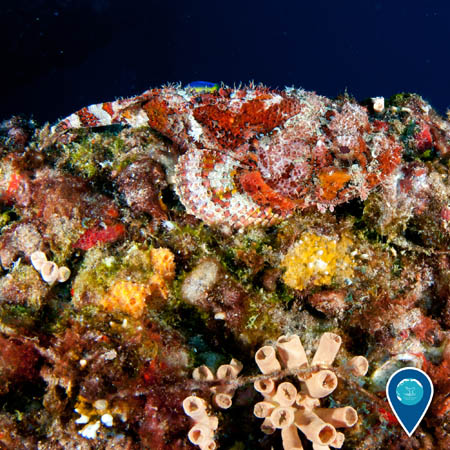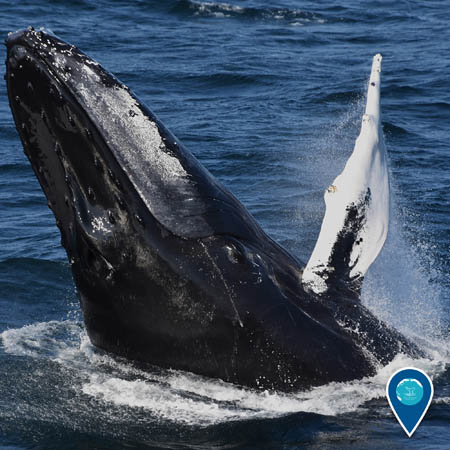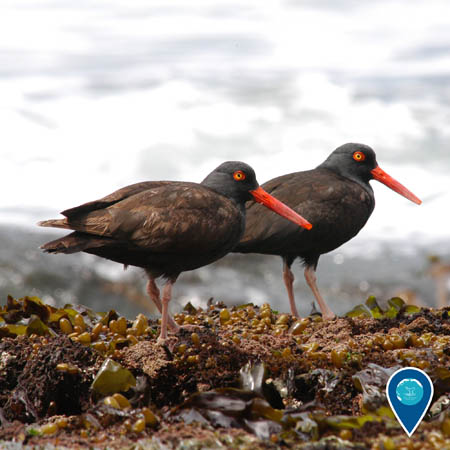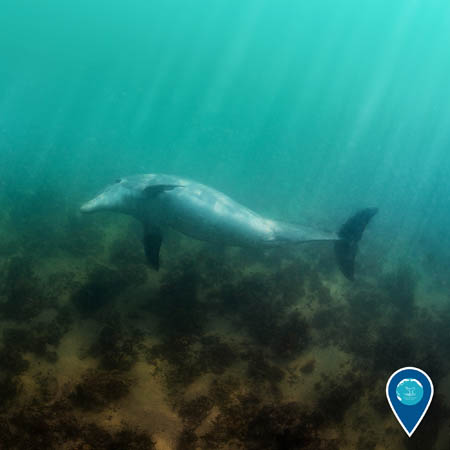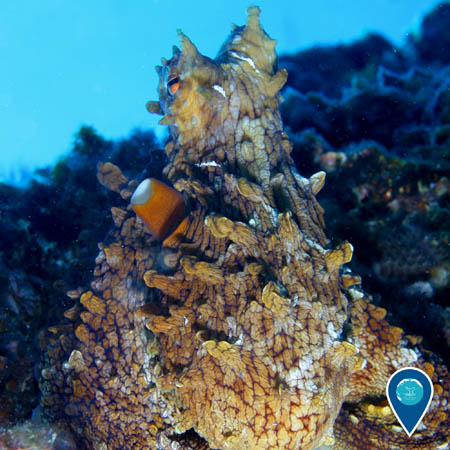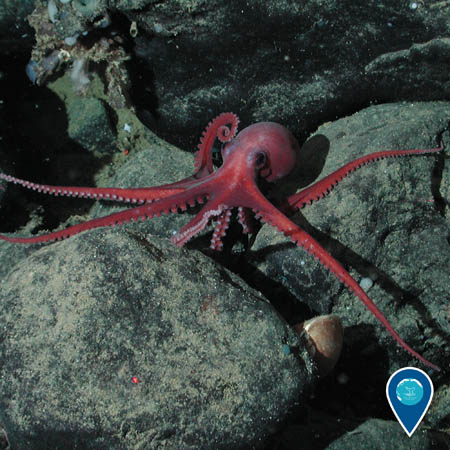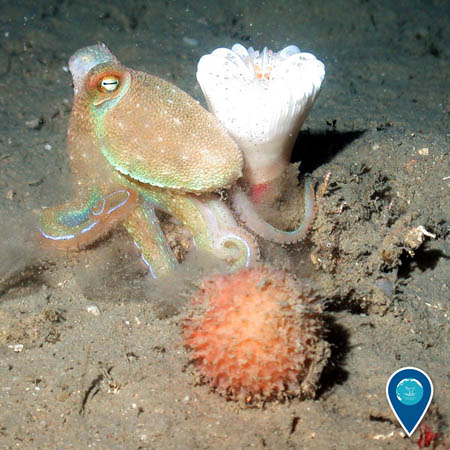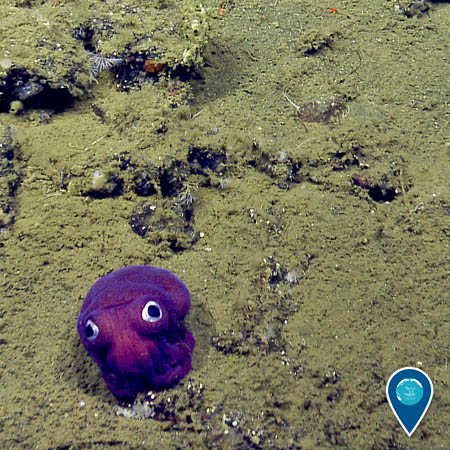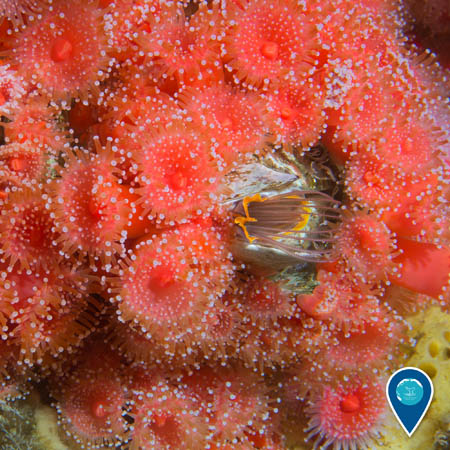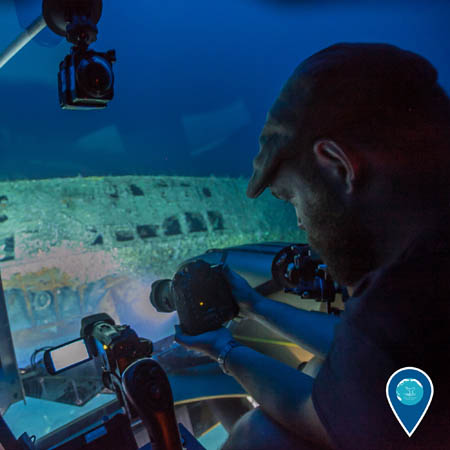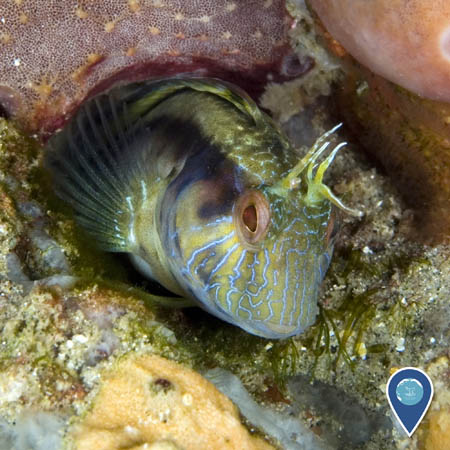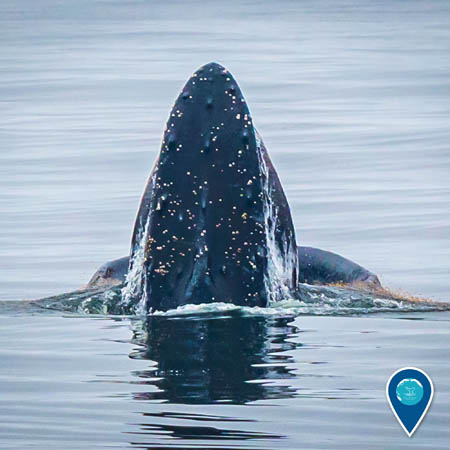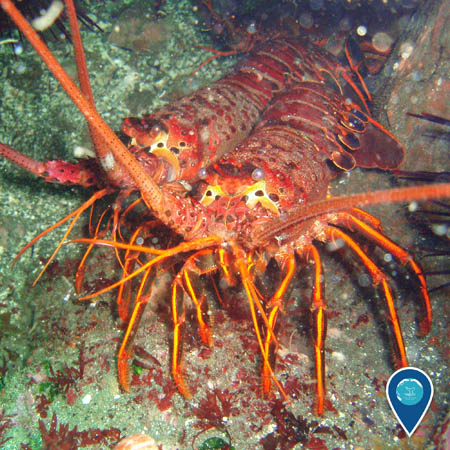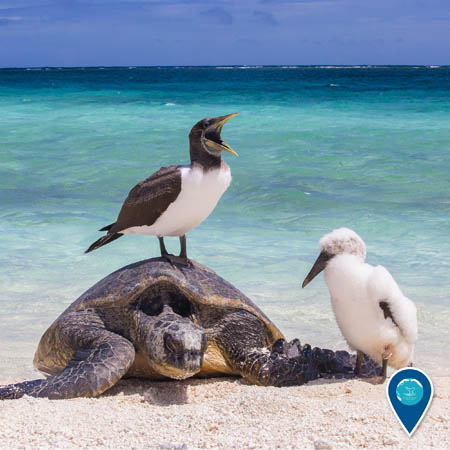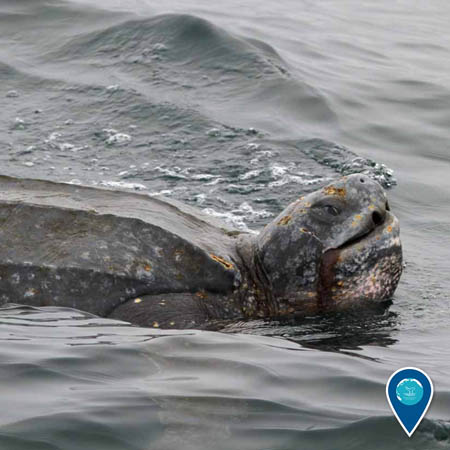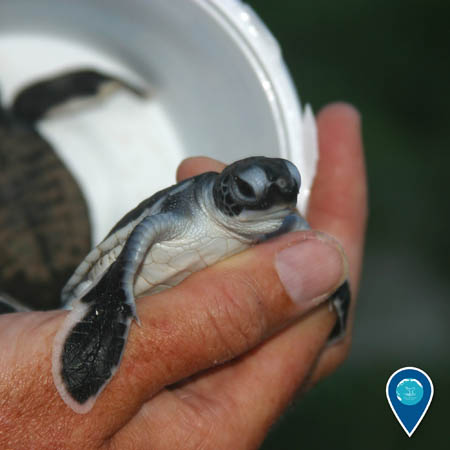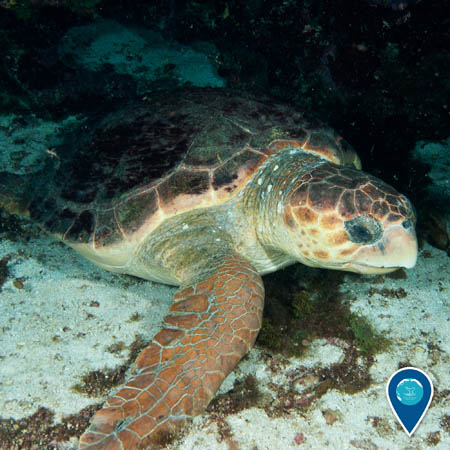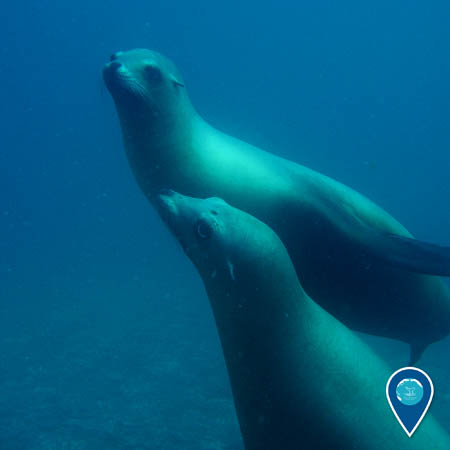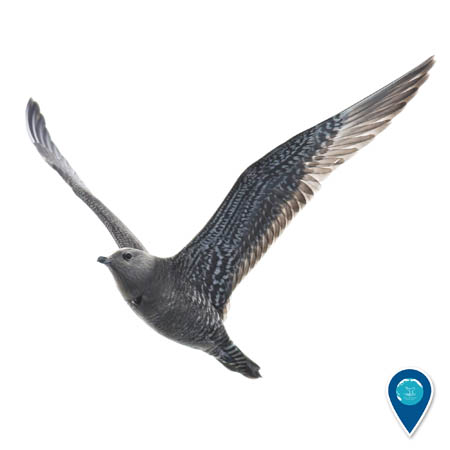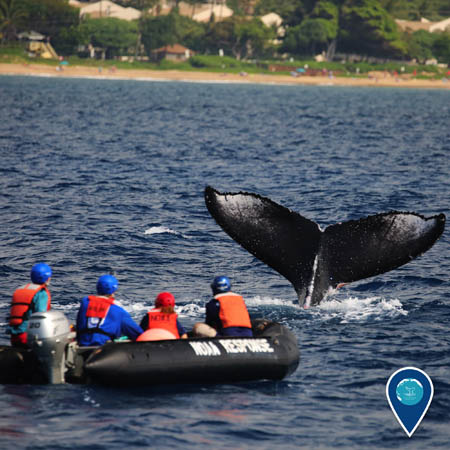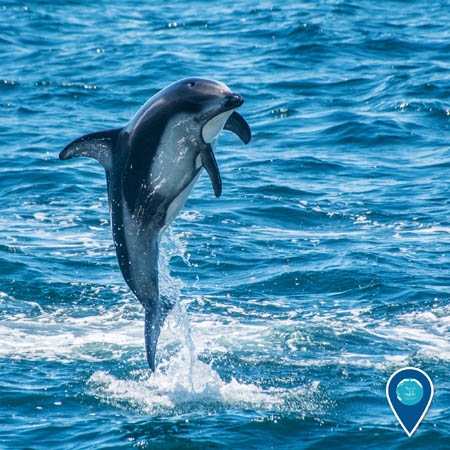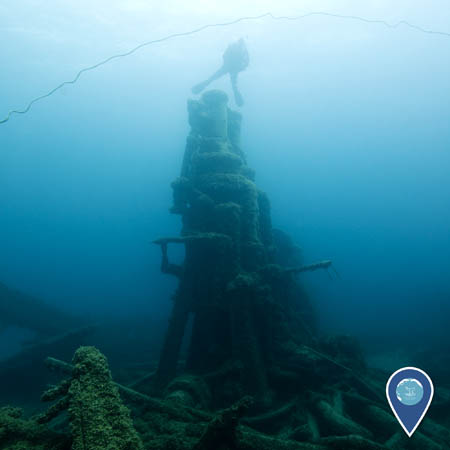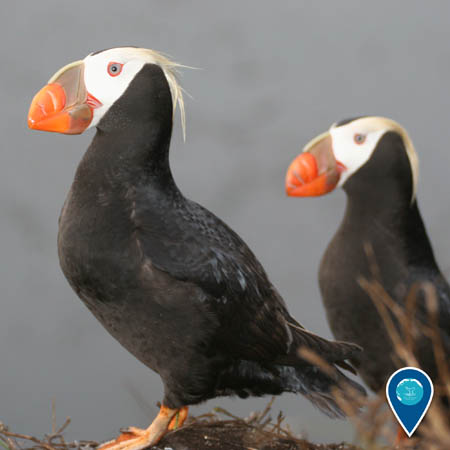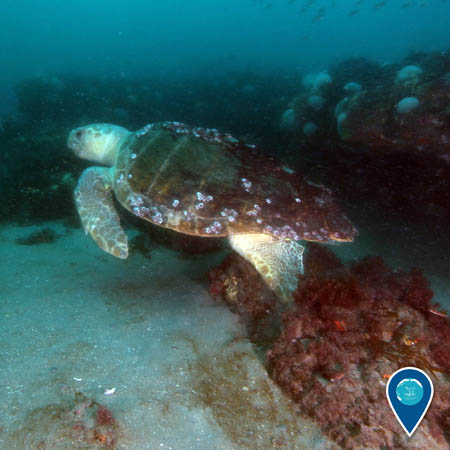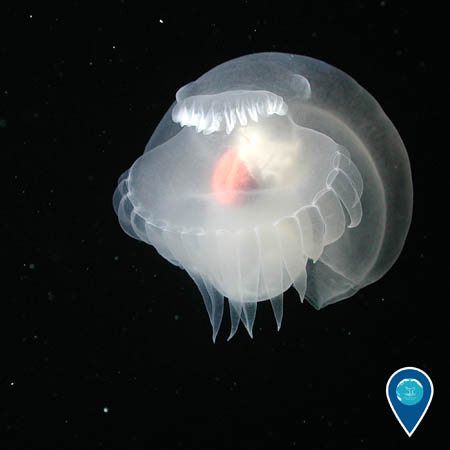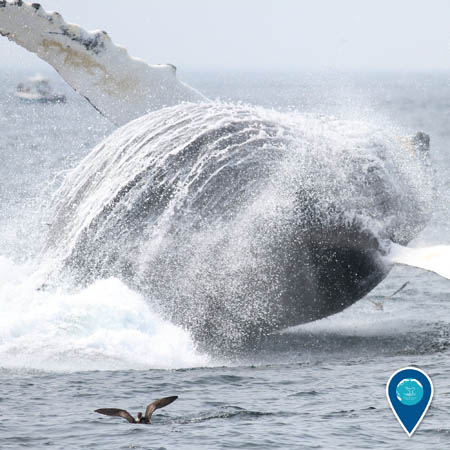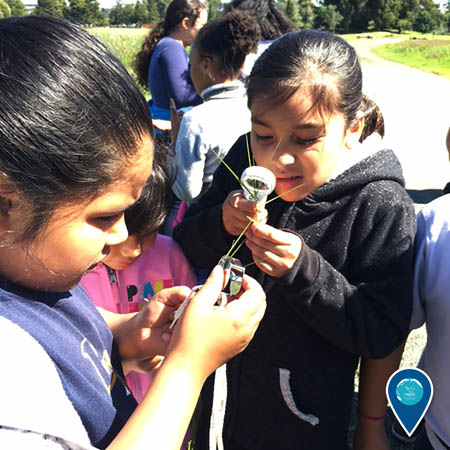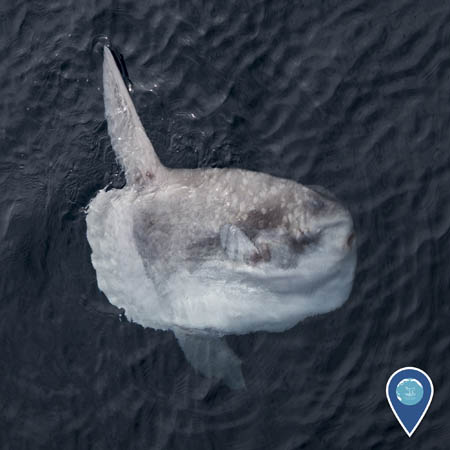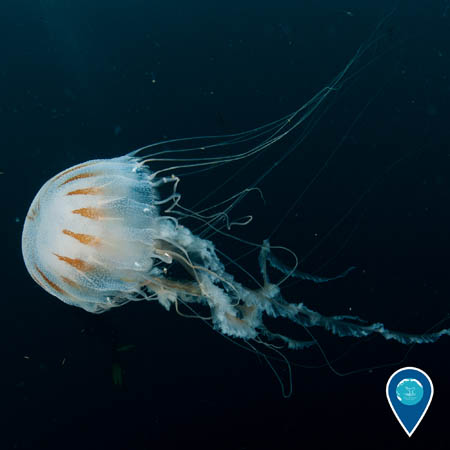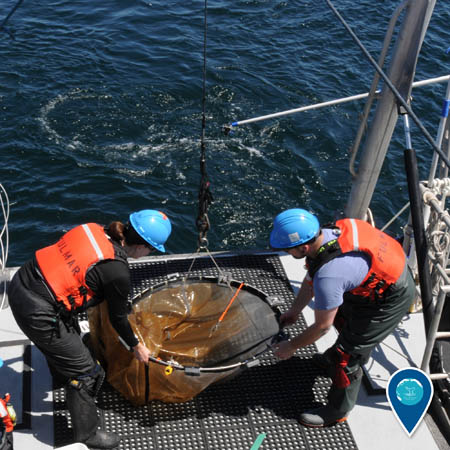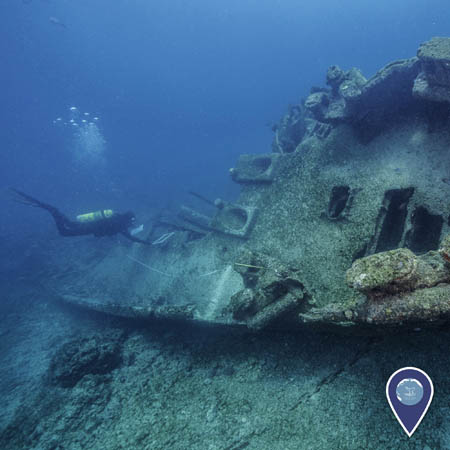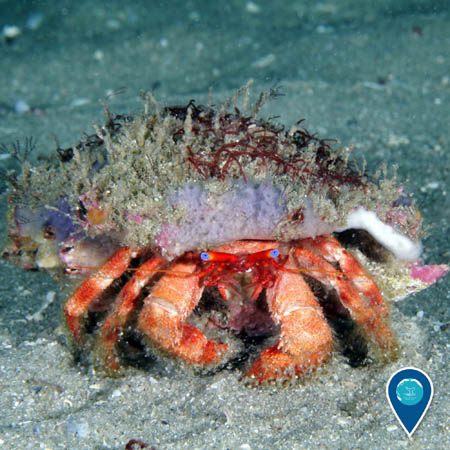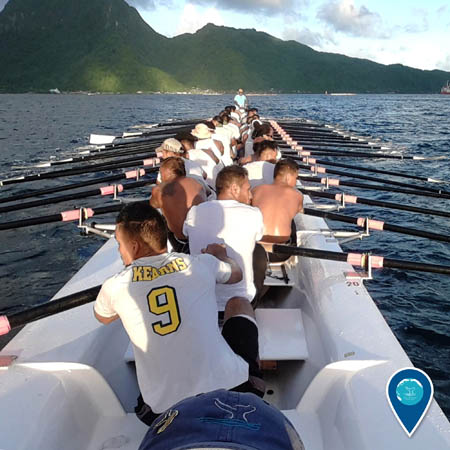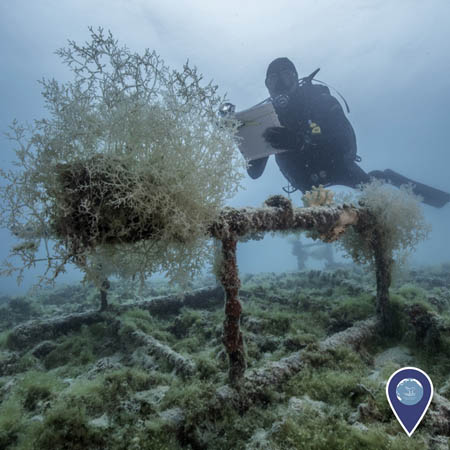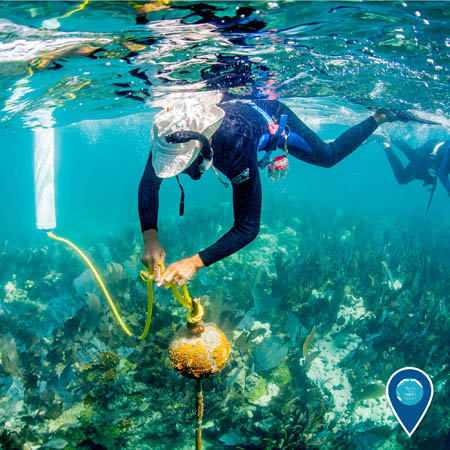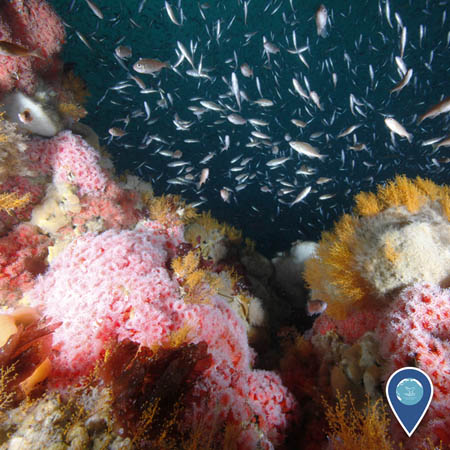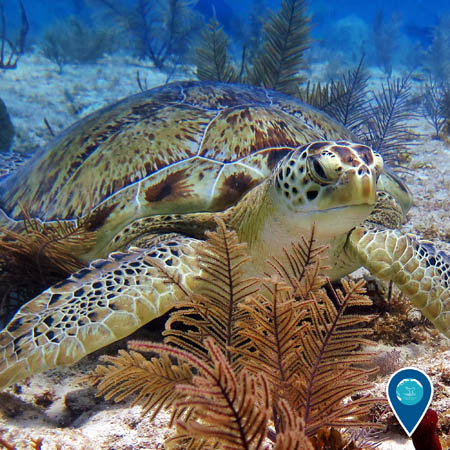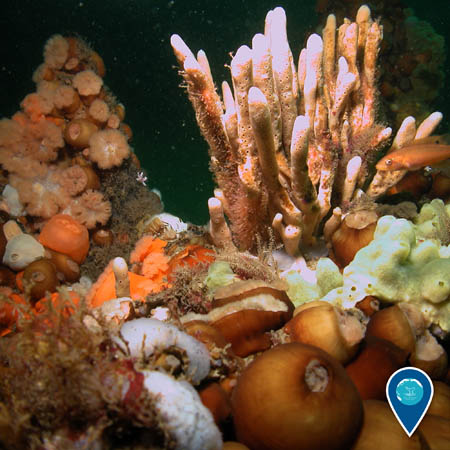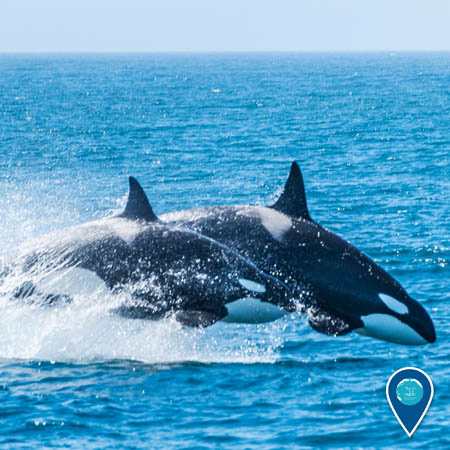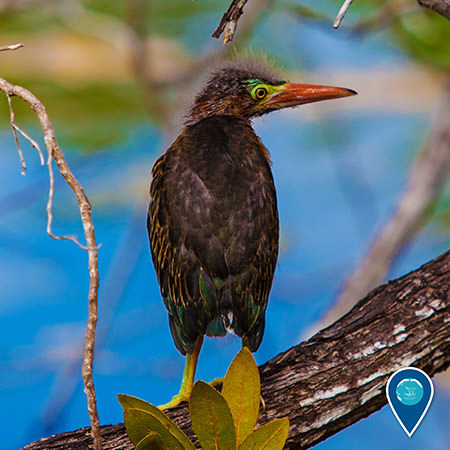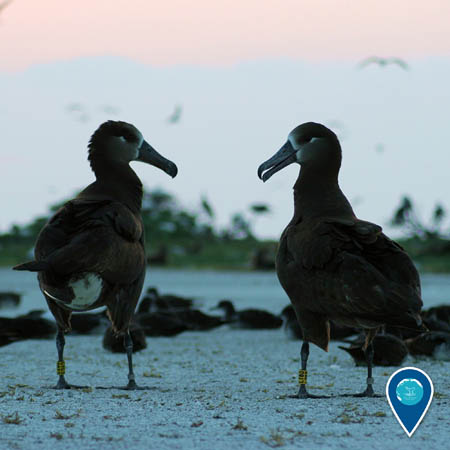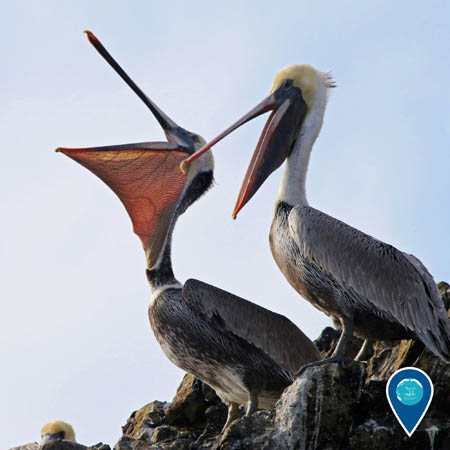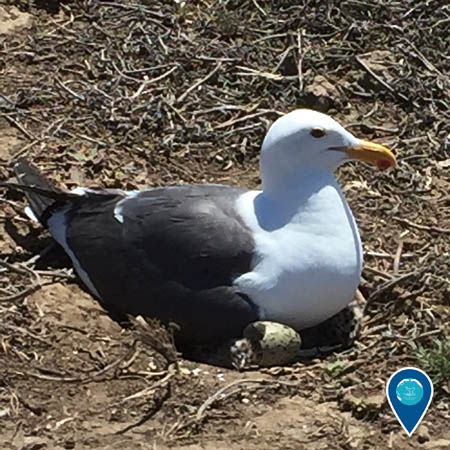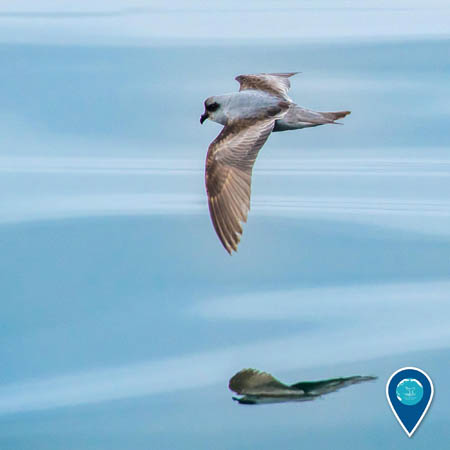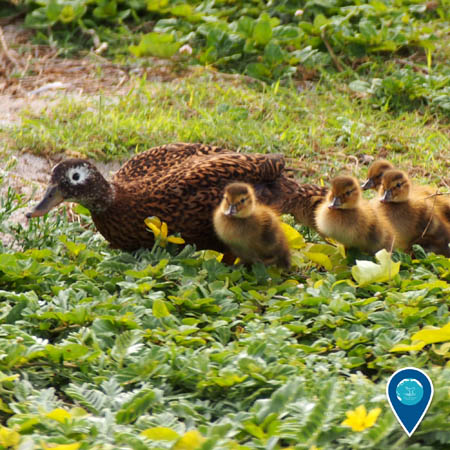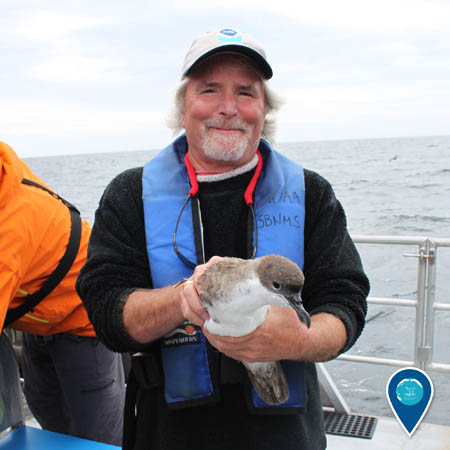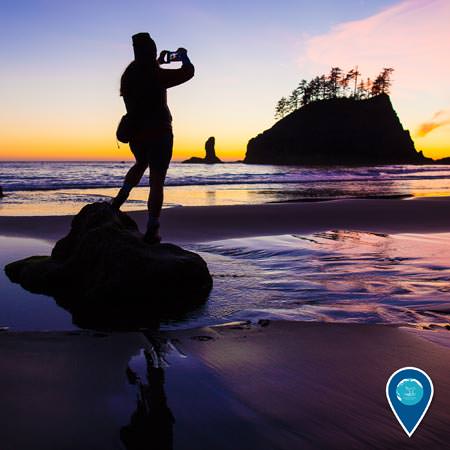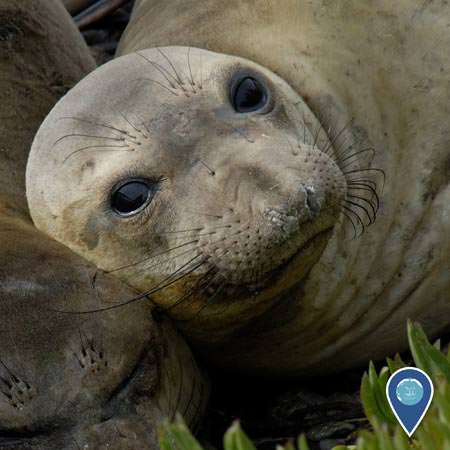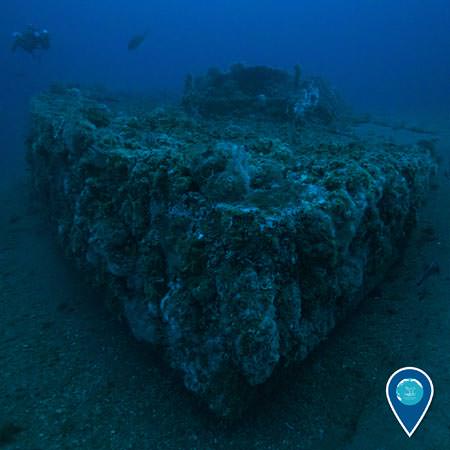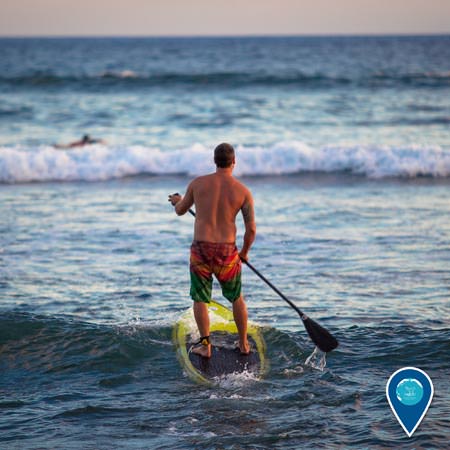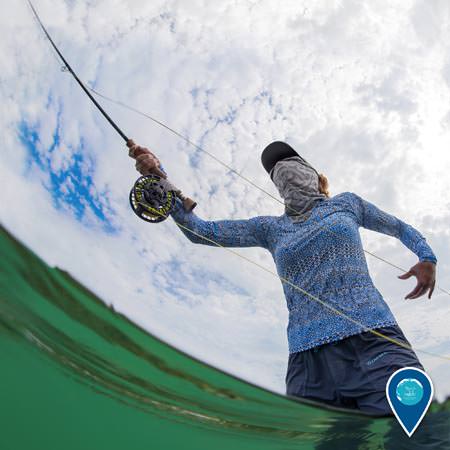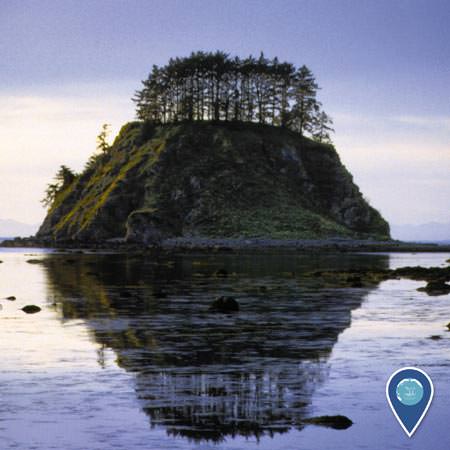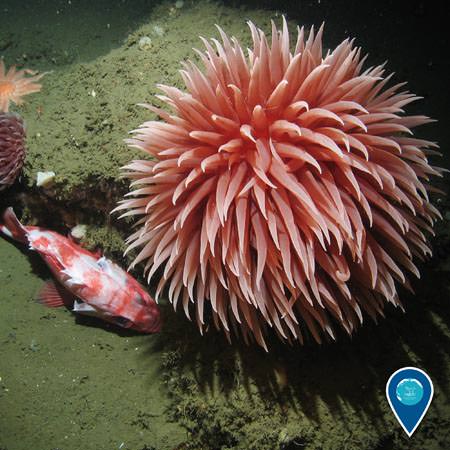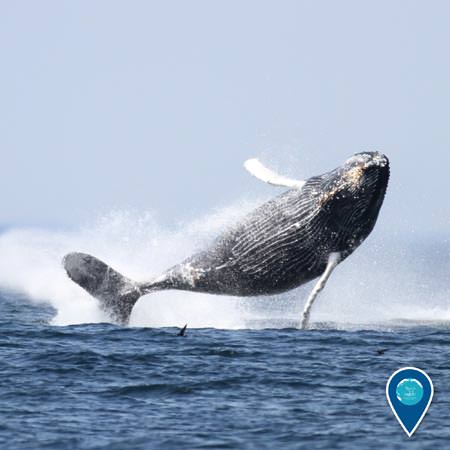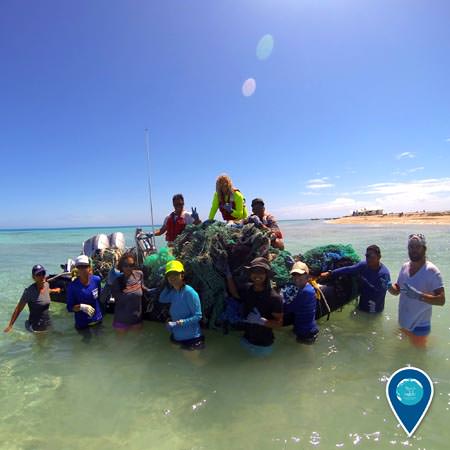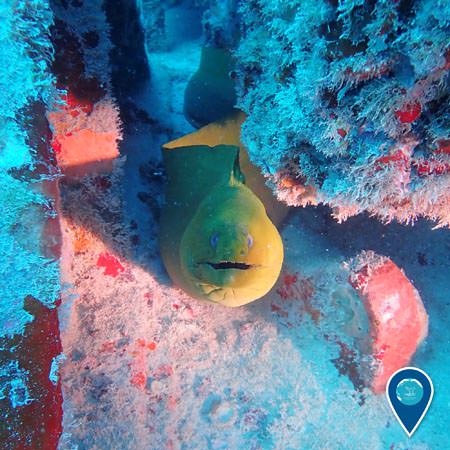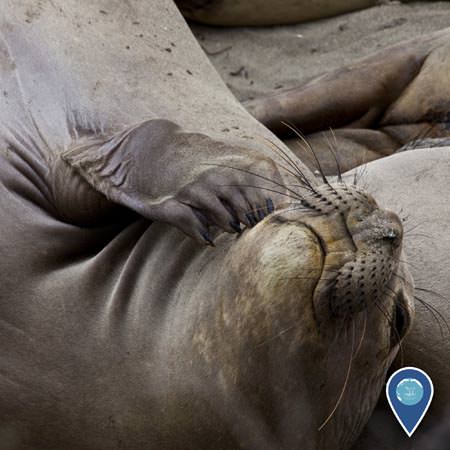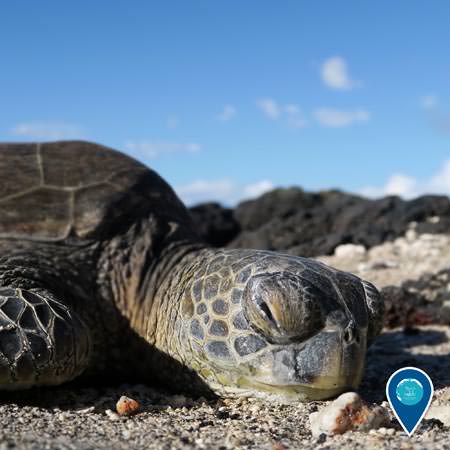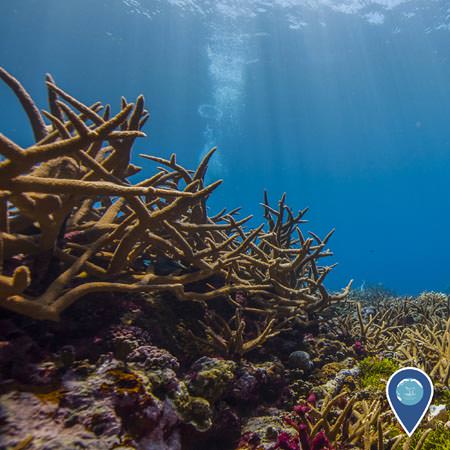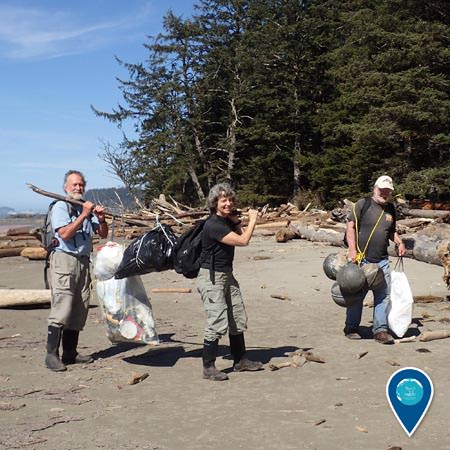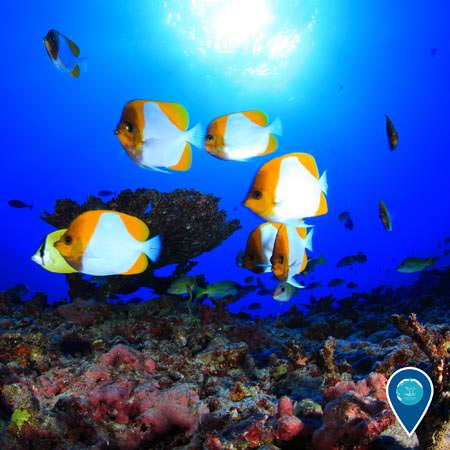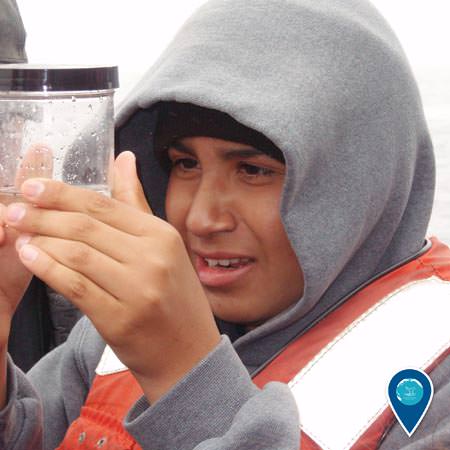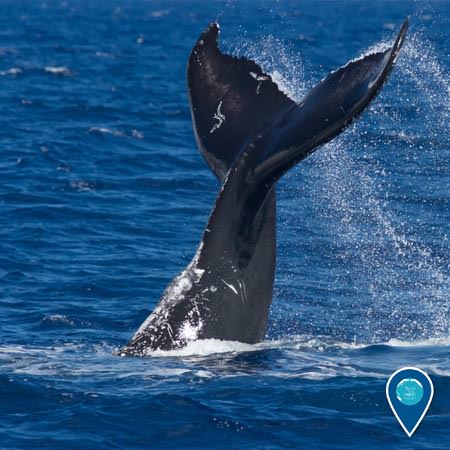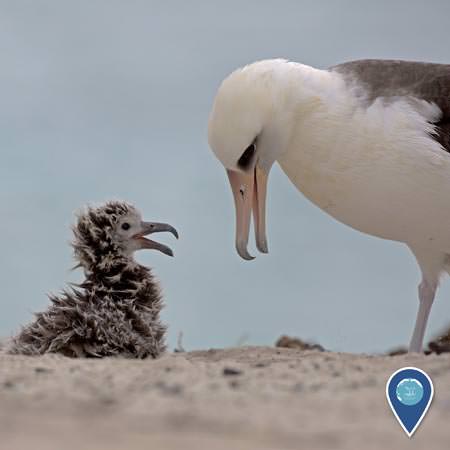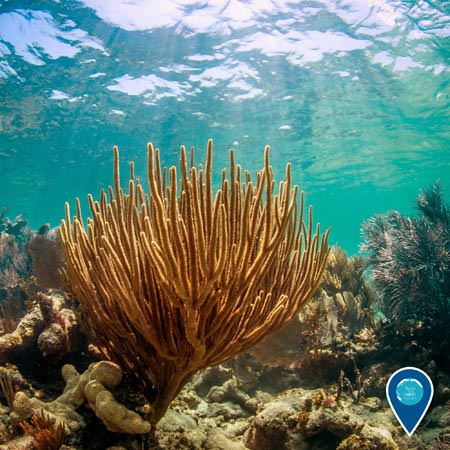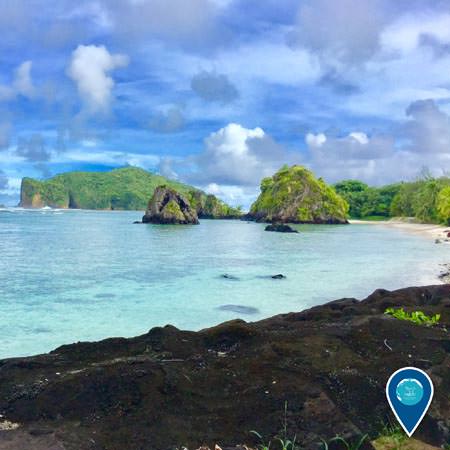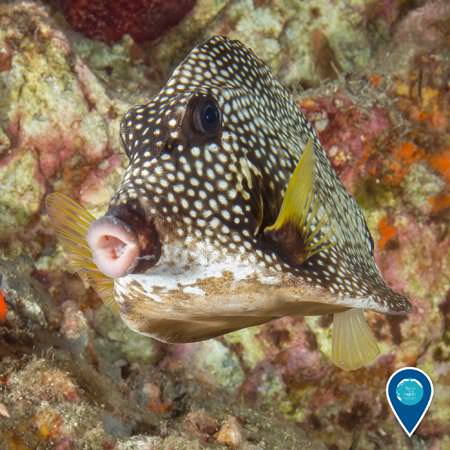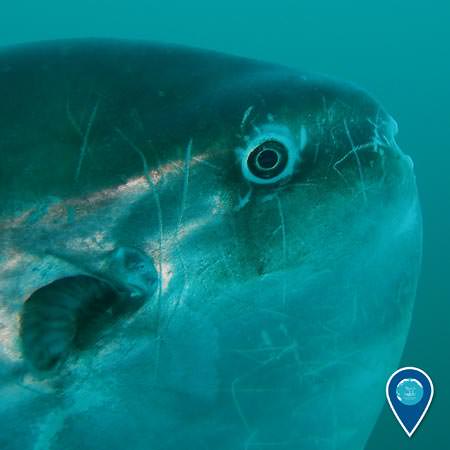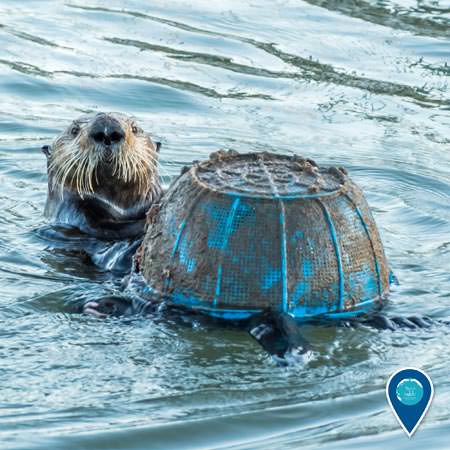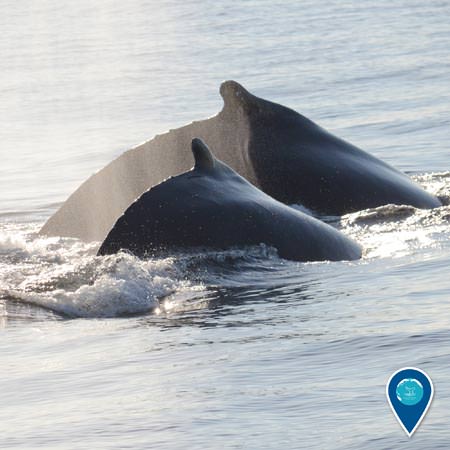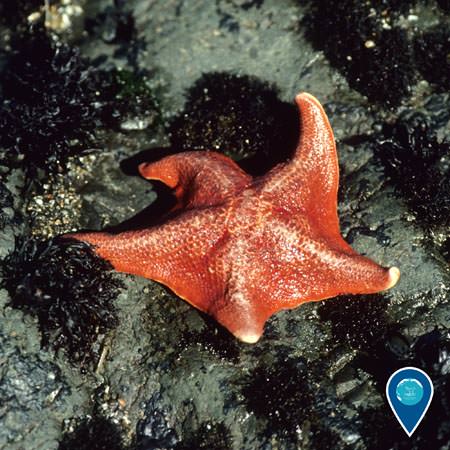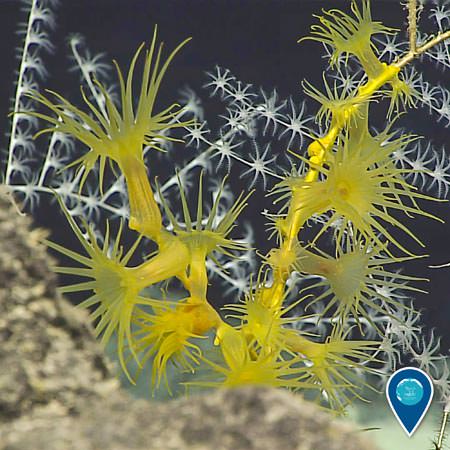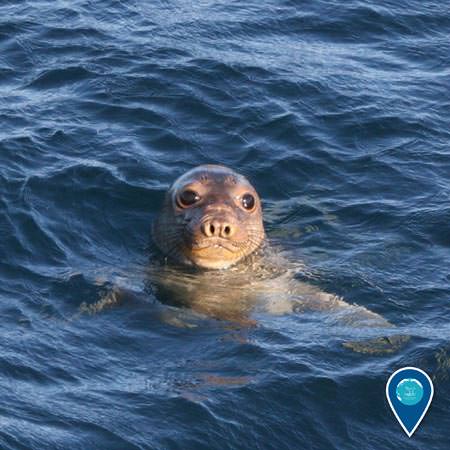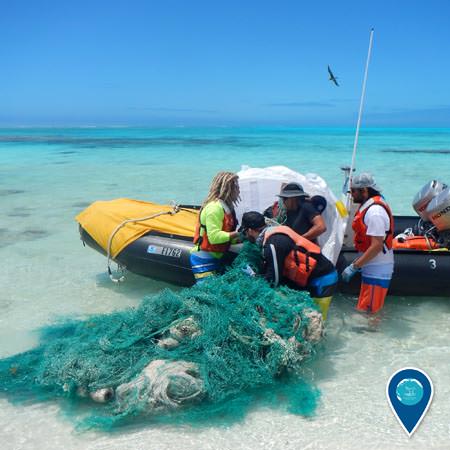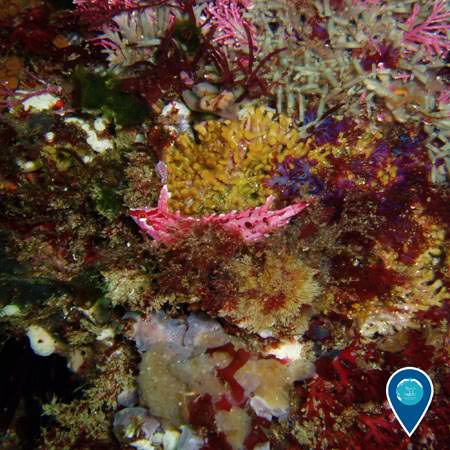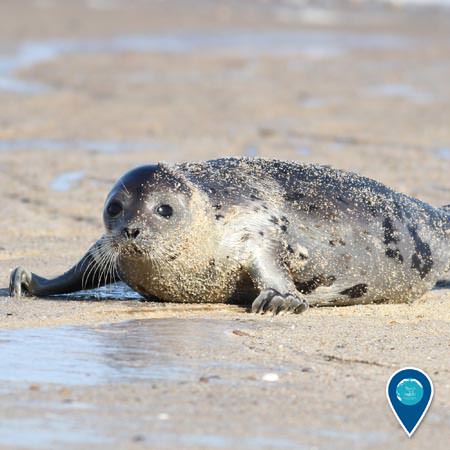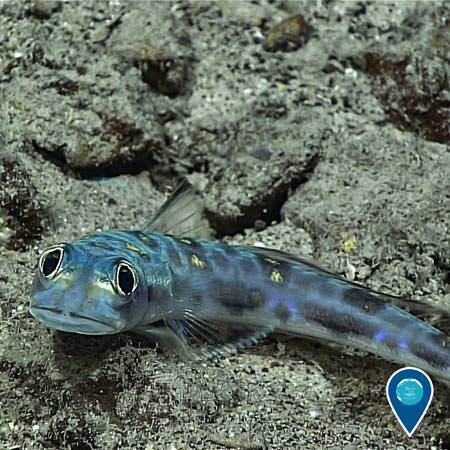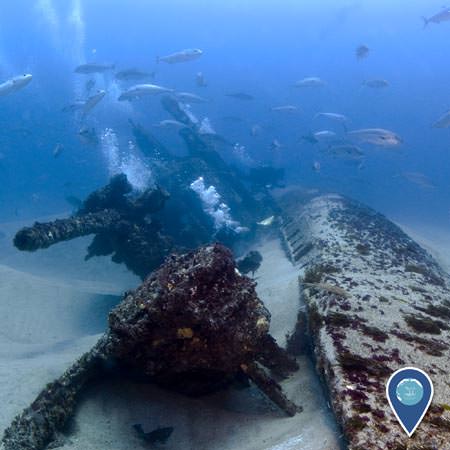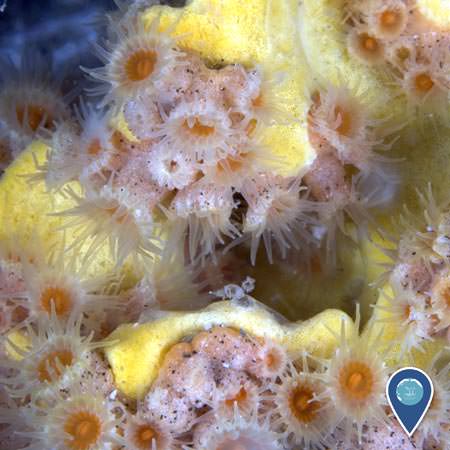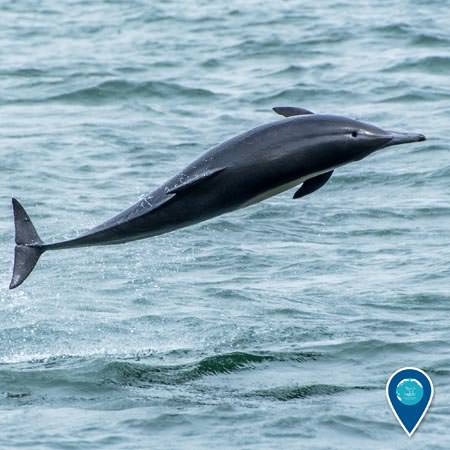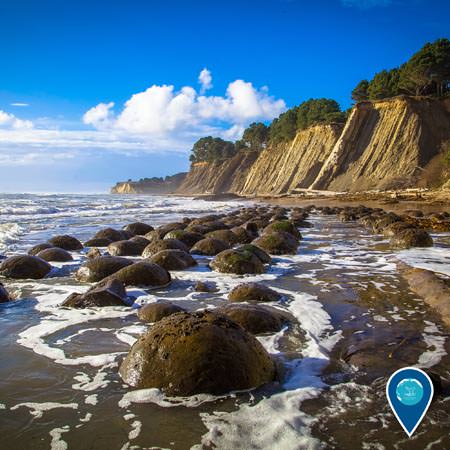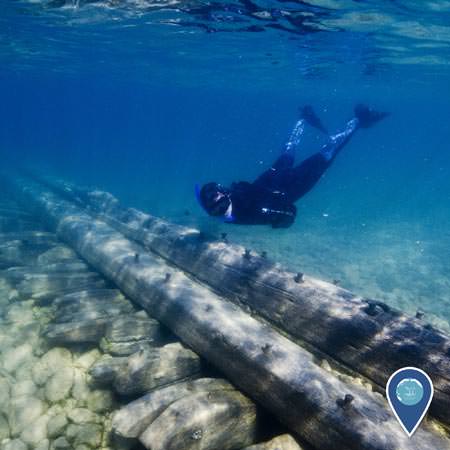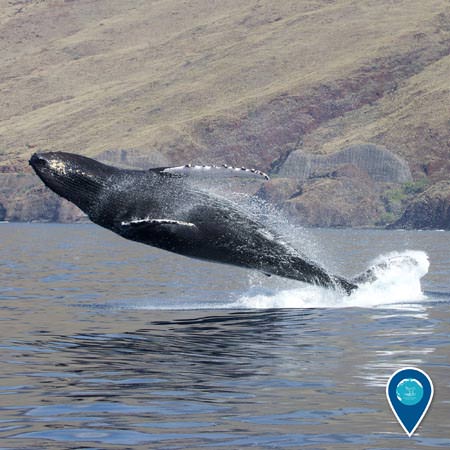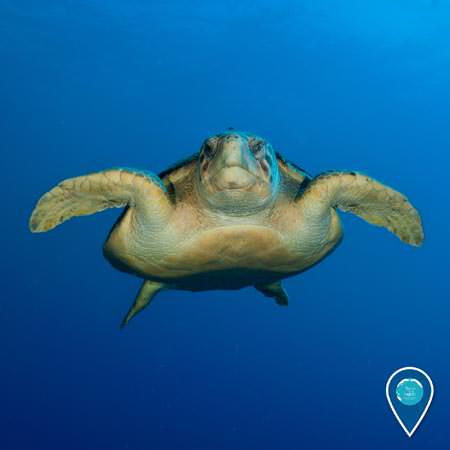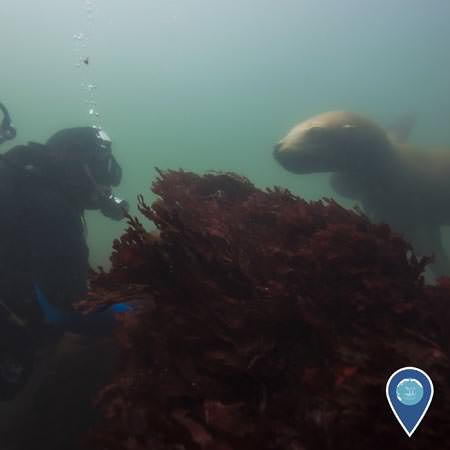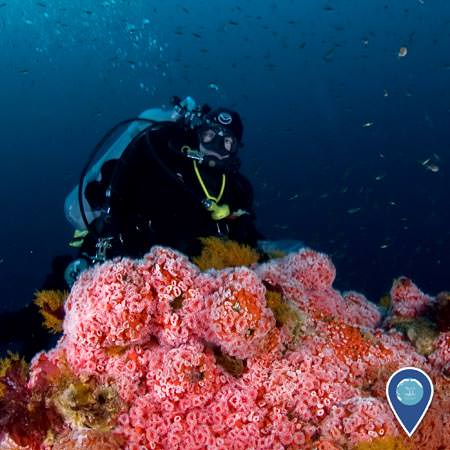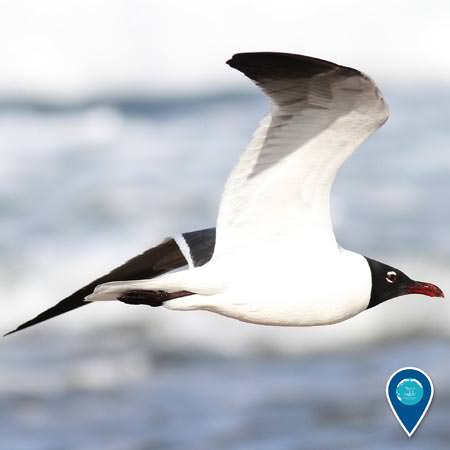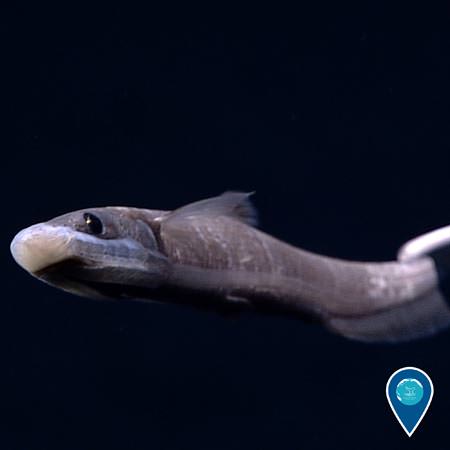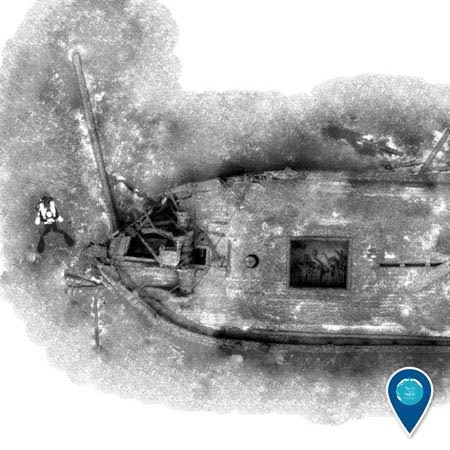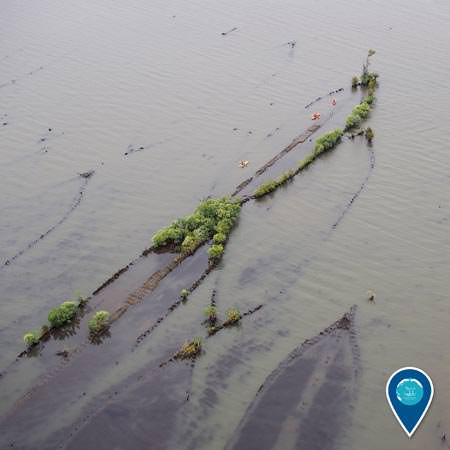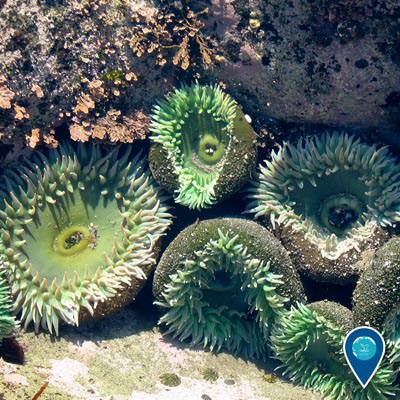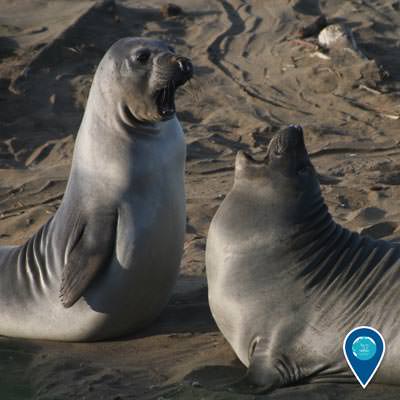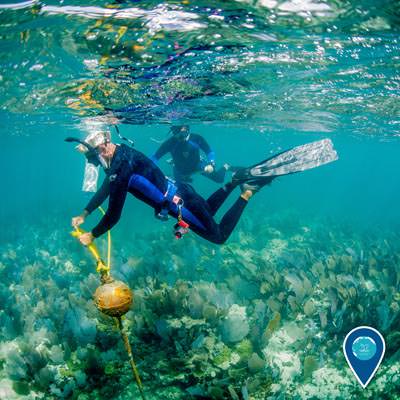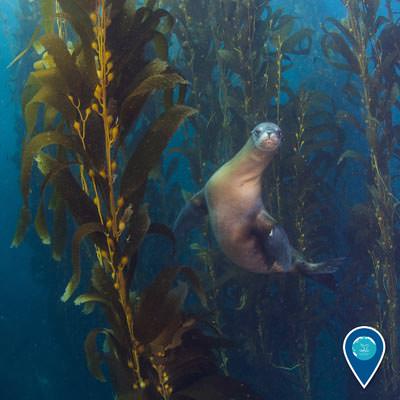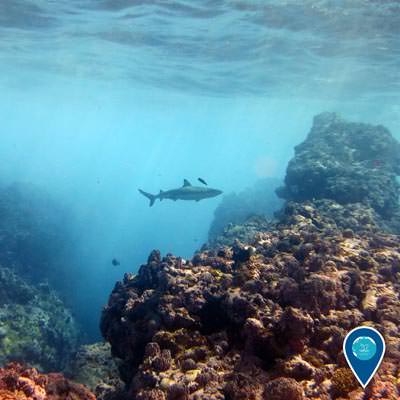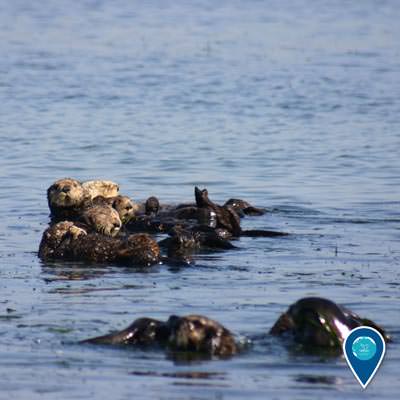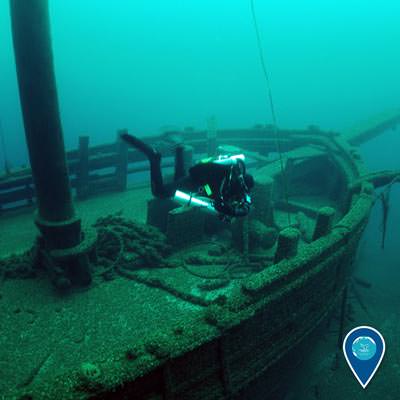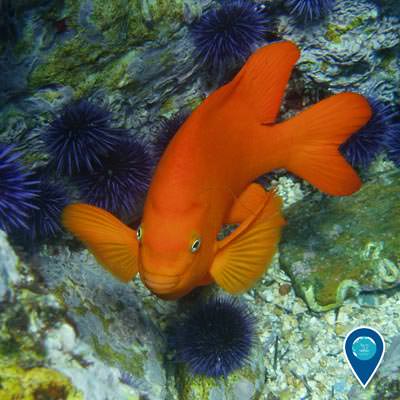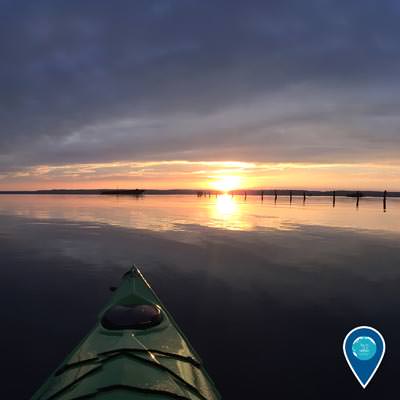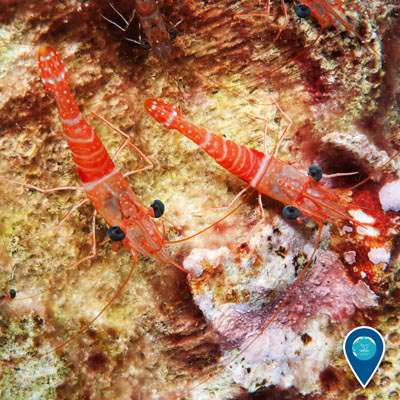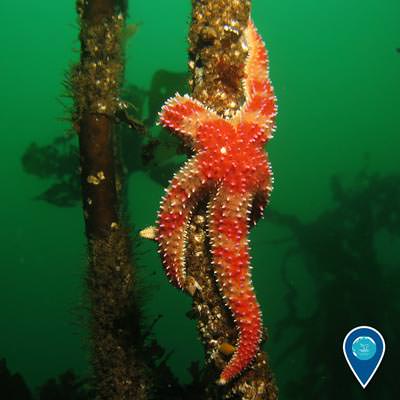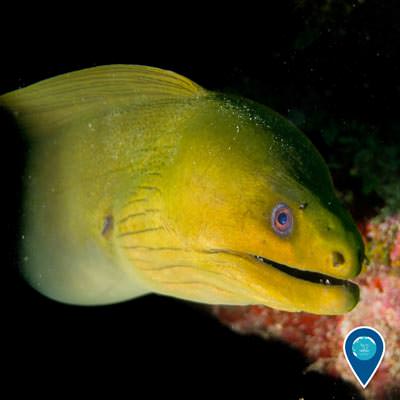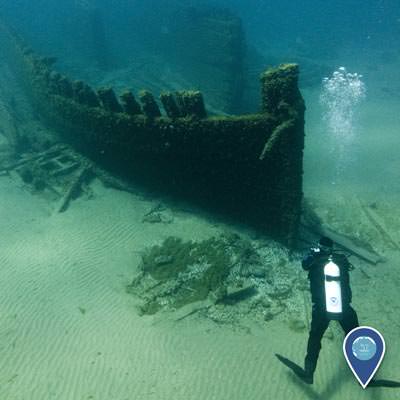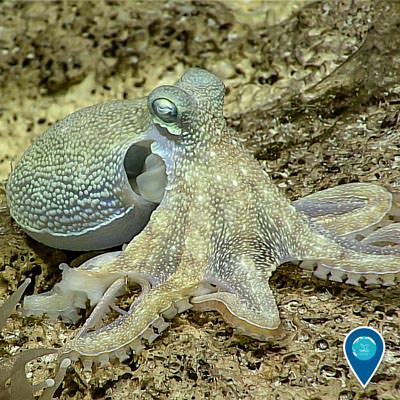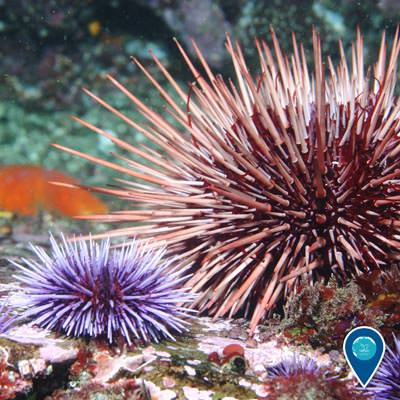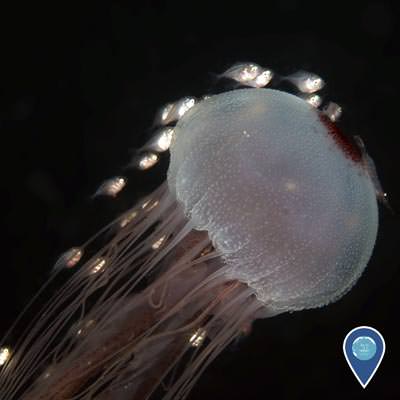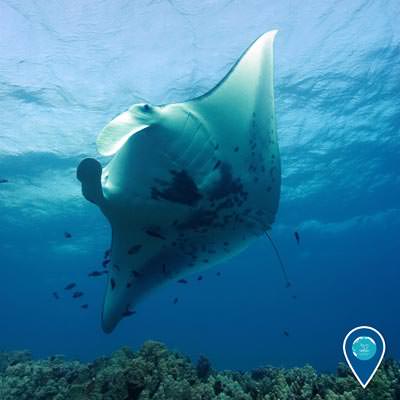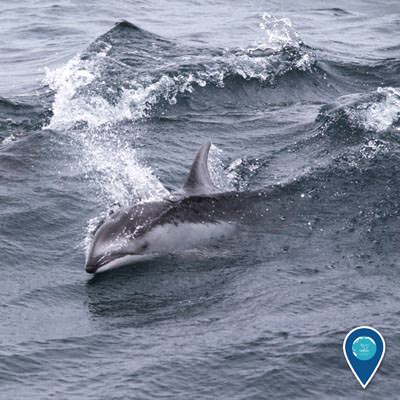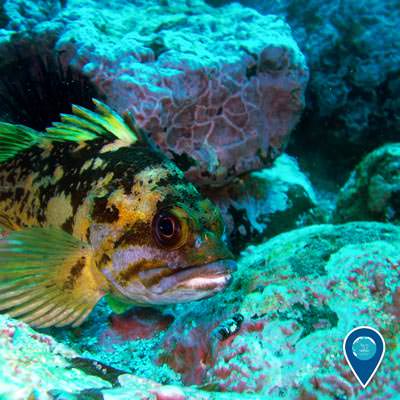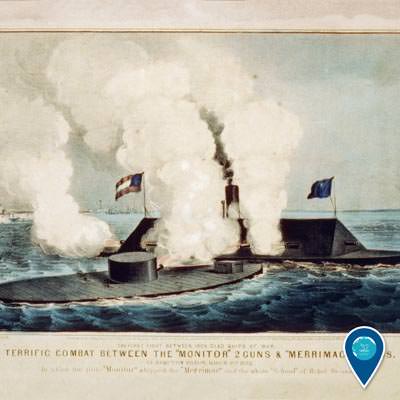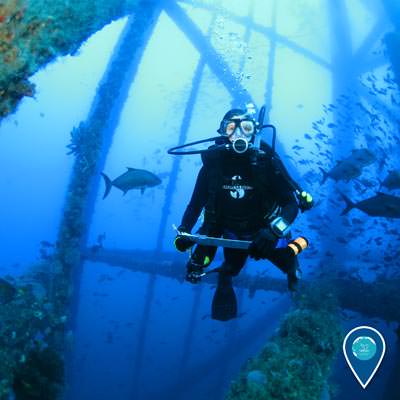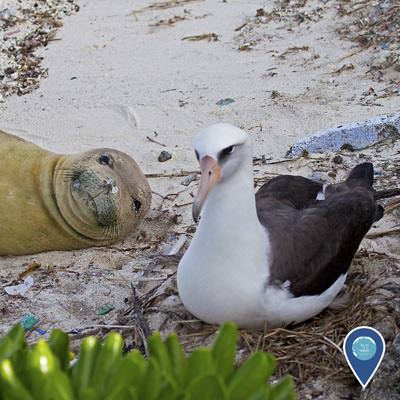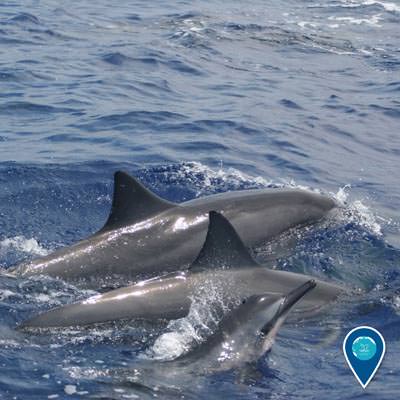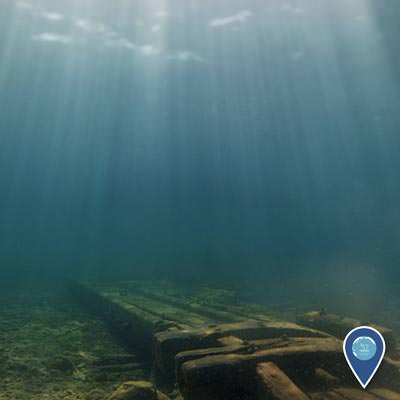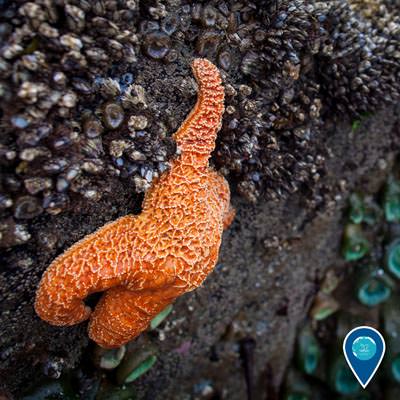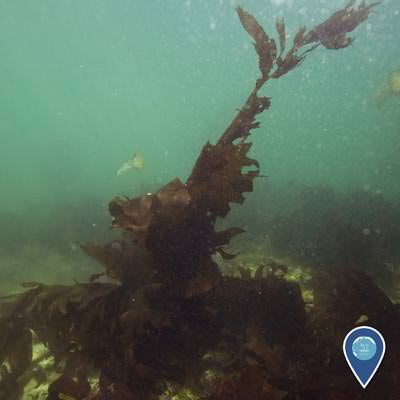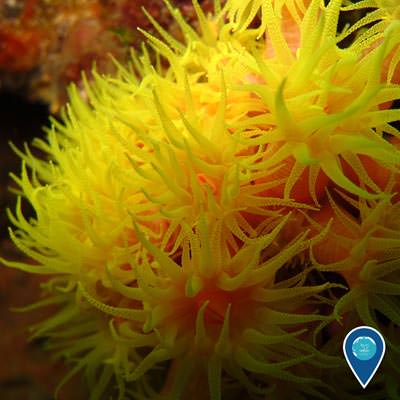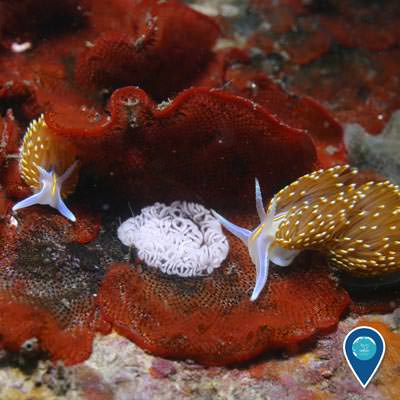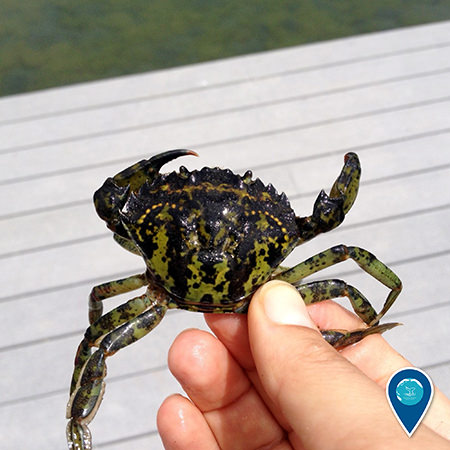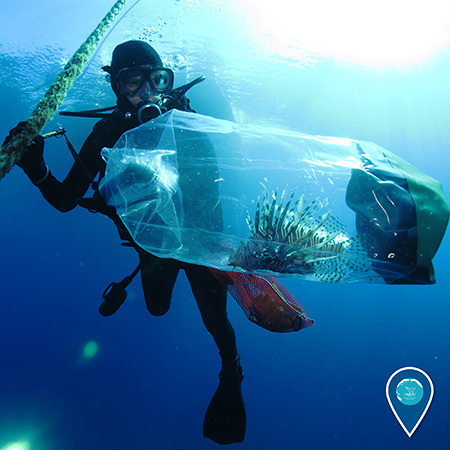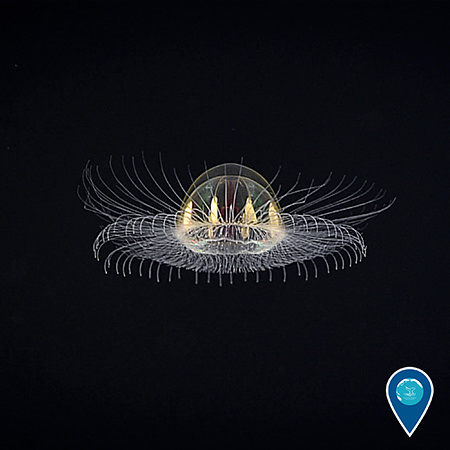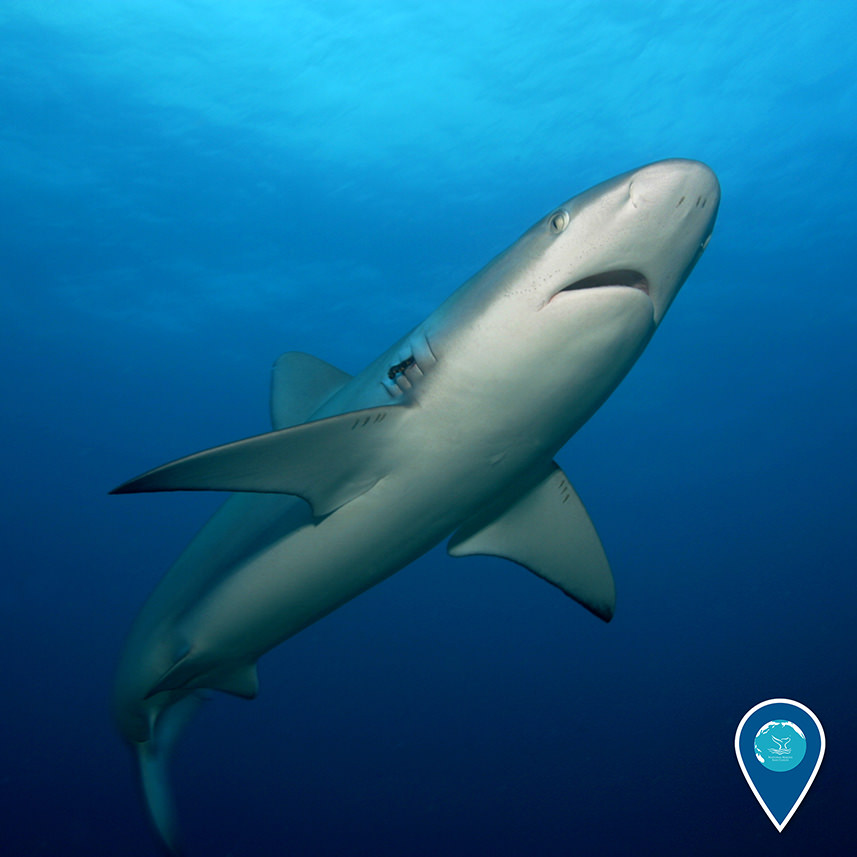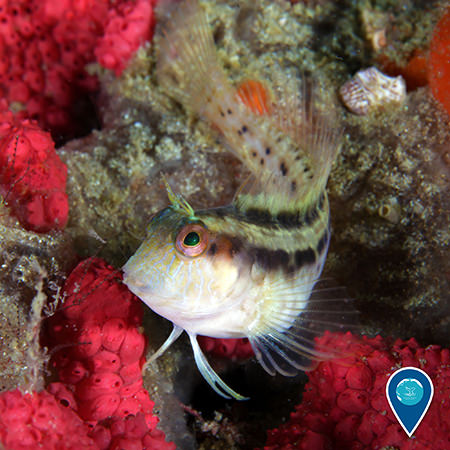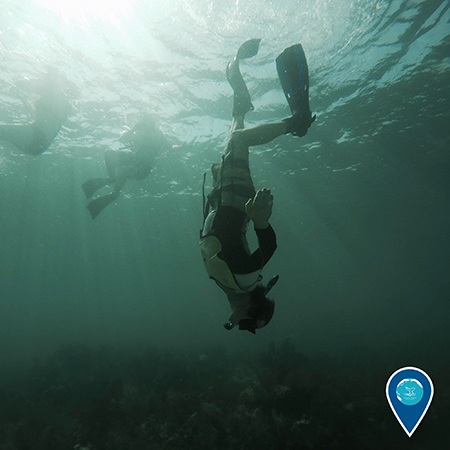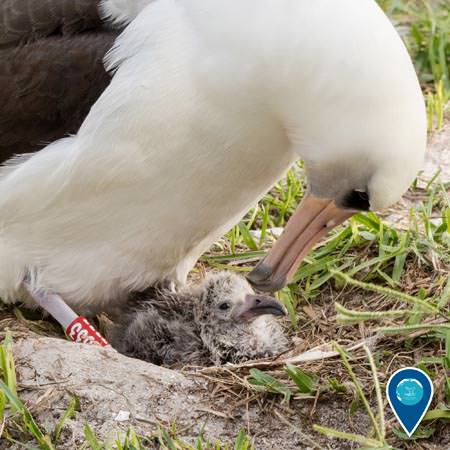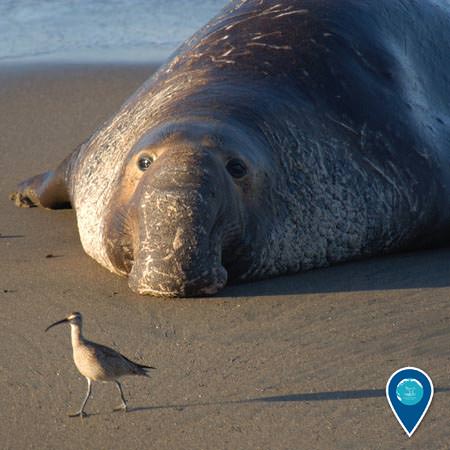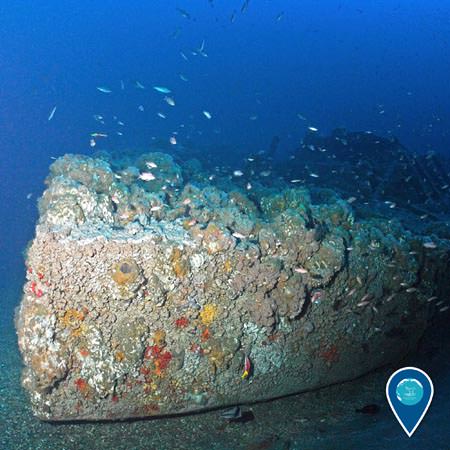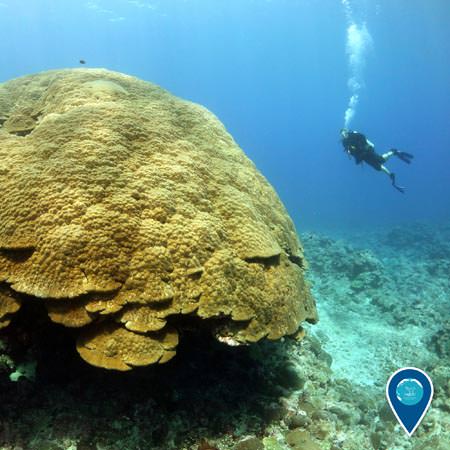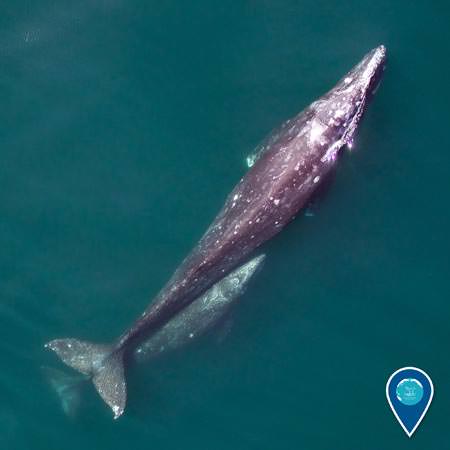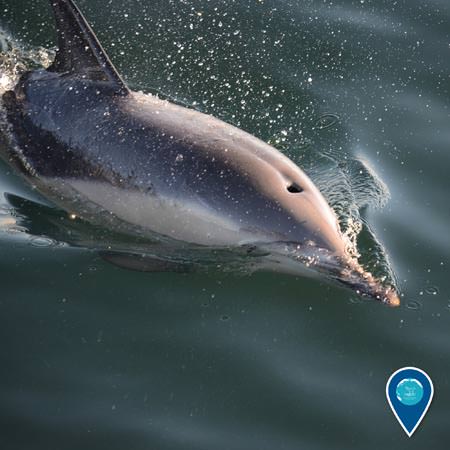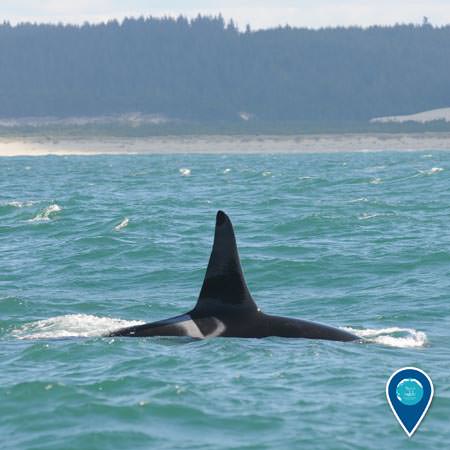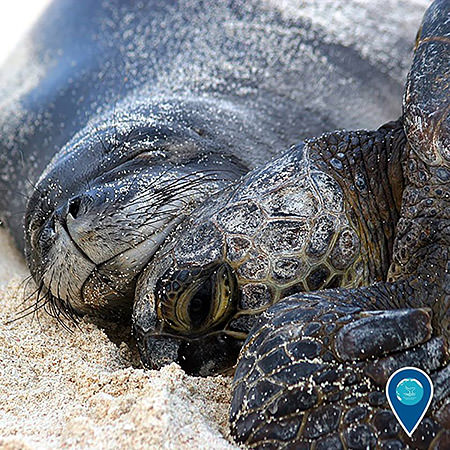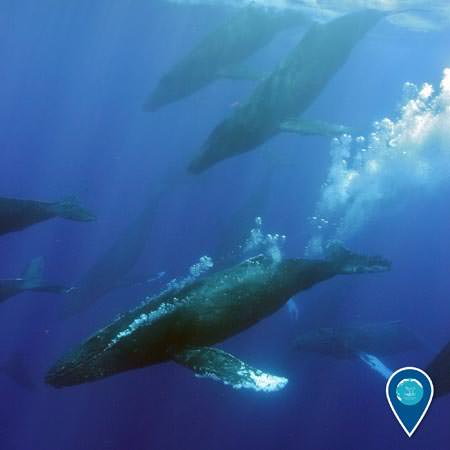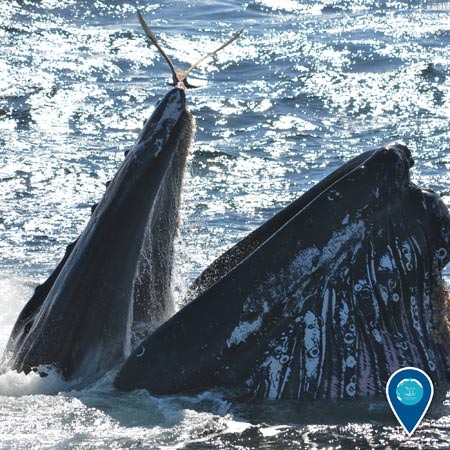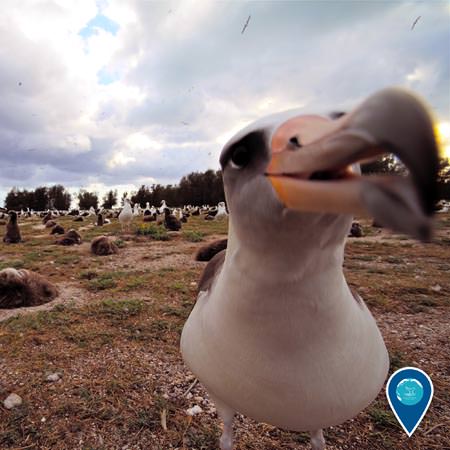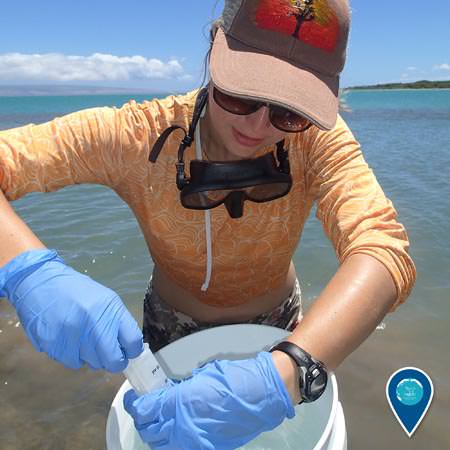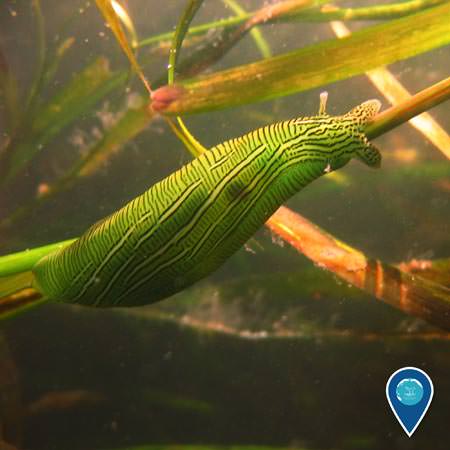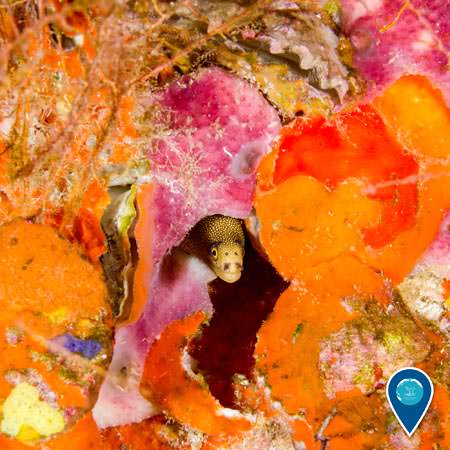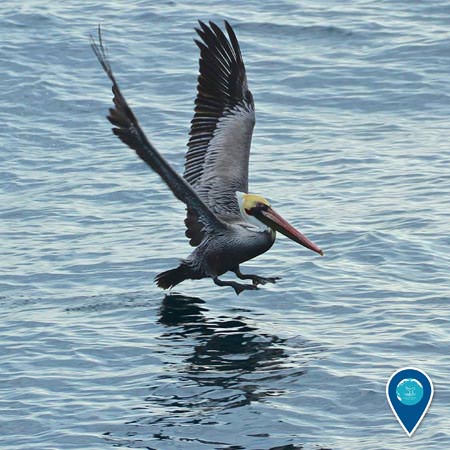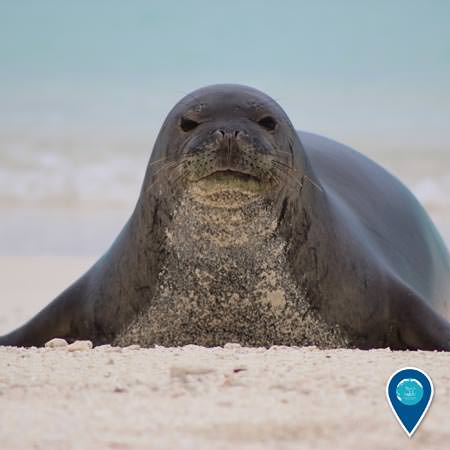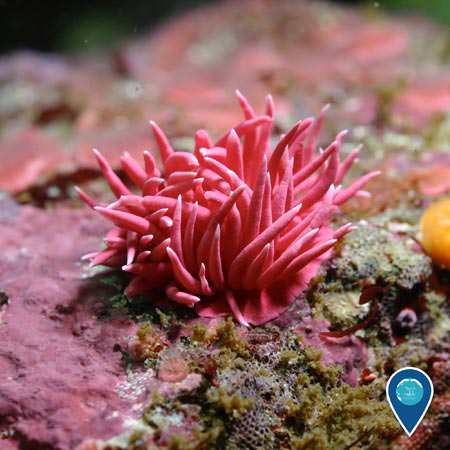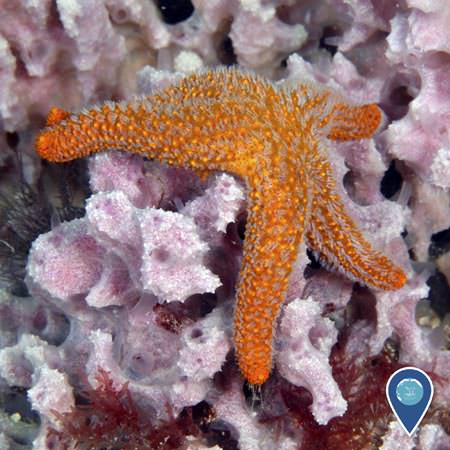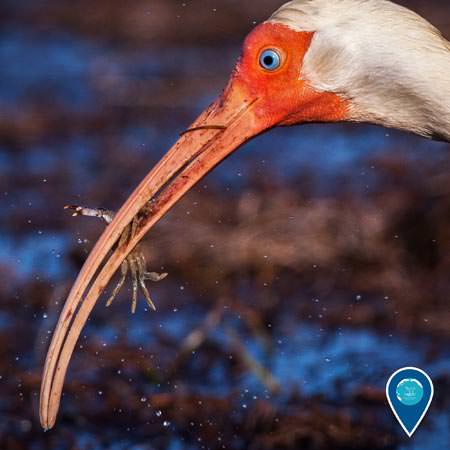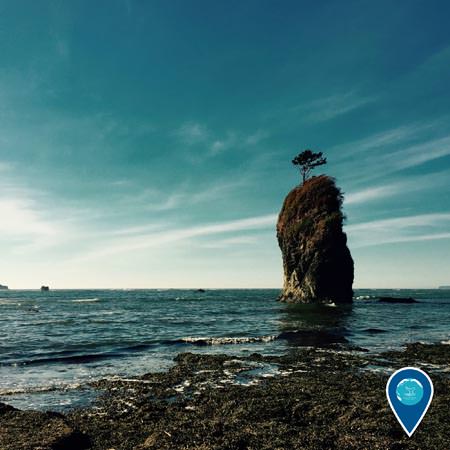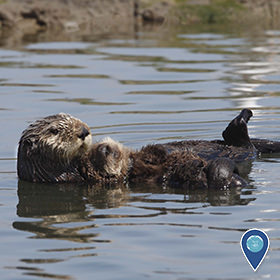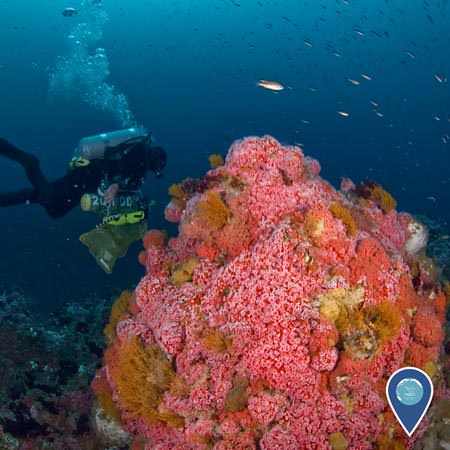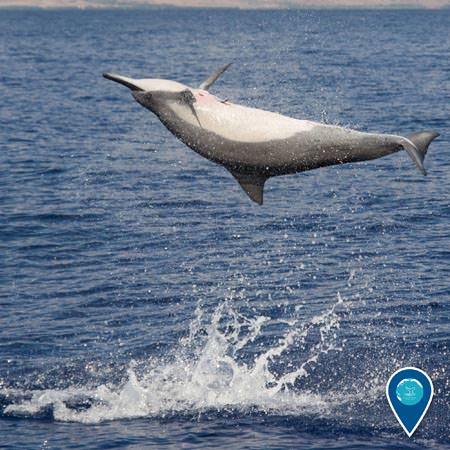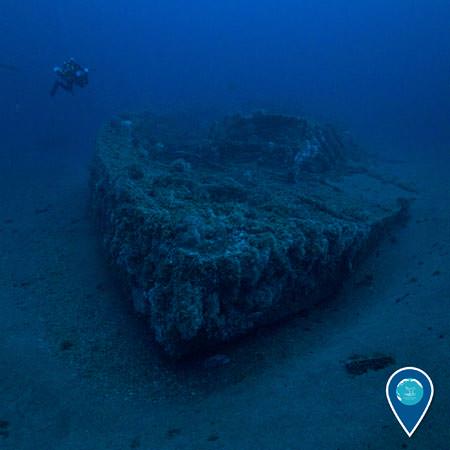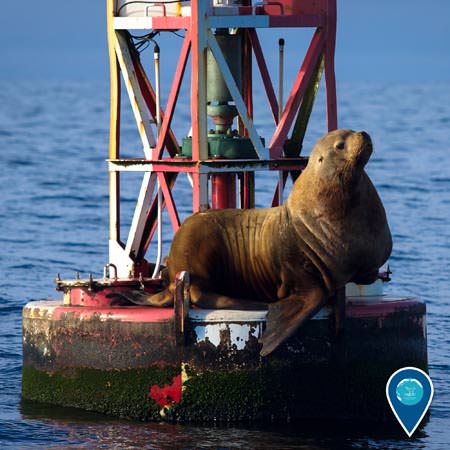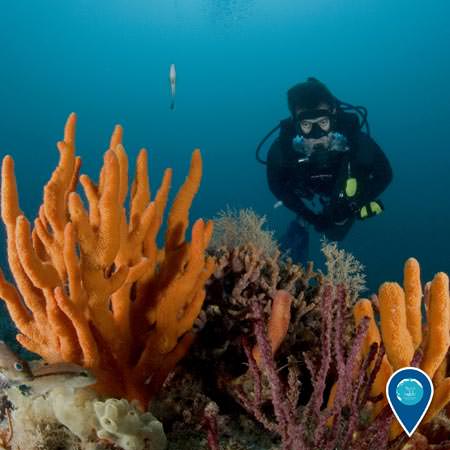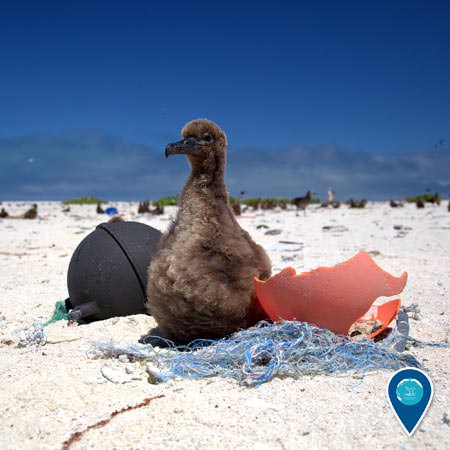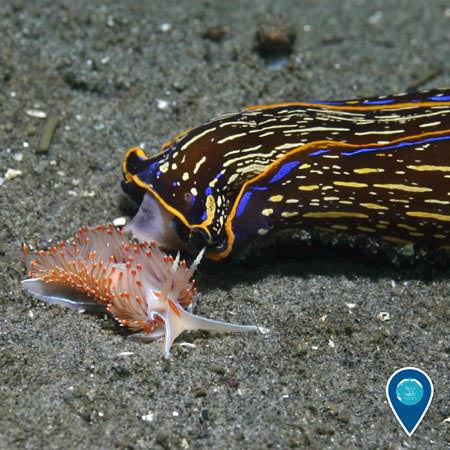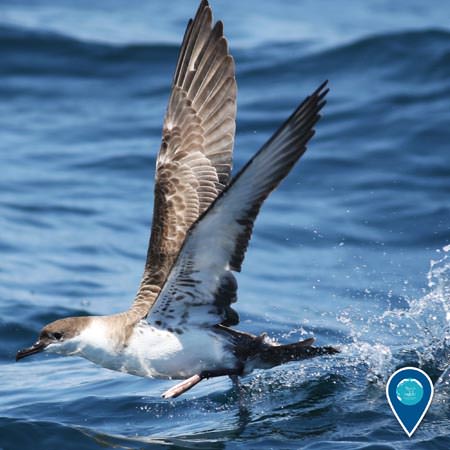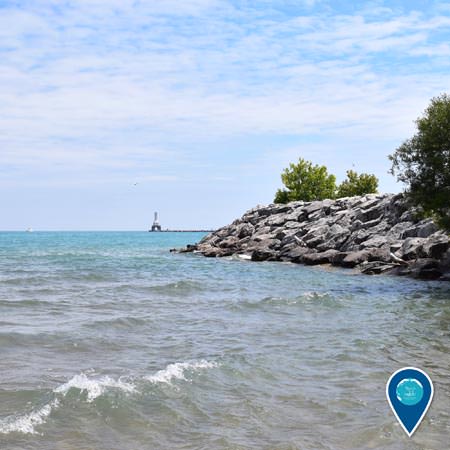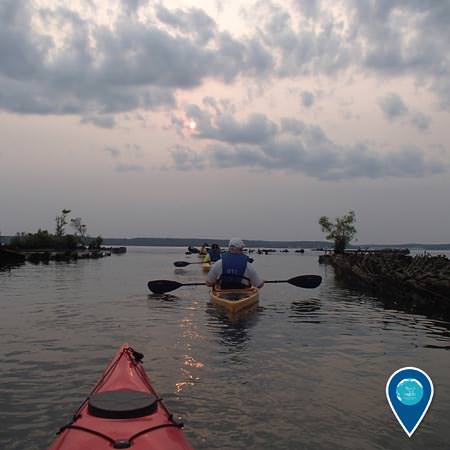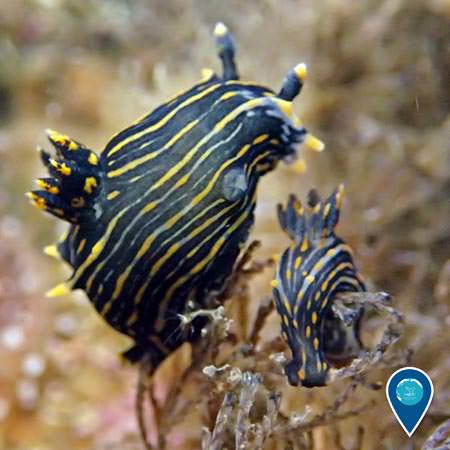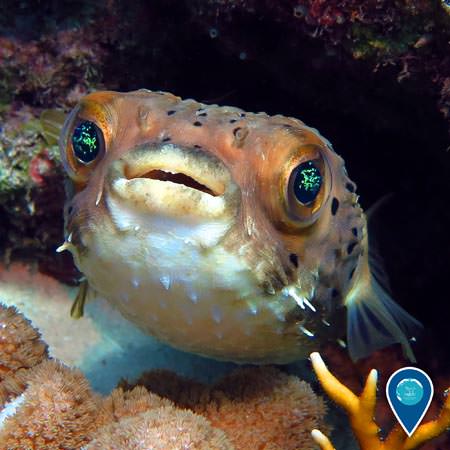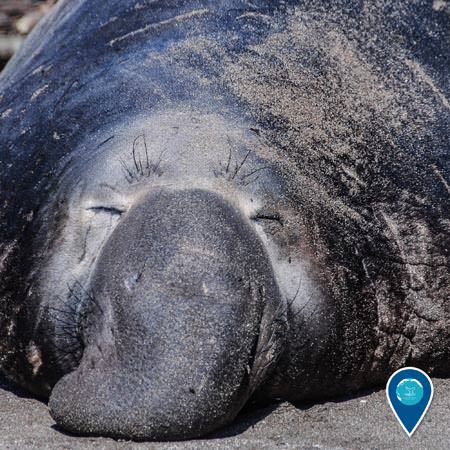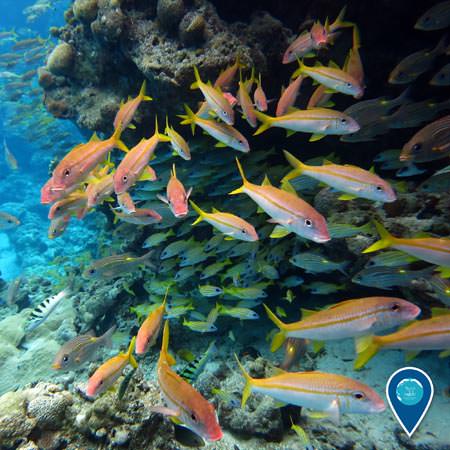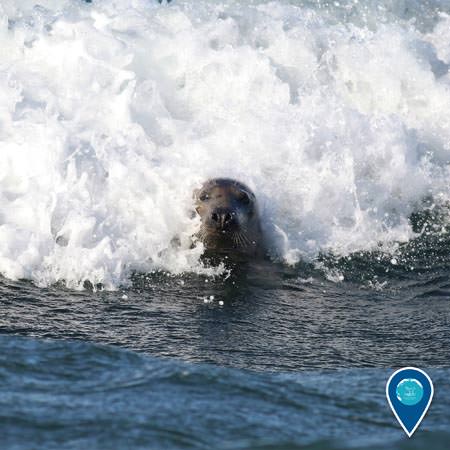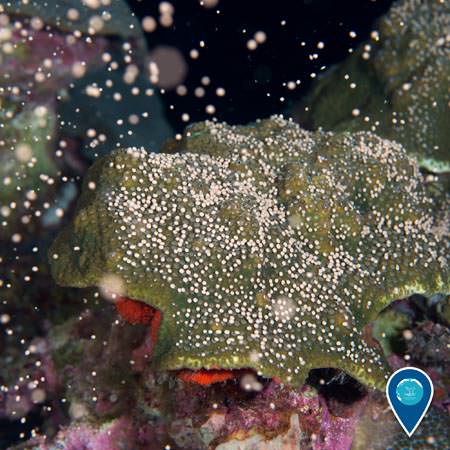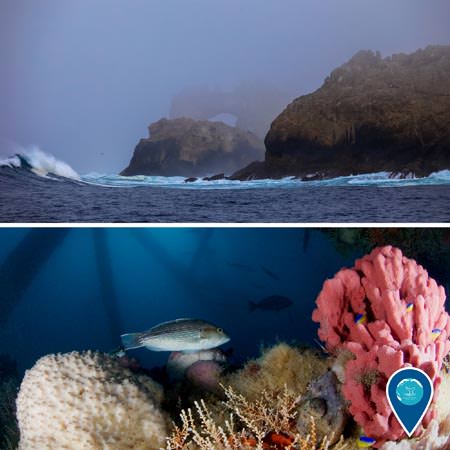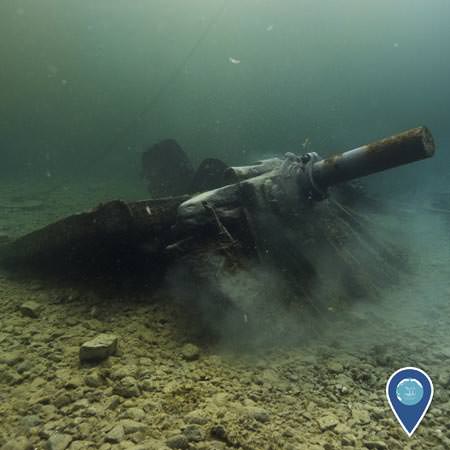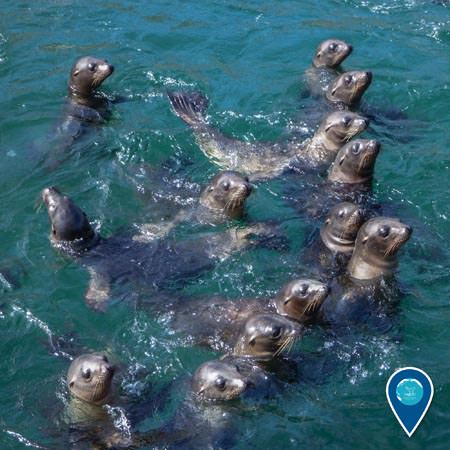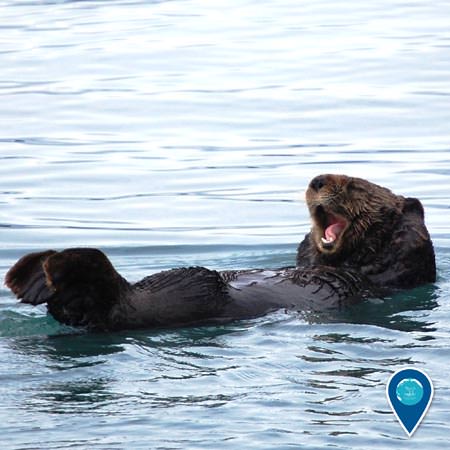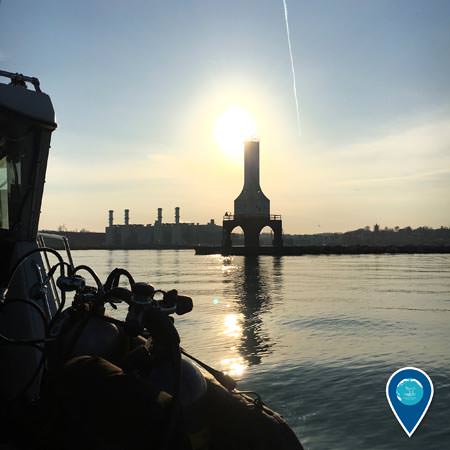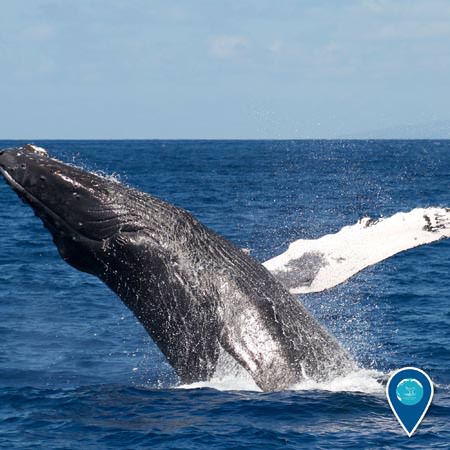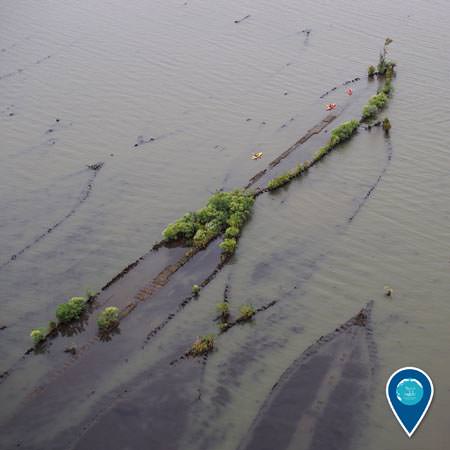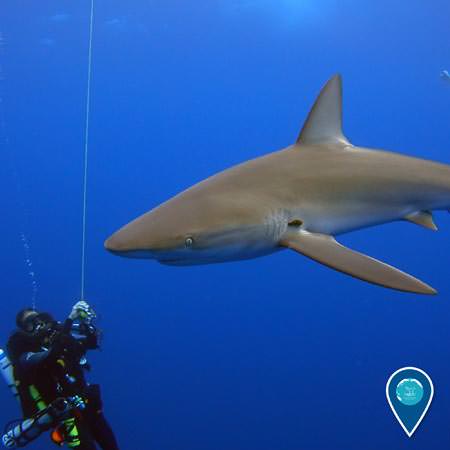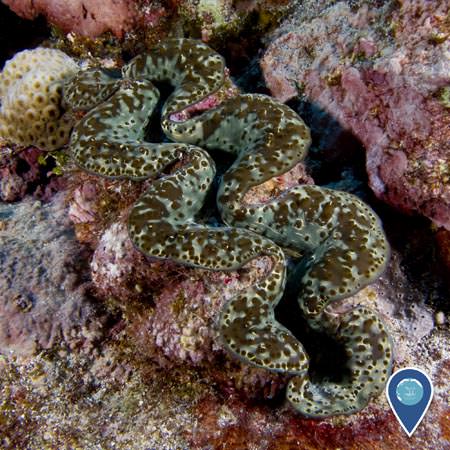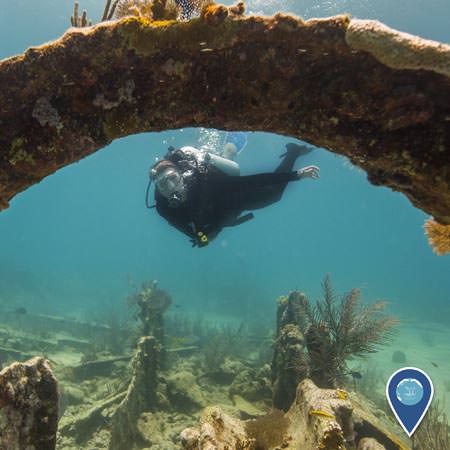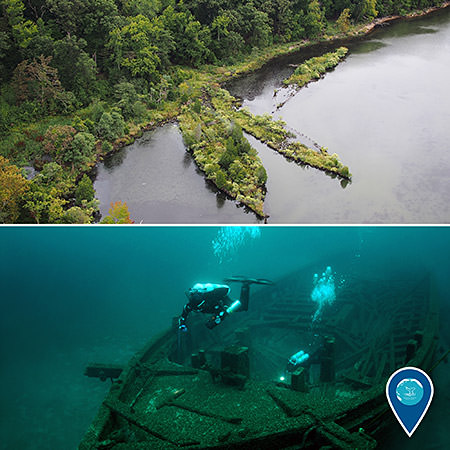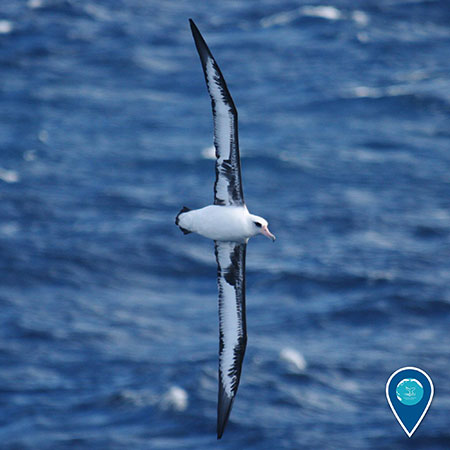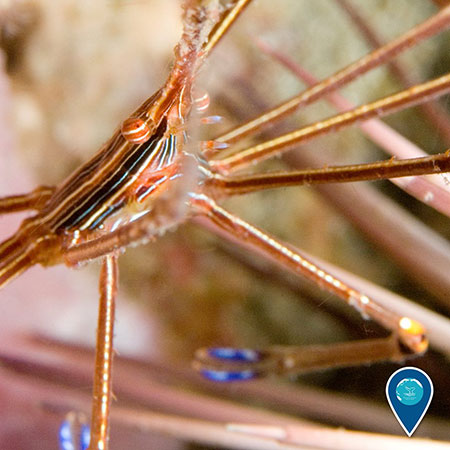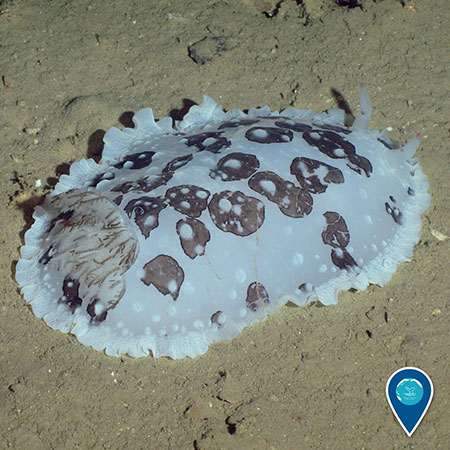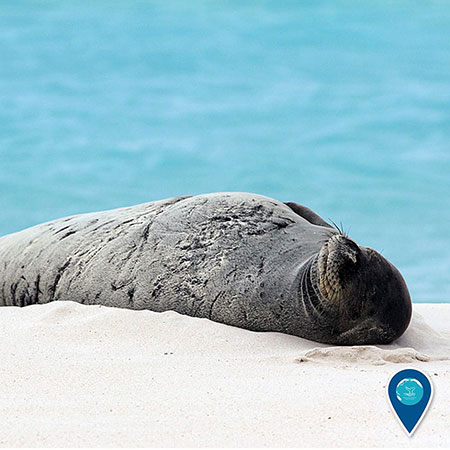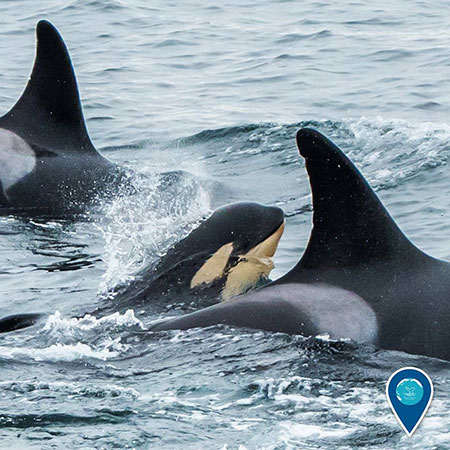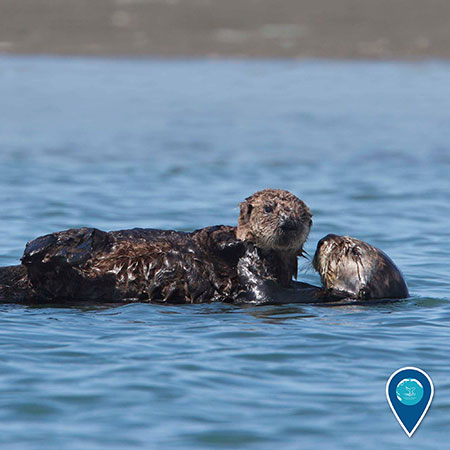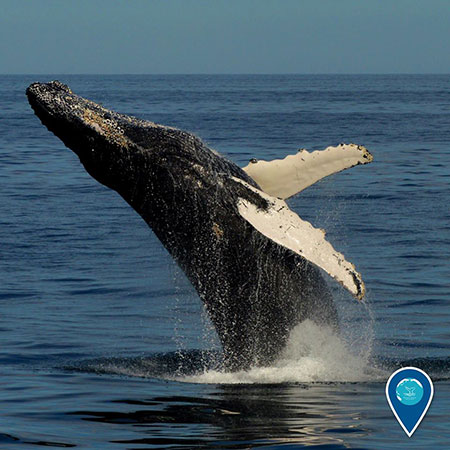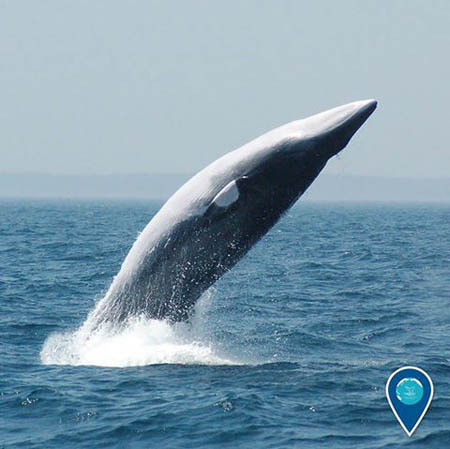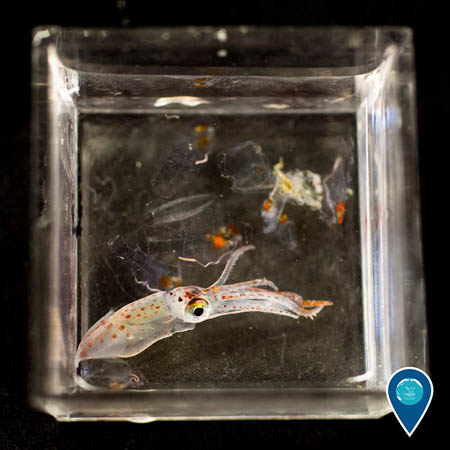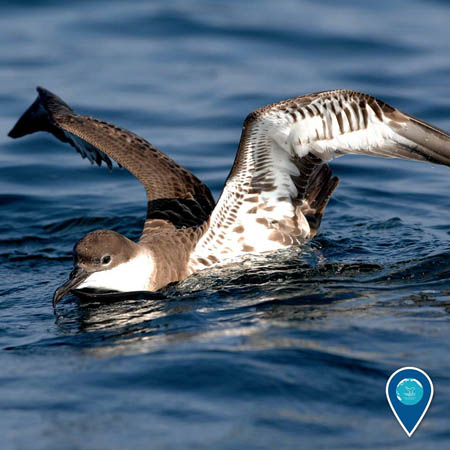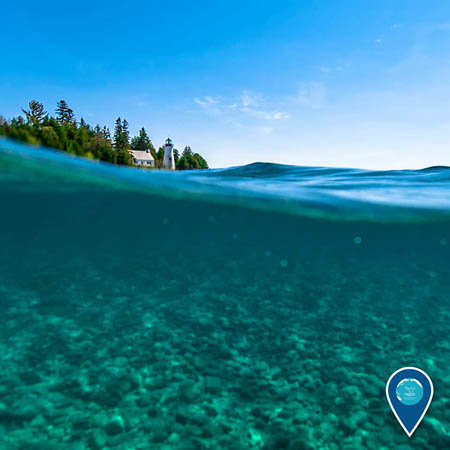
When you look at our planet from space, one thing is abundantly clear: Earth Is Blue. Our planet is an ocean planet, and whether you live near the coast or a thousand miles from it, the ocean is part of your life. From providing the food we eat to determining our weather, the ocean matters to each of us -- and the National Marine Sanctuary System protects this vital resource.
With that in mind, the photos and videos of Earth Is Blue bring these ocean treasures directly to smartphones and computers all over the world, where they can serve as a tangible reminder that no matter where you are, the ocean and Great Lakes are in your hands. We hope these images inspire you to help care for our ocean and to spread the word that Earth isn't green -- it's blue.
Join us on 



 and submit your own photos.
and submit your own photos.
When we burn fossil fuels like oil and gas, we release carbon dioxide into the atmosphere, and some of this atmospheric carbon dioxide is absorbed by the ocean. This carbon dioxide changes the ocean's chemistry, making the water more acidic and making it harder for shelled organisms to construct their shells and survive to adulthood. This can negatively impact shellfish industries and organisms that depend on shellfish as food sources. A combination of factors makes the Washington coast especially susceptible to acidified water, including coastal upwelling, which brings offshore water that is rich in carbon dioxide up from the deep ocean and onto the continental shelf. We can all do our part to protect vulnerable ecosystems like those at Olympic Coast by working with our communities to reduce the amount of fossil fuels we burn -- for example, through supporting local food initiatives or renewable energy programs. (Photo: Karlyn Langjahr/NOAA)
Here, a sand tiger shark swims around the wreck of Caribsea, a 1919 freighter sunk by a German U-boat during World War II. Laden with heavy cargo, Caribsea sank in less than two minutes after being struck by a torpedo in the middle of the night. The abrupt strike left no time for lifeboats to be launched. Survivors of the attack were forced to flee their bunks and jump into the sea, where they would drift, clinging to the wreckage, for some 10 hours before rescue. A few days after Caribsea sank, a man living in North Carolina's Outer Banks discovered a framed certificate drifting up on the surf during a walk on the beach. The certificate, he would find, belonged to his cousin, a Caribsea crewmember, and would confirm the tragic wreck of the Caribsea for the community. Learn more of the history behind the shipwrecks that could be protected by an expanded Monitor National Marine Sanctuary. (Photo: NOAA)
When we burn fossil fuels like oil and gas, we release carbon dioxide into the atmosphere. This carbon dioxide builds up and acts like a heat-trapping blanket, warming the planet. This added warmth does help zooxanthellae photosynthesize -- but the increased rate of photosynthesis can put these algae in a sort of "overdrive" that doesn't give them time to repair their tissues. When they can't repair, zooxanthellae start to release compounds toxic to corals. In response, corals expel algae from their tissues to avoid further damage. Without their algae, corals can die.
How can we slow this process down and protect our oceans? By working with your community to reduce our fossil fuel usage, you can help protect the health of corals daily -- no matter where you live! What will your community do to help support coral reefs? (Photo: XL Catlin Seaview Survey)
When we burn fossil fuels like coal, oil and gas, we release rampant carbon dioxide into the atmosphere. The ocean absorbs carbon dioxide, and in recent years, this rampant carbon dioxide has been changing its chemistry, making the water more acidic. This ocean acidification affects the amount of building material -- calcium carbonate -- available to organisms like pinto abalone. So while juvenile pinto abalone like this one are trying to build their shells, it's harder to find that building material and the abalone's shell becomes weaker.
The loss of organisms like abalone can affect an entire ecosystem, since many animals depend on abalone for food. But there's good news: by reducing the amount of carbon dioxide we release into the atmosphere, we can help these animals survive. By working together to support and use renewable energy, we can protect important species like the pinto abalone. (Photo: Steve Lonhart/NOAA)
Dec. 31, 2015: On New Year's Eve, 1862, the USS Monitor hit a storm off the coast of Cape Hatteras, North Carolina. Each wave sent the ship pitching and rolling, devastating the hull of our nation's first ironclad warship. Leaks developed, flooding the engine and reducing stream pressure needed for propulsion. Finally, the crew raised the distress signal to the USS Rhode Island, and the Rhode Island deployed its lifeboats in an effort to rescue the crew. But with the turret as the ship's only escape hatch, 16 brave men aboard the Monitor never met the year of 1863. Now, Monitor National Marine Sanctuary protects the resting place of this historic ship and its brave crew. (Painting: Tom Freeman)
Dec. 30, 2015: Serious #squadgoals in Channel Islands National Marine Sanctuary. (Photo: Claire Fackler/NOAA)
Dec. 29, 2015: Happy Turtle Tuesday! The green sea turtle is the most common sea turtle in Hawaiian Islands Humpback Whale National Marine Sanctuary, where it feeds on marine plants in shallow coastal waters. While Hawai'i's green sea turtle population has increased in recent years, they are still threatened by things like entanglement in fishing gear and other marine debris. You can help these gentle creatures by keeping trash out of the ocean! (Photo: Ed Lyman/NOAA)
Dec. 28, 2015: Forty-two years ago today, the Endangered Species Act was signed into law, recognizing our nation's rich natural heritage. Hawaiian monk seals -- found in Hawaiian Islands Humpback Whale National Marine Sanctuary and Papahānaumokuākea Marine National Monument -- are one species that have been given vital protection under this piece of legislation. Only about 1,100 of these seals are left in the world, and we're working hard to help this adorable population recover. (Photo: James Watt/NOAA)
Dec. 27, 2015: What better way to spend a holiday weekend than celebrating in your local national marine sanctuary? Click here to learn about all the things you can do when you #visitsanctuaries. (Photo: David J. Ruck/NOAA) Every Kid in a Park
Dec. 26, 2015: When they say giant, they mean it -- the giant Pacific octopus has an arm span of about 10 feet! This one was spotted in Greater Farallones National Marine Sanctuary. (Photo: NOAA)
Dec. 25, 2015: Gather round the Christmas tree...worms? NOAA diver Emma Hickerson took this photo of Christmas tree worms in Flower Garden Banks National Marine Sanctuary. These colorful marine worms use their Christmas-tree-like crowns for respiration and to catch phytoplankton for dinner. Learn more about them. Happy holidays from the NOAA Office of National Marine Sanctuaries! (Photo: Emma Hickerson/NOAA)
Dec. 24, 2015: The food-rich waters of Cordell Bank National Marine Sanctuary make it a major feeding destination for thousands of local and migratory seabirds like albatrosses. A perfect place to take part in the The National Audubon Society Christmas Bird Count! (Photo: NOAA)
Dec. 23, 2015: When visiting Channel Islands National Marine Sanctuary, marine biology student Mandi Chamberlin snapped this awesome photo of two black turban snails on the rocks of Anacapa Island. These small snails are found along the Pacific coast and live in the intertidal zone, where they graze on algae. Have you taken an amazing photo in a national marine sanctuary? Send it to earthisblue@noaa.gov for a chance to see it on sanctuaries.noaa.gov/earthisblue and on our social media! (Photo: Mandi Chamberlin)
Dec. 22, 2015: Today marks the winter solstice, the shortest day of the year. This is also the time of year when humpback whales migrate to Hawaiian Islands Humpback Whale National Marine Sanctuary to mate, calve, and nurse their young in the warm, shallow waters surrounding the Hawaiian Islands. Click here to learn more about humpback whales in the sanctuary. (Photo: Ed Lyman/NOAA, NOAA Permit #774-1714)
Dec. 21, 2015: Opalescent nudibranchs -- like this one in Cordell Bank National Marine Sanctuary -- prey on hydroids and anemones, which have stinging cells to defend themselves from predators. But those stinging cells don't harm the nudibranch; instead, during digestion they travel into the nudibranch's colorful appendages and can later be used against the nudibranch's own predators. (Photo: Matt Vieta)
Dec. 20, 2015: National Marine Sanctuary of American Samoa is home to the only true tropical reef in the National Marine Sanctuary System! Here in the reefs surrounding Aunu'u Island, a few pink anemonefish nestle into an anemone. (Photo: Wendy Cover/NOAA)
Dec. 19, 2015: What -- you mean the new Star Wars movie isn't about sea star vs. sea urchin wars in Gray's Reef National Marine Sanctuary?? (Photo: Greg McFall/NOAA)
Dec. 18, 2015: A long time ago, in a galaxy far, far away, a mighty sea lion -- er, Wookiee -- named Chewbacca reigned the shores of Olympic Coast National Marine Sanctuary. (Design: Carey Floyd)
Dec. 17, 2015: Constructed in 1862, the USS Monitor was our nation's first ironclad warship. Here, officers sit for a portrait before the Monitor's rotating gun turret. Tragically, later that year the ship sank in a storm off the coast of Cape Hatteras, North Carolina, taking 16 brave crew members with it into the ocean depths. In 1975 its resting place became our first national marine sanctuary -- Monitor National Marine Sanctuary. Learn more about the wreck here. (Photo courtesy of The Library of Congress)
Dec. 16, 2015: One common eider, two common eiders, three common eiders... For years now, Stellwagen Bank National Marine Sanctuary has been partnering with The National Audubon Society on their annual Christmas Bird Count. Seabirds are often the first indicators of change within an ecosystem, so tracking their populations over time allows us to evaluate the health of the sanctuary. Learn more about the Stellwagen Bank count here. Will you be participating in a Christmas Bird Count near you? (Photo: Peter Flood)
Dec. 15, 2015: The tide pools of Olympic Coast National Marine Sanctuary are perfect places for kids and adults alike to explore marine life. How many sea urchins can you spot in this photo? (Photo: Elizabeth Weinberg/NOAA) Every Kid in a Park
Dec. 14, 2015: This beautiful shell found in Papahānaumokuākea Marine National Monument belongs to a Triton's trumpet ('ole in Hawaiian), a species of sea snail that can grow up to 20 inches long! Triton's trumpets feed on sea stars and urchins by injecting them with a paralyzing agent in their saliva. Because they feed on coral-eating species like the crown-of-thorns starfish, they are an important species for maintaining reef health. (Photo: James Watt/NOAA)
Dec. 13, 2015: What's a nudibranch, anyway? These soft-bodied mollusks are sometimes known as sea slugs. "Nudibranch" means "naked gills" -- those colorful "feathers" on the back of this hermissenda nudibranch actually help it breathe as it explores the rocky reef of Channel Islands National Marine Sanctuary. What's your favorite kind of nudibranch? (Photo: Claire Fackler/NOAA)
Dec. 12, 2015: Monterey Bay National Marine Sanctuary visitor Laura Shamas snapped this awesome photo of the sanctuary shoreline! Look carefully and you can spot some lounging seals on the beach. Have you taken any neat photos while visiting your local sanctuary? Email it to earthisblue@noaa.gov for a chance to have your photo featured on our social media! (Photo: Laura A. Shamas)
Dec. 11, 2015: It's #FishFriday -- and we need your help! Caption this photo of a red Irish lord (Hemilepidotus hemilepidotus) hanging out in Cordell Bank National Marine Sanctuary. (Photo: Matt Vieta)
Dec. 10, 2015: Did you know that after #InTheHeartOfTheSea Captain George Pollard returned to Nantucket after the sinking of the whaleship Essex, he captained another ship? Unfortunately, Pollard's luck still wasn't with him, and the Two Brothers sank during a storm in the Northwestern Hawaiian Islands -- though this time the ship's crew were all rescued. In 2008, maritime archaeologists located the wreck in Papahānaumokuākea Marine National Monument; here, archaeologist Dr. Kelly Gleason examines a ginger jar at the wreck site. Learn more about the wreck's history and check out photos! (Photo: Greg McFall/NOAA)
Dec. 9, 2015: How do you a tag a whale? With a suction cup! Researchers in Stellwagen Bank National Marine Sanctuary use tags like this one -- which typically stay on for a day or less -- to learn where whales are going, how they're moving, and the noises they're making and hearing. With this data, we can better understand whale behavior and learn how we can best protect them from threats like ship strikes! Check out how it's done in our video. (Photo: NOAA Fisheries Permit #775-1600-10) #WhaleWednesday
Dec. 8, 2015: This polka-dot batfish, found in Florida Keys National Marine Sanctuary, isn't going anywhere fast! A relatively sluggish species, batfish use their pectoral fins to walk along the bottom and rely on camouflage to catch their prey. (Photo: Southeast Fisheries Science Center/NOAA)
Dec. 7, 2015: On this day in 1941, a Japanese attack at Pearl Harbor on Oahu led to the United States' entry into World War II. Minutes before attacking Pearl Harbor, Japanese Imperial Navy aircraft bombed the nearby U.S. Naval Air Station, destroying 27 Catalina PBY "flying boats." Thanks to a recent collaboration with the University of Hawaii Marine Option Program, we now have images of the wreck of one of these Catalina PBYs, which rests in three large pieces at a depth of 30 feet. Click here to learn more about the wreck. (Photo: UH Marine Option Program)
Dec. 6, 2015: HELLOOOOO! Curious harbor seals often lift their heads out of the water to view their surroundings. They are found in coastal waters in the North Pacific and the North Atlantic. What do you think this little fellow has spotted in Stellwagen Bank National Marine Sanctuary? (Photo: Elliott Hazen/NOAA Fisheries Permit #14245)
Dec. 5, 2015: It's International Volunteer Day! Volunteers in national marine sanctuaries participate in a wide variety of activities including diving, whale identification and beach cleanups. These volunteers are involved in Hawaiian Islands Humpback Whale National Marine Sanctuary and the National Marine Sanctuary Foundation's Sanctuary Ocean Count, which offers the community a chance to monitor humpback whales from the shores of Oʻahu, Hawaiʻi and Kauaʻi. Click here to learn more about the upcoming Sanctuary Ocean Count! (Photo: Paul Wong) #actioncounts
Dec. 4, 2015: Papahānaumokuākea Marine National Monument in the Northwestern Hawaiian Islands is home to 4,500 square miles of dynamic coral reefs. Unfortunately, as a result of climate change, vivid corals like these are threatened by coral bleaching. Tune in this afternoon to learn how researchers are studying the recent bleaching event to learn how we can best protect these special ecosystems! (Photo: James Watt/NOAA) #CoralsWeek
Dec. 3, 2015: What's wrong with this picture? When corals are stressed, they expel photosynthetic algae called zooxanthellae that they need to survive. This is known as bleaching, because zooxanthellae are what give corals their bright colors. Bleaching can happen when water temperature increases, as it has recently in Hawaiian Islands Humpback Whale National Marine Sanctuary and other places throughout the ocean. Because we are warming the earth by burning fossil fuels, the ocean is getting too hot for many coral species. But there are things we can do: by curbing your fossil fuel consumption and reducing other coral stressors, like pollution, you can help our vibrant coral reefs survive! Learn more here. (Photo: NOAA) #CoralsWeek
Dec. 2, 2015: The reefs of Flower Garden Banks National Marine Sanctuary lie on top of salt domes rising from the sea floor in the Gulf of Mexico. While the ecosystem of Stetson Bank, one site within the sanctuary, mostly supports algae and sponges, its tallest pinnacle is dominated by corals and is typically swarming with fish! Can you spot the spiny lobster, blackbar soldierfish, sergeant majors, and juvenile Spanish hogfish hanging out around the ten-ray star coral here? (Photo: Emma Hickerson/NOAA) #CoralsWeek
Dec. 1, 2015: How do you restore a damaged coral reef? With a nursery! In and around the waters of Florida Keys National Marine Sanctuary, we work with partners like the Coral Restoration Foundation to regrow coral fragments that have been damaged in events like ship groundings. Floating freely in the water while hung on "trees" made of PVC pipes, the corals receive better water circulation, avoid being attacked by predators such as fireworms or snails, and generally survive at a higher rate. Learn more about how NOAA uses coral nurseries. (Photo: Mitchell Tartt/NOAA) #CoralsWeek
Nov. 30, 2015: National Marine Sanctuary of American Samoa is home to the only true tropical reef in the National Marine Sanctuary System. The reefs -- like the pink and green reef here, surrounding Swains Island -- provide shelter and habitat for tropical fish of all shapes, sizes and colors, as well as crustaceans, squid, sharks and sea turtles. (Photo: NOAA/NMFS/PIFSC/CRED, Oceanography Team) #CoralsWeek
Nov. 29, 2015: Nancy Foster Scholarship alumna Shannon Lyday now works for Hawaiian Islands Humpback Whale National Marine Sanctuary as a research specialist. She recently participated in a three-week mission to survey and document reef conditions around five islands in Hawaii. Here, Shannon is photographing her dive buddy, Mitchell Tartt, off the coast of the Big Island. Interested in becoming a Nancy Foster scholar? The application period closes on December 10th -- so get your application in soon! (Photo: Mitchell Tartt/NOAA)
Nov. 28, 2015: The nautilus -- photographed here in National Marine Sanctuary of American Samoa -- is a mollusk that uses jet propulsion to roam the ocean deep. A distant cousin to squids, octopuses and cuttlefish, the soft-bodied nautilus lives inside its hard, chambered shell. It uses these chambers to pump water in and out of its shell, creating jet propulsion to thrust itself backwards and to make turns. (Photo: Michelle Johnston/NOAA)
Nov. 27, 2015: Satiated and full of turkey today? Why not #OptOutside and explore your local national marine sanctuary? (Photo: Claire Fackler/NOAA) Every Kid in a Park
Nov. 26, 2015: Happy Thanksgiving! Viewed from the right angle, the ornate fins of the lionfish resemble turkey plumage, so "turkeyfish" is one of the many imaginative names people use when referring to it. Learn more about this fish -- and how it's invading the waters of Flower Garden Banks National Marine Sanctuary, Florida Keys National Marine Sanctuary, and Gray's Reef National Marine Sanctuary on our Tumblr. (Photo: Amanda Sterne/TAMUG)
Nov. 25, 2015: Blue whales are the largest creatures found on earth: they can reach a length of about 100 feet and weigh up to 120 tons. A blue whale heart is the size of a VW Beetle; its aorta (the main blood vessel) alone is large enough for a human to crawl through! Although blue whales are found worldwide throughout the ocean, these enormous creatures are also quite endangered. These two were spotted in Channel Islands National Marine Sanctuary, one place the whales are known to come to feed on krill during the spring and summer months. (Photo: NOAA) #WhaleWednesday
Nov. 24, 2015: This northern gannet was spotted above the waves in Stellwagen Bank National Marine Sanctuary, where they can be found throughout the year, especially in spring and fall. One of the largest seabirds of the North Atlantic, the northern gannet is known for steep plunges into the ocean in search of fish, sometimes dropping from more than 100 feet above the water! (Photo: Peter Flood)
Nov. 23, 2015: It's not easy to map the USS Monitor, a Civil-War-era shipwreck that lies 230 feet beneath the surface of the Atlantic Ocean! To do it, researchers at Monitor National Marine Sanctuary are turning to photogrammetry, a 3D digital method of making measurements from photographs. But capturing those photographs requires a deep dive on the wreck! Luckily, a few months ago NOAA divers had spectacular visibility for photos like this one. Learn more and check out one of the new 3D models. (Photo: NOAA) #MonitorMonday
Nov. 22, 2015: This sponge isn't smoking -- it's reproducing! This summer, Florida Keys National Marine Sanctuary maritime heritage volunteers Tim Grollimund and Phil Darche were diving in the Molasses Reef Sanctuary Preservation Area when they spotted these sponges spawning. (Photo: Tim Grollimund)
Nov. 21, 2015: Woah! This crazy-looking crab is a coconut crab. The largest terrestrial invertebrate in the world, the coconut crab can grow up to one meter from leg to leg and weigh as much as 30 pounds. These nocturnal relatives of the hermit crab remain in their burrows during the day and feed on coconuts, fruit, fish and other crabs at night. In National Marine Sanctuary of American Samoa, coconut crabs are a culturally important species, as all that coconut makes for a tasty crab. (Photo: Wendy Cover/NOAA)
Nov. 20, 2015: Take a mental vacation today with this gorgeous view of Rialto Beach, in Olympic National Park bordering Olympic Coast National Marine Sanctuary. The tide pools of the Olympic Coast support all manner of organisms, from sea stars to urchins, and anemones to small fish! (Photo: Karlyn Langjahr/NOAA)
Nov. 19, 2015: On this day in 1966, the 471-foot Nordmeer miscalculated a turn and ran aground 7 miles northeast of Thunder Bay Island in Lake Huron. Some crewmen stayed on board, but they evacuated a few days later when a storm struck and tore open the ship's bottom. Now, part of the vessel stands out of the water and the diesel engine remains amid the wreckage, but years of storms and ice have broken and twisted the hull. The Nordmeer is just one of nearly 100 shipwrecks within Thunder Bay National Marine Sanctuary; you can learn more about Thunder Bay's wrecks here. (Photo: Tane Casserley/NOAA)
Nov. 18, 2015: With one of the longest annual migrations of any mammal -- roughly 10,000 miles per year! -- gray whales are found throughout West Coast national marine sanctuaries, from Channel Islands National Marine Sanctuary in the south to Olympic Coast National Marine Sanctuary in the north. This May, Monterey Bay National Marine Sanctuary visitor Douglas Croft spotted this migrating gray whale and her calf swimming through the kelp forests of Big Sur. Do you have an awesome photo or video that you took while visiting one of your national marine sanctuaries? Email it to sanctuaries@noaa.gov for a chance to appear as part of ! (Photo (c) Douglas Croft)
Nov. 17, 2015: Although their relatively short, broad wings don't make for particularly efficient flight, the tufted puffin -- like this one in Cordell Bank National Marine Sanctuary -- is an excellent diver. Tufted puffins can dive more than 200 feet below the ocean surface and "fly" underwater on their wings to capture their prey. While adult tufted puffins eat their own food while still underwater, they are known to capture and hold up to 20 small fish crosswise in their bills to deliver to their chicks. (Photo: Sophie Webb/NOAA SWFSC)
Nov. 16, 2015: Happy 25th Anniversary to Florida Keys National Marine Sanctuary! Within this sanctuary's 2,900 square nautical miles lie the world's third largest barrier reef, extensive seagrass beds, mangrove-fringed islands, and more than 6,000 species of marine life. The sanctuary also protects numerous shipwrecks and other important artifacts of our nation's history. Happy birthday to this special place! (Photo: Stephen Frink)
Nov. 15, 2015: On Halloween, Ben Haskell, the deputy superintendent of Stellwagen Bank National Marine Sanctuary, led a research cruise to deploy two drifters that will track ocean currents and to tow for microplastics. You'll never guess who they ran into on the way home: Casper! Ben and his crew were kind enough to rescue the friendly ghost -- but we wish it had never gone adrift in the first place. Balloons like this are often carried by the wind into the ocean, where they can be mistaken for jellyfish or other food by marine animals. Help marine animals out -- always keep your balloons secure! (Photo: Christian Putnam)
Nov. 14, 2015: The National Marine Sanctuary System is full of amazing dive spots, like the live-bottom reef of Gray's Reef National Marine Sanctuary. What's your favorite national marine sanctuary to dive in? (Photo: Greg McFall/NOAA)
Nov. 13, 2015: The bluefin tuna is one of the largest species of bony fish in the world, reaching lengths of almost 10 feet and sometimes exceeding 1,400 pounds. This important ocean predator is known for its speed, size, and beauty. Hanging out in San Francisco this weekend? Join Greater Farallones National Marine Sanctuary to learn how scientists are tagging tuna and sharks to better understand ocean ecosystem health. (Photo: NOAA)
Nov. 12, 2015: November is historically a treacherous time in the Great Lakes, and many of the shipwrecks within the waters of Thunder Bay National Marine Sanctuary found their way to the bottom of Lake Huron during this month. Take the Ishpeming, for example, which sank on November 29, 1903. This oak-hulled bulk freight schooner-barge was in active Great Lakes service in the lumber, coal and grain trades until it ran ashore and broke up on Black River Island. Now, the lower portion of the bilge is located in shallow water while most of the upper works are missing or scattered. (Photo: David Ruck/NOAA) #NovemberWrecks
Nov. 11, 2015: On New Year's Eve 1862, the U.S. Navy's first ironclad warship sank in a storm of the coast of North Carolina. Its resting place became our first national marine sanctuary, Monitor National Marine Sanctuary. Thanks to abnormally good visibility during a recent dive expedition to the wreck site, we now have some of the best images we've ever had of the USS Monitor -- and with these images we're creating accurate 3D models of the Monitor. Learn more and check out the images on our new Tumblr. (Photo: NOAA)
Nov. 10, 2015: A special mucus layer on anemonefish -- like this one in National Marine Sanctuary of American Samoa -- allows them to live in anemones without being stung. In return for the protection the anemone provides, the anemone gets food leftovers from the fish. Plus, the anemonefish is quite protective of its home, so it chases away anything that might be interested in chowing down on the anemone! (Photo: National Park Service)
Nov. 9, 2015: Can you spot the shipwreck in this photo? If you guessed it's underneath all those anemones and sponges, you were right! Over time, shipwrecks -- like this one in Stellwagen Bank National Marine Sanctuary -- become part of an area's habitat, serving as shelter for many different species. (Photo: NOAA)
Nov. 8, 2015: Whale hello there! Orcas like this one live throughout Olympic Coast National Marine Sanctuary. An orca popping its head out of the water like this is said to by spyhopping. Looking above the waterline allows them to inspect their surroundings and gain a new perspective! (Photo: Karlyn Langjahr/NOAA)
Nov. 7, 2015: Did you know that not all sea stars have five arms? Spiny sunstars, like this one lounging in Stellwagen Bank National Marine Sanctuary, can have up to -- er, we mean more than -- ten! (Photo: NOAA)
Nov. 6, 2015: Did you know that you can dive in national marine sanctuaries? This diver got to check out a sponge and some spadefish in Gray's Reef National Marine Sanctuary; in other sanctuaries, you can explore historic shipwrecks or find your way through towering forests of giant kelp. Learn more about diving in sanctuaries. What's your favorite marine sanctuary to dive in? (Photo: Greg McFall/NOAA)
Nov. 5, 2015: Selfie time! NOAA diver Greg McFall snapped this shot during an open-circuit technical dive in Florida Keys National Marine Sanctuary. Are you a diver at #DEMAshow this year? Don't miss our seminar tomorrow at 11am about tech diving in national marine sanctuaries. Come by and learn how tech divers in sanctuaries are diving deeper, longer and more safely than ever before. (Photo: Greg McFall/NOAA)
Nov. 4, 2015: Happy birthday to Stellwagen Bank National Marine Sanctuary and Hawaiian Islands Humpback Whale National Marine Sanctuary! Designated on this day in 1992, these national marine sanctuaries were created to protect critical habitat for humpback whales. Humpbacks and other endangered whales flock to Stellwagen Bank (above), off Cape Cod, to feed, while Hawaiian Islands Humpback Whale (below) shelters humpbacks every winter as they breed and calve their young in the waters of Hawaii. (Top photo: Jeremy Winn. Bottom photo: NOAA, under NOAA Fisheries Permit #782-1438)
Nov. 3, 2015: Happy Jellyfish Day! This lovely jelly, photographed in Monterey Bay National Marine Sanctuary, is a purple striped jellyfish. But watch out! Those stingers pack a potent punch, even after the jelly is dead. (Photo: Kip Evans)
Nov. 2, 2015: This little Nihoa millerbird is finding it hard to get out of bed on Monday morning, too! Known as ulūlu niau in Hawaiian, millerbirds were absent from Laysan Island in Papahānaumokuākea Marine National Monument for nearly a century because introduced rabbits and other livestock had destroyed much of their habitat. But the U.S. Fish and Wildlife Service has been working to restore this island's native vegetation, and in 2011, a population of 24 millerbirds were returned to the island. They thrived, producing 17 young, including this little one! (Photo: NOAA)
Nov. 1, 2015: It's Manatee Awareness Month! In the winter months, these large herbivores are often found in shallow, quiet waters of Florida Keys National Marine Sanctuary where seagrass beds or vegetation flourish. Because manatees are slow-moving, they cannot swim quickly away from boats, and boat strikes often injure or kill these creatures. If you're boating in a known manatee habitat, keep them safe and slow down! (Photo: Sam Farkas/NOAA OAR Photo Contest 2014)
Oct. 31, 2015: Happy Halloween! How'd you like to run into this pumpkin-colored fish while trick-or-treating? A type of deep-sea angler fish, the sea toad has a yellow frilly structure in the center of its forehead that it uses to lure unsuspecting prey toward its mouth. Fortunately, this sea toad was found 1,000 feet below the ocean surface near Hawaiian Islands Humpback Whale National Marine Sanctuary -- so unless you're celebrating Halloween while diving, you're probably safe! (Image courtesy of the NOAA Office of Ocean Exploration and Research, 2015 Hohonu Moana.)
Oct. 30, 2015: What's creepier than a blood-red jellyfish? A meter-wide one! This is Tiburonia granrojo, which was first described during a 2002 expedition to Davidson Seamount in Monterey Bay National Marine Sanctuary by researchers from the Monterey Bay Aquarium Research Institute (MBARI). How'd you like to run into one of these 2,000 feet below the ocean surface? (Photo: NOAA/Monterey Bay Aquarium Research Institute)
Oct. 29, 2015: The wreck of the USS Monitor lies 230 feet beneath the ocean surface in Monitor National Marine Sanctuary, and it's hard not to feel a chill run down your spine when you see this Civil-War-era ship at its final resting place. In 2011, this diver got to see the wreck up close in order to document it, accompanied by a ghostly school of amberjacks. (Photo: NOAA)
Oct. 28, 2015: How would you like to take up residence in a haunted house? On a recent expedition to Papahānaumokuākea Marine National Monument and Hawaiian Islands Humpback Whale National Marine Sanctuary, the NOAA Office of Ocean Exploration and Research spotted these crinoids taking up residence on a dead sponge stalk. This perch gives the crinoids greater access to food in the water column. Learn more about the expedition. (Image courtesy of the NOAA Office of Ocean Exploration and Research, 2015 Hohonu Moana)
Oct. 27, 2015: This is no spooky jack-o-lantern; it's an oyster toadfish! Found in Gray's Reef National Marine Sanctuary, these fish are known for the loud foghorn-like calls the males produce during mating season by vibrating their swim bladder muscles. Have you ever heard their calls? (Photo: Greg McFall/NOAA)
Oct. 26, 2015: Here's one sea creature that won't be needing a mask for Halloween! Atlantic wolffish like this one are found in Stellwagen Bank National Marine Sanctuary. These creepy-looking fish have six large conical canine tusks in their upper jaws, with additional teeth behind them and crushing teeth in the roof of their mouths -- all the better to chow down on mollusks and other crunchy creatures! (Photo: NOAA)
Oct. 25, 2015: In celebration of Halloween, we're kicking off a week of spooky sea creatures! Green moray eels come out to haunt the seas at night -- er, we mean, to hunt. During the day, they lurk in caves and tunnels, just like this one in Flower Garden Banks National Marine Sanctuary! (Photo: G.P. Schmahl/NOAA)
Oct. 23, 2015: And...lift-off! Take off with us into another year of awesome images celebrating our nation's special underwater places. Follow us on Instagram at @noaasanctuaries for more photos, and check out sanctuaries.noaa.gov/earthisblue to see all of this year's images and videos. (Photo: NOAA, under NOAA Fisheries permit #782-1438.)
Oct. 24, 2015: Did you know that jellies -- like this one swimming in Gray's Reef National Marine Sanctuary -- are 95% water? Lacking brains, jellies have only an elementary nervous system, known as a nerve net, that allows them to smell, detect light and respond to other stimuli. Learn more about jellies at here! (Photo: Greg McFall/NOAA)
Oct. 22, 2015: In 1973, the scientific team aboard the R/V Eastward lowered a light and a camera over a wreck site that was thought to be the USS Monitor. The wreck's identity was confirmed by divers in 1974, and a year later its resting place was designated as our nation's first national marine sanctuary -- Monitor National Marine Sanctuary! (Photo: NOAA, Monitor Collection)
Oct. 21, 2015: Marine mammals like this humpback whale in Stellwagen Bank National Marine Sanctuary are amazing creatures that play crucial roles in their ecosystems. But they're also at risk -- from pollution, the encroachment of humans, ship strikes, changes to their habitats as the result of climate change, and many other issues. For that reason, we're so glad that 43 years ago today, Congress passed the Marine Mammal Protection Act, which provides for a holistic approach to protecting and recovering marine mammals. Happy birthday to the Marine Mammal Protection Act! Learn more on the NOAA Fisheries Service website. (Photo: NOAA, taken under NOAA Fisheries permit #14245)
Oct. 20, 2015: Quick -- can you spot the fish? Scorpionfish camouflage themselves with the seafloor and wait to ambush passing prey. This disguise also keeps them from becoming prey themselves, as do their venomous spines that pack a serious punch! NOAA diver Emma Hickerson caught this scorpionfish chowing down on camera in Flower Garden Banks National Marine Sanctuary. (Photo: Emma Hickerson/NOAA)
Oct. 19, 2015: Stretch out into your week like this sea star (Gomophia egyptiaca) in National Marine Sanctuary of American Samoa! (Photo: NOAA/NMFS/PIFSC/CRED, Coral Team)
Oct. 18, 2015: It's National Seafood Month! Did you know that you can fish in many parts of our National Marine Sanctuary System? Learn more here. (Photo: Matt McIntosh/NOAA)
Oct. 17, 2015: Celebrate your Saturday with a nice long nap like these sea lions in Olympic Coast National Marine Sanctuary! (Photo: Karlyn Langjahr/NOAA)
Oct. 16, 2015: Happy #Sharktober! Large numbers of seals and sea lions bring white sharks to Greater Farallones National Marine Sanctuary each year. Highly effective predators, these sharks play a key role in keeping the ecosystem in balance! In the Bay Area and want to learn more about these awesome creatures? Check out Sharktoberfest tomorrow. (Photo: David McGuire/Sharkstewards.org)
Oct. 15, 2015: In 1920, the Ituna sank during a storm in what is now Greater Farallones National Marine Sanctuary. Now, we and our partners have located the wreck and have used an ROV and AUV to bring back images, video footage, and side scan sonar data of the wreck -- the first view of the Ituna in 95 years! Learn more about the storied vessel and what we've found here. (Photo: San Francisco Maritime National Historical Park, David W. Dickie Photographs, P78-449A.00619gs)
Oct. 14, 2015: Happy Whale Wednesday! Did you know that orca pods -- like those in Olympic Coast National Marine Sanctuary -- develop their own distinct dialects? (Photo: Karlyn Langjahr/NOAA)
Oct. 13, 2015: Those aren't sea otters swimming in Whaler's Cove in Monterey Bay National Marine Sanctuary -- they're divers! Citizen scientists on a recent Sierra Club service dive visited the sanctuary to help collect data on sea star health. A mass mortality event that began in 2013 has severely reduced several species of sea stars all the way from Mexico up to Alaska. These divers recorded data on sea star size and health, which will help scientists understand what's happening to these sea stars! (Photo: Sherie Coleman)
Oct. 12, 2015: Thousands of shipping containers are lost at sea every year -- but what happens to those containers when they reach the ocean floor? Researchers at Monterey Bay National Marine Sanctuary and Monterey Bay Aquarium Research Institute (MBARI) are investigating! They've deposited experimental units with four different materials -- metal covered in standard shipping container paint, metal covered in environmentally-friendly paint, sandstone, and granite -- and over time will examine how each is colonized by marine life. What do you predict marine life will be most keen to live on? (Photo: NOAA/MBARI)
Oct. 11, 2015: Nananananananana bat star! Sadly, the bat star is not actually a masked superhero. But it DOES sometimes have as many as nine arms, and is found in many of our national marine sanctuaries, including Channel Islands National Marine Sanctuary! (Photo: Claire Fackler/NOAA)
Oct. 10, 2015: Happy Squid Day! Also known as the jumbo squid, the Humboldt squid is found in throughout the eastern Pacific and is known for its ability to change color and flash red and white! This one was caught on camera 250 meters below the surface in Cordell Bank National Marine Sanctuary. (Photo: Rick Starr/NOAA)
Oct. 9, 2015: Well that's something you don't see every day! Over the last few days, thousands of pelagic red crabs have been washing ashore in Monterey Bay National Marine Sanctuary. These crabs usually live offshore of Baja California, but warm waters, likely linked to El Niño, have transported them north. The last time these crabs washed ashore in the sanctuary was 1982-83, also an El Niño year. Click here to learn more. (Photos: Chad King/NOAA)
Oct. 8, 2015: It's Octopus Day! Did you know that octopuses use special cells called chromatophores to change their colors? This one in Flower Garden Banks National Marine Sanctuary put on an amazing show. (Photo: NURC/UNCW & NOAA)
Oct. 7, 2015: Happy 15th anniversary to Thunder Bay National Marine Sanctuary! Located in Lake Huron, the sanctuary protects one of America's best-preserved and nationally-significant collections of shipwrecks. Nearly 100 shipwrecks have been discovered within its waters, ranging in type from an 1844 sidewheel steamer to a modern 500-foot-long German freighter. Here, a NOAA diver swims over the wreck of the Portland, a wooden schooner that sank in 1877. (Photo: Tane Casserley/NOAA)
Oct. 6, 2015: One of the two sites we're considering for designation as a national marine sanctuary is Mallows Bay, a 14-square-mile area of the tidal Potomac River adjacent to Charles County, Maryland. This area contains the remains of nearly 200 known vessels dating from the Revolutionary War to the present, including the remains of the largest "Ghost Fleet" of World War I wooden steamships built for the U.S. Emergency Fleet. In addition to their historical and cultural importance, these shipwrecks provide important habitat for fish and wildlife, including rare, threatened and endangered species. (Photo: Don Shomette)
Oct. 5, 2015: For the first time since 2000, we're considering two new maritime heritage areas for designation as national marine sanctuaries! One of these, in Wisconsin, is an 875-square-mile area of Lake Michigan extending from Port Washington to Two Rivers. The area contains an extraordinatory collection of 39 known shipwrecks, including the schooner Home, which is one of the oldest shipwrecks discovered in Wisconsin. Click here to learn more about the site and upcoming public meetings about the potential designation. (Photo: Tamara Thomsen, Wisconsin Historical Society)
Oct. 4, 2015: Each year, the Chumash community crosses from Channel Islands Harbor to Limuw (Santa Cruz Island) in a 17.2-mile journey. Last Saturday, 25 "pullers" rotated into the six-person tomol, a traditionally-built plank canoe of indigenous Chumash design. Channel Islands National Marine Sanctuary was honored to provide journey support with the research vessel Shearwater! (Photo: Robert Schwemmer/NOAA)
Oct. 3, 2015: Is there a better time of year than Sharktober? We don't think so! One of the world's most significant white shark populations calls Greater Farallones National Marine Sanctuary. If you're in the Bay Area, don't forget to join us for Sharktoberfest to learn more about these astonishing predators. (Photo: David McGuire/SharkStewards.org)
Oct. 2, 2015: It's National Seafood Month! Did you know that by eating lionfish you can help reef ecosystems in the southeastern United States, Caribbean Sea and Gulf of Mexico? Lionfish are highly invasive species in these areas, and due to their voracious appetites and lack of natural predators, they're rapidly edging out the native species reefs need in order to remain healthy. Save a reef -- eat a lionfish! (Photo: GP Schmahl/NOAA)
Oct. 1, 2015: What's small, brightly-colored, and has gills on its back? A nudibranch! This bright little gastropod was found in Gray's Reef National Marine Sanctuary. (Photo: Greg McFall/NOAA)
Sept. 30, 2015: We all enjoy quality time on the #beach and in the #ocean, but no one wants to be bothered while they're out relaxing and soaking up some nice warm sunshine. Have the same respect for the incredible creatures you find in sanctuary waters and on nearby beaches, like these napping elephant seals in #MontereyBay National Marine Sanctuary. Take photos and observe from afar, but be sure to give them plenty of space! #OceanEtiquette #Seal #NapTime #DontWakeThemUp (Photo: Chad King/NOAA)
Sept. 29, 2015: Many people believe that climate change is a slow process, but these changes are actually rapidly affecting our ocean. These two photos show a bleaching event that occurred over just three months in National Marine Sanctuary of American Samoa!
When corals are stressed by things like warmer water, they evict their colorful symbiotic algae, called zooxanthellae. But corals need these algae to help them get enough food, and once they've bleached, the corals may not survive. The good news is that by doing everything we can to keep from stressing corals -- keeping our distance while snorkeling and diving, making sure they aren't covered by sediment, and reducing our carbon footprints -- we can increase their chance of survival. What are you doing to help these amazing creatures?
Sept. 28, 2015: It may be Monday morning, but this white tern is ready for you to wake up and greet the week! Also known as fairy terns, these birds are found in Papahānaumokuākea Marine National Monument and are able to hover in one spot. #Hawaii #Bird #Tern #FairyTern (Photo: James Watt/NOAA)
Sept. 27, 2015: Happy #WorldTourismDay! Snorkeling in Scorpion Marine Reserve in Channel Islands National Marine Sanctuary is one fantastic way to experience your sanctuary. What's your favorite way to #VisitSanctuaries? #Snorkel #Ocean #Tourism #California (Photo: Rocio Lozano/MERITO Foundation)
Sept. 26, 2015: Be a true friend to humpback whales and other marine mammals -- give them their space! We know it can be tempting to get up close and personal with these majestic creatures, but getting too close can be harmful both to yourself and to the animals. Please stay at least 100 yards away! #Whale #HumpbackWhale #OceanEtiquette (Photo: NOAA)
Sept. 25, 2015: It's #EstuariesWeek! Greater Farallones National Marine Sanctuary has been collaborating with the U.S. Army Corps of Engineers, Headquarters, Golden Gate National Recreation Area, Point Reyes National Seashore, Marin County Parks, and local communities to restore Bolinas Lagoon. They've been hard at work protecting and conserving this amazing lagoon ecosystem! (Photo: Matt McIntosh/NOAA)
Sept. 24, 2015: It's not a sea turtle, and it's not a baby whale -- it's a mola mola! Found in many of our sanctuaries, these enormous fish can weigh more than 3000 pounds and are often seen basking on their sides at the ocean surface. (Photo: Steve Choy/NOAA)
Sept. 23, 2015: What's cuter than one sea otter? A "raft" of them! Often, rafting sea otters are resting, so make sure to give them plenty of space and enjoy the adorable overload from afar. (Photo: Lilian Carswell/USFWS) #SeaOtterAwarenessWeek
Sept. 22, 2015: Raise your hand if you love Channel Islands National Marine Sanctuary! Today this amazing place celebrates its 35th anniversary. What's your favorite thing about the sanctuary? (Photo © Eileen Avery, Channel Islands Naturalist Corps)
Sept. 21, 2015: Join us this week as we celebrate the amazing sea otter, a keystone species in sanctuaries like Monterey Bay National Marine Sanctuary and Olympic Coast National Marine Sanctuary. Once nearly annihilated on the West Coast, these furry creatures have made an amazing recovery! (Photo: Lilian Carswell/USFWS) #SeaOtterWeek
Sept. 20, 2015: Giant clams are overharvested in many parts of the ocean, but Rose Atoll in National Marine Sanctuary of American Samoa is known for its high density of these enormous bivalves. Much like corals, giant clams are home to symbiotic photosynthetic algae that produce an important source of food for the clams. (Photo: Wendy Cover/NOAA) #noaacleanocean
Sept. 19, 2015: It takes dedication and protection to keep sanctuary coastlines, like this beach in Greater Farallones National Marine Sanctuary, so gorgeous and clean. We're grateful to everyone participating in today's International Coastal Cleanup -- with your help, sanctuary waters are safer for all their inhabitants. (Photo: Matt McIntosh/NOAA)
Sept. 18, 2015: Happy anniversary to Monterey Bay National Marine Sanctuary! Designated in 1992, the sanctuary protects our nation's largest kelp forests and one of North America's largest underwater canyons, which support an astounding variety of marine life. What's your favorite thing about the sanctuary? (Photo: Kate Thompson/NOAA)
Sept. 17, 2015: Believe it or not, this isn't a photo of some alien species -- it came from the bottom of the sea in Papahānaumokuākea Marine National Monument! The NOAA Office of Ocean Exploration and Research's ROV, Deep Discoverer, caught this polychaete worm resting on a deep-sea anemone north of Gardner Pinnacles. You can watch Deep Discoverer dive LIVE. (Photo: NOAA Office of Ocean Exploration and Research, 2015 Hohonu Moana)
Sept. 16, 2015: This weekend, join people all across the globe at the International Coastal Cleanup, a massive global effort to clear the trash off our beaches and make the ocean a cleaner, safer place for its inhabitants. Cleanup events will be held this Saturday at hundreds of locations, including in Olympic Coast National Marine Sanctuary and Florida Keys National Marine Sanctuary. Last year volunteers picked up more than 16 million pounds of trash. Will you help us clean up even more this year? Find a cleanup near you at signuptocleanup.org. (Photo: Karlyn Langjahr/NOAA) #noaacleanocean
Sept. 15, 2015: Help us out -- caption this photo of these adorable gull chicks in Channel Islands National Marine Sanctuary! (Photo: NOAA)
Sept. 14, 2015: Despite strong conservation efforts since 1935, the North Atlantic right whale population is still small, with only about 450 whales. Right whales typically slowly skim feed plankton at the surface or subsurface, making them prone to being hit by ships or entangled in fishing gear. Want to help the population out? Check out the Whale Alert app, which helps map where these endangered whales are swimming in places like Stellwagen Bank National Marine Sanctuary: http: //www.whalealert.org/. (Photo: NOAA, under NOAA Fisheries Permit #633-1763-01)
Sept. 13, 2015: Hawaiian Islands Humpback Whale National Marine Sanctuary is home to more than just humpback whales. Thanks to the NOAA Office of Ocean Exploration and Research, we now know that the deep sea habitats in the sanctuary are home to all sorts of creatures -- like this fish! (Photo: NOAA Office of Ocean Exploration and Research, 2015 Hohonu Moana)
Sept. 12, 2015: Invasive lionfish, like this one being removed from Flower Garden Banks National Marine Sanctuary, pose threats to ocean ecosystems in the waters of the southeastern United States, Caribbean Sea and Gulf of Mexico. These venomous, fast-growing intruders have voracious appetites and no natural predators, so we've been hard at work trying to stem the invasion! Learn more here. (Photo: GP Schmahl/NOAA)
Sept. 11, 2015: Happy #OctopusFriday! The common octopus, found in Gray's Reef National Marine Sanctuary, has arms that are three to four times the length of its body! (Photo: Greg McFall, NOAA)
Sept. 10, 2015: The wreck of the USS Monitor lies at the bottom of Monitor National Marine Sanctuary. Here's inventor John Ericsson's design of an ironclad warship with a rotating "cupola," which was rejected by Emperor Napoleon III -- but later became the basis of the Monitor's iconic turret. (Photo courtesy of The Mariners' Museum)
Sept. 9, 2015: On October 8, 1957, USNS Mission San Miguel ran aground on Maro Reef while running at full speed. While the U.S. Navy safely evacuated the 42-member crew, the ship was lost -- making it the largest ship, at 523 feet, lost in what is now Papahānaumokuākea Marine National Monument. Earlier this month, though, a team of NOAA scientists and research partners aboard NOAA ship Hiʻialakai discovered the resting place of the ship! Here you can see the auxiliary helm of the ship, which is resting on its port side. (Photo: Tate Wester/NOAA) Naval History & Heritage Command
Sept. 8, 2015: How'd you like to come face to face with this mug? The ROV Deep Discoverer had that exact experience when it was exploring the deep waters of Hawaiian Islands Humpback Whale National Marine Sanctuary last week! Named Hoplostethus crassispinus, these fish are thought to be curious: while they often retreat into holes when imaged, they typically turn around to investigate the investigator. (Photo: NOAA Office of Ocean Exploration and Research, 2015 Hohonu Moana)
Sept. 7, 2015: Happy Labor Day! Small but mighty, phytoplankton are the laborers of the ocean. They serve as the base of the food web and support the ocean life we love to see in our sanctuaries! (Photo: NOAA MESA Project)
Sept. 6, 2015: Squeezing in one last beach trip this weekend? Trash like this plastic cup doesn't biodegrade, and when you leave it behind it poses a threat to animals that may mistake it for a snack. Save a sea creature and clean up your trash! (Photo: Tracy Hajduk/NOAA)
Sept. 5, 2015: Have you heard about Every Kid in a Park? This year, we'll be working with the National Oceanic and Atmospheric Administration (NOAA) and other federal agencies to get every fourth grader in the nation into public lands and waters. This is huge -- because as President Obama said earlier this spring, "No matter who you are, no matter where you live, our parks, our monuments, our lands, our waters -- these places are your birthright as Americans." Learn more. (Photo: Claire Fackler/NOAA)
Sept. 4, 2015: It's National Wildlife Day! What can you spot in this Olympic Coast National Marine Sanctuary tidepool? (Photo: Elizabeth Weinberg/NOAA)
Sept. 3, 2015: Located in the cold, clear waters of Lake Huron, Thunder Bay National Marine Sanctuary offers visitors the chance to dive into history. Its roughly 100 shipwrecks give us a glimpse into the the past -- like this one, the Loretta, which sank in 1896 and now lies just seven feet below the surface! Learn more about the sanctuary's wrecks. (Photo: David Ruck/NOAA)
Sept. 2, 2015: Happy Hump(back whale) Day! Tonight, celebrate making it halfway through the week by tuning in to the final episode ofPBS's #BigBlueLive, featuring Monterey Bay National Marine Sanctuary. Because what's cooler than seeing whales and other marine animals on live television? (Photo: Bob Talbot)
Sept. 1, 2015: These California sea lions are soaking up the sun and getting ready for their closeup! Don't miss them tonight at 8pm EST & PST on PBS's #BigBlueLive, featuring Monterey Bay National Marine Sanctuary. Learn more & watch the livestream! (Photo: Claire Fackler/NOAA)
Aug. 31, 2015: These dolphins are giddy with joy that they might have a chance to star on #BigBlueLive in Monterey Bay National Marine Sanctuary. The show premieres tonight at 8pm EST -- and we'll be livetweeting at @sanctuaries! (Photo: Bob Talbot)
Aug. 30, 2015: Did you know? Although it is usually reddish-brown, the giant Pacific octopus is a master of camouflage and can quickly change its skin color and texture to match its surroundings. This one was found 115 meters beneath the surface in Cordell Bank National Marine Sanctuary! (Photo: Linda Snook/NOAA)
Aug. 29, 2015: Don't let go, little sea star! You've made it to the weekend! How'd you like to take a nap on this gorgonian in Gray's Reef National Marine Sanctuary (Photo: Greg McFall/NOAA)
Aug. 28, 2015: The sea otter is considered a "keystone" species in kelp forest ecosystems, meaning their contribution to the health of the ecosystem is disproportionate to their numbers. In the early 1900s, the northern sea otter (Enhudra lutris kenyoni) was hunted to local extinction along the Olympic Coast of Washington. But since 59 sea otters were reintroduced in 1969 and 1970, the population has grown to approximately 1,600 individuals! A few weeks ago, researchers -- like Chris Harvey, diving here -- surveyed Olympic Coast National Marine Sanctuary to see just how the reintroduction of these furry mammals has affected the sanctuary ecosystem. (Photo: Nick Tolimeri/NOAA NWFSC)
Aug. 27, 2015: This Monterey Bay National Marine Sanctuary Northern elephant seal keeps staring at its TV waiting for #BigBlueLive to air. Will you be tuning in next week? (Photo: Robert Schwemmer/NOAA)
Aug. 26, 2015: "Guys. Stop sitting on my head. Seriously, I'm not a boat." This humpback whale in Stellwagen Bank National Marine Sanctuary may have trouble getting rid of its hangers-on -- seabirds tend to follow feeding whales for the leftovers! (Photo: NOAA/WCNE, under NOAA Fisheries permit #605-1904)
Aug. 25, 2015: Last week Hawaiian Islands Humpback Whale National Marine Sanctuary collaborated with XL Catlin Seaview Survey to study the coral reefs of this magnificent place. The reefs in Hawaii support an amazing diversity of life, with each species depending on others -- like this green sea turtle, getting cleaned by hungry fish! (Photo: Mitchell Tartt/NOAA)
Aug. 24, 2015: Start your week off right with this lovely photo of a giant clam in National Marine Sanctuary of American Samoa. (Photo: Greg McFall/NOAA)
Aug. 23, 2015: What's that sneaking out from this boulder star coral in Flower Garden Banks National Marine Sanctuary? It's a ruby brittle star -- stealing gamete bundles from the spawning coral! (Photo: Emma Hickerson/NOAA)
Aug. 22, 2015: When diving in Hawaiian Islands Humpback Whale National Marine Sanctuary with XL Catlin Seaview Survey, NOAA diver Mitchell Tartt took this photo of a crown-of-thorns starfish nestled into the reef. While they do feed on coral, as seen here, crown-of-thorns starfish are important members of the reef community and part of the rich biodiversity that makes the Hawaiian Islands such a beautiful place. Of course, when the balance shifts and an outbreak of these animals ensues -- as has recently happened in National Marine Sanctuary of American Samoa -- their consumption of corals can have negative impacts on reef health, so we closely study the health of reef ecosystems across the sanctuary system. (Photo: Mitchell Tartt/NOAA)
Aug. 21, 2015: This lovely marine creature is known as an egg yolk jelly -- and for good reason! But that yellow yolk-ish mass in the center is actually the jelly's reproductive tissue. From Aug. 31st to September 2nd, you'll have a chance to see one of these beautiful animals on screen in the PBS & BBC Earth show BBC Big Blue Live, which will stream live from Monterey Bay National Marine Sanctuary. Learn more! (Photo: Josh Pederson/NOAA) #BigBlueLive
Aug. 20, 2015: Can you feel yourself bobbing in the waters of Kaneohe Bay in Hawaiian Islands Humpback Whale National Marine Sanctuary? We're there right now with XL Catlin Seaview Survey, working to survey and photograph the corals in the sanctuary. With the changing climate bringing warmer waters to places like Kaneohe Bay, it's critical that we measure the state of coral reefs so that we can best conserve and protect these precious places. Even in this gorgeous photo, you can see that these reefs are vulnerable to coral bleaching -- under stress, those white corals have evicted the colorful algae they need to survive! (Photo: XL Catlin Seaview Survey)
Aug. 19, 2015: It may look like there's a cloud of smoke or sand around this sponge, but it's actually reproducing! Florida Keys National Marine Sanctuary Maritime Heritage volunteers Tim Grollimund and Phil Darche were diving in the Molasses Reef Sanctuary Preservation Area when they noticed the sponges in the reef were spawning. (Photo: Tim Grollimund)
Aug. 18, 2015: The control car of the airship USS Macon was once a magnificent place to see the world below. But in 1935, the Macon and its four onboard Sparrowhawk F9C-2 biplanes crashed into the Pacific Ocean and were lost until the wreck was discovered in Monterey Bay National Marine Sanctuary in 1990. The sanctuary completed the first archeological survey of the site in 2006, and today we're heading back -- this time in collaboration with Nautilus Live! That means that you can tune in LIVE today as we work with the crew of the Nautilus to send an ROV down to the shipwreck to get a better sense of what's there. Learn more at sanctuaries.noaa.gov/shipwrecks/macon and tune in to the livestream! (Photo: Wiley Collection, Museum of Monterey)
Aug. 17, 2015: These midnight blue parrotfish may be pretty, but they're so much more than that! In Florida Keys National Marine Sanctuary, they and other types of parrotfish feed on algae, which helps protect corals by keeping algae growth in check on the reef. (Photo: Bill Goodwin/NOAA)
Aug. 16, 2015: The waters around the main Hawaiian Islands constitute one of the world's most important North Pacific humpback whale (Megaptera novaeangliae) habitats, and the only place in U.S. coastal waters where humpbacks reproduce. Hawaiian Islands Humpback Whale National Marine Sanctuary works to protect these majestic (and adorable!) animals and the ecosystem they depend upon. (Photo: NOAA)
Aug. 15, 2015: Last year, we partnered with Seaview Survey to bring you amazing 360-degree photos of Florida Keys National Marine Sanctuary. This year, we're joining them in Hawaiian Islands Humpback Whale National Marine Sanctuary to study the different coral covers found in the Hawaiian Islands -- and to take some more incredible images with some fancy cameras! (Photo: Emma Hickerson/NOAA)
Aug. 14, 2015: "Well, now, what should I do this weekend..." Any ideas for this contemplative northern elephant seal, no doubt pondering the meaning of life (or maybe just lunch) in Monterey Bay National Marine Sanctuary? (Photo: Robert Schwemmer/NOAA)
Aug. 13, 2015: Did you know that the lion's mane jelly, found in Monterey Bay National Marine Sanctuary, is the world's largest jelly? While it is usually just 12 inches across, it can grow up to 8 feet in diameter! (Photo: Kip Evans) #BigBlueLive
Aug. 12, 2015: he NOAA Office of Ocean Exploration and Research is spending two months in Papahānaumokuākea Marine National Monument and Hawaiian Islands Humpback Whale National Marine Sanctuary exploring deep sea habitats. Because the NOAA ship Okeanos Explorer is equipped with telepresence, they're sending back never-before-seen images and videos -- like this crinoid -- in real time! Want to know what it's like to be on board the Okeanos? Today from 2pm to 4pm EST, join them for a Reddit AMA! Click here for more information. (Photo: NOAA)
Aug. 11, 2015: Heads up! The whale tagging boat in Stellwagen Bank National Marine Sanctuary got a treat when this humpback whale breached right by them. Want to see whale tagging in action? Check out our video. (Photo: NOAA/taken under NOAA Fisheries Permit #14245)
Aug. 10, 2015: That's a big starfish -- and a big problem! In recent years, the crown-of-thorns starfish, or alamea, population has exploded in National Marine Sanctuary of American Samoa. These starfish eat stony corals that form the essential foundation of coral reefs, and as their population skyrockets, the reef suffers. But the sanctuary, in collaboration with the NOAA Coral Reef Conservation Program, has been working to remove them! Learn more here. (Photo: Greg McFall/NOAA)
Aug. 9, 2015: Are you enjoying the weekend as much as this Atlantic white-sided dolphin leaping in Stellwagen Bank National Marine Sanctuary? Atlantic white-sided dolphins are extremely social animals, often living in pods of over 50 animals, and sometimes in super-pods numbering up to 1,000! (Photo: Elliott Hazen, NOAA Fisheries permit #14245)
Aug. 8, 2015: For the first time in three years, the 90,000-gallon treatment tank holding the USS Monitor's gun turret has been drained to enable conservators to visually inspect the progress of conservation efforts. Clocking in at 120 tons and pulled from the depths of Monitor National Marine Sanctuary, the turret is the largest metal marine artifact ever recovered from the ocean. Here, conservators at The Mariners' Museum & Park install equipment to aid in the conservation of the turret. (Photo: Shannon Ricles/NOAA)
Aug. 7, 2015: Wish you could get to the kelp forests of Monterey Bay National Marine Sanctuary this summer? Well, soon the sanctuary is coming to you! From Aug. 31st to September 2, PBS and BBC Earth will be bringing a live broadcast of the wildlife of this amazing sanctuary straight to your TV. Will you be tuning in to Big Blue Live? (Photo: Chad King/NOAA)
Aug. 6, 2015: It's Thunder Bay Thursday! The New Orleans was a wooden side wheel steamboat that was steaming north on Lake Huron when it ran into a heavy fog on June 13, 1849. Early on the 14th, it strayed from its route and ran onto a reef at Sugar Island. While its passengers were all rescued, strong winds and waves destroyed the vessel a few days later. Now the New Orleans rests 15 feet down in Thunder Bay National Marine Sanctuary, where visitors to the sanctuary can dive and see it! (Photo: David Ruck/NOAA)
Aug. 5, 2015: To study the air-sea interactions that relate to climate variability, you need something -- like a buoy -- to hang out in the middle of the ocean to take consistent readings. Just a few weeks ago, staff from Papahānaumokuākea Marine National Monument supported the NOAA Ship Hi’ialakai on a buoy recovery and deployment at a site located some 60 nautical miles north of Oahu, part of a project called the Woods Hole Oceanographic Institution Hawaii Ocean Timeseries Site (WHOTS). With data from the project, researchers can help track climate changes, a subject of particular relevance to the health and future of the Monument. Learn more here. (Photo: LTJG Hadley A. Owen/NOAA)
Aug. 4, 2015: Pop quiz: how may types of coral can you spot in this photo of Flower Garden Banks National Marine Sanctuary? (Photo: G.P. Schmahl)
Aug. 3, 2015: Did you know that sea otters were once completely eradicated from the Washington coast? A few dozen were reintroduced in 1969 and 1970, and since then that population has grown to more than 1,000 individuals -- like this mama otter and her pup. This week, researchers will be surveying in Olympic Coast National Marine Sanctuary to evaluate changes to the ecosystem based on the growth of the sea otter population. (Photo: NOAA)
Aug. 2, 2015: What swims in the deep waters of Papahānaumokuākea Marine National Monument? Soon we'll know! Today, the NOAA ship Okeanos Explorer begins two months of research in the waters of Hawai'i, marking the first time that we've explored below 2000m in the monument. And what's more, from today until September 30, you can tune in for a live video feed as the Deep Discoverer submersible investigates! Watch here between 8am and 4pm Hawai'i time. (Photo: NOAA)
Aug. 1, 2015: Happy #SealSaturday! Harbor seals, like this one mugging for the camera in Monterey Bay National Marine Sanctuary, live throughout our sanctuary system. When not in the water, they can often be spotted sunning themselves on rocks near the water's edge with head and flippers elevated in order to get warm from the sun’s rays! (Photo: NOAA)
July 31, 2015: Applied California Current Ecosystem Studies Survey, or ACCESS Partnership, was recently in Greater Farallones National Marine Sanctuary surveying marine birds, mammals, and other species. While surveying, researchers collect krill, like these, to see what food sources are available for other animals. By logging the species and quantities found, researchers can keep tabs on what's happening in the California Current. Learn more about the recent expedition from NOAA Teacher at Sea Program teacher Michael Wing! (Photo: Mojoscoast ACCESS/ONMS/Pt Blue)
July 30, 2015: Papahānaumokuākea Marine National Monument may be remote, but that doesn't mean that it's untouched by humans. Diving here at Pearl & Hermes Atoll, researchers found marine debris piled on the reef. While the debris has been partially colonized by corals, those white corals you see on the right have been bleached: corals stressed by factors like warmer water temperatures will "evict" their symbiotic colorful algae. Corals need these algae to survive and if bleached for too long, will not recover. Learn what you can do about marine debris. Learn more about coral bleaching. (Photo: James Watt/NOAA)
July 29, 2015: Get out of the way! This humpback whale has places to be. Did you know that its scientific name, Megaptera novaeangliae, means "big-winged New Englander"? True to its name, it "flies" far and wide and migrates thousands of miles every year. You can see humpback whales at many of our national marine sanctuaries, including Stellwagen Bank National Marine Sanctuary and Hawaiian Islands Humpback Whale National Marine Sanctuary. (Photo: Dr. Brandon Southall, NMFS/OPR)
July 28, 2015: Can you imagine what it would be like to breathe through your back? This Spanish shawl nudibranch (Flabellina iodinea), found in Channel Islands National Marine Sanctuary, can! Its bright orange "fringe" is actually a series of structures called cerata that function primarily as gills. What's your favorite kind of nudibranch? (Photo: Claire Fackler/NOAA)
July 27, 2015: Take flight into the week like this greater shearwater, flying close to the waves in Stellwagen Bank National Marine Sanctuary! Did you know that greater shearwaters fly low to the ocean surface to take advantage of scent plumes, which they can detect with their finely tuned sense of smell, and to get a boost from updrafts between the waves? (Photo: Peter Flood)
July 26, 2015: It's a bird! It's a plane! It's...a manta ray! Manta rays (Manta birostris, or hāhālua in Hawaiian) are large fish, weighing up to 3,000 pounds. But don't be fooled by their intimidating size -- these enormous creatures actually eat tiny plankton using their pair of "cephalic flaps" to funnel water into their mouth. This one was spotted at Mokumanamana (Necker Island) in Papahānaumokuākea Marine National Monument. (Photo: James Watt/NOAA)
July 25, 2015: Happy Saturday! Ride into the weekend like this shrimp, hitching a ride on a jelly in NOAA Gray's Reef National Marine Sanctuary. Will you be enjoying one of our national marine sanctuaries this weekend? (Photo: Greg McFall/NOAA) EarthIsBlue
July 24, 2015: What's wrong with this picture? The blue coral on the right may look pretty, but it's actually an example of coral bleaching in National Marine Sanctuary of American Samoa. When water temperature changes too much, corals expel critical symbiotic algae called zooxanthellae that provide nourishment and protective compounds. Those algae are what give corals their vibrant colors, and without them, the corals turn white (or in this case, blue-ish) and may ultimately die. Although coral bleaching can be caused by a variety of events, the leading cause of coral bleaching is increased ocean temperature caused by climate change. (Photo: Wendy Cover/NOAA)
July 23, 2015: This Throwback Thursday, we take you to the wreck of the USS Monitor. This famed Civil War ironclad sank during a storm on December 31, 1862, and wasn't found again until 1973. Its discovery prompted the creation of our first national marine sanctuary, Monitor National Marine Sanctuary! Learn more about the ship's history. (Photo: NOAA Monitor Collection)
July 22, 2015: When boat groundings occur in Florida Keys National Marine Sanctuary, sanctuary biologists are on the scene! Often, corals that have been overturned can survive if they are righted and reattached to the reef. Biologists mix a special cement while onboard a boat, then carry it to the injury site where they reattach the broken coral to the seafloor. Learn more about reef restoration methods. (Photo: Alicia Farrer/NOAA)
July 21, 2015: One 'opihi, two 'opihi, three 'opihi... that's a lot of limpets! Earlier this month, the Polynesian double-hulled sailing canoe Hikianalia and modern research vessel Searcher embarked on an expedition to Papahānaumokuākea Marine National Monument. One of their tasks was a shoreline count of ‘opihi (Hawaiian limpet) on the island of Nihoa, which researchers like Makani Gregg patiently undertook. Among their findings, as Chris Bird, PhD, puts it: "It appears that Nihoa is the ‘Fort Knox’ of ‘opihi in terms of genetic diversity." Learn more. (Photo: Hoku Johnson/NOAA)
July 20, 2015: Olympic Coast National Marine Sanctuary has an enormous diversity of habitats -- and just one of its amazing places is the intertidal zone. Exploring tidepools, you can find creatures like this giant green anemone, which gets its bright hues from microscopic green algae growing in its digestive tract. Going tidepooling soon? Click here to find information about how to help these places and their inhabitants thrive. (Photo: Andy Collins/NOAA)
July 19, 2015: Help us out! Write a caption for this photo of a wolf eel in Monterey Bay National Marine Sanctuary. (Photo: NOAA)
July 18, 2015: Welcome to the weekend! This sea lion, basking on a buoy in Greater Farallones National Marine Sanctuary, has the right idea. (Photo: Matt McIntosh/NOAA) 774-1714-00 and 540-1502-00)
July 17, 2015: Have questions for a maritime archeologist or curious about what life on a research vessel is like? Tomorrow, Monitor National Marine Sanctuary and the Bureau of Ocean Energy Management will host free, public tours of the NOAA research vessel SRVx Sand Tiger in Ocean City, Maryland. Stop by Governor’s Pier from 10am to 2pm to learn about their recent archaeological surveys in portions of Maryland's Wind Energy Area and what it's like to be a maritime archeologist. Learn more here. (Photo: NOAA) 774-1714-00 and 540-1502-00)
July 16, 2015: Wahoo! These Pacific white-sided dolphins are jumping for joy because today is Olympic Coast National Marine Sanctuary's anniversary. Learn more about this amazing habitat here. (Photo: Michael Richlen; taken under NMSF Scientific Research Permit Nos. 774-1714-00 and 540-1502-00)
July 15, 2015: Earlier this month, the Polynesian double-hulled sailing canoe Hikianalia and the modern research vessel Searcher embarked on an expedition in Papahānaumokuākea Marine National Monument -- the first ever joint expedition expressly combining traditional navigators, cultural practitioners, and government and university researchers! Together, participants conducted navigator training for future legs of the Polynesian Voyaging Society's Mālama Honua Voyage, shoreline 'opihi (Hawaiian limpet) counts, and reef fish surveys, and exchanged ideas about how to better manage Hawaii's marine resources. Here, Hikianalia Captain Kaleo Wong measures the angle of the sun as it sets in front of the canoe. To learn more about the expedition, Click here. (Photo: Kaipo Kī'aha/PVS-'Ōiwi TV)
July 14, 2015: How do you restore a damaged seagrass bed? Get birds to come to the party! Biologists in Florida Keys National Marine Sanctuary place T-shaped PVC stakes in seagrass beds that have been scarred by boat propellers. These stakes serve as perches to attract terns, gulls, and other birds, which produce guano droppings that are rich in nutrients -- which in turn help speed regrowth of seagrass in the barren area! (Photo: Alicia Farrer/NOAA).
July 13, 2015: Having trouble getting out of bed this Monday morning? Just take a page out of the redeye sponge crab's (Dromia erythropus) book and carry your blanket with you! These crabs, found in Flower Garden Banks National Marine Sanctuary, carry sponges with them for camouflage. They hold the sponge in place with one set of legs! (Photo: G.P. Schmahl/NOAA)
July 12, 2015: #SharkWeek is coming to a close -- but sharks like this blacktip reef shark, found in National Marine Sanctuary of American Samoa, still swim in our national sanctuaries and need our protection. What's your favorite kind of shark? (Photo: Marc Nadon/NOAA)
July 11, 2015: Here's another amazing shark for #SharkWeek! Nurse sharks, like this one, are found in Flower Garden Banks National Marine Sanctuary, where they rest during the day and feed primarily at night. To learn more about sharks in our national marine sanctuary system, click here. (Photo: Greg McFall/NOAA)
July 10, 2015: Many thanks to everyone who participated in our #VisitSanctuaries photo contest! Our final winning photo is brought to you by Margaret Lindgren (@OurUnbeatenPath on Instagram), who snapped this photo of her pug, Bubble, while they were enjoying Greater Farallones National Marine Sanctuary. To see all of the winning photos (and other amazing sanctuary shots), Click here.
July 9, 2015: How do you tag a shark? Very carefully! Here, researchers in Papahānaumokuākea Marine National Monument tag a Galapagos shark at Pearl and Hermes Atoll so that they can track it in the future. (Photo: Greg McFall/NOAA) #SharkWeek
July 8, 2015: Many thanks to everyone who participated in our #VisitSanctuaries photo contest! One of our winning photos is brought to you by Clare Fieseler (@clarefieseler on Instagram) who snapped this selfie when she was paddling in Florida Keys National Marine Sanctuary.
July 7, 2015: That's a big shark! Did you know that whale shark skin is up to 5 inches thick? But while that help protect these gentle giants -- like this one, swimming in Flower Garden Banks National Marine Sanctuary -- from predation, whale sharks are still subject to threats from fishing and ship strikes. Learn more facts about whale sharks. (And yes, that is a diver looking mighty tiny above the shark!) (Photo: Marissa Nuttall/NOAA) #SharkWeek
July 6, 2015: Many thanks to everyone who participated in our #VisitSanctuaries photo contest! One of our winning photos is brought to you by Sean Gravem (@decompresean on Instagram), who took this awesome shot while scuba diving in Monterey Bay National Marine Sanctuary.
July 5, 2015: It's #sharkweek! From the white sharks that silently patrol Greater Farallones National Marine Sanctuary to the graceful hammerheads that congregate at Flower Garden Banks National Marine Sanctuary, sharks are some of the national marine sanctuaries' most beautiful -- and important -- underwater residents. This amazing shark was photographed at Midway Atoll National Wildlife Refuge in Papahānaumokuākea Marine National Monument. (Photo: Wyland)
July 4, 2015: Happy 4th of July! The ocean has fireworks, too -- check out this closeup shot of sea anemones in Gray's Reef National Marine Sanctuary. (Photo: Greg McFall/NOAA)
July 3, 2015: Heading to the beach for the 4th of July? Make sure you don't leave trash behind! From little plastic bags that look like jellyfish snacks to sea turtles, to this giant mass of fishing nets that washed up on Lisianski Island in Papahānaumokuākea Marine National Monument, marine debris is a huge problem for wildlife in and beyond our sanctuary system. Do the ocean a favor and pack it out! (Photo: NOAA) #CleanBeachesWeek
July 2, 2015: Did you catch last night's full moon? If you missed it, never fear -- there are always moon jellies to admire in its place. Floating in the open sea in places like Florida Keys National Marine Sanctuary, moon jellies depend on ocean currents to move them around. They sting their tiny prey using the ring of tentacles that surrounds the mouth. (Photo: Bill Goodwin/NOAA)
July 1, 2015: Did you know that orcas have the most varied diet of all cetaceans? Highly social animals, orcas work together to hunt their prey. Last week, researchers for ACCESS Partnership came across four transient orcas hunting an adult male California sea lion in Greater Farallones National Marine Sanctuary. Check out more photos from their recent research cruise. (Photo: Mojoscoast Photography)
June 30, 2015: What's that lurking in the shadow of the R/V Manta? It's the highly invasive lionfish! Since their appearance in this part of the world in the late 1990s, Indo-Pacific red lionfish have invaded Florida Keys National Marine Sanctuary, Flower Garden Banks National Marine Sanctuary, Gray's Reef National Marine Sanctuary, and Monitor National Marine Sanctuary, where they pose threats to both people and marine life. Learn more about how we're protecting these special places . (Photo: Michelle Johnston/NOAA)
June 29, 2015: Hey! Wake up! It's Monday! Did you know that the Hawaiian monk seal is one of the most endangered animals in the world? An estimated 1,100 seals live in Hawaiian Islands Humpback Whale National Marine Sanctuary and Papahānaumokuākea Marine National Monument, but these populations are still at risk due to limited food availability, entanglement in marine debris, habitat disturbance, and other threats. Click here to learn more. (Photo: Ed Lyman/NOAA)
June 28, 2015: Did you know: there's now even more sanctuary for you to visit! That's because Cordell Bank National Marine Sanctuary and Greater Farallones National Marine Sanctuary have recently expanded their boundaries. In California today to #visitsanctuaries? Join us to celebrate the expansion. (Photo: NOAA)
June 27, 2015: Help us out -- caption this photo! And then get into your sanctuary to see some wildlife in person (but be sure to keep your distance!) (Photo: NOAA) #VisitSanctuaries
June 26, 2015: From tidepooling in Olympic Coast National Marine Sanctuary to snorkeling and diving throughout the sanctuary system, there are tons of ways to get into your sanctuary. But when you #VisitSanctuaries, don't forget that you're visiting a place that many animals and plants call home. Here are seven key ways you can be a good sanctuary steward. (Photo: Andy Collins/NOAA)
June 25, 2015: Did you know that squid -- like this one, swimming in Gray's Reef National Marine Sanctuary -- can change color? They do that using thousands of special color-changing cells called chromatophores! (Photo: Greg McFall/NOAA) #CephalopodWeek
June 24, 2015: Uh oh -- you've been spotted! This octopus was curious enough to come out of its hiding place to check out the photographer at Rose Atoll in the National Marine Sanctuary of American Samoa. (Photo: Jean Kenyon/NOAA) #CephalopodWeek
June 23, 2015: On June 16th, Tom W. Freeman, one of the world's most respected American maritime painters and the National Marine Sanctuary Foundation's artist-in-residence, passed away. We at NOAA's Office of National Marine Sanctuaries mourn the loss of this marvelous artist and our dear friend, whose considerable skills and expertise brought America's national marine sanctuaries to life on canvas. Click here to learn more about Mr. Freeman and his work. (Image: Tom W. Freeman, c/o National Marine Sanctuary Foundation)
June 22, 2015: It's #CephalopodWeek! The giant Pacific octopus is found in Olympic Coast National Marine Sanctuary and, when full grown, averages 16 feet from arm tip to arm tip. But did you know that when they first hatch, they're only the size of a grain of rice? (Photo: NOAA)
June 21, 2015: Happy Father's Day! Sanctuaries like Channel Islands National Marine Sanctuary are an awesome place to get outside and celebrate your dad. How are you celebrating today? (Photo: Claire Fackler/NOAA) #VisitSanctuaries
June 20, 2015: It's the last day of #SeaTurtleWeek! Hawksbill turtles, like this one, are found in the waters of Flower Garden Banks National Marine Sanctuary. They may be relatively small sea turtle, but they're hungry -- an adult hawksbill sea turtle eats an average of 1,200 pounds of sponges a year! (Photo: GP Schmahl/NOAA)
June 19, 2015: It's National Flip Flop Day! What better way to enjoy your sandals than going to the beach at your local sanctuary? (Photo: Matt McIntosh/NOAA) #VisitSanctuaries
June 18, 2015: Did you know that loggerhead sea turtles -- found in sanctuaries like Gray's Reef National Marine Sanctuary -- build 3-5 nests per season, totaling 35 pounds of eggs? That's a lot of eggs! Click here for more amazing sea turtle facts. (Photo: NOAA) #SeaTurtleWeek
June 17, 2015: Whale hello there! It's whale Wednesday. Did you know that you can go whale watching in Stellwagen Bank National Marine Sanctuary? For tips, click here. (Photo: Jeremy Winn) #VisitSanctuaries
June 16, 2015: Happy World Sea Turtle Day! Among the largest sea turtles in the world, green sea turtles -- like this one, swimming in the waters of Hawaiian Islands Humpback Whale National Marine Sanctuary -- can weigh up to 450 pounds. What's your favorite type of sea turtle? (Photo: Anita Wintner) #SeaTurtleWeek
June 15, 2015: Happy 9th birthday, Papahānaumokuākea Marine National Monument! A truly amazing habitat, Papahānaumokuākea is home to 14 million seabirds from 22 different species -- including the Laysan albatross. (Photo: NOAA) #30DaysOfOcean
June 14, 2015: Uh oh! Looks like this California sea lion was feeling a little camera shy. Did you know? California sea lions live along the west coast from British Columbia to all the way to Mexico, including in the kelp forests of Channel Islands National Marine Sanctuary. Learn more here. #30DaysOfOcean (Photo: Claire Fackler/NOAA)
June 13, 2015: It's National Get Outdoors Day! Swimming and snorkeling are just a few of the many ways you can enjoy sanctuaries like Hawaiian Islands Humpback Whale National Marine Sanctuary. How will you enjoy the outdoors today? (Photo: Claire Fackler/NOAA) #VisitSanctuaries
June 12, 2015: Happy National Fishing and Boating Week! Did you know that many sanctuaries, like Channel Islands National Marine Sanctuary, allow recreational activities like fishing and boating? Learn more at here. #VisitSanctuaries (Photo: Claire Fackler/NOAA)
June 11, 2015: Papahānaumokuākea Marine National Monument is more than a thousand miles from any major city, but marine debris still washes up on its shores. Although these Brown Boobies seem pretty comfortable on this pile of nets, debris can be enormously harmful to wildlife across the ocean. Learn more about how you can help. #30DaysOfOcean (Photo: NOAA)
June 10, 2015: It's #Hump(back)Day! You've made it halfway through. Take a deep breath and dive into the rest of the week like this humpback whale and her calf, swimming in Hawaiian Islands Humpback Whale National Marine Sanctuary! (Photo: HIHWNMS, NOAA Fisheries Permit #782-1438)
June 9, 2015: These Steller sea lions are as happy as we are to announce the expansion of Cordell Bank National Marine Sanctuary and Gulf of the Farallones National Marine Sanctuary off northern California! The expansion will help protect the region's marine and coastal habitats, as well as many threatened species like these sea lions. Click here for more information on the expansion. (Photo: Robert J. Wilson)
June 8, 2015: Happy #WorldOceanDay! With 71% of our planet's surface covered by the ocean, it's undeniable: . How are you celebrating the ocean today? #30DaysofOcean (Photo: Matt McIntosh/NOAA)
June 7, 2015: Gray's Reef National Marine Sanctuary is one of the largest live-bottom #reefs of the southeastern United States. Many organisms can be found around the reef, from the very small to the very large. What can you spot? (Photo: Greg McFall/NOAA) #30daysofocean
June 6, 2015: Who else is jumping for joy that it is the #weekend? This #humpback whale, found in Hawaiian Islands Humpback Whale National Marine Sanctuary sure is. Have a great weekend and celebrate our amazing ocean! (Photo: NOAA) #30daysofocean
June 5, 2015: Celebrate our amazing ocean during National Ocean Month! There are many wonders to be seen under the ocean, like the #coralreefs of National Marine Sanctuary of American Samoa. About 500 million people around the world depend on reefs. Click here to learn more about the importance of coral reefs. (Photo: Greg McFall/NOAA) #30daysofocean
June 4, 2015: It's #TBT! Today we're taking you to Papahānaumokuākea Marine National Monument where the Hoei Maru shipwreck lies in the shallow waters of Kure Atoll. The Hoei Maru was a Japanese whaling vessel that ran aground during such a ferocious storm that the ship broke in half. Now it is prime real estate for schooling fish such as yellowfin goatfish and yellowstripe goatfish. (Photo: Claire Fackler/NOAA) #30daysofocean #NationalOceanMonth #Shipwrecks
June 3, 2015: Today, as we continue to celebrate National Ocean Month, we take you to Cape Flattery, located in Olympic Coast National Marine Sanctuary. Admire the cape's abrupt contours of sea stacks, cliffs and forbidding caves. #DidYouKnow: Cape Flattery is the oldest permanently named feature in Washington state. (Photo: Mike Lawson) #30daysofocean
June 2, 2015: Beneath the waves of Thunder Bay National Marine Sanctuary lie many shipwrecks, like the steamer Albany. Deputy Superintendent Russ Green of the sanctuary snorkels above the wreck, which lies in only about 6' of water in the northern expansion area of the sanctuary. (Photo: David Ruck/NOAA) #30daysofOcean
June 1, 2015: Let's kick off National Ocean Month with National Go Barefoot Day! What better way to celebrate than by walking barefoot on the beautiful sands of Schooner Gulch, located in Gulf of the Farallones National Marine Sanctuary. According to legend, Schooner Gulch got its name from a story where a schooner was sited stranded on the beach in the mouth of the gulch, but in the morning there was no evidence it was ever there. (Photo: Matt McIntosh/NOAA) #30daysofocean #beach
May 31, 2015: Weekend over too soon? Turn that frown upside down! There's much to look forward to for this rock hind grouper located in Flower Garden Banks National Marine Sanctuary. This handsome little grouper is getting ready for a crab feast since 80% of its diet is crab. Not a shabby way to end the weekend! (Photo: John Embesi/NOAA) #Ocean #Fish
May 30, 2015: Ever get the feeling that you are being followed? This green sea turtle from Hawaiian Islands Humpback Whale National Marine Sanctuary actually appreciates its followers! The small cluster of fish are giving this turtle a day at the spa as they peck the turtle's shell not only to clean it but to feed themselves as well. A win-win!! (Photo: Masa Ushioda) #Ocean #Turtles
May 29, 2015: #TGIF! Are you feeling as good about the upcoming weekend as this happy harbor seal? Found in Stellwagen Bank National Marine Sanctuary, the harbor #seal is the most common seal seen along the U.S. east coast. (Photo: Fabio Gismondi) #Ocean #Marinemammal
May 28, 2015: Don't be thieving on this Thursday like this hermit crab from Florida Keys National Marine Sanctuary who's famous for stealing shells to live in! #FunFact: The white speckled #hermit #crab can live in waters as deep as 130 feet! (Photo: NOAA) #Ocean
May 27, 2015: "The edge of the sea is a strange and beautiful place" - Rachel Carson
Happy birthday to Rachel Carson, a marine biologist and conservationist! This breathtaking photo, from La Push, WA in Olympic Coast National Park, shows the wonders of the edge of the sea. Carson continues to inspire new generations to protect the natural world around them. (Photo: Anupam_ts) #Beach #Landscape
May 26, 2015: It's a bird! It's a plane! Its a....frogfish? The Commerson's #frogfish, found in Hawaiian Islands Humpback Whale National Marine Sanctuary, is the largest species of frogfish. #Funfact: these fish can jet propel themselves up to 20 feet using special gills at the back of their bodies! (Photo: Silke Baron) #Ocean #Fish
May 25, 2015: On this Memorial Day, we remember the soldiers who have served their country. Here, an unknown sailor from the #CivilWar ironclad #USSMonitor is laid to rest at Arlington National Cemetery. USS Monitor, a civil war ship, sank in a New Year's Eve storm just over 150 years ago, carrying 16 crew members to their deaths. (Photo: Matt McIntosh/NOAA) #Heroes #History
May 24, 2015: Enjoy this beautiful #ScenicSunday. Sit back and relax as the waves crash upon Arch Point, Santa Cruz Island located in Channel Islands National Marine Sanctuary. Santa Cruz is California's largest island, almost three times the size of Manhattan. (Photo: Robert Schwemmer/NOAA) #Ocean #Scenic
May 23, 2015: Happy World #TurtleDay! Many types of #seaturtles inhabit the waters of national marine sanctuaries, like this Green Sea Turtle in Hawaiian Islands Humpback Whale National Marine Sanctuary. #Didyouknow: Adult green #turtles are the only marine turtle to exclusively eat plants! (Photo: Geir Friestad) #Ocean
May 22, 2015: Today is the International Day for #Biodiversity. Cordell Bank National Marine Sanctuary supports a rich and diverse marine community, due to extremely productive waters. Surrounded by soft sediments of the continental shelf seafloor, Cordell Bank emerges with a rocky habitat, providing home to colorful and abundant invertebrates, algae, and fishes. (Photo: Clinton Bauder) #Reef #Ocean
May 21, 2015: Can you guess what this is? Hint: It is a "royal" animal that loves to eat live coral. This nocturnal creature has venomous spines and can be found in Papahānaumokuākea Marine National Monument and National Marine Sanctuary of American Samoa. Check your guess here. (Photo: Unknown) #Ocean
May 20, 2015: Happy National #PickStrawberriesDay ! These may not be #strawberries you can eat, but they are strawberry #anemones! These animals, from Cordell Bank National Marine Sanctuary, form clusters of many individuals under rocky ledges. #FunFact: Strawberry anemones are also called Club-Tipped anemones, since their tentacles end in knobs. (Photo: Matt Vieta) #Ocean
May 19, 2015: It is National Safe Boating Week! Enjoy fishing and sailing in sanctuaries, like these men in Florida Keys National Marine Sanctuary, but it's important to follow safe boating techniques. Learn more about safe boating practices. (Photo: John Cast) #Ocean #SafeBoatingWeek
May 18, 2015: Not just another manic Monday with the dragon moray eel! From Papahānaumokuākea Marine National Monument, this eel lives in caves and coral reefs, where it hides while hunting. #FunFact: The dragon moray has slime all over its skin to protect it against infections! (Photo: Greg McFall/NOAA) #Ocean #Animals
May 17, 2015: Happy Saturday! It's National #SubmarineDay! This Mohawk may not be a submarine, but it is a #submersible. Flower Garden Banks National Marine Sanctuary uses this #ROV to take HD pictures of the reefs in the sanctuary! (Photo: NOAA) #Ocean #Technology
May 16, 2015: Happy Saturday! National Marine Sanctuary of American Samoa is home to the only true tropical reef in the sanctuary system. #Didyouknow: About a quarter of all ocean animals depend on #coralreefs for food and shelter! (Photo: Greg McFall) #Ocean
May 15, 2015: Shhh...don’t wake him up! This is the unique ilio-holo-i-ka-uaua, Hawaiian for #MonkSeal! It's Endangered Species Day! The endangered species of the day is the Hawaiian monk seal, one of the rarest marine mammals in the world. Papahānaumokuākea Marine National Monument provides one of the last remaining refuges for this unique seal. Find out what eight species NOAA considers most at risk of extinction in the near future. (Photo: NOAA) #ESDay #EndangeredSpecies #NOAAspotlightspecies
May 14, 2015: Endangered Species of the Day: Coho Salmon! The Coho salmon, found in Gulf of the Farallones National Marine Sanctuary, are anadramous, meaning they spend their adult lives in the ocean and migrate to freshwater streams to spawn! One of the major threats to these #salmon is degradation of rivers. To learn how sanctuaries provide safe haven for endangered species, visit http: //go.usa.gov/3kFBT. (Photo: NOAA) #EndangeredSpecies #ESDay
May 13, 2015: Endangered Species of the Day: Leatherback Sea Turtle! #Leatherback #turtles, found in a few national marine sanctuaries, are the largest turtles in the world! #FunFact: Leatherbacks have hundreds of jagged spines lining their mouths and throats in order to eat their favorite food, the jelly fish! The major threats to leatherbacks are harvesting of eggs and being caught in fishing nets. (Photo: Quinten Questel) #EndangeredSpecies #ESDay
May 12, 2015: Endangered Species of the Day: White Abalone! White #abalone, found in Channel Islands National Marine Sanctuary, was the first invertebrate (animal without a backbone) to be listed as endangered. Closely related to snails, this species is most threatened by overfishing. Learn more about how sanctuaries provide safe haven for endangered species. (Photo: NOAA) #EndangeredSpecies #ESDay
May 11, 2015: Endangered Species of the Day: Southern Resident Orca Whale! Did you know: Orcas are the largest members of the dolphin family! The Southern Resident population of orcas, found in Olympic Coast National Marine Sanctuary, face many threats in their environment, including noise and overcrowding from boats, contaminated waters, and scarce food supplies. To learn more about orcas, visit http: //go.usa.gov/3kBY4 (Photo: Miles Ritter) #EndangeredSpecies #ESDay
May 10, 2015: Happy Mother's Day!Seaotter moms, like this one from Olympic Coast National Marine Sanctuary, carry pups on their chests for the first two months of life. When the mother needs to dive for food, she wraps her pup in kelp to keep it from floating away! (Photo: John C. Bruckman) #Ocean
May 9, 2015: Spending your day spring cleaning ? This feather duster may not be much help. The feather duster worm, found in Gray's Reef National Marine Sanctuary Foundation, gets its name from the fine hairs on the tentacles. The hairs are used to trap floating particles for food! (Photo: Greg McFall/ NOAA) #Ocean
May 8, 2015: It’s a He’e! Happy #OctopusFriday! He’e is the Hawaiian name for the Day Octopus, from Papahanaumokuakea Marine National Monument. This species of #octopus typically feeds during the day, and thus has an amazing ability to #camouflage to hide from predators! (Photo: Unknown) #Ocean
May 7, 2015: What do you get when you combine national marine sanctuaries and wind? ADVENTURE! Wind surfers enjoy the sea breeze as they skillfully navigate the waters of Monterey Bay National Marine Sanctuary. (Photo: Robert Schwemmer/NOAA) #VisitSanctuaries #ComeVisitNOS
May 6, 2015: Calling all nature photography enthusiasts! The coastlines running along national marine sanctuaries provide an idyllic frame for some great ocean shots, like these stunning views of Gulf of the Farallones National Marine Sanctuary. (Photo: Matt McIntosh/NOAA) #VisitSanctuaries #ComeVisitNOS
May 5, 2015: Kayakers enjoy a tranquil sunset in Florida Keys National Marine Sanctuary(Photo: Emma Hickerson/NOAA) #VisitSanctuaries #ComeVisitNOS
May 4, 2015: Happy #Maythe4th! In a galaxy far away, under the ocean of Channel Islands National Marine Sanctuary, comes the knobby sea star for Star Wars Day! The knobs on this #seastar are actually jaw-like structures that crunch on small organisms that land on them! (Photo: NPS) #StarWarsDay #Ocean
May 3, 2015: Hanging out on the couch today? Would you want this guy sitting next to you? Nurse sharks, like this one found in Flower Garden Banks National Marine Sanctuary, are considered the "couch potatoes" of the sharks! Did you know: The nurse shark’s name comes from the nursing sound they make as they feed! (Photo: NOAA) #Ocean
May 2, 2015:Happy Saturday! Many seabirds visit Stellwagen Bank National Marine Sanctuary, like the common tern. Fun fact: Common terns feed by plunge-diving from the air into the water to catch small fish! (Photo: Jacques Boujot) #Ocean
May 1, 2015: Happy first day of May! Hopefully the April showers bring some May flowers. However, native plants are better for the ecosystem, unlike these Pride of Madeira, in Monterey Bay National Marine Sanctuary. The Monterey Bay area is home to a large number of native plants. It is important to conserve and preserve so the next springs to come are even more beautiful. (Photo: Albert de Bruijn) #Landscape #Ocean
Apr. 30, 2015: It’s Thunder Bay Thursday! This iconic propeller is part of the wreck of freighter Monohansett, located in Thunder Bay National Marine Sanctuary. It’s 35 year career ended in 1907 when a fire on board led to a dramatic sinking. To learn more about this shipwreck and others, click here. (Photo: NOAA) #Shipwreck #Ocean
Apr. 29, 2015: Are you looking at my big head? Happy hump day! The humphead wrasse, found in the National Marine Sanctuary of American Samoa, is one of the largest coral reef fish in the world and can live to at least 30 years old! (Photo: Eric Burgers) #Ocean #Fish
Apr. 28, 2015: Flower Garden Banks National Marine Sanctuary has many interesting animals lurking around, like this East Coast sea nettle jelly! Fun Fact: Jellyfish can’t swim! They are considered plankton, and just drift along with the currents! (Photo: GP Schmahl/NOAA) #Ocean
Apr. 27, 2015: Happy Monitor Monday! This manta ray certainly enjoys its time in Monitor National Marine Sanctuary. Atlantic manta rays are the largest species of ray in the world. They can have "wingspans" up to 29 feet and can weigh up to 3000 pounds! (Photo: NOAA) #MarinelifeMonday #Ocean
Apr. 26, 2015: Say hello to the Red Grouper, from GraysReef National Marine Sanctuary. #Didyouknow: Red groupers are considered “marine engineers” because they excavate flat bottom areas to create homes for themselves! (Photo: NOAA) #Ocean #Fish
Apr. 25, 2015: Anyone hanging around the house today? This #hermitcrab, from the National Marine Sanctuary of American Samoa, sure is. Hermit crabs carry their “homes” with them wherever they go. They find empty #shells from other animals to live in, and move out when they get too big! (Photo: NOAA) #Ocean
Apr. 24, 2015: Happy Arbor Day! Our underwater marine sanctuaries may not have trees, but they do have forests. Kelp forests, like the ones found in Monterey Bay National Marine Sanctuary, are tiered like terrestrial rainforests and create crucial habitats for many marine animals. (Photo: NOAA)
Apr. 23, 2015: Olympic Coast National Marine Sanctuary - one of North America's most productive #marine #ecosystems. The rocky headlands, beaches and tide pools of the sanctuary are not only stunning but essential in keeping a diverse gathering of life that keeps a fragile ecosystem in place. (Photo: Adam Barhan) #Landscape #Ocean
Apr. 22, 2015: Happy Earth Day! When astronauts first launched toward the moon and looked back at our planet for the first time, they made an unexpected discovery: Earth is Blue. Today marks the 45th anniversary of Earth Day. It's our turn to lead, help keep our Earth blue. (Photo: Greg McFall/NOAA) #Ocean #EarthDay2015
Apr. 21, 2015:Feeling particularly slow on this Tuesday? Well, perk up! Even though this loggerhead sea turtle is slow on land, it is increasingly swift and graceful in the water, like this one from Gray's Reef National Marine Sanctuary. Did you know: Female loggerhead turtles swim hundreds of miles to nest! (Photo: Brian Gratwicke) #TurtleTuesday #Ocean
Apr. 20, 2015: Happy Monitor Monday! Look closely, what do you see? After sinking in 1862, the USS Monitor wreck now teams with marine life, from the permanent encrusting algae to great whales just passing through. (Photo: NOAA) #Ocean #Shipwreck
Apr. 19, 2015: Say cheeeeese!!!! It's #SelfieSunday and this elephant seal wants to show off its pearly whites!! Elephant seals, like the ones found in the Channel Islands National Marine Sanctuary, are the largest seals in the world! Now that's a a BIG selfie! (Photo: Robert Schwemmer/ NOAA) #Marinemammal #Ocean
Apr. 18, 2015: Get ready for your #fishpicgram close up!! This Cabezon sculpin isn't shy when it comes to posing for the camera. Some of the sculpins found in Cordell Bank National Marine Sanctuary are so curious about divers, they are often seen seeking them out for a closer look! (Photo: NOAA) #Fish #Ocean #Marinelife
Apr. 17, 2015: TGIF! Exhale and relax as you think of the start of your weekend! These two are definitely thankful it's Friday! Hawaiian monk seals and green sea turtles spend lots of leisurely time together on the beautiful beaches of Papahānaumokuākea Marine National Monument. (Photo: Mark Sullivan) #Ocean #Marinelife
Apr. 16, 2015: It's fur-licking Thursday! Sea otters, like this one from Monterey Bay National Marine Sanctuary, have the densest fur in the animal kingdom! It helps them keep warm in the chilly waters. (Photo: NOAA) #Marinemammal #Ocean #ThursdayFunDay
Apr. 15, 2015: Can you say this 5 times fast? Spot splashing seabirds with Stellwagen Sanctuary Seabird Stewards! At Stellwagen Bank National Marine Sanctuary, volunteers study and count seabirds, while helping raise awareness and increase understanding of local birds. (Photo: Evelyn Ganson/NOAA) #VolunteerWeek #GetInvolved
Apr. 14, 2015: It's National dolphin day! Do you know what type of dolphin this is? It's a bottlenose dolphin, found in Florida Keys National Marine Sanctuary. #Didyouknow: Bottlenose dolphins can reach speeds up to 18 miles per hour! (Photo: NOAA) #Ocean #Marinemammal
Apr. 13, 2015: Happy National Volunteer Week! At national marine sanctuaries, volunteers perform a variety of critical functions, like this starstruck Team OCEAN diver from Grays Reef National Marine Sanctuary. Team Ocean divers track marine debris, identify fish species, and assess the sanctuary habitat. (Photo: Alison Scott/NOAA) #VolunteerWeek #GetInvolved
Apr. 12, 2015: Don't get too close! Even if this kelp crab eats only seaweed, it can still pinch you! This colorful crab can be found in Monterey Bay National Marine Sanctuary, often called the “Serengeti of the Sea."(Photo: Chad King/NOAA) #Ocean #Marinelife
Apr. 11, 2015: Happy "National Submarine Day!" Today we introduce you to Delta, the submersible that has been called "the Jeep of the Seas", and has performed more than 7,000 deep-water dives, mostly off Channel Islands National Marine Sanctuary. (Photo: Claire Fackler/NOAA) #Research
Apr. 10, 2015: It's #FarallonesFriday: Unwind from your week by taking a walk outdoors today. Visit a beach, like Manchester Beach, the northernmost boundary of the expanded Gulf of the Farallones National Marine Sanctuary. (Photo: Kate Thompson/NOAA) #Ocean #Landscape
Apr. 9, 2015: Pucker up those lips! The #clowntriggerfish gets its name from the fact that its bright orange lips look like those of a #clown. This #triggerfish, along with many other colorful #animals, live in the tropical coral reefs of the National Marine Sanctuary of American Samoa. (Photo: Julie Bedford/NOAA) #Ocean #Marinelife #Fish
Apr. 8, 2015: It's Hump(back) Day! Did you know you can identify a humpback whale by its tail? Each whale tail has different color variations and markings. What would you name this humpback from the Hawaiian Islands Humpback Whale National Marine Sanctuary? (Photo: NOAA) #Humpday #Ocean #marinelife
Apr. 7, 2015: Look closely. What do you see? Think you're looking at the outer edges of our galaxy? Think again! You're actually looking at an up close photo of a banded sea urchin in Papahānaumokuākea Marine National Monument. Sea urchins move about using their long, slender spines and tube feet. (Photo: NOAA) #ocean #marinelife #sea
Apr. 6, 2015: Happy Marine Life Monday! Enjoy some beautiful marine life today, like this nudibranch or anemone, found in Cordell Bank National Marine Sanctuary. Can you spot the 4 different kinds of algae in this picture? (Photo: Greg McFall/NOAA) #ocean #animals
Apr. 5, 2015: On an egg hunt this morning? Well, you found your first eggs...lobster eggs! When lobster eggs hatch, the babies float near the waters surface for 4-6 weeks. After that, they settle to the ocean floor and develop into baby lobsters, like the ones found in NOAA's Stellwagen Bank National Marine Sanctuary! Happy hunting! (Photo: NOAA) #Ocean #marinelife
Apr. 4, 2015: Ever seen a 360 degree picture? These scientists created some, with the help of Catlin Seaview Survey and their unique tripod camera system. The camera captured images of the coralreefs in Florida Keys National Marine Sanctuary, and a panoramic, 360 degree was made. For more information and to view these amazing photos, visit http: //go.usa.gov/3j6Ck (Photo: Emma Hickerson/NOAA) #ocean #Saturdayscience
Apr. 3, 2015: Happy Octopus Friday! Did you know: An octopus has three hearts, nine brains, and blue blood? Giant Pacific Octopus, like this one found in NOAA Olympic Coast National Marine Sanctuary, is the largest type of octopus with an average arm span of 15 feet! (Photo: TETHYS) #Ocean #marinelife #animal
Apr. 2, 2015: It's Thunder Bay Thursday! TBT to when this over 100 foot, two-masted schooner was sailing the waters of the Great Lakes. En route from Cleveland to Milwaukee, F.T. Barney was run into by the schooner T.J. Bronson. The ship sank in less than two minutes in very deep water with a cargo of coal, and no lives lost. The shipwreck, among many others, can be found in Thunder Bay National Marine Sanctuary. (Photo: Tane Casserly/NOAA) #Ocean #diving #shipwrecks
Apr. 1, 2015: Pretty isn't it? It is called the Venus Fly-Trap Anemone, found in Flower Garden Banks National Marine Sanctuary. By its name, do you think it would eat animals or plants? April fools! These anemones eat particles floating by in the water! When matter lands on the tentacles, the anemone closes to digest the food! (Photo: NOAA) #ocean #marinelife #AprilFoolsDay
Mar. 31, 2015: I spy with my little eyes...a brain coral! What can you see in this photo? From March 28-April 7, 2015, NOAA scientists are on a research expedition in the U.S. Virgin Islands aboard the NOAA Ship Nancy Foster. This image, shot by a camera mounted on a remotely operated vehicle (ROV) off the southern coast of St. Croix, shows a variety of coral structures, including grooved brain coral. The ROV provides scientists with "eyeballs" beneath the water to see the health of the ecosystem and to better understand what the ship sonar is capturing with multibeam data. (Photo: NOAA) #Ocean #Marinelife
Mar. 30, 2015: It's National Take a Walk in the Park Day! Visit a local park, like Channel Islands Anacapa Island, located near Channel Islands National Marine Sanctuary, where you can observe many kinds of marine life. Have a picnic, play a game, see how many dolphins you can spot! Whatever your choice, enjoy the spring day! (Photo: NPS) #Landscape #Ocean #Lighthouse #Parks
Mar. 29, 2015: Take a Sunday stroll down this beautiful beach. Feel the sand between your toes as you head south to Galloway Creek, now part of the expanded Gulf of the Farallones National Marine Sanctuary. This sanctuary protects open ocean, nearshore tidal flats, rocky intertidal areas, estuarine wetlands, subtidal reefs, and coastal beaches within its boundaries. (Photo: Matt McIntosh/NOAA) #Landscape
Mar. 28, 2015: Meet Emma Hickerson, an inductee into the 2014 Women Divers Hall of Fame and the research and permits coordinator for Flower Garden Banks National Marine Sanctuary. Hickerson has coordinated or participated in more than 150 research missions, using scuba, remotely operated vehicles (ROVs), and submersibles. As Women's History Month comes to an end, learn more about Emma by visiting here. (Photo: Frank and Joyce Burek) #diving #ocean
Mar. 27, 2015: TGIF! Anyone else joining this orca in jumping for joy? Orca whales are the largest members of the oceanic dolphin family, reaching lengths up to 32 feet. Fun fact: the diet of an orca whale changes based on where they live! They can be found in all oceans around the world, including Monterey Bay National Marine Sanctuary. (Photo: NOAA) #Animal #Ocean #marinemammal
Mar. 26, 2015: Did you know salt water fish, like this Townsend Angelfish from the Florida Keys National Marine Sanctuary, have to drink seawater constantly? It is because they are always losing water from inside their bodies through their skin and gills. (Photo: Steve Lonhart/NOAA) #thirstythursday #animal #ocean #marinelife
Mar. 25, 2015: Fun fact: Brown pelicans can hold almost 3 gallons of water in their throat pouch! These pelicans plunge dive to stun fish and scoop them up in their beaks. Our newly expanded Gulf of the Farallones National Marine Sanctuary is home to some of these beautiful seabirds. (Photo: Matt McIntosh/NOAA) #Ocean #blueplanet #sea #birds #animal
Mar. 24, 2015: Talofa on this beautiful Tuesday! Talofa means hello in Samoan. The National Marine Sanctuary of American Samoa is thought to support the greatest diversity of marine life in the National Marine Sanctuary System. It also has the only true tropical reef among the sanctuaries! (Photo: NPS) #Ocean #Landscape #coral
Mar. 23, 2015: Still a little sleepy this Monday morning? This seal is too, taking a nice rest on the banks of Oahu, Hawai'i. The seal was spotted during the annual Sanctuary Ocean Count, where volunteers observe humpback whales and help record whale behaviors in the Hawaiian Islands Humpback Whale National Marine Sanctuary. The next Sanctuary Ocean Count is March 28. For more information or to sign up to volunteer, Click here. (Photo: Barbara Billand) #EathisBlue #animal #ocean #landscape #marinemammal
Mar. 22, 2015: Are you enjoying some pancakes this Sunday morning? Say hello to the Flapjack, or Pancake, Devilfish, from Olympic Coast National Marine Sanctuary! This is a type of deep sea octopus, that was previously thought to be the dumbo octupus. These flapjack devilfish have small fins that flap as they swim. To see a video of this cephalopod, visit YouTube. (Photo: OCNMS/NOAA) #Ocean #Marinelife #invertebrate #animal
Mar. 21, 2015:Join #Gray'sReef National Marine Sanctuary in saying #FareWhale to the North #Atlantic #RightWhales as they begin to migrate north for feeding and nursing in #NewEngland waters, near #StellwagenBank National Marine Sanctuary. Gray's Reef is having their FareWhale Festival today from 12-4pm to celebrate these large, baleen whales. To learn more about the festival, visit Gray's Reef National Marine Sanctuary. (Photo: NOAA ) #Marinemammal #ocean #marinelife #farewhalefest #whale
Mar. 20, 2015: Happy first day of spring! It's time for flowers and new baby chicks! This Lysan Albatross is feeding its chick in the Papahanaumokuakea Marine National Monument. The parents regurgitate squid and fish eggs to feed their young. Albatrosses are rarely seen on land, preferring to stay out on the ocean except to mate and raise their babies. (Photo: Claire Fackler) #beach #ocean #Hawaii #islands #birds
Mar. 19, 2015: Steady! Steadyyyy... Researchers aboard the @NOAA ship Bell M. Shimada carefully retrieve a remotely operated vehicle, or #ROV, from the waters of Channel Islands National Marine Sanctuary. Nicknamed the #Beagle, this high-tech #underwater #robot provided by Marine Applied Research & Exploration (#MARE) has been helping NOAA scientists explore deep-sea #corals within the sanctuary during their multi-day expedition off #SouthernCalifornia! (Photo: Sarah Raskin/Teacher at Sea) #exploration #science #technology #STEM #STEAM #TeacherAtSea
Mar. 18, 2015: Can you guess what this is? It's the top of a sea star, from Gray's Reef National Marine Sanctuary in Georgia! Sea stars are echinoderms, Ancient Greek for “spiny skin.” Sea stars on the west coast have been dying in great numbers from a mysterious illness known as sea star wasting syndrome, but sea star populations at Gray's Reef appear to be in good health! Listen to our podcast episode about sanctuary scientists studying the sea star wasting outbreak in Monterey Bay National Marine Sanctuary: http: //go.usa.gov/3cyp4 (Photo: Greg McFall/NOAA) #Ocean #marinelife #animal #invertebrate
Mar. 17, 2015: Happy St. Patrick's Day! Did you remember to wear green? This green moray eel always remembers. Their greenish color is due to a mucus covering their skin to protect themselves from diseases. Green morays hide in holes and crevices in coral reefs like this one in Flower Garden Banks National Marine Sanctuary and emerge at night to feed! (Photo: G.P. Schmahl) #Sea #ocean #marinelife
Mar. 16, 2015: Feel like you have the weight of the world on your shoulders? Well these green sea turtles certainly do with the masked boobies from Papahānaumokuākea Marine National Monument standing on their backs. Green sea turtles are the second largest sea turtle species, while masked boobies are the largest species of boobies. The wingspan of an adult masked booby is equal to the length of an adult green sea turtle. (Photo: Mark Sully) #beach #ocean #Hawaii #islands #turtles #birds
Mar. 15, 2015: Welcome to Bodega Canyon, CA, a submarine canyon now part of the expanded Cordell Bank National Marine Sanctuary! These feathery structures are called crinoids, or sealilies. They are animals related to sea stars and sea urchins, and are thought of as living fossils! (Photo: Jennifer Stock/NOAA) #Ocean #sea #CordellBank #sealife
Mar. 14, 2015: Happy Saturday! Going out bowling tonight? Check out this Bowling Ball Beach which is part of Schoone rGulch State Beach in California. Now part of the newly expanded Gulf of the Farallones National Marine Sanctuary, this #beach is named for the bowling ball sized #rock formations found here. The round rocks are compacted minerals and sandstone, and are about 2-3 feet wide! (Photo: Matt McIntosh/NOAA) #Beach #Ocean #Landscape #coast
Mar. 13, 2015: NOAA made a splash yesterday with the announcement of the expansion of Cordell Bank and Gulf of the Farallones national marine #sanctuaries, and it has us jumping for joy! The expanded #sanctuary area is home to an incredible array of #marinelife like this Pacific white-sided #dolphin, which is just one of the 36 different #marinemammal species found in this part of #California's #coastal and #ocean waters! Read our story here. (Photo: Jamie Hall/NOAA) #CA #visitsanctuaries #travel #conservation #MPAs
Mar. 12, 2015: Exciting news! NOAA just announced that Gulf of the Farallones National Marine Sanctuary and CordellBank National Marine Sanctuary off Northern California are expanding to more than double their original size! These two neighboring #marinesanctuaries are home to some of the most diverse and vibrant #marine #ecosystems in North America, and this expansion will extend their protection to even more of California's beautiful and productive #coastal and #ocean waters. Pictured here is the historic #lighthouse at #PointArena, which lies just inside the new northern boundary of the Farallones sanctuary. Learn more about the expansion. (Photo: Matt McIntosh/NOAA) #conservation #wildlife #wilderness #stewardship #marineprotectedareas #MPAs #blueplanet
Mar. 11, 2015: Want to meet people who rescue #seaturtles for a living? Head to #Galveston #Texas this weekend for Ocean Discovery Day 2015! The @NOAA Galveston Facility will be open to the public from 9am to 3pm this Saturday, March 14, for a day of free festivities and #familyfun hosted by #FlowerGardenBanks National Marine Sanctuary and @NOAAFisheries. Learn about the #underwater world of the #sanctuary, help paint an #ocean mural, and talk to #scientists in the #SeaTurtle Lab — like Michelle Johnston (left) and Marissa Nuttall (right), pictured here releasing a rehabilitated juvenile hawksbill into the wild. (Photo: NOAA) #ODD #turtle #turtles #turtlerescue #animalrescue #ocean #blueplanet #science #research #STEM #SXSW
Mar. 10, 2015: #Talofa from #AmericanSamoa! Nestled in an eroded volcanic crater on the island of Tutuila, #FagateleBay was once our smallest national marine sanctuary, protecting .25 square miles of diverse #tropical #coralreefs like the #Acropora species pictured here. Today, it is part of the 13,581-square-mile National Marine Sanctuary of American Samoa, which covers six distinct protected areas across the #Samoan Archipelago! Discover the sanctuary for yourself at http: //americansamoa.noaa.gov/ (Photo: Michelle Johnston/NOAA) #ocean #coral #underwater #reef #dive #scuba #conservation #marine
Mar. 9, 2015: It's #MonitorMonday: Day 2 of the #BattleofHamptonRoads! On March 9, 1862, the sun rising over #HamptonRoads #VA revealed the devastation of the previous day. Two #Union ships had been utterly destroyed on March 8 by the Confederate #ironclad CSS Virginia, which returned to the battlefield shortly after dawn seeking to finish off the USS Minnesota, still aground and hopelessly stranded. But as the seemingly unstoppable “rebel monster” advanced, its captain spotted something else: a peculiar little vessel, shaped like a “cheesebox on a raft,” blocked its path to the defenseless Minnesota. The USS Monitor, “Abraham Lincoln's Secret Weapon,” the Union's own revolutionary ironclad, had arrived the night before, and it immediately steamed out to test its Southern counterpart head-on in the first-ever clash of #IronVsIron. The two armored #ships circled for hours, firing volley after volley from nearly point-blank range in one of the most famous stalemates in #naval #history. With neither able to penetrate the other's iron hide, both vessels eventually withdrew. Both sides declared victory — but the real triumph was that of iron over wood, and naval warfare would never be the same. (Image courtesy of Library of Congress) #CivilWar #OnThisDay #OTD #militaryhistory #maritimehistory
Mar. 8, 2015: 153 years ago today, one of the most important #naval battles of the #CivilWar began in disaster for the Union #navy. On March 8, 1862, the Confederacy's new #ironclad #CSSVirginia (a.k.a. Merrimack) steamed into battle at #HamptonRoads #VA and attacked the Union's wooden fleet there. The iron-plated behemoth first rammed and sank the #USSCumberland, then turned her guns on the #USSCongress, leaving the #USSMinnesota aground and helpless as night fell. That evening, the Union's own ironclad, the strange-looking #USSMonitor, arrived on the scene—too late to save the Cumberland or the Congress, but determined to protect the Minnesota from further carnage. Sailors on both sides spent a sleepless night anticipating what the following day would bring: the first-ever clash of #IronvsIron! To be continued… (Map courtesy of Library of Congress) #history #maritimehistory #OTD #OnThisDay
Mar. 7, 2015: It's Saturday — time to go on an #adventure! Who can name this breathtaking stretch of #California #coastline that winds along the shores of #MontereyBay #NationalMarineSanctuary? (Photo: Carolyn Skinder/NOAA) #ocean #landscape #seascape #scenic #rainbow #visitCA #travel #coast
Mar. 6, 2015: Happy #FishFriday! Who's getting ready for a night out on the town? Take a cue from this painted wrasse at Gray's Reef National Marine Sanctuary and you'll be sure to stand out from the crowd! #fashion (Photo: Greg McFall/NOAA) #ocean #underwater #oneocean #blueplanet #reef #colorful #photography
Mar. 5, 2015: Student teams from around the globe gathered at the headquarters of #ThunderBay National Marine Sanctuary in #Alpena #Michigan last spring to put their #engineering skills to the test at the 2014 MATE International #ROV Competition! Here's a shot from inside the 600,000-gallon pool where contestants from 18 states and 13 countries piloted their robotic creations through a series of underwater challenges simulating real #shipwreck exploration and #science! (Photo: Tane Casserley/NOAA) #ThunderBayThursday #ThrowbackThursday #STEM #robotics #robots @puremichigan
Mar. 4, 2015: #WildWednesday Quiz Time: What do you call a group of sea lions? It depends on where they are! When sea lions gather on land (like these #Steller sea lions in #OlympicCoast National Marine Sanctuary) they're called a colony, a group of them in the water is a raft, during breeding seasons they're known as a rookery, and when several females assemble in a male's territory it's called a harem. Who knew the social lives of sea lions could be so complex? (Photo: Heidi Pedersen/NOAA) #sealion #ocean #blueplanet #PacificNorthwest #marinemammals
Mar. 3, 2015: Happy #WorldWildlifeDay! Our national marine #sanctuaries are full of #creatures big and small, from massive blue #whales to the delicate little #flamingo tongue #snail. Did you know that this flamboyantly colored #gastropod's shell is actually colorless? It's true — the vivid #leopardprint decoration is produced by the snail's mantle, a retractable layer of tissue that covering its plain white shell. That hasn't stopped shell collectors from scooping them up in hopes of taking a home an eye-catching souvenir in places like #FloridaKeys National Marine Sanctuary, only to wind up disappointed. (Photo: Paige Gill/NOAA) #wildlife #blueplanet #oneocean #coralreef #seasnail
Mar. 2, 2015: #MonkfishMonday: Good things come to those who wait! Monkfish may not be known for their beauty, but their #camouflage skills are top-notch. This well-disguised predator lurks on the sandy seafloor of Stellwagen Bank National Marine Sanctuary in #NewEngland, waiting to ambush anything edible with a single gulp of its massive mouth. (Photo: Matthew Lawrence/NOAA) #ocean #underwater #fish #marinelife #monkfish
Mar. 1, 2015: #LazySunday: Can you tell we're ready for #winter to end? While snow and sleet continue to blanket much of the country, we're daydreaming about the white sand #beaches of Papahanaumokuakea Marine National Monument. Here, an endangered #Hawaiian monk seal soaks up the sun on the protected shores of the remote Kure Atoll. (Photo: Paulo Maurin/NOAA) #sunshine #beach #seal #hawaii #ocean
Feb. 28, 2015: Whale hello there! Today is the second #SanctuaryOceanCount of 2015, and our #volunteers are out in force to count #whales in Hawaiian Islands Humpback Whale National Marine Sanctuary! At the first #OceanCount of the year in January, these intrepid #citizenscientists averaged 76 #humpbacks spotted per hour across three islands. Learn how you can get involved in the final count of the year on March 28 at www.sanctuaryoceancount.org (Photo: HIHWNMS NMFS permit #782-1438) #whale #ocean #citizenscience
Feb. 27, 2015: For our final photo of #InvasiveSpeciesWeek, we take you to the #ChannelIslands off #California's central coast, where @ucsantabarbara Ph.D. candidate Lindsay Marks is trying to find out how invasive seaweeds change the makeup of local ecosystems! Lindsay's research focuses on #Sargassum horneri, a large seaweed from Japan that recently spread to Channel Islands National Marine Sanctuary. Just this week, she and other @NOAA researchers removed over four tons of S. horneri from Catalina Island using a type of underwater vacuum cleaner! Lindsay is a recipient of NOAA's Dr. Nancy Foster Scholarship, which provides financial support for students pursuing advanced studies in #marinescience to undertake research projects in our national #marinesanctuaries. (Photo © Tom Boyd) #ocean #marinebiology #ecology #invasivespecies #underwater #STEM #science #scienceinaction
Feb. 26, 2015: Orange cup #coral (Tubastrea coccinea) may look pretty, but it can spell bad news for a #reef. This #invasivespecies spreads rapidly and competes for space with native corals in places like #FlowerGardenBanks National Marine Sanctuary in the #GulfofMexico. Sanctuary staff carefully monitor the spread of this fiery-colored invader and remove it before it becomes a serious problem. (Photo: Emma Hickerson/NOAA) #InvasiveSpeciesWeek
Feb. 25, 2015: What happens when a keystone predator disappears?? After a mysterious illness wiped out thousands of sea stars along the California coast, our researchers wanted to know how the loss of these important creatures would affect the spread of invasive species like the red, lettuce-like bryozoan Watersipora (pictured here with an opalescent nudibranch). Listen to the latest episode of our “Sanctuary Shorts” podcast for a tale of scientific sleuths hunting for clues in Monterey Bay National Marine Sanctuary! http: //go.usa.gov/3cyp4 (Photo: Steve Lonhart/NOAA)
Feb. 24, 2015: #InvasiveSpecies Awareness Week continues! You may have heard about the #lionfish invasion happening now, but did you know just how far these venomous #fish have spread? Since the first lionfish sighting off #Florida in 1985, the invaders have spread throughout the #Carribean, #GulfofMexico and along the Atlantic Seaboard as far north as Rhode Island! Here, a #science #diver at Flower Garden Banks National Marine Sanctuary captures a lionfish specimen for research that will help us better understand and combat this threat to our marine #ecosystems. (Photo: Ryan Eckert/NOAA) #invasivesweek #research #conservation
Feb. 23, 2015: It's National #InvasiveSpecies Awareness Week! You're looking at the #wreck of the #schooner Kyle Spangler, which sank in 1860 in what is now #ThunderBay National Marine Sanctuary. The bottom image, taken in 2003, shows this wooden #shipwreck in relatively pristine condition, while the top one, shot in 2008, shows it as it looks today — almost completely encrusted with invasive #quagga #mussels! #Zebramussels may be the more famous #GreatLakes invader, but quaggas present an equally serious threat to the sanctuary's shipwrecks and other submerged pieces of our nation's maritime history. (Photo: @NOAA (top); Stan Stock (bottom)) #invasives #LakeHuron #shipwrecks #maritimeheritage #history
Feb. 22, 2015: HUMPBACK HEROES: Earlier this weekend, a team of specially trained @NOAA rescuers successfully freed a #humpback #whale from a life-threatening tangle of fishing gear off the #Kona Coast of #Hawaii! Led by staff from #HawaiianIslands HumpbackWhale National Marine Sanctuary and @NOAAFisheries, the responders tracked the whale for more than a week before getting close enough to cut it free from at least five wraps of heavy gauge line around its tail fluke Friday afternoon. #Marinedebris is a major threat to the health of the world's whales, and NOAA works around the clock to protect the health of these majestic animals. (Photo: R. Finn/NOAA MMHSRP permit #932-1905) #marinelife #whales #humpbackheroes #animalrescue #noaa
Feb. 21, 2015: Happy Saturday, everyone! We hope you’ve been enjoying our campaign exploring the very best photos from our national marine #sanctuaries. Do you have a favorite sanctuary #snapshot of your own? Tag it with @noaasanctuaries or , and we’ll share our favorites! (Photo: Northern right whale #dolphins in Cordell Bank National Marine Sanctuary, by Jan Roletto/NOAA)
Feb. 20, 2015:FRAGILE BEAUTY: Bleached #coral at Airport Reef in #AmericanSamoa, near Fagatele Bay (part of the National Marine Sanctuary of American Samoa). Linked to warming ocean temperatures, coral #bleaching is a phenomenon that causes corals to lose the symbiotic algae that live within their tissues, making them appear brilliant white. It can be reversible if water temperatures return to normal, but prolonged bleaching can kill corals altogether. NOAA keeps close watch over our coral reef ecosystems to track bleaching events around the globe, to better understand and protect these natural treasures. Learn more at http: //coralreefwatch.noaa.gov/ (Photo: Wendy Cover/NOAA)
Feb. 19, 2015: We are proud to support President Barack Obama's challenge to get #EveryKidInAPark! Our public lands and waters are treasures for all to enjoy, and it is critical that our youth stay connected to the natural world. National marine sanctuaries are always free to explore and enjoy. Find your nearest sanctuary and plan your visit today! (Photo: Claire Fackler/NOAA) #recreation #GetOutdoors #FindYourPark #nature #environment #education
Feb. 18, 2015: DEBRIS MAKES ME CRABBY: Congratulations to the winners of the 2015 "Keep the Sea Free of Debris" #art contest! @NOAA's #MarineDebris Program received more than 600 entries for this year's contest, which encourages K-8 #students to create their own visual take on the impact of floating trash on our #ocean. Catch all the winning entries, including this one by 6th-grader Halie C. from #SouthCarolina, at http: //marinedebris.noaa.gov (Courtesy of NOAA Marine Debris Program) #illustration #sea #oceans #artcontest #artists #SC #conservation #oneocean #blueplanet
Feb. 17, 2015: For all our snowbound followers in the Northeast and Midwest, here's a #TurtleTuesday shot from Papahanaumokuakea Marine National Monument to brighten your day! For those of you currently residing in warmer climates, enjoy feeling like these two #Hawaiian green #seaturtles and try not to rub it in. (Photo: Mark Sullivan/NOAA) #beach #ocean #escape #sunshine #Hawaii #islands #turtles
Feb. 16, 2015: Happy #PresidentsDay! In honor of President #AbrahamLincoln's birthday last week, we'd like to share one of the few photographs taken on the deck of the ironclad #USSMonitor, which has been called "#Lincoln's secret weapon" in the #CivilWar. Lincoln himself actually visited the Monitor on the day this photo was taken (July 9, 1862), but departed just a few hours before the photographer arrived! In the foreground on the right is Siah Carter, a 22-year-old former slave who escaped from a Virginia plantation and joined the Monitor's integrated crew, serving as a cook's assistant and coal heaver until the ironclad's sinking later that year. (Photo: Library of Congress) #BlackHistoryMonth #history #freedom #navy #AfricanAmericanHistory
Feb. 15, 2015: "Just living is not enough," said the butterfly, "one must have sunshine, freedom, and a little flower." —Hans Christian Andersen, "The Butterfly" It's vistas like this one at Inspiration Point on Anacapa Island that remind us just how beautiful the world can be, and how lucky we are to be alive in it. Come visit California's #ChannelIslands national park and national marine sanctuary for #sunshine and freedom — and a little flower — to brighten up your life! http: //channelislands.noaa.gov/ (Photo: Robert Schwemmer/NOAA) #InspirationSunday #oceanscape #islands #vista #nature #beauty #ocean #visitCA
Feb. 14, 2015: #50ShadesOfGrayWhale's migration is... unconventional. Every year, gray #whales travel as far as 11,000 miles from #BajaCalifornia to #Alaska and back, passing through several national marine #sanctuaries along the #California coast. It's one of the longest annual migrations of any mammal on the planet -- now that's commitment! Happy #ValentinesDay, everyone! (Photo: Merrill Gosho/NOAA) #50ShadesofGray #VDay #HappyValentinesDay #whale #marinemammals
Feb. 13, 2015: It's #FridayThe13th, so we thought we'd share this #FreakyFriday photo of a fried egg jelly, which can grow up to two feet in diameter! This one was photographed in the chilly depths of NOAA Olympic Coast National Marine Sanctuary off northwest Washington state. (Photo: NOAA) #deepsea #underwater #jellyfish #jellies #marinelife
Feb. 12, 2015: THE LAST GREAT AIRSHIP: 80 years ago today, one of the largest flying machines in history took to the skies for the final time. The #USSMacon was a rigid #airship measuring more than two football fields in length, filled with helium and braced by a cavernous metal superstructure. One of the @usnavy's revolutionary (but short-lived) "flying #aircraft carriers," she could launch and retrieve small planes in midair from a hook lowered through her belly! On February 12, 1935, the Macon was damaged in a storm off #PointSur, CA, and crashed tail-first into the Pacific Ocean, sinking to a depth of nearly 1,500 feet below the surface of what is today #Monterey Bay National Marine Sanctuary. (Photo courtesy of Naval Historical Society) #ThrowbackThursday #history #dirigible #navalhistory #militaryhistory
Feb. 11, 2015: BLUE MEETS GREEN: The 2015 AT&T #PebbleBeach Pro-Am is underway! #DidYouKnow that this legendary #golf tournament in #Monterey #CA happens right along the shores of one of our nation's largest marine #sanctuaries? That's right — all that blue beyond the green (like famous 7th hole, pictured here) is protected by the 6,094-square-mile #MontereyBay National Marine Sanctuary, which stretches along the #California coast from #SanFrancisco to #Cambria. Learn more at http: //montereybay.noaa.gov #GreenMeetsBlue (Photo: Chad King/NOAA) #attproam #golfing #golfers #PGATour #PebbleBeachProAm #ocean #oceanscape #seascape
Feb. 10, 2015: MALICIOUS, BUT DELICIOUS: #Lionfish are voracious, invasive predators that have been gobbling up fish on reefs throughout the #GulfOfMexico and along the U.S. East Coast since their introduction more than a decade ago. The tables will turn on these hungry invaders tonight as top chefs showcase their favorite lionfish dishes at the #CelebrityChef Lionfish Challenge in #NewOrleans, hosted by the National Marine #SanctuaryFoundation as part of the #SeaWeb #Seafood Summit 2015! Check out our Facebook page for recipes and photos after the event. (Photo: Lionfish in #FlowerGardenBanksNMS, by Travis Sterne/TAMUG) #invasivespecies #fishing #conservation #marinelife #underwater #tropicalfish #aquariums
Feb. 9, 2015: Hey there, Ol' #BlueEyes... Even #Sinatra himself couldn't have competed with the lion's paw #scallop, which has two rows of brilliant sapphire eyes along the edge of its mantle. You can find this species somewhere beyond the #sea — at Gray's Reef National Marine Sanctuary off the #Georgia coast! (Photo: Greg McFall/NOAA) #MacroMonday #macro #underwater #diving #scuba #photography #invertebrate #marinelife #color #madeofocean
Feb. 8, 2015: #StellwagenBank National Marine Sanctuary is best-known as a world-class #whalewatching destination, but its natural #beauty was in full display when our photographer snapped this gorgeous #SundaySunset! Located north of #CapeCod just 25 miles from #Boston #MA, the sanctuary is also home to high concentrations of economically important #fish species. The #NewEngland Fishery Management Council is currently reviewing public comments on a proposed Dedicated Habitat Research Area overlapping the sanctuary's boundaries, which could provide #scientists and resource managers with a place to better understand fish populations and #fishing impacts throughout the region. (Photo: Anne Smrcina/NOAA) #sunset #ocean #sea #photography #nature
Feb. 7, 2015: It's #ShipwreckSaturday! Here's a neat perspective of the Portland, a wooden schooner that wrecked in #ThunderBay in 1877 and has gradually been torn apart by waves and storms over the years. Just one of the many amazing #shipwrecks you'll encounter in Thunder Bay National Marine Sanctuary! (Photo: Tane Casserley/NOAA)
Feb. 6, 2015: Happy #FishFriday from #FloridaKeys National Marine Sanctuary! This year marks the 25th anniversary of the sanctuary's designation in 1990, when Congress combined and expanded Looe Key and #KeyLargo national #marinesanctuaries to give comprehensive protection to #FLKeys marine #ecosystems. Learn more about the sanctuary's spectacular marine life, like this red #grouper and boulder star #coral photographed in the #UpperKeys, at http: //floridakeys.noaa.gov (Photo: Bill Goodwin/NOAA) #fish #conservation #biodiversity #Florida #underwater #sea #ocean #travel #adventure #marinebiology #fishing
Feb. 5, 2015: MIRROR IMAGE: The glassy, rolling surface of #CordellBank National Marine Sanctuary reflects a common #murre, one of the more than 50 #seabird species that flock to this patch of #PacificOcean 20 miles off #PointReyes #CA. What makes Cordell Bank such a hotspot for #marinelife? It's all about the #upwelling! Cold, nutrient-rich water gets drawn up from the deep #ocean here in late spring, creating perfect conditions for a rich soup of plankton and krill that feeds countless creatures large and small. (Photo: Sophie Webb/ONMS/PRBO) #blueplanet #sea #birds #birding #tourism
Feb. 4, 2015: Ah, Wednesday… Another day at the office, meetings with coworkers, same old thing, right? That is, unless your office happens to be a #coralreef, and your #coworkers are #sea #creatures! Here, #Papahānaumokuākea Marine National Monument Deputy Superintendent Randy Kosaki stops by the water cooler (cooler water?) to check in on a spotted #moray at Maro Reef in the Northwestern #HawaiianIslands! (Photo: Greg McFall/NOAA) #ocean #sea #underwater #marinelife #science #diving #divers #scuba #scubadiving #HumpDay
Feb. 3, 2015: #Leftshark, is that you?! This #halftimeshow #hero seems to have made the journey down to #FlowerGardenBanks National Marine Sanctuary in the #GulfofMexico, which @NOAA today announced will begin accepting public comments on a potential boundary expansion! (Photo: GP Schmahl/NOAA) #shark #sharks #sandbarshark #noaa #sanctuaries #underwater #MPAs #marinelife #ocean #blueplanet #conservation
Feb. 2, 2015: If you visit #California's beaches during #elephantseal breeding season, remember — harassment of #marinemammals is illegal, not to mention dangerous. Don't be #thatguy! This poster was created by students in #CalPoly San Luis Obispo's Art and Design Department as part of a #communityservice project to help protect the #wildlife of #MontereyBay National Marine Sanctuary. Thanks to Professors Mary LaPorte and Sky Bergman for organizing the project, and students Reid Vizcarra, James Butler, Felix Ng, Emma Lacey, Alice Terz and Hannah Jacobson for their fantastic work! (Image courtesy of #CalPolySLO) #seals #marinelife #travel #beach #beaches #adventure #ocean
Feb. 1, 2015: It's a clash of #blueandgreen versus #white in today's #SuperBowlXLIX! The #Seahawks will be representing the #PacificNorthwest, home of NOAA Olympic Coast National Marine Sanctuary (surfer photo, top), while the #Patriots try to bring the championship back to #NewEngland and NOAA's Stellwagen Bank National Marine Sanctuary (northern gannet, bottom). Who's your pick? (Photo: Arnold Schouten, top; Peter Flood, bottom) #SuperBowl #nfl #football #teamcolors #SuperBowlSunday
Jan. 31, 2015: Hooray! The #SanctuaryOceanCount is back! Today, hundreds of volunteers are gathering along the shores of #HawaiianIslands #HumpbackWhale National Marine Sanctuary to help #sanctuary staff count these acrobatic animals and record behaviors like spyhopping, tail slapping, and — of course — breaching! There are two more #OceanCount 2015 dates coming up in February and March, so visit www.sanctuaryoceancount.org and find out how you can get involved. (Photo: HIHWNMS, NOAA Fisheries Permit #782-1438) #whales #humpbacks #whalewatching #vacation #volunteer
Jan. 30, 2015: Happy 40th Birthday to America's First National Marine Sanctuary! On January 30, 1975, the wreck of the Civil War ironclad USS Monitor was given federal protection off CapeHatteras, NC, as Monitor National Marine Sanctuary, making it the very first site in our National Marine Sanctuary System. How did a shipwreck (pictured here with a diver, 230 feet below the surface) become our first sanctuary, you ask? Find out here #Monitor40 (Photo: NOAA Monitor Collection) #sanctuaries #conservation #history
Jan. 29, 2015: Engineer and inventor Harold "Doc" Edgerton of MIT studies a sonar printout on the 1973 expedition that discovered the #wreck of the #CivilWar ironclad #USSMonitor, lost for more than a century off #CapeHatteras #NC! Two years after its discovery, this historical #shipwreck was designated our nation's first-ever national marine sanctuary on January 30, 1975 - join us in celebrating Monitor National Marine Sanctuary's 40th birthday tomorrow! Learn more at monitor.noaa.gov #Monitor40 (Photo: NOAA Monitor Collection) #nofilter #ThrowbackThursday #sanctuaries #conservation #archaeology #history #exploration #science #STEM
Jan. 28, 2015: VOLUNTEERS COUNT: For #WhaleWednesday, we're celebrating the kickoff of the 2015 #SanctuaryOceanCount in #Hawaii! Starting this Saturday, #volunteers armed with binoculars and clipboards will help #HawaiianIslands #HumpbackWhale National Marine Sanctuary staff count and record #whale behaviors from the shores of #Oahu, #Kauai and the #BigIsland. Join us at www.sanctuaryoceancount.org! (Photo: Bruce Parsil) #Ocean #whales #whalewatching #conservation #voluntourism #volunteer #travel #vacationideas #HumpDay #HumpbackDay
Jan. 27, 2015: #Ocean #films are everywhere this month! The #documentary "SWAINS ISLAND: One of the Last Jewels of the Planet" will bring spectacular footage from the National Marine Sanctuary of #AmericanSamoa to the Santa Barbara International Film Festival TOMORROW, Wednesday, January 28! Created by Jean-Michel Cousteau and Jim Knowlton of the Ocean Futures Society, this powerful film dives into the vibrant #coral #reef #ecosystems and rich history of this tiny, remote #island within America's largest national #marinesanctuary. (Photo: Jim Knowlton) #blueplanet #PacificOcean #conservation #filmmaking #exploration
Jan. 26, 2015: #Boom! It's #MonitorMonday, and we're just a few days away from the 40th anniversary of Monitor National Marine Sanctuary's designation on January 30, 1975! You may recall the famous #CivilWar ironclad #USSMonitor from high school #history class, but did you know that its wreck site later became America's very first national marine sanctuary? Stay tuned for more on the Monitor's journey from secret weapon to #conservation icon this week, starting with a photo of conservators at The Mariners' Museum in #NewportNews #VA restoring one of its two Dahlgren guns, recovered from the ship's turret in August 2002. (Photo courtesy of The Mariners' Museum) #historycomesalive #militaryhistory #museums
Jan. 25, 2015: #Art is everywhere under the sea! Giant #kelp fronds curl into a delicate spiral in the waters of #MontereyBay National Marine Sanctuary, where these fast-growing plants form dense forests that support a diverse and thriving array of #ocean life. (Photo: Steve Lonhart/NOAA) #underwater #sea #marinelife #color #beauty #photography
Jan. 24, 2015: Preserving and celebrating indigenous cultures is a critical part of the mission of NOAA's National Marine Sanctuaries. Here, members of the #Chumash community paddle a traditional redwood plank canoe (#tomol) at sunrise, crossing from the mainland of California to the #ChannelIslands, a sacred place in Chumash culture. This tomol, called ‘Elye'wun (Swordfish), was built and launched in 1997 under the leadership of the Chumash Maritime Association and funded by a grant from @NOAA. Channel Islands National Marine Sanctuary maintains close ties to the Chumash community through its support for events like tomol crossings and a Chumash seat on its sanctuary advisory council. (Photo: Robert Schwemmer/NOAA) #culture #history #NativeAmerican #heritage #ocean
Jan. 23, 2015: Here's a colorful #FishFriday shot to brighten up your day! This Hawaiian longfin anthias (Pseudanthias hawaiiensis) was photographed at Pearl and Hermes Atoll in the Northwestern #Hawaiian Islands. Protected by the 140,000-square-mile #Papahānaumokuākea Marine National Monument, the vibrant #coral #reefs of this remote part of the Hawaiian Archipelago are home to more than 7,000 #marine species, one-quarter of which are #endemic — that is, found nowhere else on Earth! (Photo: Greg McFall/NOAA) #reef #fish #Hawaii #blueplanet #oneocean #conservation #biodiversity #tropicalfish #underwater #photography #marinelife #sea #ocean #nature #beauty
Jan. 22, 2015: Last summer, the restored former #whaling #ship #CharlesWMorgan set sail for the first time in nearly a century, embarking on a mission of #hope and #inspiration rather than destruction. The Morgan's historic #38thVoyage, hosted by #MysticSeaport with support from NOAA's Office of National Marine Sanctuaries, took the magnificent ship on a tour of #NewEngland to educate communities about whale conservation. Here, a #humpbackwhale greets one of the Morgan's replica whaleboats (sans harpoons!) in the waters of #Stellwagen Bank National Marine Sanctuary off #Boston #MA, where these endangered animals were once hunted but today receive the highest federal protection. (Photo courtesy of Mystic Seaport) #ThrowbackThursday #whales #humpbacks #whalewatching #history #AmericanHistory #maritimehistory #ocean #conservation #blueplanet #oneocean
Jan. 21, 2015: Calling all #Michiganders and #ocean #film lovers: The Thunder Bay International #FilmFestival kicks off TONIGHT! Don't miss out on this jam-packed 5-day (Jan 21-25) celebration of cinema highlighting our #ocean and #GreatLakes, hosted by NOAA's #ThunderBay National Marine Sanctuary. Starting in #RogersCity tonight and continuing in #Alpena over the weekend, the festival will feature nearly 50 films from around the world, including selections from the acclaimed #SanFrancisco International Ocean Film Festival, educational events, and #filmmaker Q&As. Tickets are still available — call (989)356-8805x38 to get yours today! (Image: Mackinac Bridge, from festival selection "Project Ice") #movies #water #blueplanet #oneocean #weekendplans #Michigan #puremichigan
Jan. 20, 2015: Having a rough day? Don't look so deflated! We're sure you'll skate through the rest of the week. Speaking of #skates, here's a long-nosed skate photographed by #CordellBank National Marine Sanctuary staff using a remotely operated vehicle nearly 1,000 feet beneath the #ocean's surface! This and many more #deepsea images were captured on a September 2014 #research expedition to Bodega Canyon off #NorthernCalifornia, which lies within the area currently being considered as part of the proposed expansion of the sanctuary. (Photo: Cordell Bank NMS)
Jan. 19, 2015: Happy #MLKDay! In honor of Dr. Martin Luther King, Jr., we would like to express our appreciation for the NABS - The National Association of Black Scuba Divers for volunteering their time in several of our national marine sanctuaries. Here, NABS diver Jay Haigler conducts field work at the site of a mystery shipwreck in Florida Keys National Marine Sanctuary, which he and other NABS volunteers helped identify as the #HannahMBell in 2012! Learn more about NABS. (Photo: Matthew Lawrence/NOAA) #dayofservice
Jan. 18, 2015: We hope you've been enjoying our campaign, featuring the very best images from our national marine sanctuaries! We want to hear about your sanctuary experiences -- share your images and videos with the hashtag for a chance to be featured on our Instagram and Facebook! Photo: Anemone in Channel Islands National Marine Sanctuary, by Claire Fackler/NOAA
Jan. 17, 2015: Today marks the 23rd anniversary of the designation of #FlowerGardenBanks National Marine Sanctuary! Renowned as a #scuba #diving destination for their terrific visibility, the Flower Garden Banks got their name from #GulfOfMexico snapper fishermen in the late 1800s, who reported seeing brightly colored sponges and other #marinelife on the vibrant #coral #reefs below their boats. Here's a spectacular gull's-eye-view of the R/V MANTA silhouetted against the sanctuary's reefs, visible more than 60 feet below the surface! (Photo: NOAA) #quadcopter #aerial #ocean #sea #blueplanet #sanctuaries
Jan. 16, 2015: #HappyBirthday to two spectacular national marine #sanctuaries on opposite sides of the country! On this day in 1981, President Jimmy Carter approved the designation of Gray's Reef off the #Georgia coast and Gulf of the Farallones off #SanFrancisco #CA as our nation's fourth and fifth marine sanctuaries. Today also marks the start of the Gray's Reef #Ocean #FilmFestival in #Savannah -- check it out if you're in the area! (Top: Gulf of the Farallones NMS, by Matt McIntosh/NOAA; Bottom: Gray's Reef NMS, by Greg McFall/NOAA) #conservation #sea #reef #islands #oneocean #blueplanet
Jan. 15, 2015: In August 2002, a joint NOAA and U.S. Navy recovery effort raised the USS Monitor’s iron gun turret from the seafloor off Cape Hatteras NC! This massive 41-day undertaking used a claw-like apparatus to lift the Civil War ironclad’s revolutionary turret, which contained two 11-inch Dahlgren guns and the remains of two unidentified sailors. January 31, 2015 marks the 40th anniversary of the USS Monitor’s designation as America’s very first national marine sanctuary in 1975! (Photo: NOAA Monitor Collection) #history #ThrowbackThursday #sanctuaries #archaeology #maritimehistory #OuterBanks
Jan. 14, 2015: Happy #HumpDay! We're now into peak #humpback #whale season in #Hawaii, where these majestic creatures gather in great numbers January through March. Want to make a difference on your next #Hawaiian #vacation? Grab your binoculars, sign up for the #SanctuaryOceanCount, and #volunteer to help national #marine #sanctuary staff count endangered #whales! Find out how at www.sanctuaryoceancount.org (Photo: HIHWNMS, NMFS permit #782-1438) #voluntourism #getinvolved #whalewatching #blueplanet #oneocean #aloha
Jan. 13, 2015: Lights, Camera, #Alpena! The 3rd Annual #ThunderBay International #FilmFestival is coming to northern #Michigan next week (Jan. 21-25), bringing #GreatLakes- and #ocean-inspired films from around the world to the home of Thunder Bay National Marine Sanctuary. Buy your tickets today and see more than two dozen official selections from our partners, the #SanFrancisco Ocean Film Festival, as well as local films highlighting the sanctuary's rich #shipwreck collection, like the LUCINDA VAN VALKENBURG pictured here, which sank just outside Thunder Bay in 1887! (Photo: Tane Casserley/NOAA) #films #filmmaking #underwater #diving #wrecks #scuba #maritimehistory #PureMichigan
Jan. 12, 2015: This flounder is ready for its closeup, Mr. De Mille! The #GoldenGlobes may be over, but this is an exciting time of year for ocean film buffs — starting THIS FRIDAY with the Grays Reef Ocean Film Festival in Savannah, Georgia! The two-day event will feature some of 2014's most powerful ocean films and celebrity guests including Her Deepness, Dr. Sylvia A. Earle! Proceeds will benefit the Gray's Reef National Marine Sanctuary Foundation — get your tickets before they sell out at! (Photo: Greg McFall/NOAA) #underwater #movies #filmmaking #documentary
Jan. 11, 2015:Dreaming of an escape from the icy chill of #winter? It's always warm in #AmericanSamoa, located in the #PacificOcean just 14 degrees south of the equator. These spinner #dolphins are heading toward the small volcanic island of Aunu'u, one of several marine areas added to the 13,581-square-mile National Marine Sanctuary of American Samoa when the sanctuary expanded in 2012. (Photo: Ed Lyman/NOAA) #ocean #underwater #travel #adventure #getaway
Jan. 10, 2015: Congratulations to Dr. Steve Lonhart of Monterey Bay National Marine Sanctuary on being named #NaturalistOfTheYear by the Western Society of Naturalists! What a tremendous honor! Here's one of Steve's stunning underwater photographs of an opalescent nudibranch climbing on sea grapes in Monterey Harbor. Find lots more of his photography and learn about his work to better understand California's marine ecosystems at http: //sanctuarysimon.org/ (Photo: Steve Lonhart/NOAA) #macro #ocean #marinebiology
Jan. 9, 2015: For our final day of #BirdWeek, we've got a CAPTION CONTEST for you! What's going on with these four tufted #puffins at #OlympicCoast National Marine Sanctuary? Leave a comment here. (Photo: Mary Sue Brancato/NOAA) #birds #birding #seabirds #featheredfriends #WA #PacificNorthwest
Jan. 8, 2015: ATTACK FORMATION: The tough-looking and impressive-sounding pomarine jaeger is a #pirate of the #ocean skies, often using its power and speed to force other #seabirds into surrendering their hard-earned catch in midair. This pair of #jaegers was photographed off #Boston last month by a volunteer on the 27th annual Stellwagen #ChristmasBirdCount, held every year in partnership with @massaudubon in the waters of StellwagenBank National Marine Sanctuary. (Photo: Peter Flood) #BirdWeek #birds #birding #birdcount #conservation #volunteering #citizenscience
Jan. 7, 2015: "Every day is a new day. It is better to be lucky. But I would rather be exact. Then when luck comes you are ready." — Ernest Hemingway, "The Old Man and the Sea" #Hemingway knew a thing or two about #fishing in the #FloridaKeys, but there are few #fishermen more skilled and patient than the #osprey! These beautiful #birdsofprey can often be seen hovering over the waters of Florida Keys National Marine Sanctuary before plunging feet-first to snatch up #fish in their powerful talons. (Photo: Andy Collins/NOAA) #BirdWeek #birds #birding #raptors #fishing #ocean
Jan. 6, 2015: Our #BirdWeek series continues with the #CommonMurre, which nests in massive numbers on the rugged #FarallonIslands off #SanFrancisco. After gold was discovered in #California in 1849, "egg hunters" seeking to profit from the influx of hungry #GoldRush prospectors plundered an estimated 14 million eggs from the islands, devastating seabird populations. They even killed one another over the bounty in the so-called Farallones Egg War! Today, the #Farallones are protected by a national #wildlife #refuge and national #marine #sanctuary. Their seabirds have rebounded over time, although they still face threats like invasive species and human disturbance — something that the Seabird Protection Network is trying to reduce by educating visitors and residents along the California coast about the harm it can cause. Learn more at http: //seabirdprotectionnetwork.org (Clockwise from top left: Harper's Monthly 1874; Ron LeValley; Point Blue Conservation Science) #birds #birding #conservation #ocean
Jan. 5, 2015: It's #NationalBirdDay! Today we're celebrating #Wisdom the Laysan #albatross, the world's oldest banded #wild #bird, who just laid her newest egg at the age of 63! In this U.S. Fish & Wildlife Service photo from December, Wisdom is pictured preening and incubating her egg on #MidwayAtoll National Wildlife Refuge, part of Papahānaumokuākea Marine National Monument. Stay tuned all week as we bring you more great #BirdWeek photos and content from across @NOAA's National Marine Sanctuary System! (Photo: Greg Joder/USFWS) #birds #birding #birdwatching #featheredfriends #conservation #ocean
Jan. 4, 2015: On a #starrynight over Hawaiian Islands Humpback Whale National Marine Sanctuary, Resource Protection Manager Ed Lyman snapped this beautiful #longexposure of the sanctuary's #Kihei #Maui office and visitor center. Stop by and visit if you're ever in the area! (Photo: Ed Lyman/NOAA) #whales #stars #travel #Hawaii #nightsky
Jan. 3, 2015: For our national marine #sanctuaries, ocean #conservation doesn't stop at the sanctuary boundaries—or even at the shore, for that matter! Sanctuary #education programs work with #teachers, students and communities across the nation to make the connection between America's #waterways and our #ocean treasures. Here, educators from the #Atlanta metro area literally follow #Georgia's #rivers and #streams that lead to Gray's Reef National Marine Sanctuary as part of the annual "#RiverstoReefs" workshop! Learn more at http: //graysreef.noaa.gov/education (Photo: Gail Krueger/NOAA) #environment #outdoors #STEM #K12
Jan. 2, 2015: Who knows what evil lurks in the hearts of… #fish? The Shadow knows! This jack (the dark fish in the foreground) knows a thing or two about shadows — it's using the larger filefish to stay hidden from potential prey, a stealthy technique known as "shadow hunting!" It's all part of the eat-or-be-eaten underwater world of #FlowerGardenBanks National Marine Sanctuary in the #GulfofMexico! (Photo: Emma Hickerson/NOAA) #marinelife #ocean #predation
Jan. 1, 2015: #HappyNewYear! Here's a 2015 #resolution for you: get out and experience your national marine #sanctuaries! Whether it's from a cliff, beach, boat or board, you're sure to be rewarded with #beautiful #scenery like this vista of #MontereyBay National Marine #Sanctuary from #AñoNuevo State Reserve — which, coincidentally, means #NewYear in Spanish! #Explore the National Marine Sanctuary System at http: //sanctuaries.noaa.gov (Photo: Robert Schwemmer/NOAA) #FelizAñoNuevo #NewYear2015 #ocean #sea #waves #seascape #travel #adventure
Dec. 31, 2014: In the early morning hours of December 31, 1862, one of the most famous #warships in our nation's #history sank beneath the waves. The ironclad #USSMonitor, Abraham Lincoln's "secret weapon" in the #CivilWar, was under tow off #CapeHatteras #NC when a fierce storm swamped the low-riding ship. The last anyone saw of the #Monitor was its red signal lantern, rising and falling in the heavy seas. More than a century later, that red lantern was the first artifact recovered by @NOAA from the wreck of the Monitor and is now on display at The #Mariners' #Museum in #NewportNews #Virginia. (Photo courtesy of The Mariners' Museum) #maritimehistory
Dec. 30, 2014: For more than a century after #CordellBank was discovered off Point Reyes, #California, by coastal surveyors in 1853, few believed that this #underwater mountain over 100 feet deep at the edge of the continental shelf could support much life. That is, until October 1978, when a group called "Cordell Expeditions" led by Dr. Robert Schmieder made the first-ever #scuba dives on the bank and were dazzled by the kaleidoscope of creatures and swirling schools of #fish! Over several years, Schmieder's team laid the groundwork for Cordell Bank's designation as a national #marine #sanctuary in 1989. Learn more at http: //cordellbank.noaa.gov (Photo: Joe Hoyt/NOAA) #ocean #diving #science #exploration
Dec. 29, 2014: Turn that frown upside down! Just because it's Monday doesn't mean you have to make a face like this kelp bass, photographed on a National Park Service dive trip in #ChannelIslands National Marine Sanctuary. (Photo: Susanna Pershern/NPS) #grumpyfish #underwater #visitCA
Dec. 28, 2014: Say hello to the #giantclam! Like #corals, giant clams house photosynthetic algae in their tissues, which is part of the reason they can grow so large. That's also why they prefer shallow, clear waters with plenty of sunlight -- making the reefs of Rose Atoll in the National Marine Sanctuary of #AmericanSamoa perfect habitat! (Photo: Doug Fenner/DMWR) #mollusk #underwater #biodiversity #clam
Dec. 27, 2014: It's #ShipwreckSaturday once again! This week, we take you back to the waters of #LakeHuron with another #ThunderBay National Marine Sanctuary wreck, the two-masted wooden schooner DEFIANCE. In the early morning hours of October 21, 1854, another ship (the JOHN J. AUDUBON) crashed into the DEFIANCE off #PresqueIsle, #Michigan, sending both vessels to the bottom within minutes. At 170 feet deep, the DEFIANCE is remarkably well-preserved, with both masts still standing upright! (Photo: Tane Casserley/NOAA) #shipwreck #scuba #diving #underwater #maritimehistory #GreatLakes #PureMichigan
Dec. 26, 2014: Visible from #SanFrancisco on the rare occasions they aren't shrouded in #fog, the #FarallonIslands were sometimes called the "Devil's Teeth" by 19th-century sailors, who feared their jagged rocks and unpredictable currents. Today, the #Farallones are home to a national #wildlife #refuge and Gulf of the Farallones National Marine Sanctuary, best known for its high concentration of #greatwhite #sharks and massive #seabird colonies. (Photo: Matt McIntosh/NOAA) #ocean #California #visitCA #conservation #adventure
Dec. 25, 2014: #MerryChristmas from all of us at @NOAA's Office of National Marine Sanctuaries! Healthy #seaotters are a real gift to ocean ecosystems in places like #MontereyBay National Marine Sanctuary, where they serve as a "keystone species" that helps keep the #kelp forests in balance! (Photo: Steve Lonhart/NOAA, editing by Matt McIntosh) #otter #seaotter #cute #Christmas #HappyHolidays #merryxmas #santa #santaclaus
Dec. 24, 2014: "The vast loneliness is awe-inspiring and it makes you realize just what you have back there on Earth." — Jim Lovell, #Apollo8 Command Module Pilot Apollo 8, the first manned mission to the #moon, entered lunar orbit on #ChristmasEve, Dec. 24, 1968. That venture beyond #Earth's orbit, immortalized here in the famous "#Earthrise" photo, gave us a new perspective on our fragile blue planet and a greater sense of responsibility to care for its precious ecosystems. (Photo: NASA) #bluemarble #palebluedot #conservation #exploration
Dec. 23, 2014: Dreaming of a white #Christmas? It looks like these #ChristmasTree worms got exactly that! The "snow" floating around these colorful worms is actually the brain #coral beneath them spawning, an event that happens every year at #FlowerGardenBanks National Marine Sanctuary with stunning regularity, 7-10 days after the full moon in August. (Photo: GP Schmahl/NOAA) #HappyHolidays #letitsnow #ocean #underwater #GulfofMexico #coralreefFollowing
Dec. 22, 2014: It's #MolaMola Monday! Also known as the #ocean sunfish, the mola mola is the heaviest bony #fish in the world, weighing as much as 5,000 pounds and measuring up to 14 feet from fin tip to fin tip! This big fella is paying a visit to @NOAA #marine #archaeologists in #StellwagenBank National Marine Sanctuary off #Boston, where molas are often seen basking horizontally at the surface. (Photo: Matthew Lawrence/NOAA) #marinelife #NewEngland #sea #underwater
Dec. 21, 2014: Happy #WinterSolstice! On the shortest day of the year, we've got a #SundaySunset that may be familiar to our followers who've spent time in the #FloridaKeys. Built in 1852, the #Carysfort Lighthouse is the oldest offshore #lighthouse in the Keys. It stands 100 feet tall and is situated directly on the coral reef in Florida Keys National Marine Sanctuary, six miles off North #KeyLargo. In the summer of 2014, the lighthouse was decommissioned and a nearby modern navigational structure was erected. (Photo: Scott LaRosa/Florida FWC) #sunset #vacation #Florida #explore #ocean #sanctuaries
Dec. 20, 2014: You'll find all the colors of the rainbow in your national marine #sanctuaries, if you look close enough. You might even spot one of these regal sea goddess #nudibranchs if you visit Grays Reef National Marine Sanctuary off the #Georgia coast, where colorful little creatures abound! (Photo: GregMcFall/NOAA) #marinelife #macro #underwater #photography #invertebrates
Dec. 19, 2014: Ever feel like just getting away from it all? You'll find solitude -- and magnificent #scenery -- on the shores of Olympic Coast National Marine Sanctuary in northwest #Washington state. The adjacent Olympic #NationalPark offers an array of #hiking trails leading to sweeping seascapes along the sanctuary's rugged coastline. (Photo: Robert Steelquist/NOAA) #adventure #explore #travel
Dec. 18, 2014: Welcome to Fagatele Bay! At just .25 square miles, this tiny bay on the island of Tutuila in #AmericanSamoa was once our smallest national marine #sanctuary, but also one of the most biologically diverse, featuring an incredible array of #coral species and other creatures like this #clownfish and #anemone. In 2012, NOAA expanded the sanctuary to include several additional protected areas (Fagalua/Fogama'a, Rose Atoll, and Aunu'u, Ta'u and Swains islands), bringing its total area to more than 13,500 square miles! Learn more at americansamoa.noaa.gov (Photo: Doug Fenner/DMWR) #biodiversity #conservation #underwater #fish
Dec. 17, 2014: Happy #WildWednesday! Sea lions are some of Channel Islands National Marine Sanctuary's most acrobatic and inquisitive #underwater residents, making them a popular sight for #scuba #divers in and around the sanctuary's dense kelp forests. Do you have photos or video from a favorite trip to one of our national marine #sanctuaries? Share it with the hashtag ! (Photo: Robert Schwemmer/NOAA) #marinelife #adventure #sealion #wildlife
Dec. 16, 2014: So majestic and yet so fragile, #whales are at constant risk of entanglement in floating debris. Last week in #Hawaii, rescuers led by @NOAA freed this young #humpback from life-threatening fishing line wrapped around its tail. Our team of dedicated #ocean #heroes works around the clock to respond to entangled whales in #HawaiianIslands #HumpbackWhale National Marine Sanctuary. (Photo: J.Moore/NOAA Permit #932-1905) #conservation #inspiring #whale #sanctuaries #marinelife
Dec. 15, 2014: Krill may be tiny in stature, but they play a giant role in many #ocean ecosystems. At #CordellBank National Marine #Sanctuary off #NorthernCalifornia, for instance, huge swarms of these little crustaceans provide a key source of food for #whales, #seabirds, fishes and countless other #sea #creatures! (Photo: Sophie Webb/NOAA) #marinelife #macro #biodiversity #life #biology
Dec. 14, 2014: Here's a #LazySunday image for you: endangered green #seaturtles rest on the white sand beaches of Kure Atoll in the Papahanaumokuakea Marine National Monument. Hope your weekend has been this relaxing! (Photo: Paulo Maurin/NOAA) #beach #ocean #escape #marinelife
Dec. 13, 2014: For a 143-year-old #shipwreck, the E.B. Allen doesn't look too bad, does it? That's because the cold, fresh waters of #LakeHuron slow the deterioration of wood and metal, resulting in the incredibly well-preserved collection of wrecks protected by ThunderBay National Marine Sanctuary! Learn more at http: //thunderbay.noaa.gov/shipwrecks (Photo: Tane Casserley/NOAA) #ShipwreckSaturday #maritimeheritage #history #underwater
Dec. 12, 2014: IT'S FRIDAY!!! Ring in the weekend like this northern elephant seal bull in Monterey Bay National Marine Sanctuary — with a series of low-frequency, guttural vocalizations. Go ahead, try it! (Photo: Chad King/NOAA) #tgif #beach #ocean #marinelife
Dec. 11, 2014: Don't be fooled by their menacing appearance — sand tiger #sharks are as docile as they come. #Scuba divers frequently encounter these slow-moving predators hanging around #shipwrecks in the "Graveyard of the Atlantic" off #NorthCarolina, including Monitor National Marine Sanctuary off Cape Hatteras. Here, a sand tiger cruises past the wreck of the tanker Atlas, one of many merchant vessels torpedoed by German U-boats during #WWII. (Photo: Joe Hoyt/NOAA) #shark #diving #underwater #adventure #travel #ocean #sea
Dec. 10, 2014: The #fog of #SanFrancisco Bay is legendary, and on the morning of February 22, 1901, it claimed 128 lives in a maritime disaster that has been called the "#Titanic of the #GoldenGate." The story of the SS City of Rio de Janeiro is as fascinating as it is tragic, and today @NOAA released the first-ever 3D images of this #shipwreck, which lies just outside the Bay in Gulf of the Farallones National Marine Sanctuary. Read our feature about the #CityofRio's final moments at http: //sanctuaries.noaa.gov (Photo: Matt McIntosh/NOAA) #history #maritimeheritage
Dec. 9, 2014: Fish taco, anyone? This juvenile black seabass and vase sponge make for a deliciously colorful photo from Gray's Reef National Marine Sanctuary off the coast of Georgia, where a series of underwater rocky ledges are covered with such dense #marinelife that they're known as "live-bottom" reefs! (Photo: Greg McFall/NOAA) #tacotuesday #GraysReef #underwater #macro #fish #invertebrates #scubaFollow
Dec. 8, 2014: "There is one knows not what sweet #mystery about this #sea, whose gently awful stirrings seem to speak of some hidden soul beneath" — Herman Melville, "Moby-Dick". Our national marine #sanctuaries are filled with mysteries, like where the #mantarays that visit #FlowerGardenBanks National Marine Sanctuary spend the rest of their time! We're working to answer that question and many more, to better understand and protect our underwater treasures. (Photo: Emma Hickerson/NOAA) #MantaMonday #ocean #underwater #deepblue #conservation
Dec. 7, 2014: In need of some Sunday #inspiration? You'll find it at Inspiration Point on Anacapa Island, looking out over the waters of #California's #ChannelIslands National Marine Sanctuary. The sanctuary works closely with Channel Islands National Park to protect this special place and ensure that visitors can experience its beauty and wonder for generations to come. (Photo: Claire Fackler/NOAA) #adventure #travel #hiking #seascape #conservation
Dec. 6, 2014: Got anything #fun planned this weekend? How about a #whalewatching #adventure? Stellwagen Bank National Marine Sanctuary is a world-renowned destination for seeing #whales and lots more #marinelife, just 25 miles from #Boston, MA. Peak whale season is May-October, but it's never too early to start planning your next trip! http: //stellwagen.noaa.gov (Photo: Ari Friedlaender/Duke) #travel #tourism #ocean
Dec. 5, 2014: Today we wrap up NOAA #CoralsWeek with a #FishFriday from Rose Atoll in the National Marine Sanctuary of American Samoa. Rose Atoll was one of several areas added to the sanctuary when it expanded in 2012, growing from one-quarter square mile to 13,581 square miles! Doesn't the lovely pink coralline algae around this clownfish's anemone home fit the name "Rose Atoll" perfectly? Learn more about this remote and beautiful place at americansamoa.noaa.gov (Photo: Mark Manuel/NOAA)
Dec. 4, 2014: Don't worry, it isn't your screen — this warped view of a #FloridaKeys #coralreef is actually an entire 360° panorama captured by the #CatlinSeaview Survey! Earlier this year, @NOAA listed 20 new coral species as threatened under the Endangered Species Act, five of which are found in Florida Keys National Marine Sanctuary. (Photo courtesy of Catlin Seaview Survey) #CoralsWeek #conservation #underwater #diving #marinelife
Dec. 3, 2014: When you think of #coral, you probably think of sunny tropical reefs, right? But not all #corals are fond of sunshine and shallow water — take this bubblegum coral, for instance. This species of soft branching coral lives hundreds of feet below the surface along the continental shelf and deep-sea canyons of #Olympic Coast National Marine Sanctuary off Washington state, where temperatures are frigid and very little light can reach! (Photo: NOAA OCNMS) #CoralsWeek #deepsea #underwater #biodiversity
Dec. 2, 2014: Everyone loves #CoralsWeek — especially this day #octopus peeking out of lobe #coral on a shallow reef at French Frigate Shoals in the Papahānaumokuākea Marine National Monument! The #coralreefs of the Northwestern #HawaiianIslands are the foundation of an ecosystem that hosts more than 7,000 species, at least a quarter of which are found nowhere else on Earth. (Photo: Paula Ayotte/NOAA CRED) #marinelife #biodiversity #underwater #NWHIFollow
Dec. 1, 2014: Happy #CoralsWeek from the @NOAA National Ocean Service! How many different #coral species can you spot in this lovely reefscape from Flower Garden Banks National Marine Sanctuary? The #FlowerGardenBanks are home to some of most healthy and vibrant #coralreefs in the northern #GulfofMexico, with some coral formations growing as large as a small car! (Photo: GP Schmahl/NOAA) #conservation #biodiversity #marinelife
Nov. 30, 2014: Move along, nothing to see here… This northern #lobster doesn't look happy to find the paparazzi (our marine archaeologist) taking pictures of its home, a #shipwreck in Stellwagen Bank National Marine Sanctuary! Located just off #CapeCod, MA, the sanctuary is home to rich collections of both marine life and historical resources. (Photo: Matthew Lawrence/NOAA) #ocean #underwater #marinelife #history
Nov. 29, 2014: Here's a #ShipwreckSaturday photo for you: the NORDMEER, a 470-foot cargo freighter, sank in 1966 on Lake Huron after running aground near #ThunderBay Island. Part of the massive ship still stands out of the water, and its shallow depth (max. 40 feet) makes it a popular and accessible destination for divers exploring the #shipwreck-laden waters of Thunder Bay National Marine Sanctuary. (Photo: Tane Casserley/NOAA) #wreckdiving #maritimehistory
Nov. 28, 2014: Forget #BlackFriday — it's #BlackSeabassFriday at Gray's Reef National Marine Sanctuary! These fish are one of several species being tracked by researchers using acoustic tags that "ping" receivers around the reef, helping us better understand how and why fish move through the sanctuary off the Georgia coast. http: //graysreef.noaa.gov (Photo: Greg McFall/NOAA) #fish #science #conservation
Nov. 27, 2014: #HappyThanksgiving, everyone! All of us at @NOAA's Office of National Marine #Sanctuaries are so thankful for the beauty and wonder that the #ocean offers us. Here, #waves crash on the rocks at California's Schooner Gulch State Beach, which is part of the expansion area being considered for inclusion in Gulf of the Farallones and Cordell Bank national marine sanctuaries. What ocean places are you #thankful for? Leave a comment below! (Photo: Matt McIntosh/NOAA) #Thanksgiving #beach #seascape
Nov. 26, 2014: Happy #HumpDay! Or should we say #HumpbackDay? It's almost #whale season in #Hawaii, where endangered #humpbacks gather to breed and nurse their young every winter in the protected waters of Hawaiian Islands National Marine Sanctuary. Volunteers can sign up to help count #whales in the sanctuary January through March at www.sanctuaryoceancount.org! (Photo: NOAA Permit #782-1719) #marinelife #conservation
Nov. 25, 2014: Monterey Bay National Marine Sanctuary is a kaleidoscope of color, from kelp forest green to deep-sea blue, and from sandy beige to the striking contrast of this young purple sea urchin and red sponge. Visit the Sanctuary Exploration Center in #SantaCruz, CA, and catch a glimpse of the underwater world of #MontereyBay without getting your feet wet! http: //montereybay.noaa.gov/vc/sec (Photo: Steve Lonhart/NOAA) #seaurchin #underwater #marinelife
Nov. 24, 2014: Calling all #birders: national marine sanctuaries aren't just about what's beneath the surface! #Seabirds can be found in tremendous numbers and diversity across the sanctuary system, like this sooty shearwater at #CordellBank National Marine Sanctuary off the coast of #SanFrancisco. Grab your binoculars and field guide, head to the nearest sanctuary, and check some new species off your list! (Photo: Sophie Webb/NOAA) #birds #birding #ecotourism #travel #ocean #adventure
Nov. 23, 2014: The weekend is almost over, but cheer up! No need to make a face like this cabezon sculpin photographed off #Washington state in Olympic Coast National Marine Sanctuary. Cabezon are just one of the myriad fish species that call the sanctuary's rocky reefs home. http: //olympiccoast.noaa.gov/ (Photo: NOAA) #fish #OlympicCoast #marinelife
Nov. 22, 2014: Say cheese! For our final photo of #DiveWeek, we head to the #ChannelIslands, where our colleagues with the National Park Service Submerged Resources Center recently captured spectacular images like this one of Channel Islands Park Dive Officer Kelly Moore holding a spiny lobster in the shared waters of the national park and marine sanctuary. (Photo: Brett Seymour/NPS) #scuba #diving #underwater #conservation
Nov. 21, 2014: We're going deep as #DiveWeek draws to a close with this 2011 photo of a @NOAA #diver surveying the #USSMonitor wreck site. The famous #CivilWar ironclad sank in the "Graveyard of the Atlantic" off Cape Hatteras in 1862, coming to rest upside down in 230 feet of water. The extreme depth and unpredictable currents make this a challenging dive for even the most seasoned #dive professionals! http: //monitor.noaa.gov (Photo: NOAA) #scuba #diving #techdiving #adventure #maritimeheritage
Nov. 20, 2014: High-tech #dive gear… low-tech sample collection tools! #DiveWeek continues with this photo of #UNCWilmington science diver Thor Dunmire bagging a sea cucumber during a 2010 research mission to Cordell Bank National Marine Sanctuary off San Francisco. Dunmire, who also worked with the Aquarius Reef Base in #FloridaKeys National Marine Sanctuary, passed away recently and will be missed. (Photo: Joe Hoyt/NOAA) #scuba #marinescience #techdiving #DEMA2014
Nov. 19, 2014: #Diving in sanctuaries isn't all work and no play. Here at #FlowerGardenBanks National Marine Sanctuary, recreational #divers are greeted by towering #coral heads, swirling schools of fish, and even massive whale #sharks and #mantarays! The sanctuary is 100 miles offshore in the #GulfofMexico, but its spectacular sights are well worth the trip. (Photo: © Jesse Cancelmo) #adventure #travel #marinelife #underwater
Nov. 18, 2014: Now this is what you call "immersing yourself in history"! A diver explores the 117-year-old wreck of the steamer FLORIDA, 200 feet below the surface of #LakeHuron in #ThunderBay National Marine Sanctuary. The sanctuary offers a wealth of opportunities for #shipwreck #divers of all skill levels. (Photo: Joe Hoyt/NOAA) #DiveWeek #DEMA2014 #scuba #GreatLakesFollowing
Nov. 17, 2014: Ah, Monday... back to the grind? Not if you're @NOAA marine #archaeologist Kelly Gleason searching for #shipwrecks in the Northwestern #Hawaiian Islands! Here, Kelly rides a "towboard" pulled behind a boat as she scans the seafloor for sunken artifacts at French Frigate Shoals on a 2008 expedition. Towboarding lets researchers cover far more ground than standard #diving or #snorkeling surveys, leading to discoveries like the 19th-century Nantucket whaleship TWO BROTHERS in the Papahānaumokuākea Marine National Monument. (Photo: Tane Casserley/NOAA) #DiveWeek #DEMA2014 #dive #scuba
Nov. 16, 2014: Florida Keys National Marine Sanctuary was designated 24 years ago today! Earlier this year, a team from the Catlin Seaview Survey used a high-tech camera system to capture 360° images at several locations around the sanctuary — like the Coral Restoration Foundation's coral nursery pictured here. Google "Catlin Seaview Florida Keys" to explore breathtaking panoramas from a diver's eye view! (Photo courtesy of Catlin Seaview Survey) #diving #underwater #FloridaKeys #corals
Nov. 15, 2014: Anyone who's explored the rocky #tidepools along the West Coast will recognize the familiar shape of #seastars like these richly colored ones in Olympic Coast National Marine Sanctuary. Do you have a favorite photo from a trip to a sanctuary? Share it using the hashtag ! (Photo: Nancy Sefton/NOAA) #beach #travel #marinelife #SeastarSaturday
Nov. 14, 2014: With the #IUCN #WorldParksCongress going on this week, we're thinking about marine protected areas around the globe. Just yesterday, a new UNEP report was released at @wpcsydney announcing that 3.4 percent of the world's #ocean has been protected, but more work is needed to effectively manage #MPAs globally. @NOAA's #MPA Center helps foster collaboration and coordination in protected areas throughout U.S. waters, improving our nation's stewardship of places like this vibrant #coralreef off Swains Island in the National Marine Sanctuary of American Samoa. (Photo: Wendy Cover/NOAA) #conservation #oneocean

Nov. 13, 2014: Here's your daily reminder that the little things in life can be just as beautiful and mysterious as the big stuff. Greens and blacks swirl within the eye of a pufferfish in Gray's Reef National Marine Sanctuary off the Georgia coast, where a kaleidoscope of colorful creatures thrive on and around the sanctuary's "living reef." http: //graysreef.noaa.gov (Photo: Greg McFall/NOAA) #ocean #marinelife #macro #magiceye

Nov. 12, 2014: Ocean stewardship is bigger than any one protected area, or the waters of any single nation. Look at a globe, and it's plain to see: . That's why NOAA's Office of National Marine #Sanctuaries is a proud supporter of the Polynesian Voyaging Society's traditional canoe #Hokulea (pictured here off Oahu), which is spreading messages of #culture, #conservation and #hope on its epic #WorldwideVoyage. Follow their journey at www.hokulea.com! (Photo courtesy of PVS) #Polynesian #sailing #ocean #inspiration

Nov. 11, 2014: Today we honor all those who have served their country, past and present. Here, an unknown sailor from the #CivilWar ironclad #USSMonitor is laid to rest at Arlington National Cemetery on March 8, 2013. Sailors from the modern-day @USNavy submarine #USSMinnesota attended the ceremony to pay tribute to the Monitor, which saved the original USS Minnesota in 1862 from certain destruction at the hands of the Confederate ironclad CSS Virginia (aka Merrimack). http: //monitor.noaa.gov (Photo: Matt McIntosh/NOAA) #VeteransDay #heroes #history

Nov. 10, 2014: Happy #MantaMonday from Flower Garden Banks National Marine Sanctuary! Researchers can identify manta rays by their unique underside markings. More than 60 individuals have been added to the catalog of mantas that have been spotted at this "hot spot" for marine life in the Gulf of Mexico. http: //flowergarden.noaa.gov (Photo: G.P. Schmahl/NOAA)

Nov. 9, 2014: Sea and sky blend together during a #SundaySunrise at Islamorada in Florida Keys National Marine Sanctuary. The sanctuary is a popular recreation destination, drawing millions of visitors every year to sail, dive, fish and snorkel in its beautiful waters. http: //floridakeys.noaa.gov (Photo courtesy of Larry Keller)

Nov. 8, 2014: , but it isn't always pretty. @NOAA staff recently returned from a 33-day mission to the Northwestern Hawaiian Islands, where they removed 57 tons of marine debris — derelict fishing nets, discarded plastics and the like — from the waters of Papahānaumokuākea Marine National Monument. Here, a Hawaiian monk seal rests on a massive tangle of nets that's being retrieved from the ocean near Pearl and Hermes Atoll, where it would otherwise pose a constant danger to #marinelife. http: //marinedebrisblog.wordpress.com (Photo: NOAA) #ocean #heroes #wildlife #environment #pollution

Nov. 7, 2014: A barnacle fans its feathery legs amid a garden of strawberry #anemones in Cordell Bank National Marine Sanctuary. Located just 50 miles from #SanFrancisco, Cordell Bank is a hidden treasure trove of life beneath the surface, from colorful invertebrates to massive schools of fish and migratory visitors including blue whales. http: //cordellbank.noaa.gov (Photo: Matt Vieta/BAUE) #marinelife #ocean #underwater #macro

Nov. 6, 2014: How's this for a ? Officers on the deck of the #CivilWar ironclad USS Monitor inspect the damage in 1862 following its epic battle with the Confederate ironclad CSS Virginia (aka the Merrimack). Note the huge dents in the Monitor's armored turret! The wreck site of the Monitor was designated America's very first national marine sanctuary in 1975. #ThrowbackThursday #nofilter #history http: //monitor.noaa.gov (Photo: Library of Congress)

Nov. 5, 2014: Film is a powerful force for #ocean #conservation, but capturing images of the sea isn't always for the faint of heart. In this photo, our videographer braves the waves at Gulf of the Farallones National Marine Sanctuary while researchers from Stanford University attempt to tag #greatwhite #sharks that are nearly as long as their boat! http: //farallones.noaa.gov (Photo: Matt McIntosh/NOAA) #BLUEOceanFilmFest

Nov. 4, 2014: Today is a big day for #humpback #whale #conservation! On November 4, 1992, two national marine #sanctuaries were created that protect critical habitat for these majestic creatures. Stellwagen Bank National Marine Sanctuary (above) is an important feeding ground for humpbacks and other endangered whales off #CapeCod, while Hawaiian Islands Humpback Whale National Marine Sanctuary (below) shelters humpbacks every winter as they breed and calve their young in the waters of #Hawaii. (Photos: Ari Friedlaender/Duke (top); HIHWNMS & NMFS Permit #14682-38295) #whales #ocean #marinelife

Nov. 3, 2014: Goliath grouper, once plentiful in the Florida Keys, were overfished almost to the vanishing point before regulations prohibited their harvest in U.S. waters in 1990. Now populations of these massive fish are on the rebound in protected places like Florida Keys National Marine Sanctuary. http: //floridakeys.noaa.gov/ (Photo: Bill Goodwin/NOAA)

Nov. 2, 2014: Beautiful sea and sky, right? But there's more to this photo - look closely at the horizon, and you can just make out the faint outline of Kure Atoll (max. elevation 20 feet). The most remote of the Northwestern Hawaiian Islands, Kure lies within the protected waters of the 140,000-square-mile Papahānaumokuākea Marine National Monument. (Photo: Paulo Maurin/NOAA) #ocean #seascape #Hawaii #conservation

Nov. 1, 2014: #SeabirdSaturday: A Wilson's storm petrel tiptoes along the glassy surface of Stellwagen Bank National Marine Sanctuary off Cape Cod, Massachusetts. Pattering their feet on the water is believed to help these birds stay level while foraging for food at the surface. (Photo: Ari Friedlaender/Duke) #seabirds #ocean #marinelife #CapeCod

Oct. 31, 2014: Boo! This ghostly mystery mollusk was captured on film at the Davidson Seamount by a remotely operated vehicle, nearly 5,000 feet below the surface of Monterey Bay National Marine Sanctuary. Happy #Halloween! (Photo: NOAA/MBARI) #deepsea #spooky

Oct. 30, 2014: stands for #ThunderBayThursday, right? Here, the hulking wreck of the steamer FLORIDA looms out of the depths of Lake Huron, where it sank in 1897. This #shipwreck is one of many protected by Thunder Bay National Marine Sanctuary, which expanded on Sept. 5 to cover more than 4,300 square miles!http: //thunderbay.noaa.gov (Photo: Doug Kesling/NOAA) #GreatLakes #history #puremichigan #ThrowbackThursday

Oct. 29, 2014: Towering high above the surf, the sea stacks found in Olympic Coast National Marine Sanctuary are natural wonders of Washington state's rugged Pacific coastline. Many of these rocky outcroppings fall within the shared boundaries of the sanctuary and Olympic National Park. http: //olympiccoast.noaa.gov (Photo: Nancy Wright/NOAA) #seascape #wilderness #beach

Oct. 28, 2014: Hawaiian spinner dolphins, or nai'a, are a common sight in Hawaiian islands Humpback Whale National Marine Sanctuary, like this group photographed off the coast of the Big Island. http: //hawaiihumpbackwhale.com Photo: Claire Fackler/NOAA #dolphins #hawaii #ocean #conservation

Oct. 27, 2014: Precarious Existence: Tiny juvenile fish take shelter amid the tentacles of a jellyfish in Gray's Reef National Marine Sanctuary off the coast of Georgia. Photo: Greg McFall/NOAA http: //graysreef.noaa.gov #ocean #underwater

Oct. 26, 2014: Lazy Sunday? This northern elephant seal has the right idea, relaxing on the beach at San Miguel Island in Channel Islands National Marine Sanctuary. When you're a 5,000-pound seal that can dive to incredible depths and migrates thousands of miles every year, the need for a little R & R is understandable. http: //channelislands.noaa.gov #ChannelIslands #beach #seals

Oct. 25, 2014: Beautiful but destructive, a "crown-of-thorns" starfish adds a crimson splash to the colorful reef tapestry at Swains Island in the National Marine Sanctuary of American Samoa. Past outbreaks of these coral-eating starfish have caused massive damage to reefs, but sanctuary staff are working control their numbers. http: //americansamoa.noaa.gov #coralreef #ocean

Oct. 24, 2014: It's the #circleoflife as a #diver surfaces amid a ring of #fish at Flower Garden Banks National Marine Sanctuary. Located around 100 miles off the Texas-Louisiana coast, this hidden Gulf of Mexico gem harbors thriving coral reefs and a wealth of #marinelife including manta rays and whale sharks. http: //flowergarden.noaa.gov (Photo: Emma Hickerson/NOAA)

Oct. 23, 2014: On this day in 1972, the National Marine Sanctuary System was born. Today we celebrate our 42nd anniversary with the launch of the Earth Is Blue campaign, featuring the very best images from our nation's underwater treasures. Follow us on Instagram at @noaasanctuaries (Photo: Humpback whale in Monterey Bay National Marine Sanctuary, courtesy of Bob Talbot)
When you think of the might and power of the U.S. Navy, the first thing that comes to mind is not likely to be a tugboat. More likely, you picture a formidable aircraft carrier or a well-armed battleship, operated by hundreds and often thousands of sailors. A tug is an afterthought, if it's a thought at all. So why is the USS Conestoga -- a Navy fleet tug -- so important? Find out by watching this video.
What is coral bleaching and what can you do to help? Find out in our video! Seaview Survey Hawaiian Islands Humpback Whale National Marine Sanctuary Papahānaumokuākea Marine National Monument National Marine Sanctuary of American Samoa
The National Marine Sanctuary System is home to a magnificent array of birds. Learn about them in our video!
How do scientists measure sound in national marine sanctuaries? Check out our video about a new hydrophone in Cordell Bank National Marine Sanctuary to find out! And learn more about noise in sanctuaries here. .
Thirty years ago, Fagatele Bay National Marine Sanctuary was designated to protect the fringing coral reef ecosystem off the island of Tutuila in American Samoa. In 2012, the sanctuary expanded to protect five additional areas in American Samoa and became National Marine Sanctuary of American Samoa! Learn more about this extraordinary marine sanctuary in our video and at americansamoa.noaa.gov.
Earth Day is a perfect opportunity to think about how you can protect ocean inhabitants! Trash travels -- about 50 tons of marine debris makes its way to Papahānaumokuākea Marine National Monument in the Northwestern Hawaiian Islands each year, and those islands are remote and mostly uninhabited by humans. But by reducing the amount of waste you produce and participating in marine debris cleanups near you, you can help keep these special places clean and protect the animals that call them home! Learn more at marinedebris.noaa.gov.
From bottlenose dolphins in Florida Keys National Marine Sanctuary to spinner dolphins in Hawaiian Islands Humpback Whale National Marine Sanctuary, many species of dolphin frequent your national marine sanctuaries.
What are the best places in the nation to see marine life? According to the USA TODAY 10Best Reader's Choice Contest, Stellwagen Bank National Marine Sanctuary and Monterey Bay National Marine Sanctuary! Check out our video to find out what makes these places so phenomenal.
What's a turtle cleaning station? Check it out in our video and learn more here.
Ninety-five years ago the 56 brave crew members of the USS Conestoga gave their lives in service for their country when this U.S. Navy tug sank in what is now Greater Farallones National Marine Sanctuary. Check out our video to learn about the mission to identify the lost wreck of the Conestoga and the importance of this historic ship's final resting place -- and stay tuned for a longer video coming this Memorial Day celebrating this valiant crew. Naval History & Heritage Command
What lives in the deep seas of Papahānaumokuākea Marine National Monument? Over the past few weeks, researchers aboard the NOAA ship Okeanos Explorer have been finding out! They've been using a remotely operated vehicle (ROV) to dive thousands of meters beneath the surface of the ocean. Check out our video to see what they found, and click here to learn more about the expedition. (Footage courtesy of the NOAA Office of Ocean Exploration and Research, 2016 Hohonu Moana.)
Thunder Bay National Marine Sanctuary in Lake Huron protects one of America's best-preserved and nationally significant collections of shipwrecks. But you don't have to be a diver to visit many of the wrecks within the sanctuary! Many of them are shallow enough to explore with just a snorkel.
Dive in to Cordell Bank National Marine Sanctuary! The rocky habitats of Cordell Bank emerge from the soft sediments of the continental shelf seafloor off the coast of California. This national marine sanctuary provides a home to colorful and abundant invertebrates, algae and fishes, while its productive waters attract migratory seabirds and marine mammals from all around the Pacific Ocean. What can you spot in our video?
How's your invasive species knowledge? In addition to the well-known lionfish, several other invasive species have moved in to national marine sanctuaries in recent years. Orange cup corals heavily colonize artificial surfaces in Flower Garden Banks National Marine Sanctuary and Florida Keys National Marine Sanctuary and have also migrated onto natural reef surfaces in Flower Garden Banks. Zebra and quagga mussels are a problem in Thunder Bay National Marine Sanctuary, where they damage the ecosystem and degrade historic shipwrecks. Learn more about invasive species -- and how climate change may be affecting invasions -- in our video.
From Olympic Coast National Marine Sanctuary to Florida Keys National Marine Sanctuary octopuses are found in many of our national marine sanctuaries. Check out our video to learn about these intelligent ocean creatures. Thank you to NOAA's Office of Exploration and Research for some amazing footage!
Happy World Whale Day! Each winter, thousands of humpback whales migrate to Hawaiian Islands Humpback Whale National Marine Sanctuary to mate, calve, and raise their young. The sanctuary is a spectacular place to watch these whales! It's important, though, to always give humpback whales and other marine animals plenty of space: whale calves are especially vulnerable to boat strikes as they often rest just beneath the surface. You can report injured or endangered whales to NOAA by calling the 24-hour hotline at 1-888-256-9840. (Photo: Ed Lyman/NOAA Permit 15240)
The Fisherman in the Classroom program invites commercial fishermen from Greater Farallones National Marine Sanctuary into the classroom to help students understand how they are connected to the ocean. Watch our video to learn more!
After a relatively short career as a freighter -- in which it carried what was then the largest load ever on the Great Lakes -- the James Davidson ran aground on October 4, 1883 in what is now Thunder Bay National Marine Sanctuary. Last summer, a team of volunteers from Alpena Community College and Grand Valley State University used an ROV to investigate the wreck of the Davidson. Check out what they found! Special thanks to Tim Parsell for sharing this video with us.
Do you have video or photos that you've taken in a national marine sanctuary? Learn how you can submit it for a chance to see it on our social media here. (Video: Tim Parsell/ACC/GVSU; Music: Kevin MacLeod [incompetech.com])
The F6F Hellcat was a crucial aircraft in the Pacific Theater of World War II. Sadly, more than 300 of these aircraft found a final resting place in the Hawaiian archipelago. Today, Hawaiian Islands Humpback Whale National Marine Sanctuary and its partners -- like XL Catlin Seaview Survey -- are able to survey and document these historic wrecks, many of which now act as artificial reefs. Learn more about a recent survey in our video. Naval History & Heritage Command
What's the difference between seals and sea lions? Find out in our video!
In 1871, a fleet of 33 whaling ships sailing off the north coast of Alaska were warned by the local Inupiat people that it was going to be a bad weather year. They didn't listen. When the wind shifted and the ice came in, all 33 ships were trapped. While all the crew members miraculously survived, the ships went down, where they were lost until this September when researchers from our Maritime Heritage Program went to find them. Check out our video to see what they found.
Happy new year from Papahānaumokuākea Marine National Monument's green sea turtles!
Did you know that moray eels -- like this one filmed in Hawaiian Islands Humpback Whale National Marine Sanctuary -- have two sets of jaws? These eels seize their prey with the first set, then use the second jaw to pull their catch back toward the esophagus.
Zooplankton like krill may be small, but they are mighty! Because so many marine animals depend on these tiny animals for food, their size and abundance can tell researchers a lot about how healthy an ecosystem is. When there's lots of krill, there also tends to be plenty of seabirds and marine mammals around. Researchers from Greater Farallones National Marine Sanctuary work with ACCESS Partnership to survey the zooplankton in the sanctuary -- check out our video to learn more!
In early October, thousands of pelagic red crabs washed ashore in Monterey Bay National Marine Sanctuary. These crabs usually live offshore of Baja California, but warm waters, likely linked to El Niño, have transported them north. The last time these crabs washed ashore in the sanctuary was 1982-83, also an El Niño year. Watch our video to learn more!
Researchers from Hawaiian Islands Humpback Whale National Marine Sanctuary and Papahānaumokuākea Marine National Monument recently teamed up to conduct a survey of the coral reefs throughout the Main Hawaiian Islands, which are currently being affected by a mass bleaching event. Coral bleaching occurs when corals are stressed -- in this case, by warm ocean water -- and expel the symbiotic algae that they need to survive. Together with researchers from the University of Hawaii Sea Grant College Program, the NOAA Hawaiian Islands Sentinel Site Cooperative, NOAA Fisheries Service Coral Reef Ecosystem Program, and the State of Hawai'i, sanctuary researchers collected data that will help them evaluate where bleaching is occurring and which species are most affected. Check out our video to learn more! #CoralsWeek
This September, scientists surveyed the deep reefs of Papahānaumokuākea Marine National Monument. What they found was amazing: a high abundance of species found only in the Hawaiian Islands and specimens and photographs of potential new species of fish, algae, and invertebrates!
Thunder Bay National Marine Sanctuary helps regional schools participate in the MATE ROV Competition. Check out our video to learn how building submersibles helps students get a leg up on the competition for complex jobs in marine industries from science and exploration to search and recovery -- plus, it's pretty fun!
On October 1, 1957, USNS Mission San Miguel departed Apra Harbor, Guam, bound for Seattle, Washington. A week later on October 8th, the ship ran aground on Maro Reef in what is now Papahānaumokuākea Marine National Monument while running at full speed and carrying only ballast. The U.S. Navy safely evacuated the 42-member crew. This August, a team of NOAA scientists and research partners aboard National Oceanic and Atmospheric Administration (NOAA) Ship Hiʻialakai discovered Mission San Miguel during a multidisciplinary expedition to the monument. At 523 feet in length, Mission San Miguel is the largest ship reported lost in the monument. Naval History & Heritage Command
Sanctuary volunteer Steve Kroll has been diving on wrecks like the Joseph S. Fay inThunder Bay National Marine Sanctuary since he was young. Now, the Joseph S. Fay is one of 32 wrecks in the sanctuary to have a seasonal mooring buoy that allows boaters to easily locate the wreck -- plus, now those boaters don't have to drop anchor and risk damaging the wrecks. With the buoy, paddlers, divers, and snorkelers alike can check out the ship, which wrecked in 1905 during a strong gale in Lake Huron! Learn moreabout the Joseph S. Fay and other Thunder Bay wrecks.
Happy Halloween! You'll never guess what the NOAA Office of Ocean Exploration and Research found near Hawaiian Islands Humpback Whale National Marine Sanctuary...
Green sea turtles like this one filmed by Trystan Snodgrass in La Jolla are highly migratory. They range throughout the Pacific Ocean and are found in many national marine sanctuaries, including Channel Islands! Do you have footage or photos that you've taken in a national marine sanctuary? Share it with us for a chance to appear as part of by emailing sanctuaries@noaa.gov! But remember to always give marine animals plenty of space: a great photo is NEVER worth harassing wildlife. If an animal is rapidly changing direction, swimming erratically, or trying to get away, cautiously move away from it and let it be.
As National Oceanic and Atmospheric Administration (NOAA) Administrator Dr. Kathryn Sullivan says, "No matter what you see out your living room window or off of your back porch, you are first and foremost a citizen of the planet – and a citizen of an ocean planet." With that in mind, a year ago today we launched to bring you incredible images and videos of America’s underwater treasures. Watch our video to learn why we’ve been sharing these images and how you can help us keep this blue planet vibrant!
A common misconception about white sharks is that they're mindless killing machines. Not so! Researchers in Greater Farallones National Marine Sanctuary are finding that these predators have very specific feeding strategies and are cautious about what they'll approach. Check out our video to learn more! #Sharktober
Sometimes people ask whether national marine sanctuaries are closed to the public. That couldn't be further from the truth! We welcome visitors, and there's so much to do in your sanctuaries. Check out our video for some ideas!
Join Shannon Lyday and Jon Martinez on a tour of Honolua Bay in Hawaiian Islands Humpback Whale National Marine Sanctuary! We've been working with XL Catlin Seaview Survey to take 360 images of coral reefs across the sanctuary system so that we can track the health of these amazing habitats.
Sea otters aren't just adorable animals with more fur per square inch than any other mammal. They're also an important keystone species, meaning their presence is central to the health of their environment. Researchers have recently been investigating how sea otter reintroduction has affected the ecosystem in Olympic Coast National Marine Sanctuary -- check out our video to learn more! #SeaOtterAwarenessWeek
In recent years, Indo-Pacific lionfish have invaded reefs throughout the southeastern United States, the Caribbean Sea, and much of the Gulf of Mexico, including in Gray's Reef, Florida Keys, and Flower Garden Banks national marine sanctuaries. With enormous appetites and no natural predators, these fish are threatening the integrity and health of these precious habitats. But why, exactly, have lionfish been so successful in their new habitats? Hollings Scholar Kelsey Miller worked this summer with Dr. James Morris to find out.
Rare footage: Grouper eating a lionfish! Lionfish typically have no known natural predators in the Atlantic Ocean. Watch as scientists try to determine what they eat, to see how lionfish eating habits may impact the ecosystem. Next week, tune in to watch the third installment of the lionfish series.
Have you ever seen an alien invasion? If you look closely underwater, you will. The venomous lionfish are taking over Atlantic coral reefs, out-competing native organisms for food and space. Watch to learn more about research being performed about these invasive fish. Stay tuned next week to learn about what the lionfish are eating in the reefs. Click here to learn more about lionfish.
ICYMI: This weekend, the NOAA Office of Ocean Exploration and Research launched the next leg of their Okeanos Explorer expedition -- this time in Hawaiian Islands Humpback Whale National Marine Sanctuary. Check out our video to learn why the last leg, in Papahānaumokuākea Marine National Monument, was so important, and to see some awesome deep sea footage!
Did you know that the Hawaiian name for the Hawaiian monk seal is "llio holo I ka uaua," meaning "dog that runs in rough water"? This one basking in the sun in Hawaiian Islands Humpback Whale National Marine Sanctuary doesn't seem to be particularly interested in running today...
Take a trip with us to the wreck of the D.M. Wilson in Thunder Bay National Marine Sanctuary! The Wilson was headed for Milwaukee with a load of coal in 1894 when it sprang a leak and began sinking. The steamers Hudson and Samuel Mitchell took it in tow but it foundered in 40 feet of water two miles north of Thunder Bay Island; the crew was rescued by a fourth ship. The Wilson was broken up by a gale 10 days later and much of the machinery was later salvaged. Still, most of the Wilson's hull remains intact today, including a large windlass that rests on the bow.
What's one key way that researchers can monitor what's living in Channel Islands National Marine Sanctuary? Acoustic monitoring! With acoustic receivers, we can get the exact position of tagged animals like leopard sharks, sicklefin lemon sharks, juvenile white sharks, and sevengill sharks, which use the sanctuary as habitat and help maintain the ecosystem.
Northern elephant seals spend most of their time at sea, but during breeding and molting seasons they come ashore in places like Monterey Bay National Marine Sanctuary. During breeding season, males -- which can weigh more than 4,000 pounds and have a large, elephantine proboscis -- fiercely compete for females. These seals can be great fun to watch, but make sure to give them plenty of space! Although they may look docile lounging on the beach, they can be extremely quick and aggressive.
"Science can make us smarter," says Hanohano Na'ehu, of Hui o Kuapā - Keawanui Fishpond, "but we believe native intelligence can make science smarter also." That kind of collaboration is one of the many things that make Hawaiian Islands Humpback Whale National Marine Sanctuary such a special place.
Celebrate your Friday with some green sea turtles (Chelonia mydas)! Known as honu in Hawaiian, these sea turtles are found in Hawaiian Islands Humpback Whale National Marine Sanctuary and Papahānaumokuākea Marine National Monument. Primarily vegetarians, honu chow down on limu (algae) and seagrasses!
How do researchers study marine mammal and seabird food sources? With a tucker trawl! Using this system of nets that open and close at different depths in the water column, researchers can sample zooplankton and other small marine organisms. A few weeks ago, researchers for ACCESS Partnership did just that in Greater Farallones National Marine Sanctuary. ACCESS data have been used to help redirect large ships away from important feeding areas and better understand impacts from El Niño and climate change by tracking important seabird and marine mammal forage species.
With their recent expansion, Cordell Bank National Marine Sanctuary and Greater Farallones National Marine Sanctuary now cover more than 4500 square miles of ocean off the coast of California -- more than double the area that was initially protected! Check out our video to learn why that's so important.
Are you getting excited for Get Into Your Sanctuary days this weekend? We are! Check out all the awesome things you can do when you
Woah! As of this year, the Hawaiian islands Disentanglement Network has freed 22 whales from 9500 feet of fishing gear in Hawaiian Islands Humpback Whale National Marine Sanctuary. Watch to see how it's done, and click here to learn more (and to see a baby whale being disentangled!). #30DaysOfOcean
Each year, an estimated 52 tons of derelict fishing gear and other debris washes up in Papahānaumokuākea Marine National Monument, threatening the pristine ecosystem and animals like Hawaiian monk seals and sea turtles. And each year, NOAA works to remove that debris. Check out our video to see how these intrepid divers and researchers freed a sea turtle from a fishing net, and learn more about their mission at the Marine Debris Program Blog. #30DaysOfOcean
From coral reefs to kelp forests, our ocean is truly amazing. Dive in with us as we kick off 30 Days of Ocean!
How do you test an ROV? In the Thunder Bay National Marine Sanctuary's training and #dive tank! With 600,000 gallons of water, it's handy for training everyone from marine archaeologists to ROV pilots.
Today is the International Day for Biological Diversity. National marine sanctuaries support a wide variety, or diversity, of life, from vibrant coral reefs to towering kelp forests. Watch this video to see more of the collection of marine life found in our sanctuaries.
Ever wonder what lies beneath the treacherous waters of the Great Lakes? Fire, ice, collisions, and storms have claimed over 200 vessels in and around Thunder Bay. Watch as NOAA divers prepare to film shipwrecks in the newly expanded Thunder Bay National Marine Sanctuary.
National marine sanctuaries play an important role in protecting some of America's most valuable marine ecosystems. They provide safe haven for many endangered species, such as orcas, Hawaiian monk seals, white abalone, and several types of salmon and sea turtles. Watch to learn about the actions sanctuaries are taking to save these endangered animals.
Find out what eight species NOAA considers most at risk of extinction in the near future.
Ever wonder what NOAA researchers do when they head out to sea? Check out our video from the just-completed research trip to Davidson Seamount in Monterey Bay National Marine Sanctuary aboard the NOAA ship Bell M Shimada!
Ocean recreation, in-action! Check out our highlights reel of the experiences awaiting visitors to Monterey Bay National Marine Sanctuary, and listen to some local surfing legends share their views on what makes the breaks off Santa Cruz county ideal surf spots.
Steller sea lions are one of the 29 species of marine mammals residing in the Olympic Coast National Marine Sanctuary. Also called the northern sea lion, stellers are the largest species of sea lions, with males weighing up to 2,400lbs! Steller sea lions are named for the George Wilhelm Steller, the German surgeon and naturalist who first described them.
This is Summer, a passionate and determined 7 year old girl with a big heart and a lot of love for the environment. She has always had a special connection to the environment, and enjoys both learning about it and being a part of it. Summer feels very strongly about protecting wildlife and nature, and hopes to inspire others with the positive choices she makes.
Frozen in time, many of the world's best preserved shipwrecks lie in the Great Lakes' cold, fresh water. Steve Kroll, a wreck diver and retired teacher, has been diving the wrecks located in and around the treacherous waters of Thunder Bay, since the 1970s. When NOAA proposed establishing Thunder Bay as a national marine sanctuary in the late 1990's, people like Steve met the idea with strong opposition. As the idea became a reality, however, time would begin to reshape Steve's view of the sanctuary, the shipwrecks it aims to protect, and the communities it brings together. This is Steve's journey of discovery. A personal story about the thrill of the hunt, and one man's evolution from stalwart sanctuary opponent...
What can you find in this forest? Underwater kelp forests, like the ones in Olympic Coast National Marine Sanctuary are home to many animals, such as sea otters. Sea otters have adapted to life almost entirely in the water and spend their time by floating belly-up or feeding around the kelp beds.
What does it take to keep an ecosystem healthy? Reproduction helps. Thousands of adult Nassau Groupers meet every year at the same site around Little Cayman for spawning. National Marine Sanctuaries are working to identify and protect spawning aggregation sites as part of the stewardship to these exceptional places. Visit www.reef.org/groupermoonproject for more information.
“I want more people to get into the water...Our lives are connected to this.” Meet Bruckner Chase, the second person to swim across Monterey Bay. He is an endurance swimmer and ocean advocate and completed the 25 mile swim across Monterey Bay National Marine Sanctuary in 14 hours. To learn more about Monterey Bay, visit http: //montereybay.noaa.gov/.
Beginning March 14, 2015, the Wisconsin Maritime Museum in Manitowoc, Wisconsin began hosting the Treasures of NOAA's Ark exhibit. The exhibit showcases artifacts representing science, service and stewardship by NOAA and its ancestor agencies. The museum also installed Wisconsin’s Underwater Treasures, an exhibit that showcases artifacts as well as photographs and interviews highlighting shipwrecks of the mid-lake region of Lake Michigan. Both exhibits will run from March 14 through October 31, 2015. NOAA recently added a Lake Michigan (Wisconsin) nomination to its inventory of successful nominations from which it may consider national marine sanctuary designation. Check out www.nominate.noaa.gov for all the latest on sanctuary nominations!
Two of NOAA's national marine sanctuaries, Cordell Bank and the Gulf of the Farallones, have expanded their boundaries to encompass more of California's beautifully diverse waters. Watch our video tour of these incredible places to see what all the fuss is about!
The answer: Very, very carefully. Watch as highly trained rescuers put their lives on the line to free 40-ton humpback whales from potentially deadly tangles of marine debris in the waters of Hawaiian Islands Humpback Whale National Marine Sanctuary! Learn more at hawaiihumpbackwhale.noaa.gov/res/rescue_network.html
It's a demanding challenge to manage the thousands of square miles of ocean and Great Lakes protected by our National Marine Sanctuary System. Cutting-edge unmanned technologies can help, from surveying marine life on rugged coastlines to mapping seafloor habitat far from shore. Learn how national marine sanctuaries are pioneering the use of these technologies to help ensure a healthy future for our marine ecosystems.
You never know what you'll find when you go exploring!
During a recent maritime archaeology expedition off San Francisco, CA, NOAA researchers lowered a remote-controlled camera to explore a "mystery shipwreck" in the depths of Gulf of the Farallones National Marine Sanctuary. While looking for clues to the wreck's identity, they found it occupied by one of our favorite ocean creatures — watch the clip to find out which one!
Learn more about the work NOAA's Office of National Marine Sanctuaries Maritime Heritage Program does to explore and understand our maritime past today.
FORE! The Pebble Beach AT&T Pro-Am golf tournament is in full swing Feb. 9-15, but did you know it happens right on the shores of one of our largest marine sanctuaries? Here's a sample of the breathtaking sights and sounds of Monterey Bay National Marine Sanctuary, which protects more than 6,000 square miles of "blue" beyond the green!
From January 21 to 22, 2015, staff from Gray's Reef National Marine Sanctuary test the overnight capabilities of their researh vessel Ferguson, off the coast of Georgia
While experimenting, they caught sight of this amazing sunset.
The footage may not be HD, but you can't miss the excitement in these scientists' voices! You're looking at the first-ever images of the USS Monitor's wreck site, recorded in 1973 on the expedition that discovered the ironclad's final resting place more than a century after it sank in 1862. The voices you're hearing belong to the team of researchers from the Duke University Marine Lab led by John G. Newton, who spearheaded the search. Read a great account of the discovery on Monitor National Marine Sanctuary website #Monitor40
The Friends of Thunder Bay National Marine Sanctuary are bringing the world of cinema to northeast Michigan. From January 21 through 25, join Michigan movie fans for the Thunder Bay International Film Festival. In partnership with the San Francisco International Ocean Film Festival, this unique festival showcases some of the most impressive ocean- and Great Lakes-inspired films from around the world. Tickets are still available — call (989) 356-8805 x38 or come into the Sanctuary Store at 500 West Fletcher, Alpena to buy your tickets today! Visit http: //thunderbay.noaa.gov/spec_events.html for schedule and program.
Located 16 miles east of Sapelo Island, Georgia, Gray's Reef National Marine Sanctuary is a hidden gem of the southeastern U.S. Enjoy this introduction to the sanctuary's fascinating history and incredible diversity of marine life, including bottlenose dolphins, loggerhead sea turtles, and more than 200 species of fish! Learn more about the sanctuary at graysreef.noaa.gov
This 27th Stellwagen Christmas Bird Count took place this December. Birders had favorable conditions: although overcast skies prevailed, the lack of glare and the almost flat sea conditions led to excellent sightings and some interesting results.
2014 was a big year for NOAA's Office of National Marine Sanctuaries! The past 12 months saw the reopening of the #SanctuaryNomination Process, the expansion of Thunder Bay National Marine Sanctuary to 10 times its original size, the launch of our Instagram account and the Earth Is Blue campaign, and so much more!
Here's a look back at some of 2014's highlights from across the National Marine Sanctuary System — share your own ocean memories using the hashtag ! Thanks for your support, and here's to a great 2015.
Gray's Reef joined the crew aboard NOAA research vessel SRVX Sand Tiger for a dive out to Gray's Reef National Marine Sanctuary, just 17 miles off the coast of Georgia. Join them on their journey through this colorful reef where life abounds and species are diverse! Original music composed by Chris Murphy.
Experience the beauty and wonder of the California coast from Cambria to Bodega Bay with our tour of Monterey Bay National Marine Sanctuary and Gulf of the Farallones National Marine Sanctuary! These two national treasures protect some of America's most breathtaking seascapes and popular recreational areas, from the crashing waves at Point Reyes to the sweeping sandy beaches of Santa Cruz.
Researcher Michelle Johnston dissects lionfish removed from Flower Garden Banks National Marine Sanctuary (FGBNMS) located in the Gulf of Mexico. These invasive species (Pterois volitans, Pterois miles), known for their voracious appetites, venomous spines and rapid reproduction, can deplete native fish populations at alarming rates from coral reef habitats, and are a direct threat to the sanctuary. Lionfish are currently removed under FGBNMS research permits. Gut content analysis and tissue samples help researchers understand what lionfish are eating, so that any changes in the native fish population can be documented throughout the invasion. Spot a lionfish? Report it here (PDF).
Whale ho! Researcher Michael Thompson attaches a National Geographic #CritterCam to a #humpbackwhale in Stellwagen Bank National Marine Sanctuary off #Boston, MA. Whale tagging allows researchers to track the underwater movements of these endangered animals, helping sanctuary managers reduce impacts like entanglement in commercial fishing gear or collisions with ships. (@NOAA Fisheries Permit #14809) #whales
During a shallow decompression stop following a deep dive in the Flower Garden Banks National Marine Sanctuary, NOAA divers Marissa Nuttall and Greg McFall get some company from an unexpected visitor… (Credit: Greg McFall/NOAA)
During the summer of 2014, Mystic Seaport launched the restored whaleship Charles W. Morgan to sail for the first time in 93 years. While sailing through the Stellwagen Bank National Marine Sanctuary, the Morgan experienced the beauty and wonder of the whales that are now protected. This is a tour during her sail.
Actor and activist Edward James Olmos lends his voice to the new sanctuary nomination process and offers a challenge to the American people. Watch the captioned version
We joined the Tagging of Pelagic Predators (TOPP) team as they conducted research on white sharks in Gulf of the Farallones National Marine Sanctuary off the coast of California. This is our first short video in the "Your Earth is Blue" series, and we invite you to share your videos taken in sanctuaries by tagging them on YouTube and Instagram.
Working with communities around the country, NOAA's Office of National Marine Sanctuaries is making a difference for the sake of our blue planet. Watch the captioned version
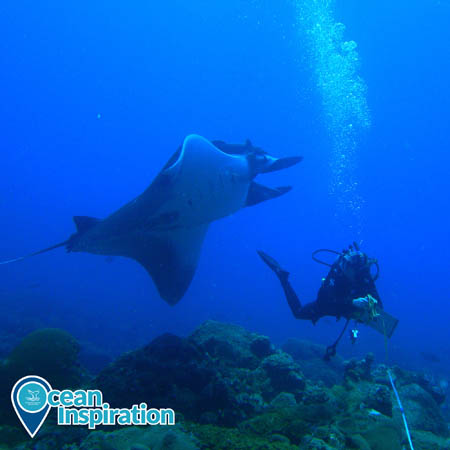
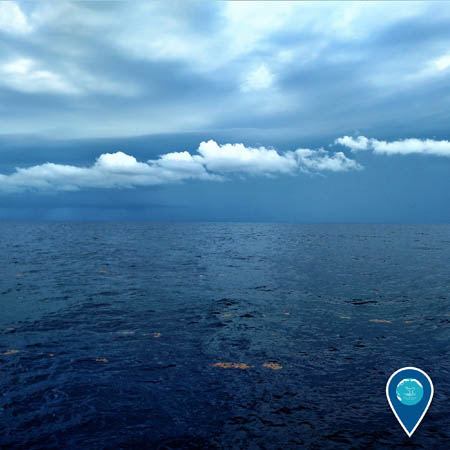
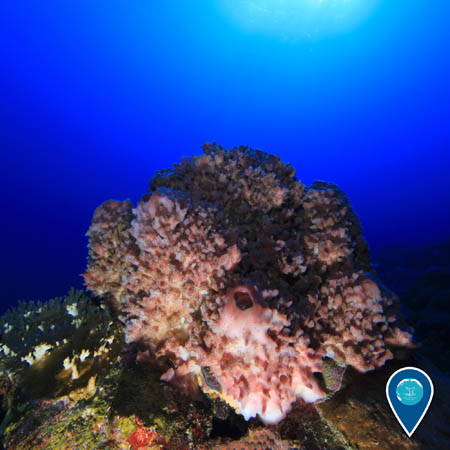
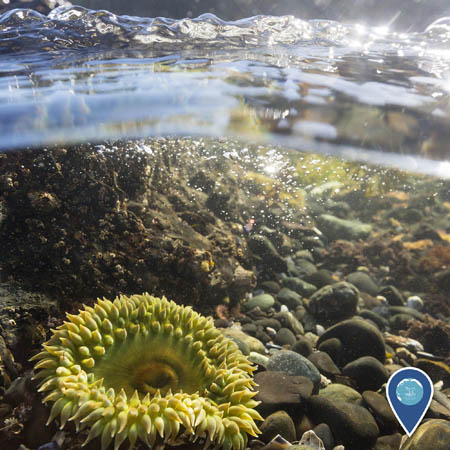

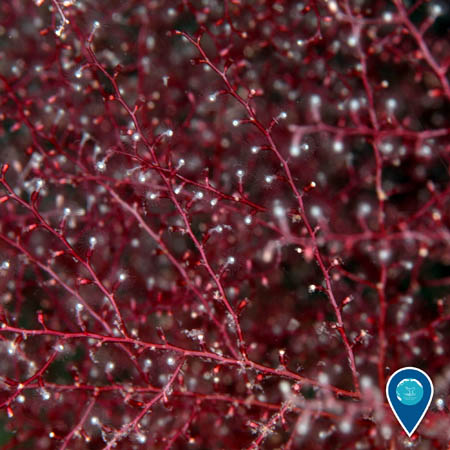
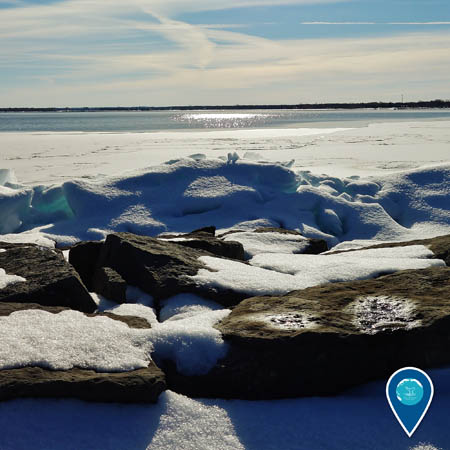
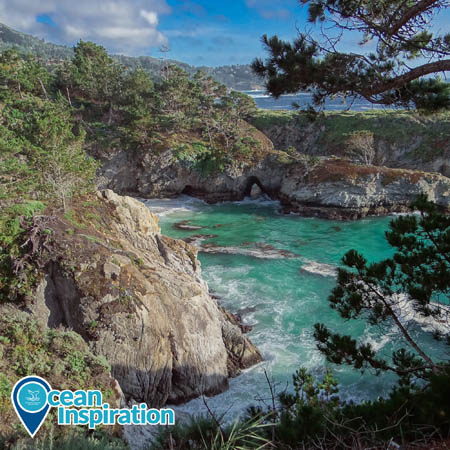
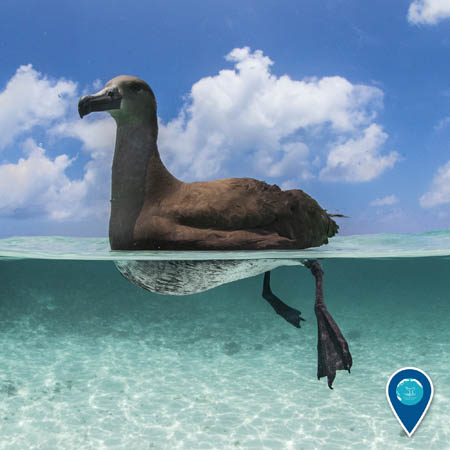
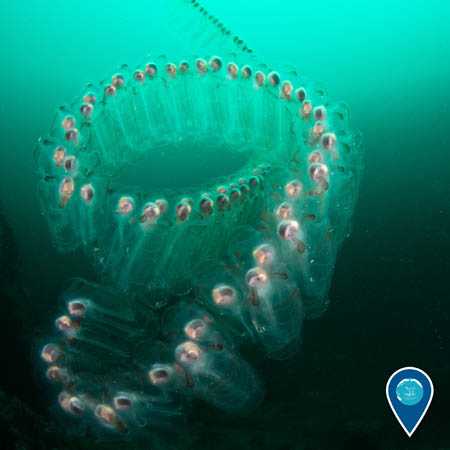
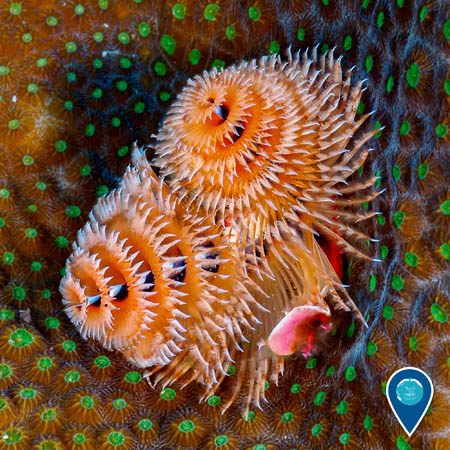
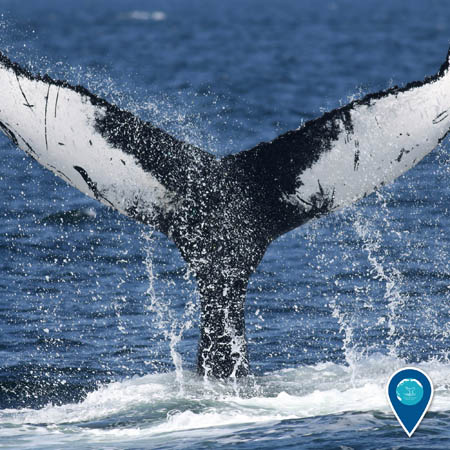
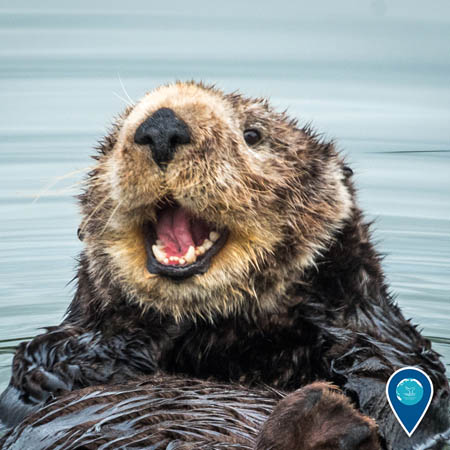
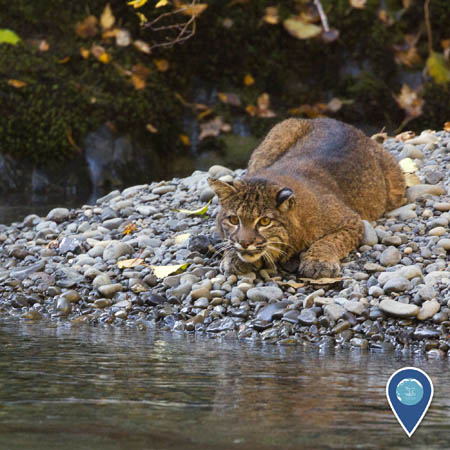
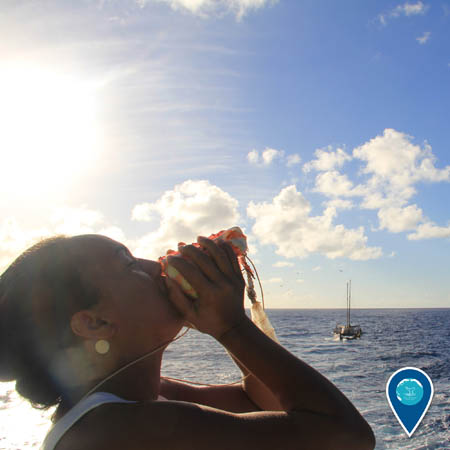
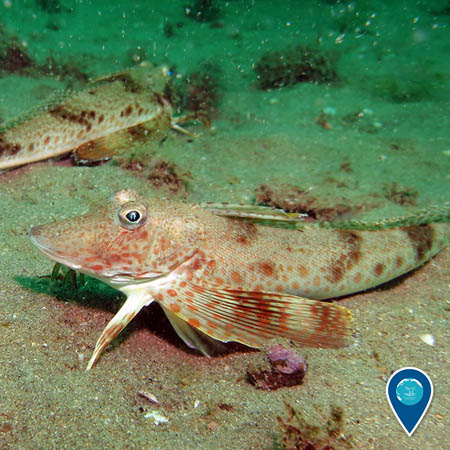
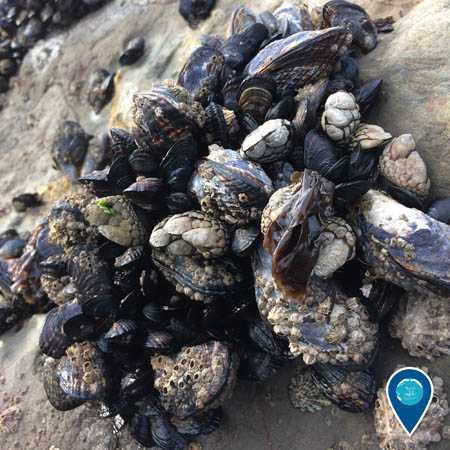
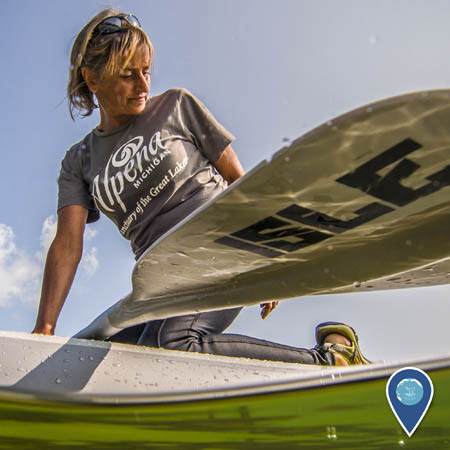
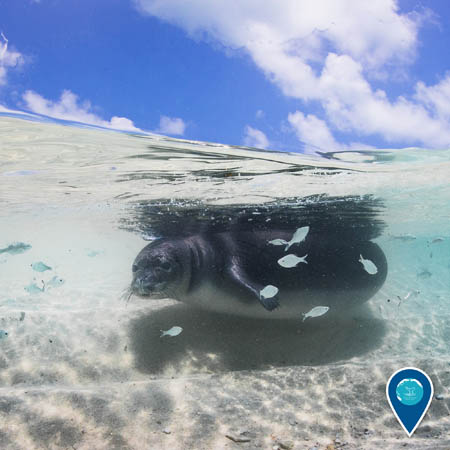
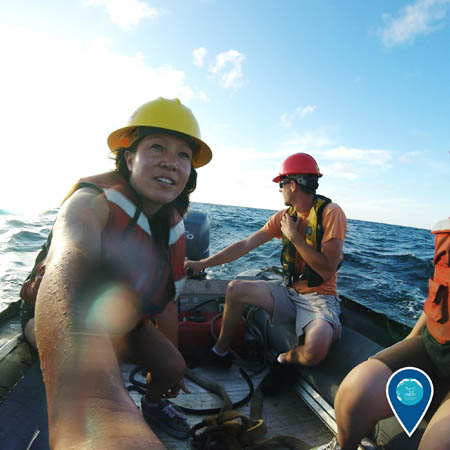
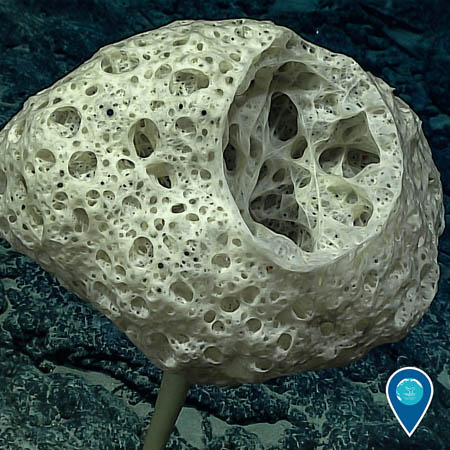
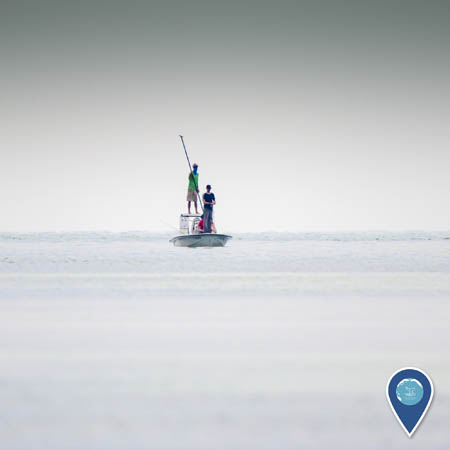
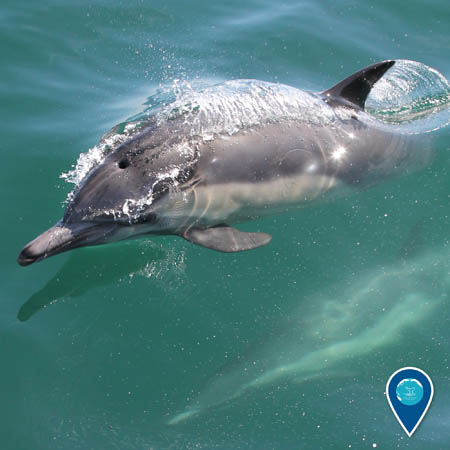

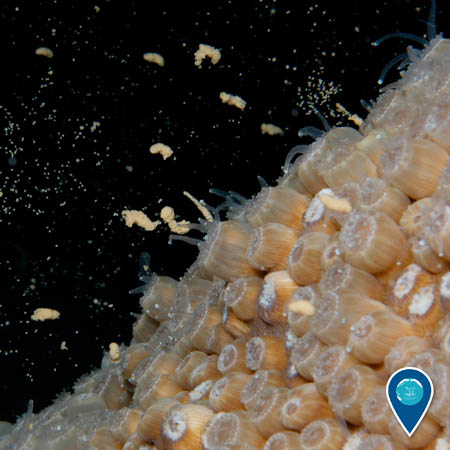
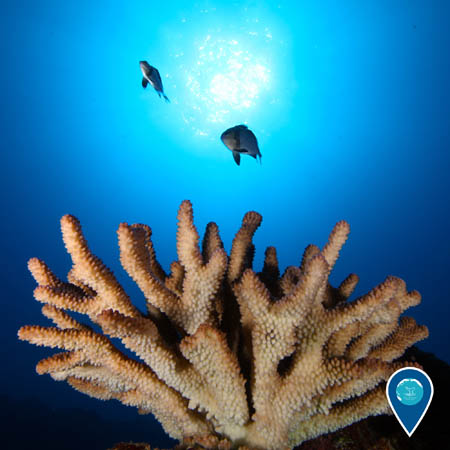
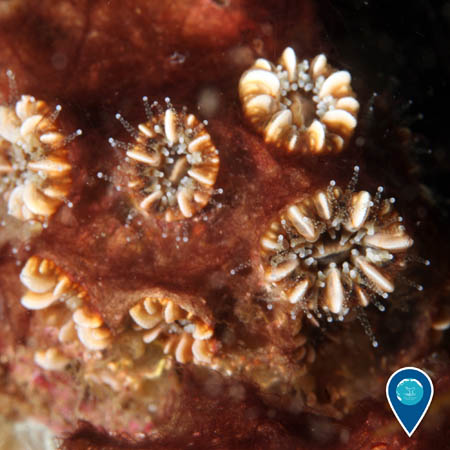
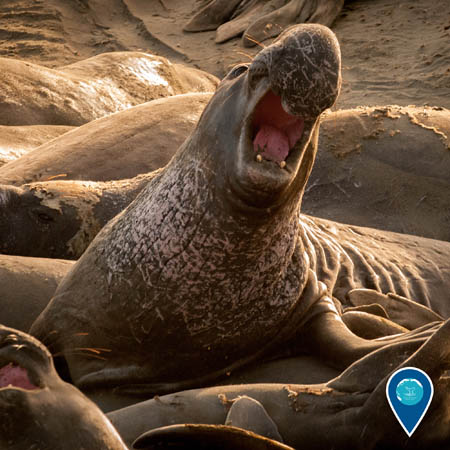
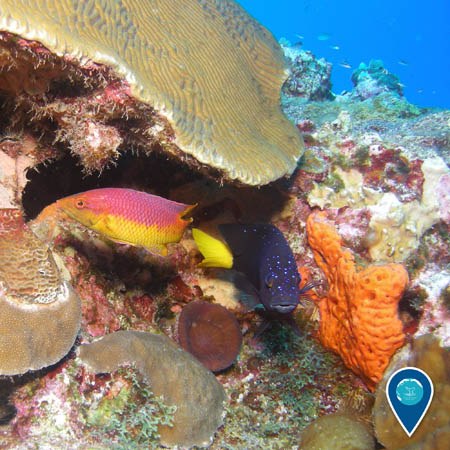
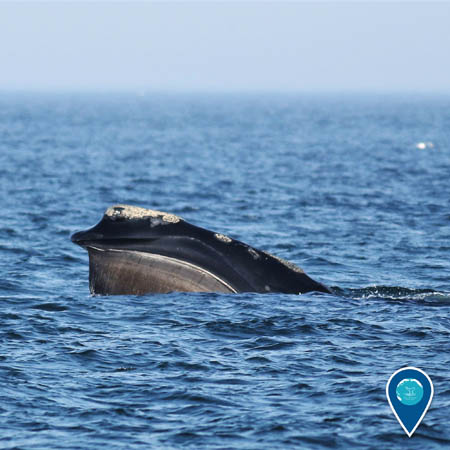
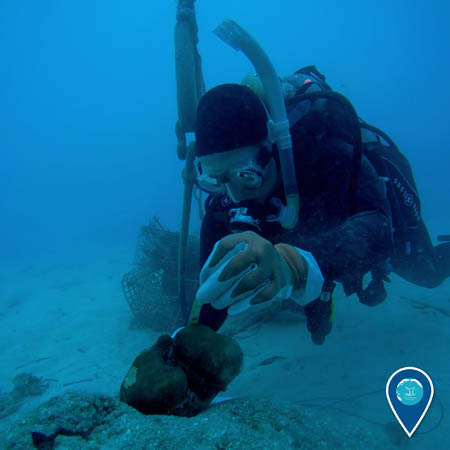

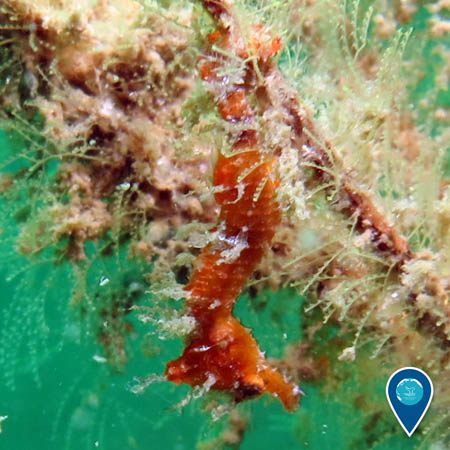
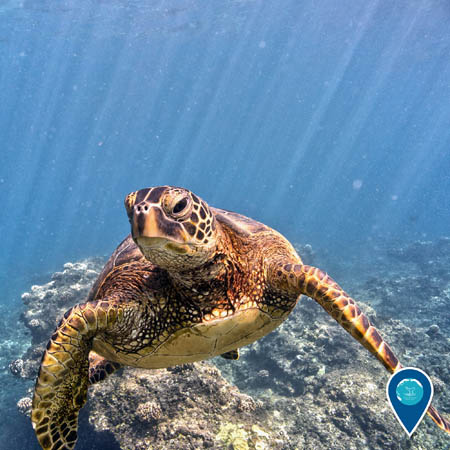
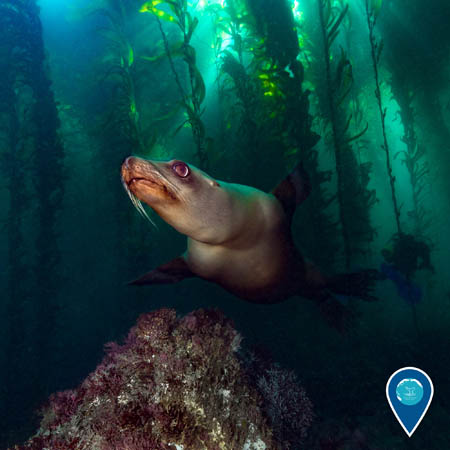
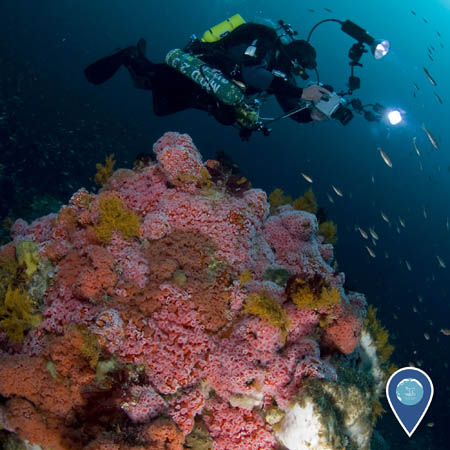
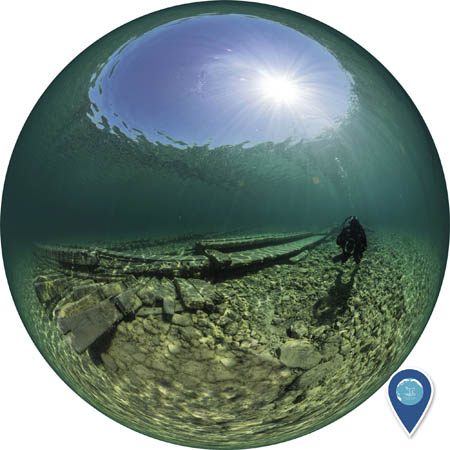
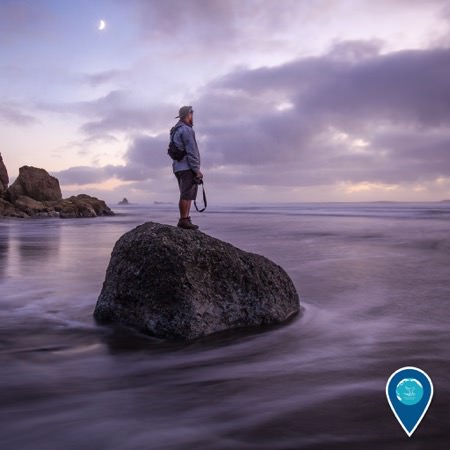
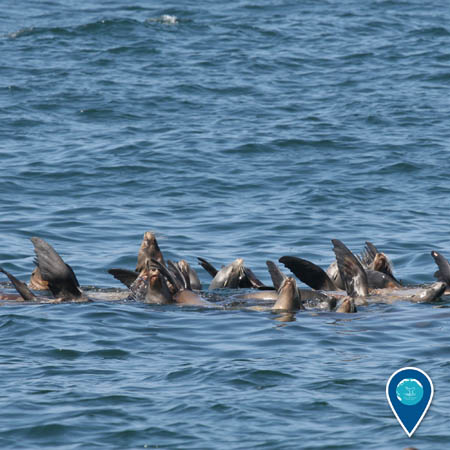
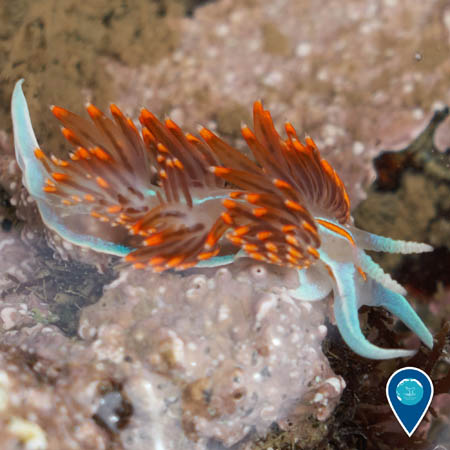
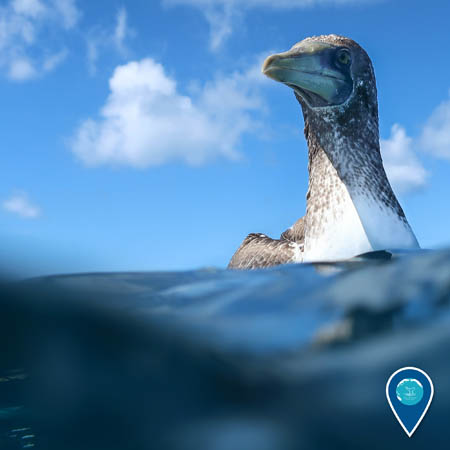
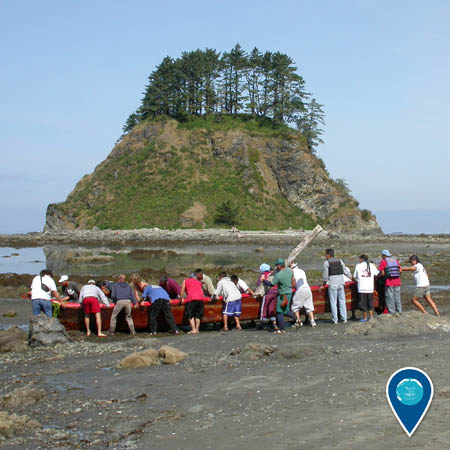
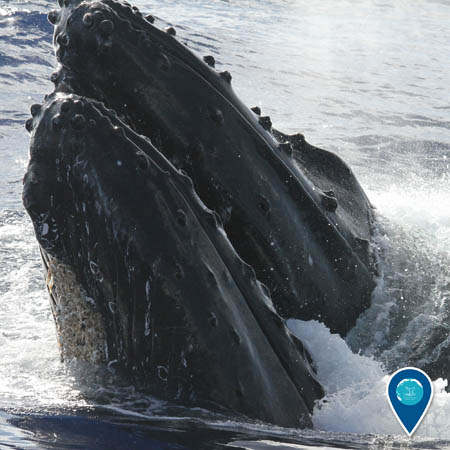
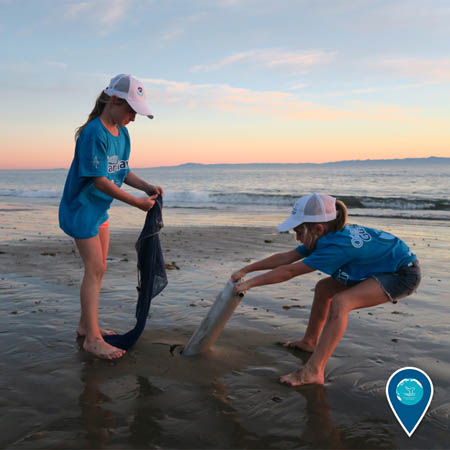
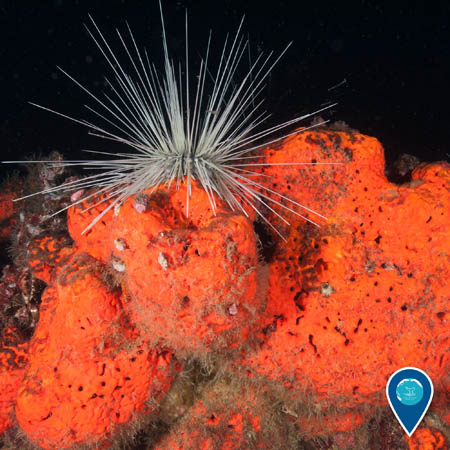
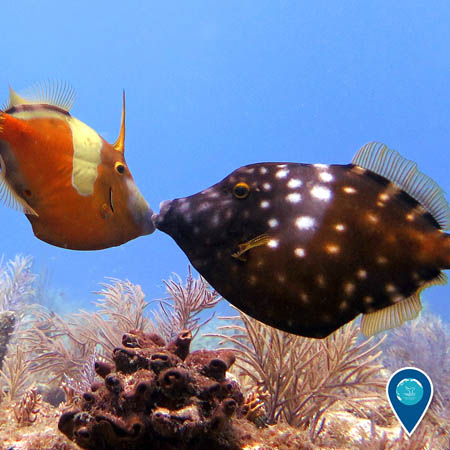
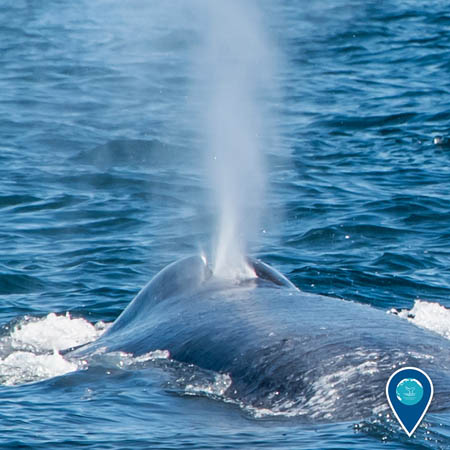
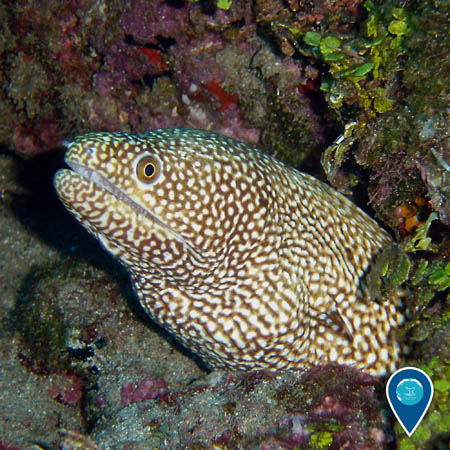
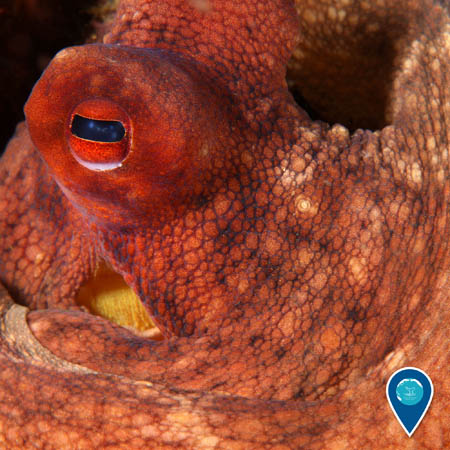
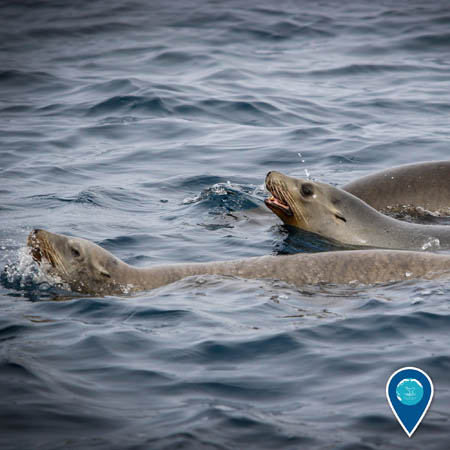
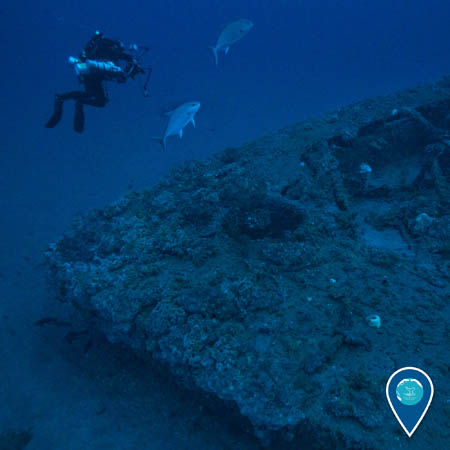
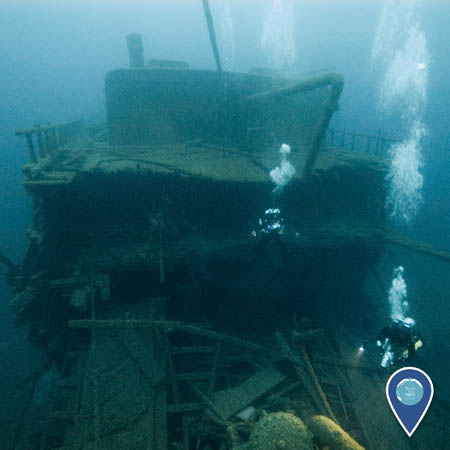
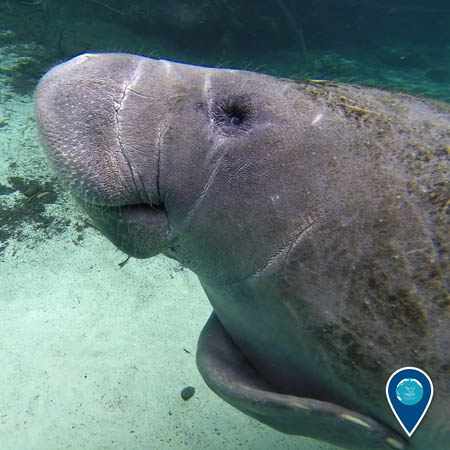
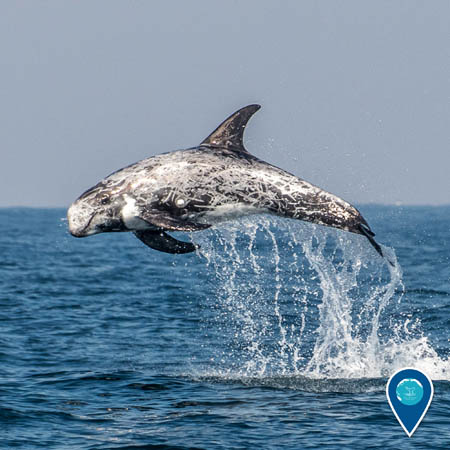
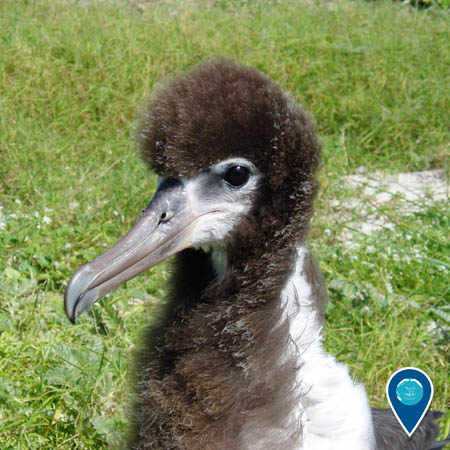
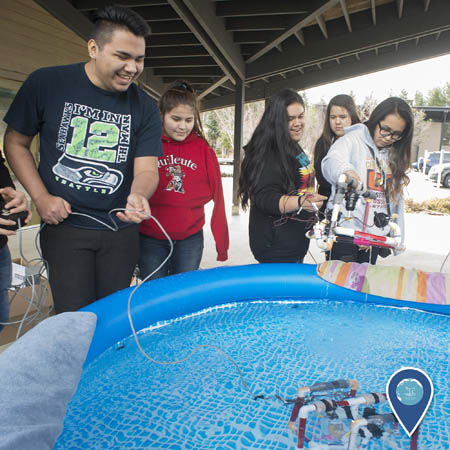
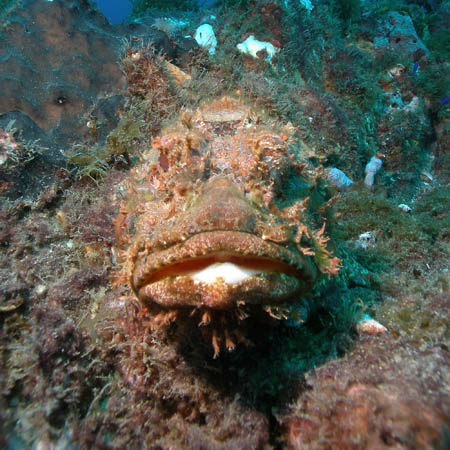
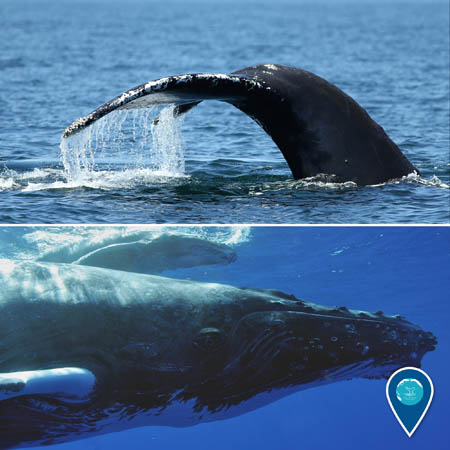
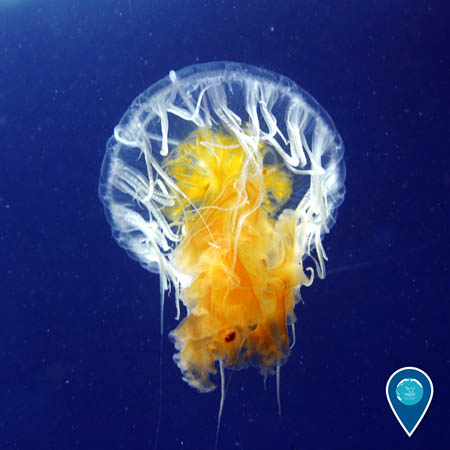
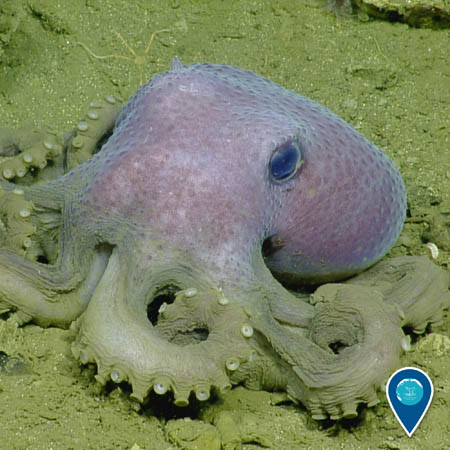
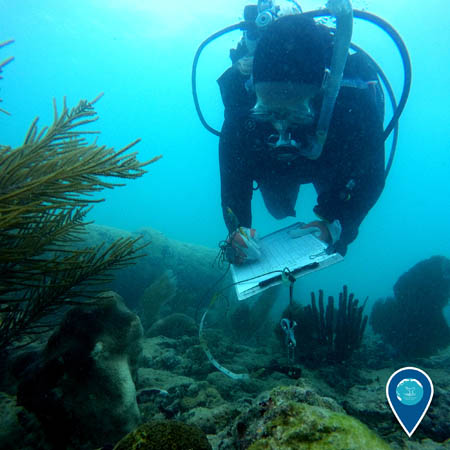
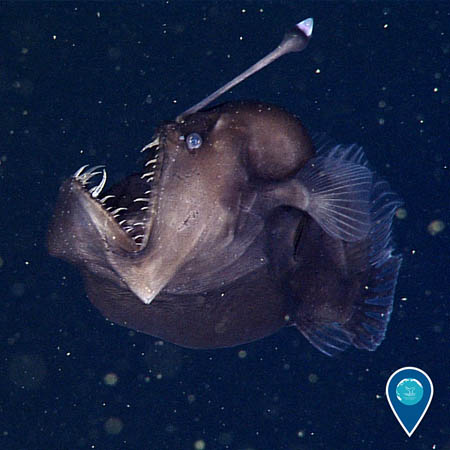
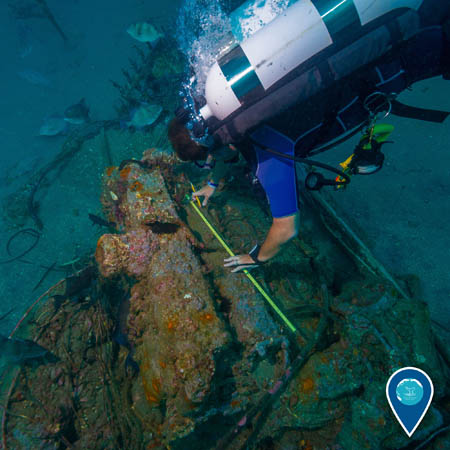
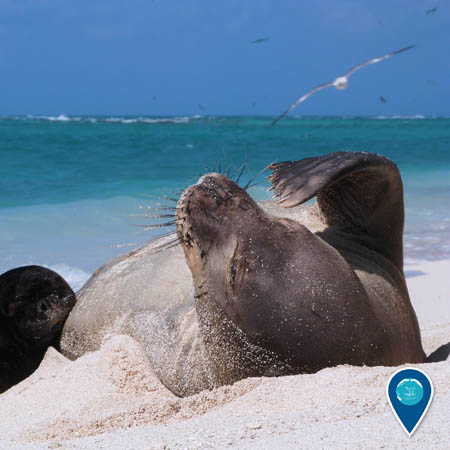
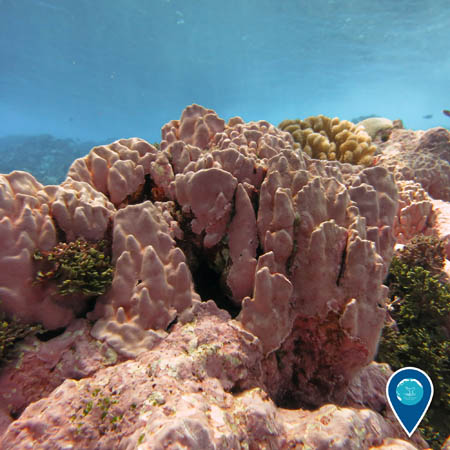
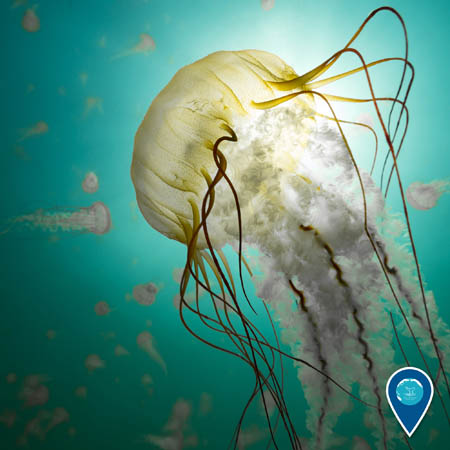
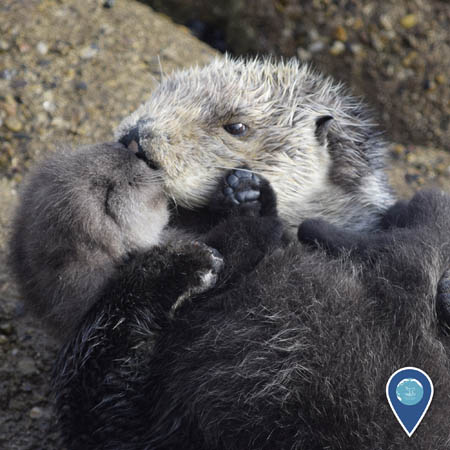
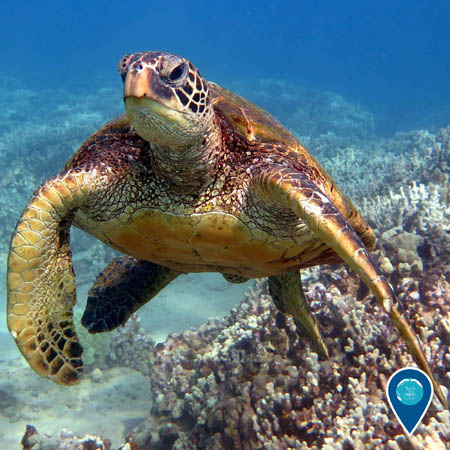
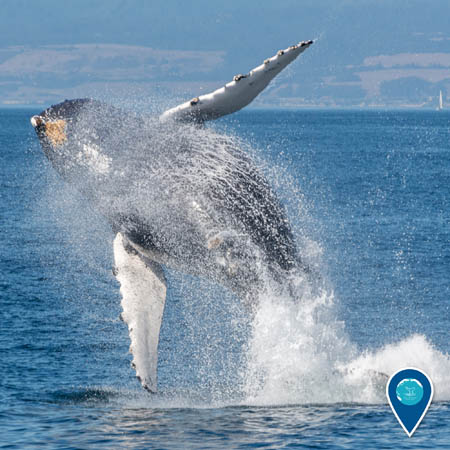
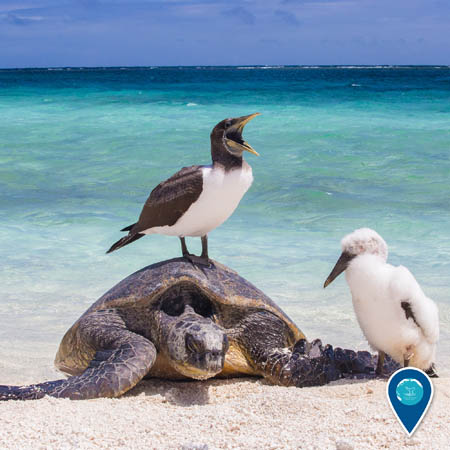
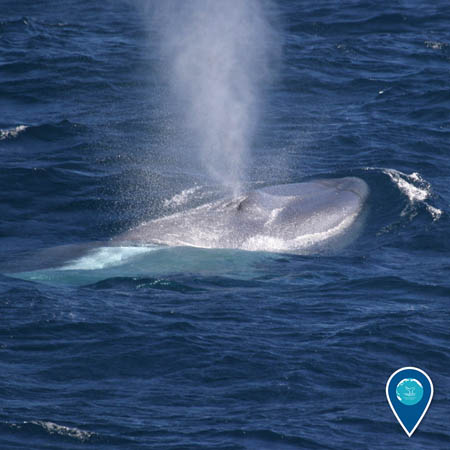
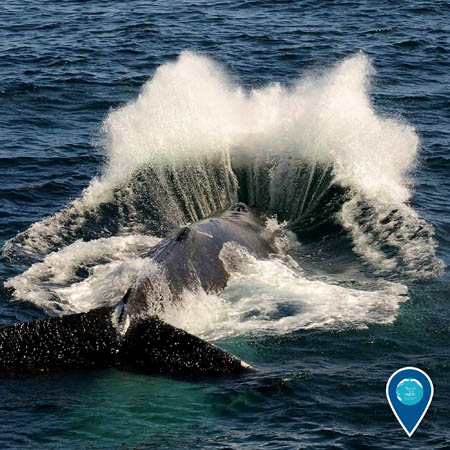

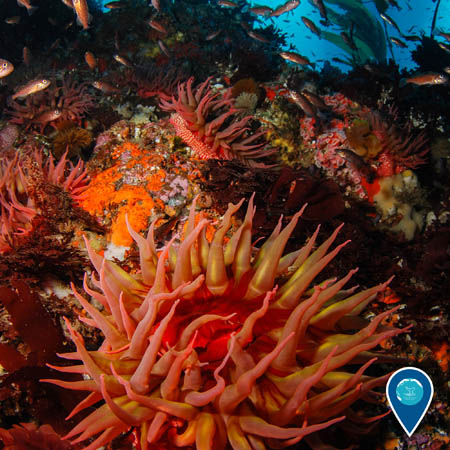
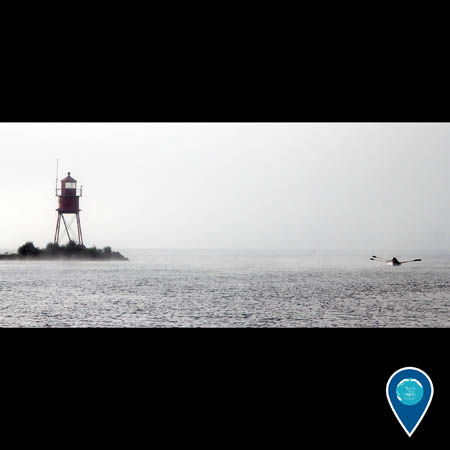
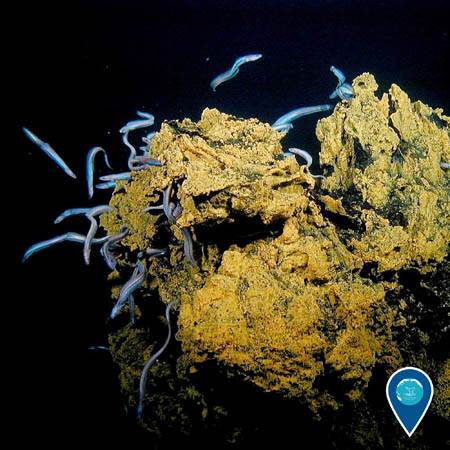
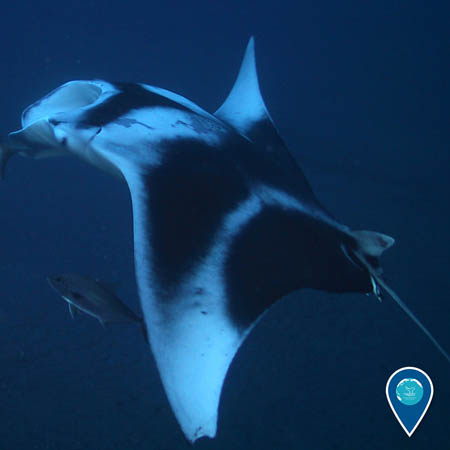
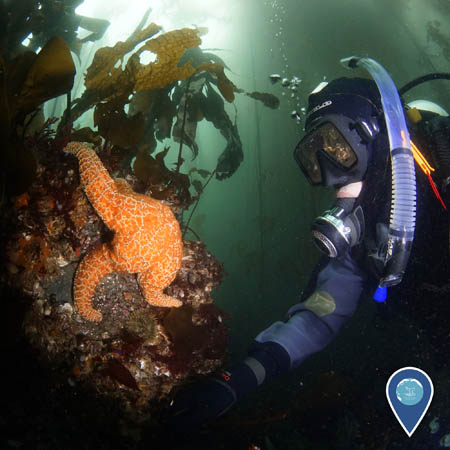
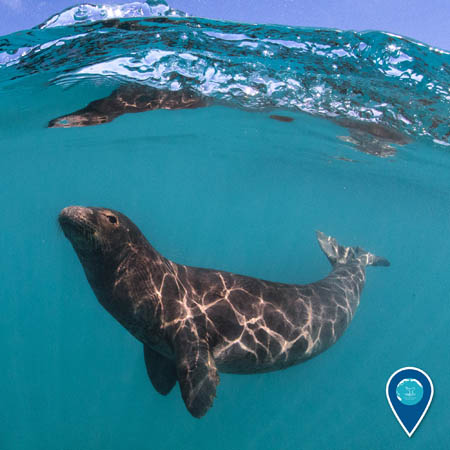
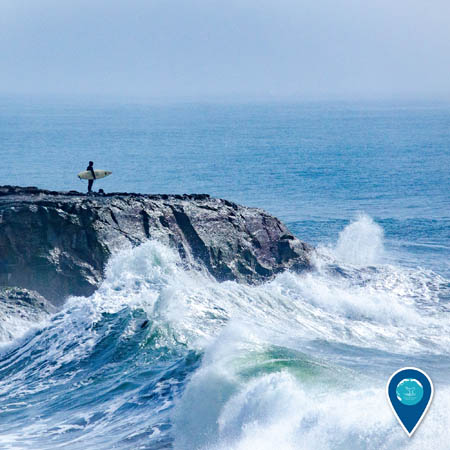
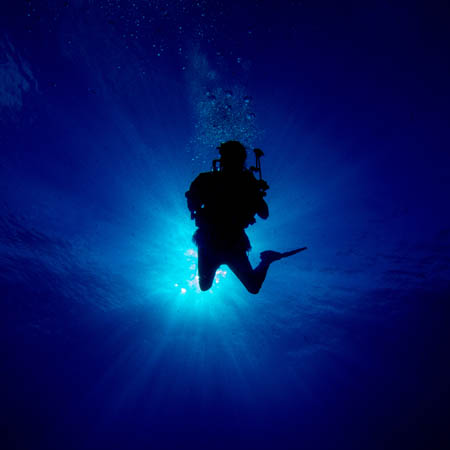
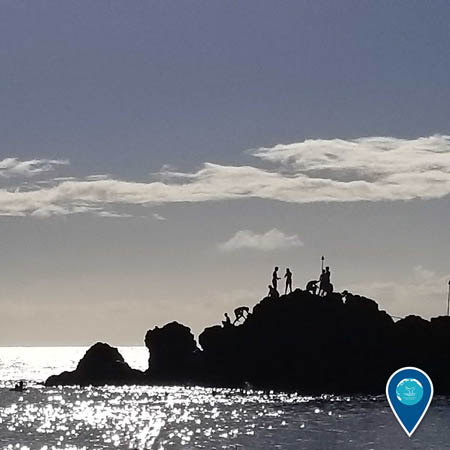
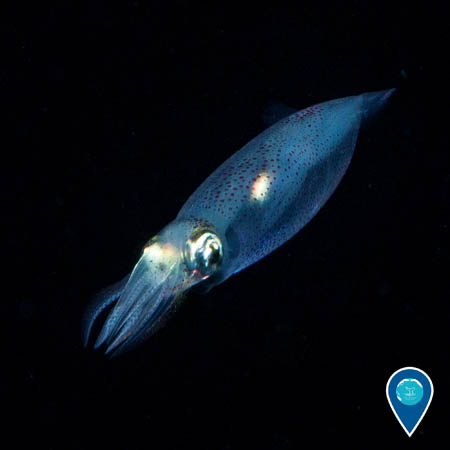
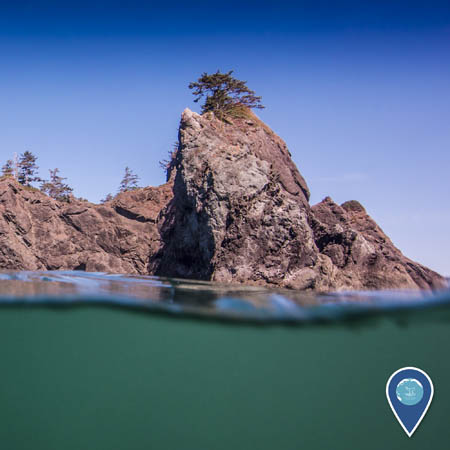
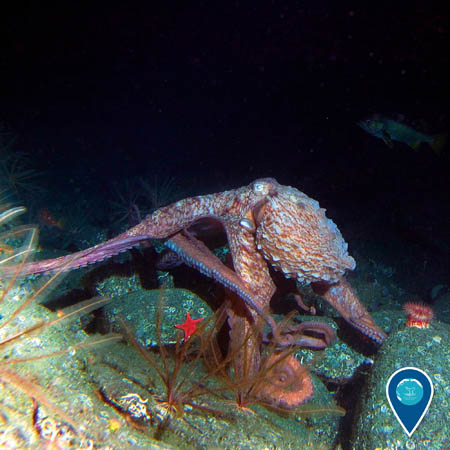
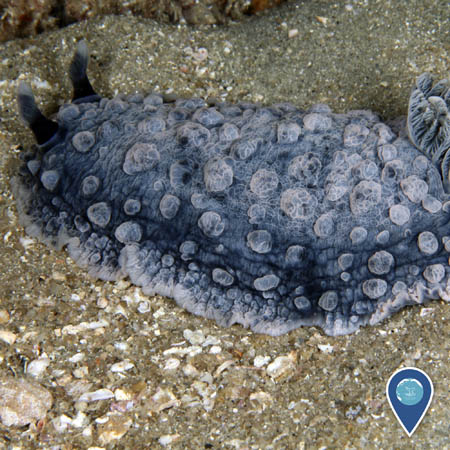
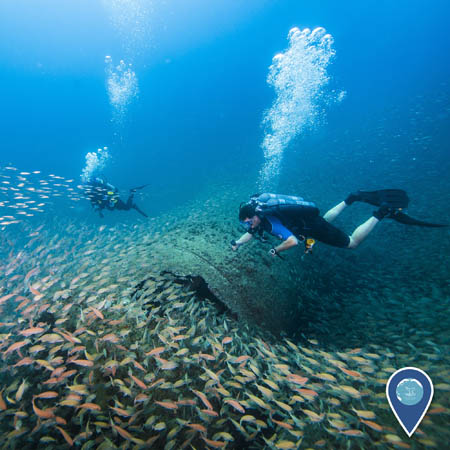
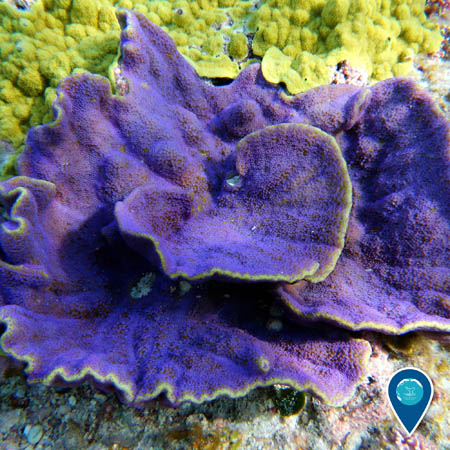
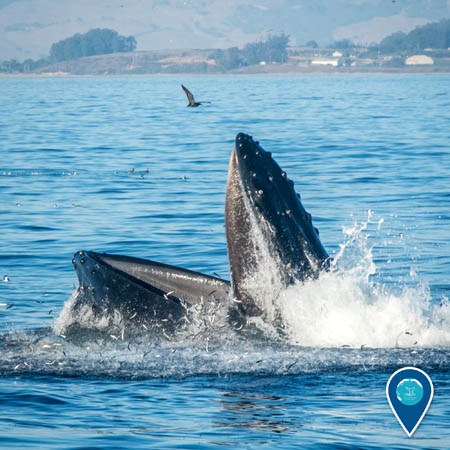
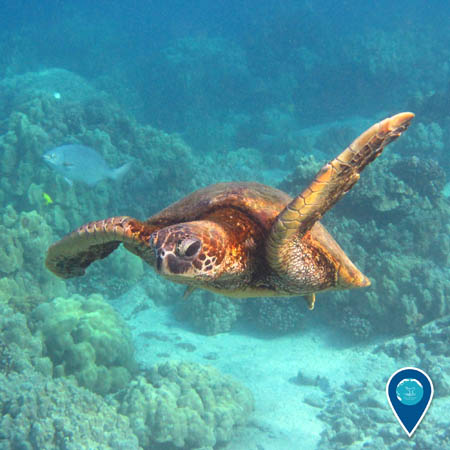
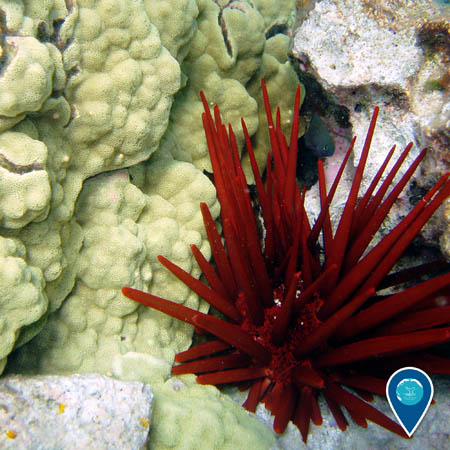
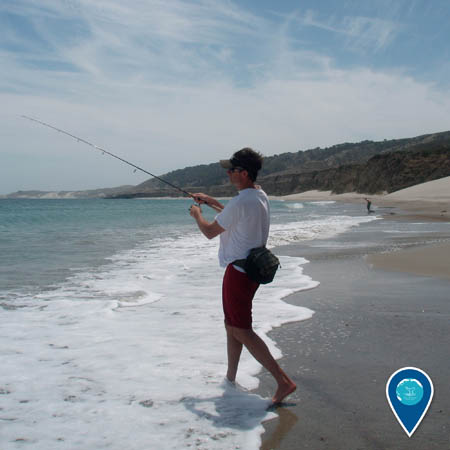
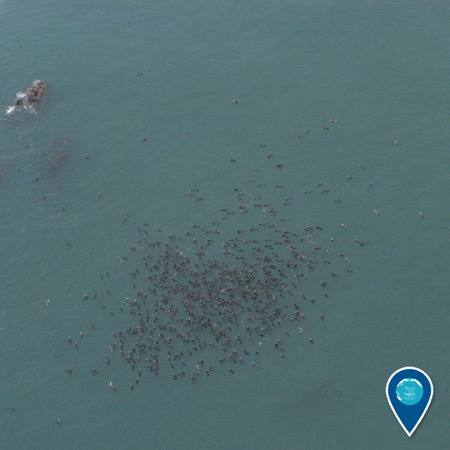
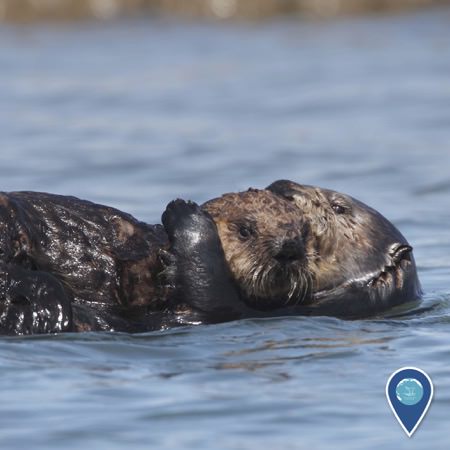
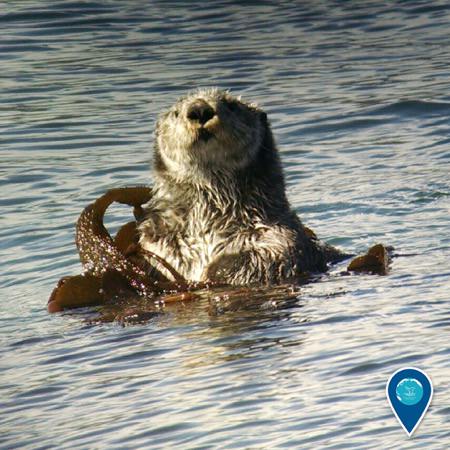
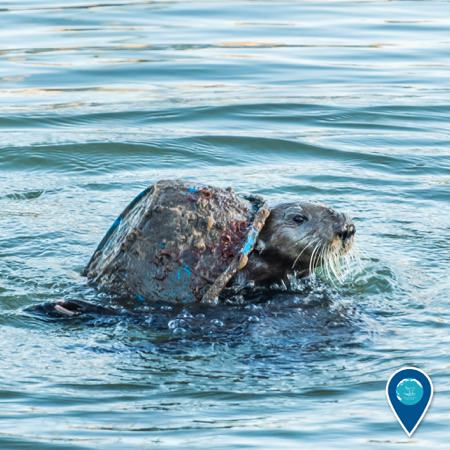
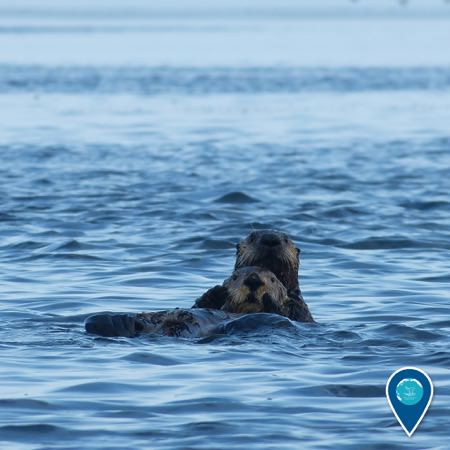
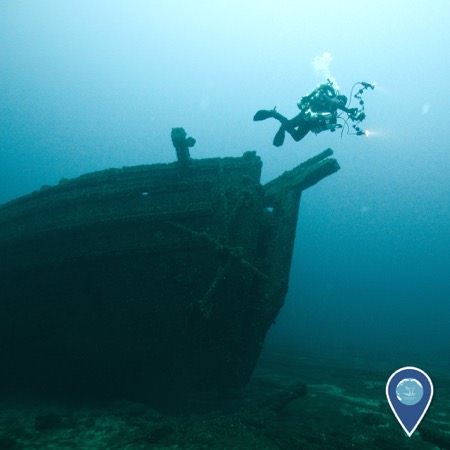
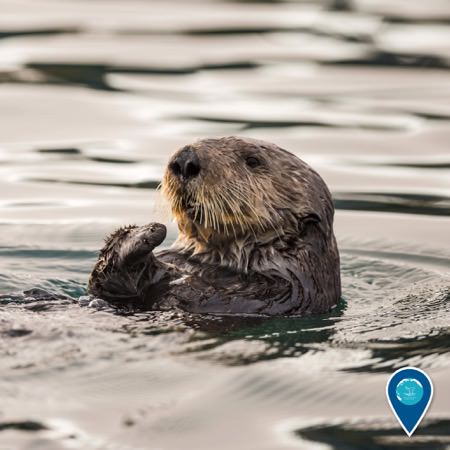
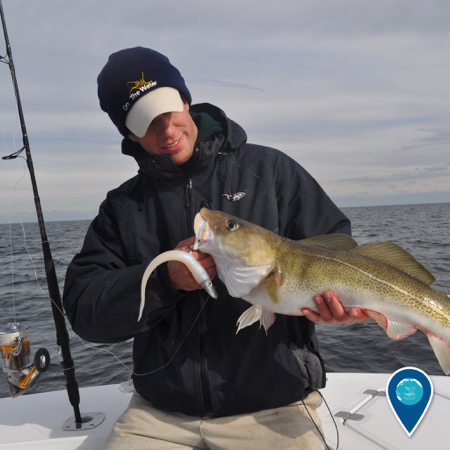
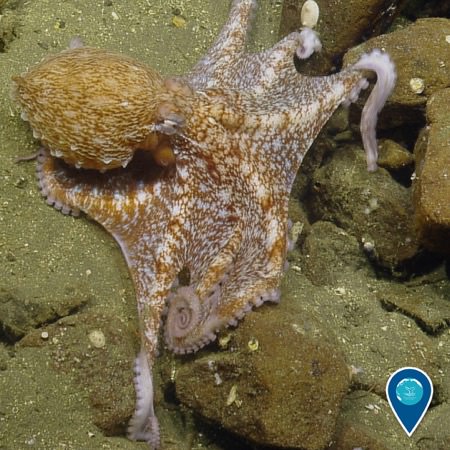
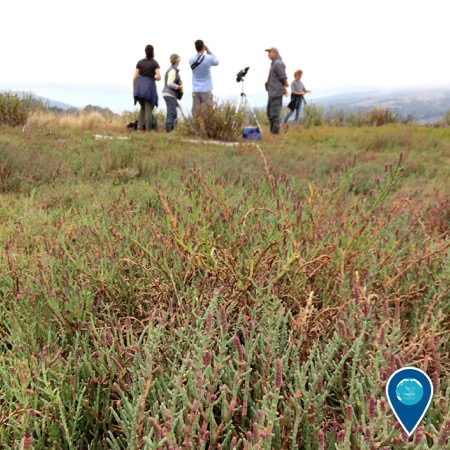
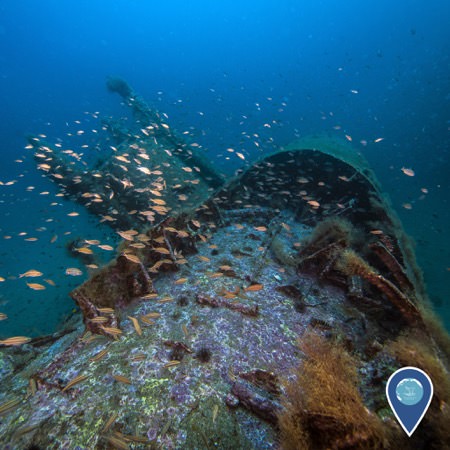
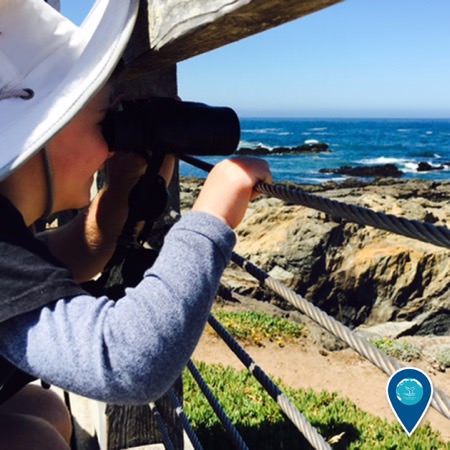
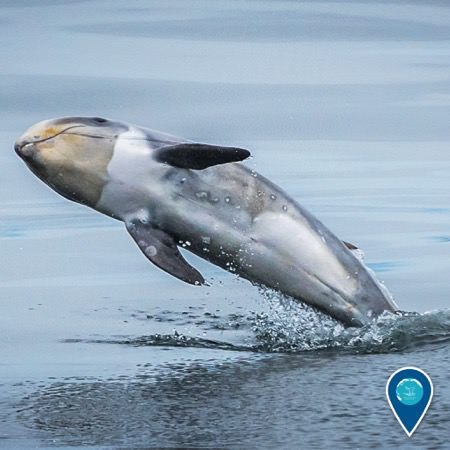
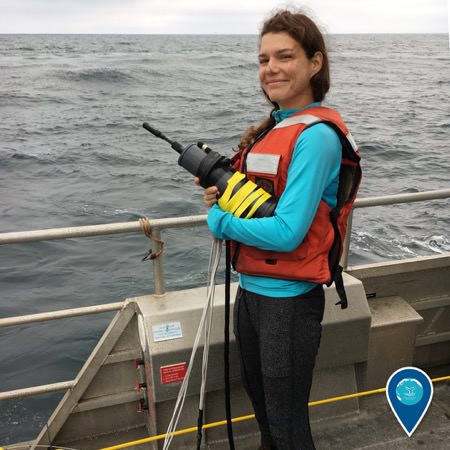
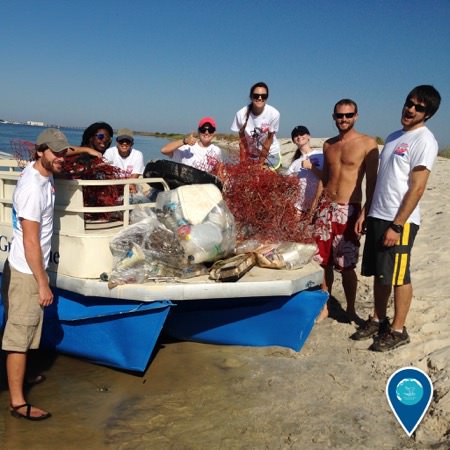 nel Islands! (Photo: Lindsey Peavey/NOAA)
nel Islands! (Photo: Lindsey Peavey/NOAA) 